- Skip to primary navigation
- Skip to main content
- Skip to primary sidebar

- Fall in Korea

South Korea Itinerary: 2 Weeks Or Less (From A Local)
Last Updated: Aug 31, 2024 by Max · This post may contain affiliate links · 52 Comments
This two weeks in South Korea itinerary is based on my three years living in Korea, discovering the country's beautiful places and the people who live there. Since I left, I've also been back to visit several times, most recently last year.
So while I could write a South Korea 10 day itinerary or 14 day itinerary centered only on Seoul and Busan , maybe even Jeju , I'm not going to do that. This country deserves so much more attention to detail, and so do you. So this guide actually covers five different cities in Korea to check out on your visit.
Even though there's no such thing as the perfect itinerary for Korea, the country is small enough that two weeks is enough time to adjust to the culture change and still have time to enjoy most everything. But if you only have 10 days in Korea (or even fewer), then I highly suggest you start in Seoul for 4 days, at least.
Starting with 4 days in Seoul, you can see the basics for tourists & build out your itinerary from there, as I mention in the South Korea sample itinerary section. So let's get to planning!
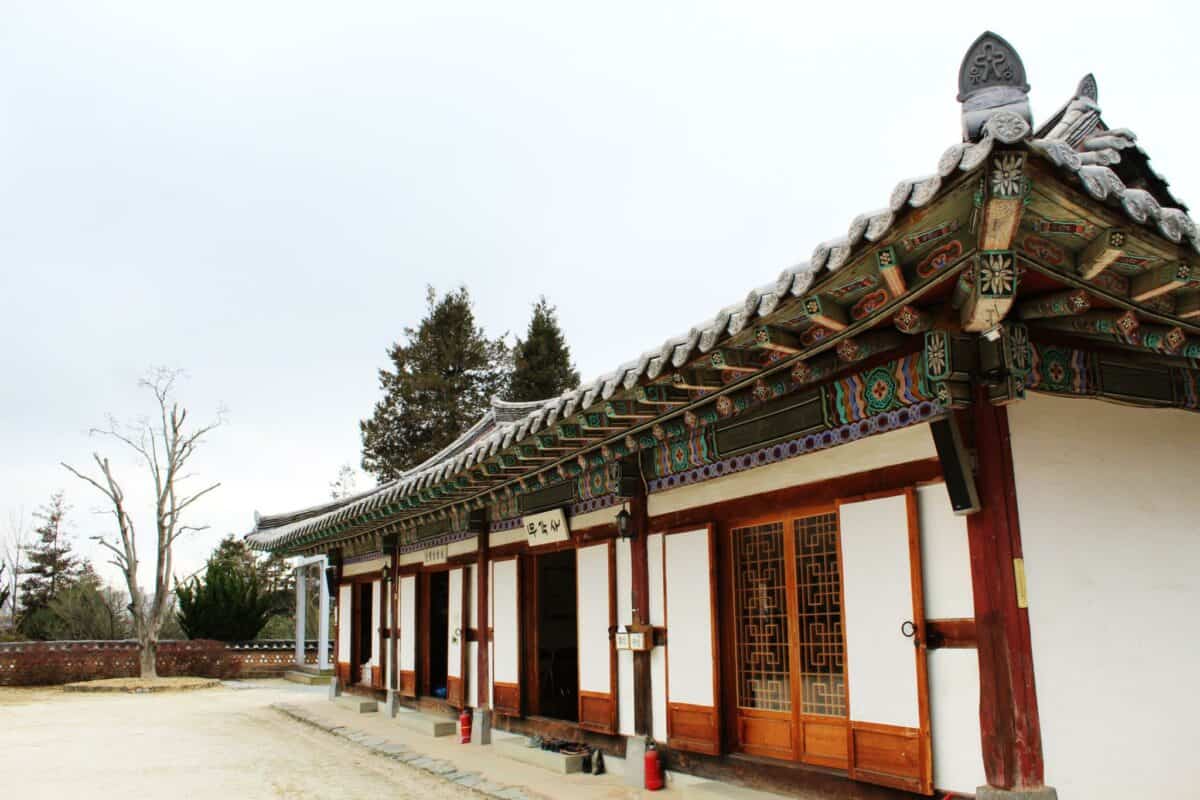
- ✈️ Basics of Travel in South Korea
- 🙋 South Korea Travel FAQ
- 🗺️ South Korea Trip Itinerary Examples
- 🚕 Where To Visit In South Korea
- 🧳 Budget For A Trip To South Korea
- 🚈 South Korea Travel Tips
- ☺️ Basic Phrases For Your Trip to Korea
✈️ Basics of Travel in South Korea
Visa: Most travelers will need a K-ETA ( Korean Electronic Travel Authorization ), applied for at least 72 hours before departure. If you needed a visa before, you'll need a K-ETA now. Note that from April 1, 2023, to December 31, 2024, passport holders from 22 countries, including the US, UK, Canada, and several EU nations, can visit visa-free – no K-ETA required!
Currency: South Korean won ( KRW or ₩ )
Arrival in Korea: all international flights arrive at Incheon Airport (ICN), one of the best-rated airports in the world. It usually takes about 1 hour to get through security & pick up checked bags.
Getting Around: Korea has an extensive & reliable public transport system. A refillable T-Money card is your ticket to buses and trains across the country; you can buy and refill yout TMoney card at any subways station or convenience store in Korea.
Internet & SIM Cards: Rent a Wi-Fi egg or purchase a prepaid Korean SIM card at the airport, available for up to one month of connection.
Travel Insurance: always recommended, though some credit card companies offers limited coverage when booking.

🙋 South Korea Travel FAQ
I've included a FAQ section including the most common questions I've been asked in the last 3 years, by friends, family, and complete strangers. Hopefully this answers the majority of your questions!
What should I wear in Korea during winter, spring, summer, and fall?
From mid-November to mid-March, it could definitely snow and you'll want a heavy winter jacket and some heat-retaining leggings for under your pants. From mid-March through early May & early October through mid-November, there's still the possibility of chilly nights. So bring pants and a jacket for the nights, and t-shirts for the days.
Pack more conservative tops to take to Korea, as showing your collarbones can be cause for staring, especially in smaller towns. Respect is very important in Korea. Early May through early October is a toss-up between extremely hot and warm with a breeze, but it will definitely be humid.
What do I need to bring to Korea?
Other than the basics you'd always pack for yourself, remember to bring higher-cut shirts, as Koreans are more conservative in their dress than most westerners. Women should be sure to bring tampons and pads, as there was recently an issue with domestic pads & tampons are extremely hard to come by.
Many readers have told me that purchasing a sim card and attraction pass (like the Discover Seoul Pass ) helped them make the most of shorter visits, and those are simple things to arrange in advance and take to Korea.

Do I need a visa to visit Korea?
While there are still 112 countries whose citizens don't need to apply for visas before visiting Korea for 30 to 90 days, as of September 2021, ALL visitors from those approved countries still need to have an approved K-ETA before arriving in Korea, even if you just have a long layover in Incheon .
K-ETA stands for Korea-Electronic Travel Authorization. You can check if yours is one of those visa-exempt, countries and how long your visa lasts for, here . Common countries: USA (up to 90 days), Canada (up to 6 months), South Africa (up to 30 days), Malaysia (up to 90 days), Singapore (up to 90 days).
But remember, even if you don't need to apply for a visa, from now on you do still need to apply for a K-ETA , which is good for two years form the date of approval. If you already need to apply for a visa, you do not need to apply for a K-ETA .
How expensive is it to travel Korea?
This depends on your style of travel, but a mid-range budget for a solo traveler spending 10 days in South Korea would be about $65USD per day. If you're willing to stay in cheap hostels, stick to more free activities in Seoul, and eat local foods, then you could get it down to maybe $40USD per day.
So I'd say that traveling Korea is really quite affordable, though you can always upgrade your trip, and the longer you stay the cheaper it will be per dium.

How can I get to & around Korea?
Since South Korea is on a peninsula off the southern coast of China, you have to fly in. Note that if you have a layover at Gimpo Airport for some reason, the airport closes each night from 12am-4:30am. Theoretically you could also arrive by boat from China or Japan, but that truly sounds awful to me.
As for actually getting around Korea, that's a much easier question. Getting between the cities is best done by bus, or train if it's a very popular route. Some people prefer to fly between Seoul, Busan, and Jeju, though you can also go via bus & boat.
Within the major cities, buses, taxis, and the Busan & Seoul metro are all reliable and safe forms of transport (just make sure your taxi uses their meter). In smaller areas, buses and the occasional taxi are the way to go; taxis are very affordable in South Korea.
How many days in South Korea is enough?
I think two weeks in Korea is ideal for getting a taste of the coast, the nature, and the overall urban lifestyle. But if you have less time on you vacation in South Korea, you can get a condensed version of all of that with just 5 days in Seoul (yes, even the beaches!).
If you have fewer than 5 days, I really do think it will be tough to get a good sense of the culture and people and cuisine.
Which apps should I download before visiting Korea?
My most used apps in Korea have been: Kakao Talk (like Korean WhatsApp), Naver Maps (Google Maps is trash here, so you'll want to download this local equivalent), Google Translate (the speaking function is a lifesaver; just remember town download Korean offline), and a Seoul Subway App (mine is in Korean, but there are plenty out there in English).

🗺️ South Korea Trip Itinerary Examples
The whole idea of this guide it to give you an idea of where to visit in Korea and how long you want to spend there. Tourism is on the rise in Korea, and having a unique experience is becoming more important than ever for visitors.
So in true DIY spirit, here are some route examples for a 2 weeks in Korea itinerary or less, for each of the following lengths.
South Korea Itinerary 14 Days
- Seoul (Days 1-4)
- Jeju (Days 5-7)
- Busan (Days 8-9)
- Suncheon area (Days 10-12)
- Jeonju (Days 13-14)
See below for more information on each city.
South Korea Itinerary 10 Days
- Suncheon area (Days 8-10)
Click to check current hotel prices in Korea.
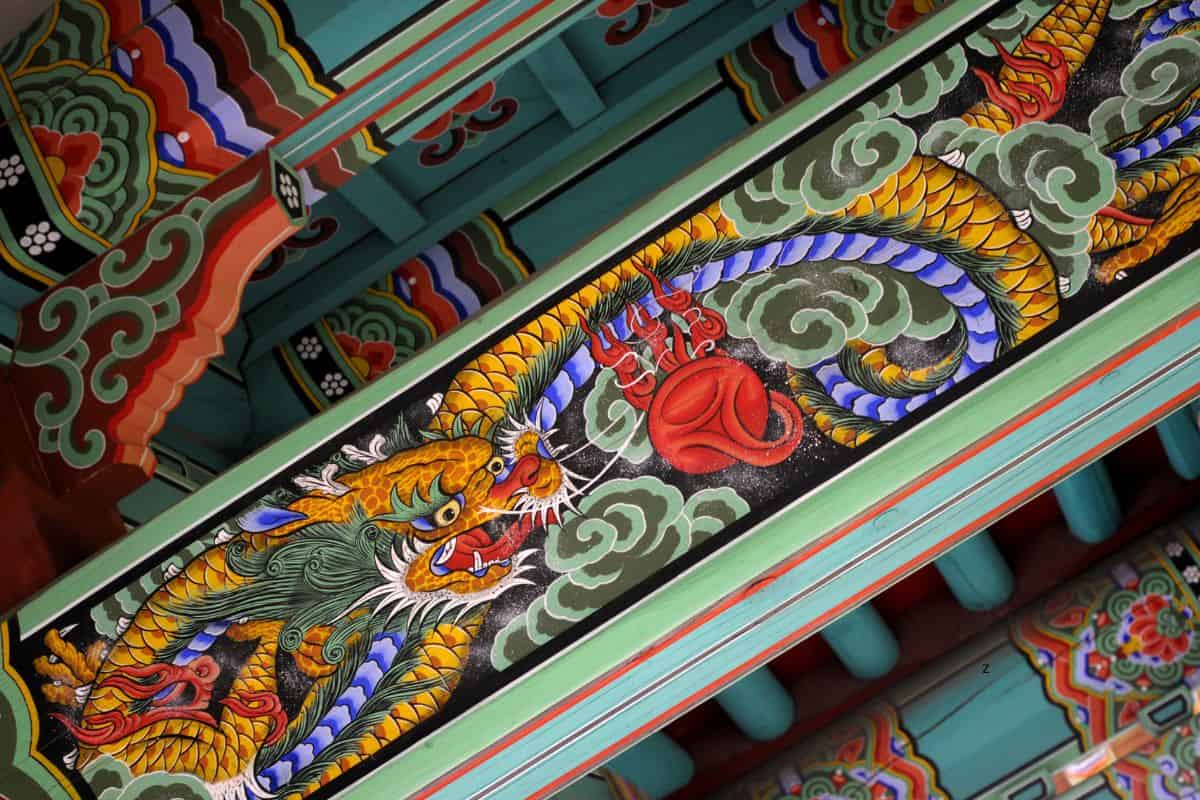
South Korea Itinerary 7 Days
- Suncheon area (Days 5-7)
South Korea Itinerary 5 Days
- Seoul (Days 1-3)
- Jeonju (Days 4-5)
South Korea Itinerary 3 Days
Seoul. Just spend 2 days exploring all you can in Seoul, and then spend your middle day doing a day trip from the city, maybe to nearby Chuncheon.

🚕 Where To Visit In South Korea
Seoul : the capitol city, the darling of K-Pop fans, and one of the most populous cities in the world. Seoul is not for the faint of heart, but for those who can handle serious crowds, Seoul can be most anything you want it to be.
Almost everyone planning South Korea vacations will end up either starting or ending here, and they're lucky to do so. It's a great base from which to travel the rest of the country, or even spend a week or so experiencing all of the different neighborhoods & their vibes.
Seoul is great for culture, food, nightlife, and just about anything else you want in a trip to Korea, except for peace and quiet.
Busan : possibly best known outside of Korea for the movie Train To Busan , this port city is thought of domestically as the seafood and cinema capitol of the country.
Even though it's incredibly urban in its own right, people also think of it as more laid back, with beach vibes and ocean views for days. Busan is perfect for seafood lovers looking to spend time at the beach and indulge in some cinematic activity.
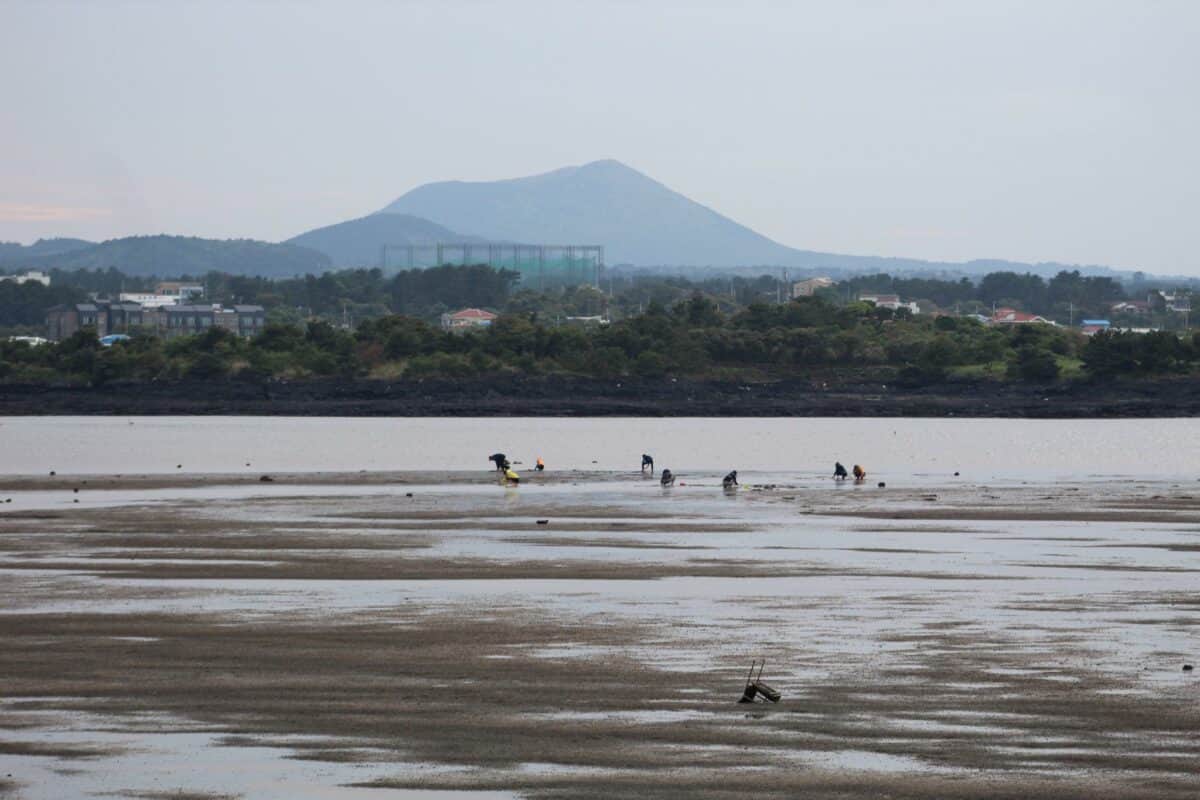
Jeju : the Hawaii of Korea, as it's often called, Jeju is known for its beaches and seafood and nature. The entire island comes from a single volcanic explosion thousands of years ago, and you can actually see the peak of that volcano from any point on the island.
Jeju is ideal for those looking to get a taste of Korean culture and cuisine, but with much more tranquility and beach vibes than you'd find anywhere on the mainland.
Jeonju : this lesser-known Korean destination is where Koreans go when they want to experience the "olden times" of Korea. Jeonju is one of the oldest cities in Korea , famous for its spicy bibimbap, traditional hanok houses, and many unique festivals.
Come to Jeonju if you want to soak in a whole city happily dedicated to maintaining traditional Korean culture, one bowl of spicy bibimbap at a time.
Suncheon : truly off-the-beaten path, Suncheon is a gorgeous region full of flowers, agriculture, and stunning natural landscapes. Domestic tourists most often visit in the springtime to see the green tea fields & cherry blossoms, but Suncheon is also a great base from which to explore a few nearby cities.
Visit Suncheon if you want to see a less-touristed side of Korea's natural beauty, with an emphasis on local agriculture.
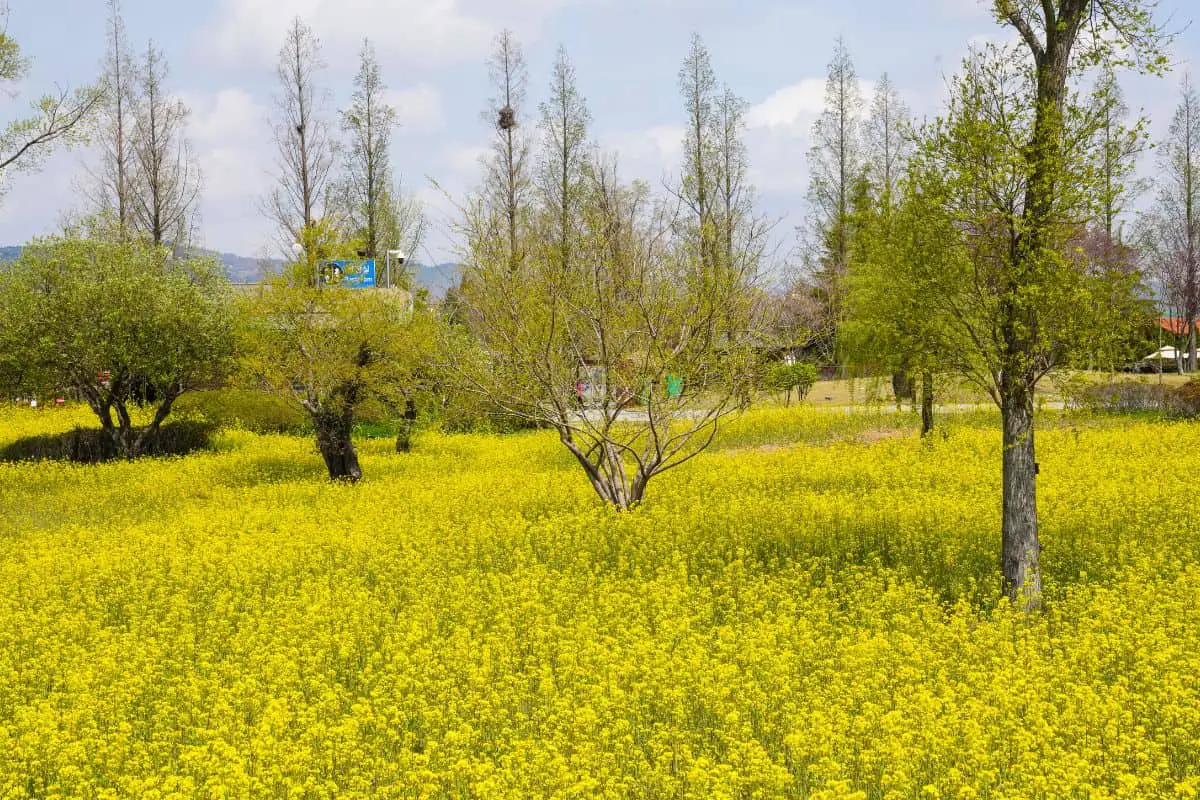
✈ Seoul
What seoul is known for.
Seoul has everything you could want in a destination. It's one of the biggest cities in the world, and despite being the center of international cultures in Korea, it's still very much culturally Korean. It's for this reason that I think Seoul is the perfect place to put at the beginning of your Korea itinerary.
You'll probably arrive here, anyway, since Incheon Airport is one of Asia's biggest transport hubs. Many people even plan a Seoul itinerary for 10 days for a taste of the Korean dishes which have become so popular around the world.
Others come for the world-class shopping and cosmetics selection, or even for medical tourism . But I think that the most worthy reasons to write Seoul into your Korean itinerary are the natural beauty , historic temples , and little cultural quirks which all add up to an ambiance that's purely Korean.
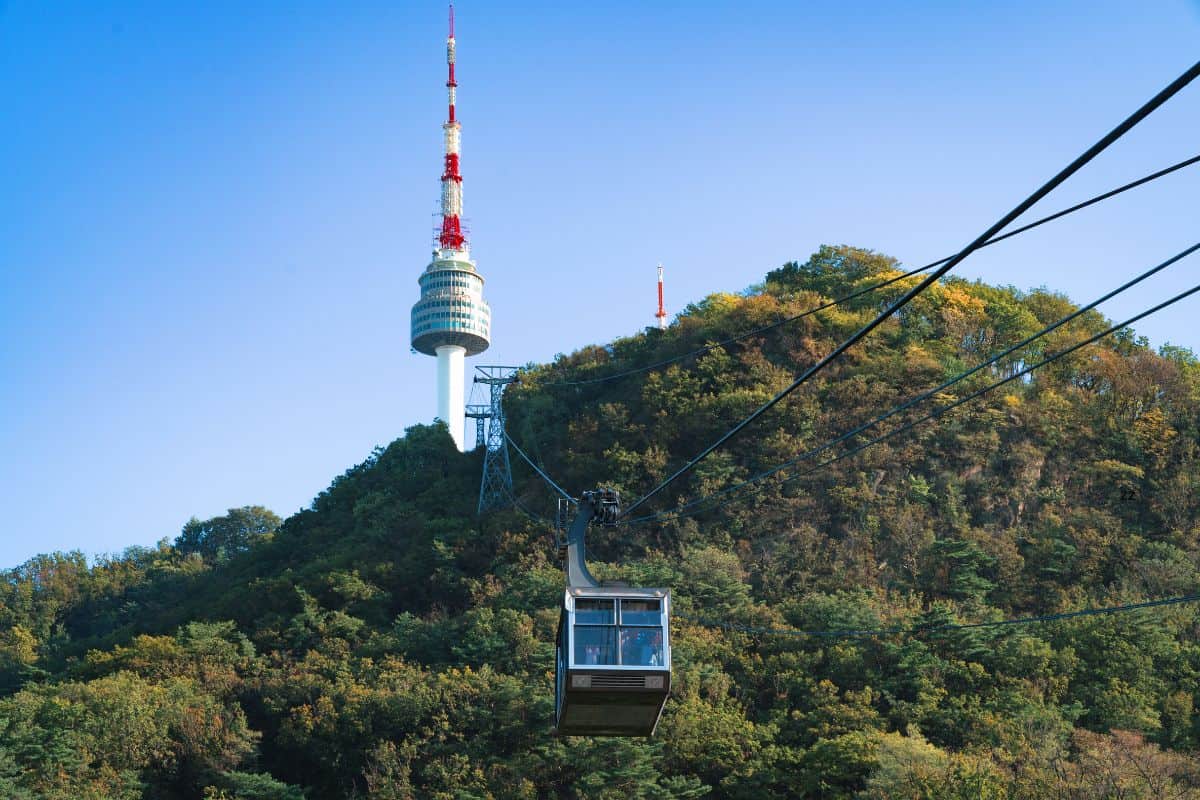
What To See In Seoul
I won't list out everything you can do or see in Seoul, since that could fill a whole book (and probably has). But here are 7 things you can't miss seeing in Seoul, since 7 is a lucky number here.
Go to the spa. The spa, or sauna, is an important pastime for Koreans of all ages, and it's most common to go on the weekends as a family. A Korean sauna, however, is divided by gender and has you completely naked.
While you could visit a sauna in most any city in Korea, Seoul is going to have the most options for different types of baths and treatments, and it's going to be the most foreigner-friendly. I highly recommend Itaewon Land Spa.
Walk to Namsan Tower. This landmark is rather characteristic of Itaewon and the whole HBC area, located in central Seoul and considered the international hub of the city. Namsan Tower is set in a very green park, and right around the tower itself is a temple and a gate with “love locks” attached to it, but the Tower is best known for having an amazing view of the city.
It’s a bit of a walk from Itaewon’s downtown area, but there’s a bus if you get tired, and a cable car to take you to the top. I think the view is just as good from the cafe right before the top floor, so I wouldn't recommend paying for the cable car.
Visit Gyungbokgung , one of the 5 royal palaces in Seoul. Of the 5, Gyeongbokgung is the most accessible by public transportation, located just outside of a subway stop. I also think it’s the most beautiful, but I’ve had the chance to visit in both fall and spring.
Those are the seasons when the colors of the palace grounds come to life; in summer and winter it's a bit less colorful. The grounds of Gyeongbongung are large, but you could spend anywhere from twenty minutes to two hours exploring each corner of the grounds.
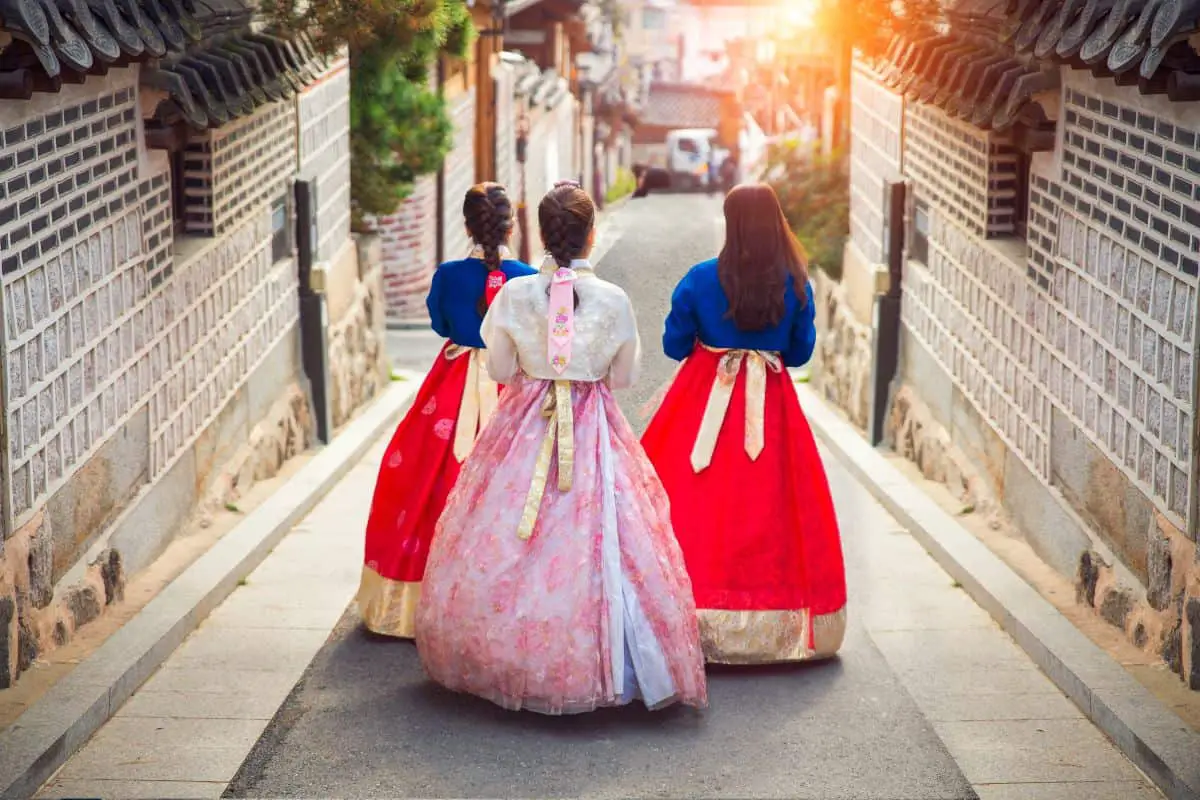
Sing in a Noraebang . Literally translated as "song room," noraebang are the quintessential nighttime activity of the Korean public. In English we usually know then by the Japanese name karaoke .
From middle school onward, on any given night you can find a noraebang full of Korean students hanging out with friends, or adults drinking with co-workers or family. In Seoul it's easy to find either coin noraebang, in which you pay per song, or regular noraebang, in which you rent a room by the hour & buy Korean snacks .
Hike Bukhansan. Just a half hour north of Seoul is one of Korea’s many national parks. Hiking is a national pastime, so every day of the week you’ll see groups of older people geared up for a trip up Bukhansan. On the weekends there are visitors of all ages, usually ending their hikes with a picnic and drinks at whichever peak they decide to stop on.
Explore Gana Art Center . Gana is known across Seoul for its beautiful think pieces. Amidst all the traditional Korean food and aesthetics of northern Seoul, walking around Gana Art Center gives you a different perspective on the current events in Korea.
Luckily, you don’t have to speak any Korean to get the gist of real art, though it may be helpful to know some about Korean culture in order to get the full impact. The permanent exhibits are free, but you may have to pay to enter the special exhibits.
Wander Bukchon Hanok Village . A hanok is a traditional Korean house, a small building with a thatched roofs and beautiful painted walls & roof. In the spring and fall the foliage creates a stunning backdrop for photos, so that’s the perfect time to enjoy the village in traditional garb.
Note that Bukchon Hanok Village doesn’t actually close, but between the hours of 11pm and 5am there’s nothing going on.
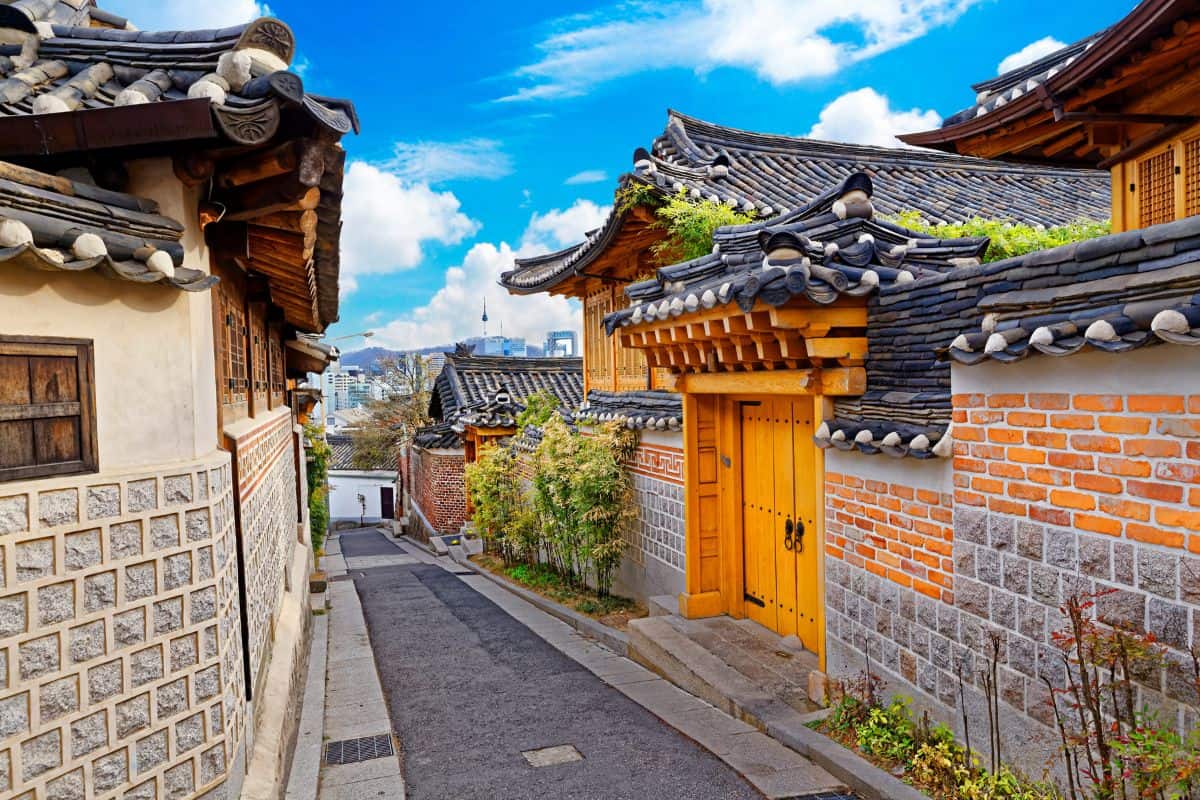
What To Eat In Seoul
In case you only have a few days in Seoul, this is where you'll get to sample a range of uniquely Korean foods. And hopefully also visit some of Seoul's dozens of delicious chocolate shops . So while you're in Seoul, be sure to look out for these top 5 Korean foods, particular to the country, but not to any specific region.
Japchae (잡채). A noodle dish containing thinly chopped vegetables, sweet potato starch noodles, and sometimes a little bit of meat. It’s great served warm as a main dish, but it’s often served as a side dish, tossed in sesame oil and soy sauce.
Hoddeok (호떡). This cinnamon sugar-filled fried rice cake is my absolute favorite treat. It's one of the few traditional sweets in Korea, but it's most easily found in the colder months, from October to April (I'd recommend you get it in the neighborhood of Insadong).
Samgyupsal (삼겹살). This is Korean pork belly, the most popular meat of choice in the country. It's just one of many types of meat you can have for Korean barbecue , which is basically a particularly communal style of cooking meat in the center of a table. If this is your only trip to Korea, you need to try this before you go!
Mul Nangmyeon (물냉면) . Translated as "water cold noodles," this chilled dish is made with buckwheat flour, and served with sliced cucumber & half a boiled egg on top. The dish is made with a meat broth and most commonly eaten right after barbecue, preferably with meat hot off the grill.
Samgyetang (삼계탕) . Quite possibly my favorite Korean meal, samgyetang is basically Korean chicken soup. The main part of the dish, thought be very healthy, is a whole chicken stuffed with rice and a bit of ginseng, jujubes, & ginko beans. You eat these with the side dishes and the meat & soup, after you dip it in the salt they serve on the side.
Buy a PDF Version of This Post!
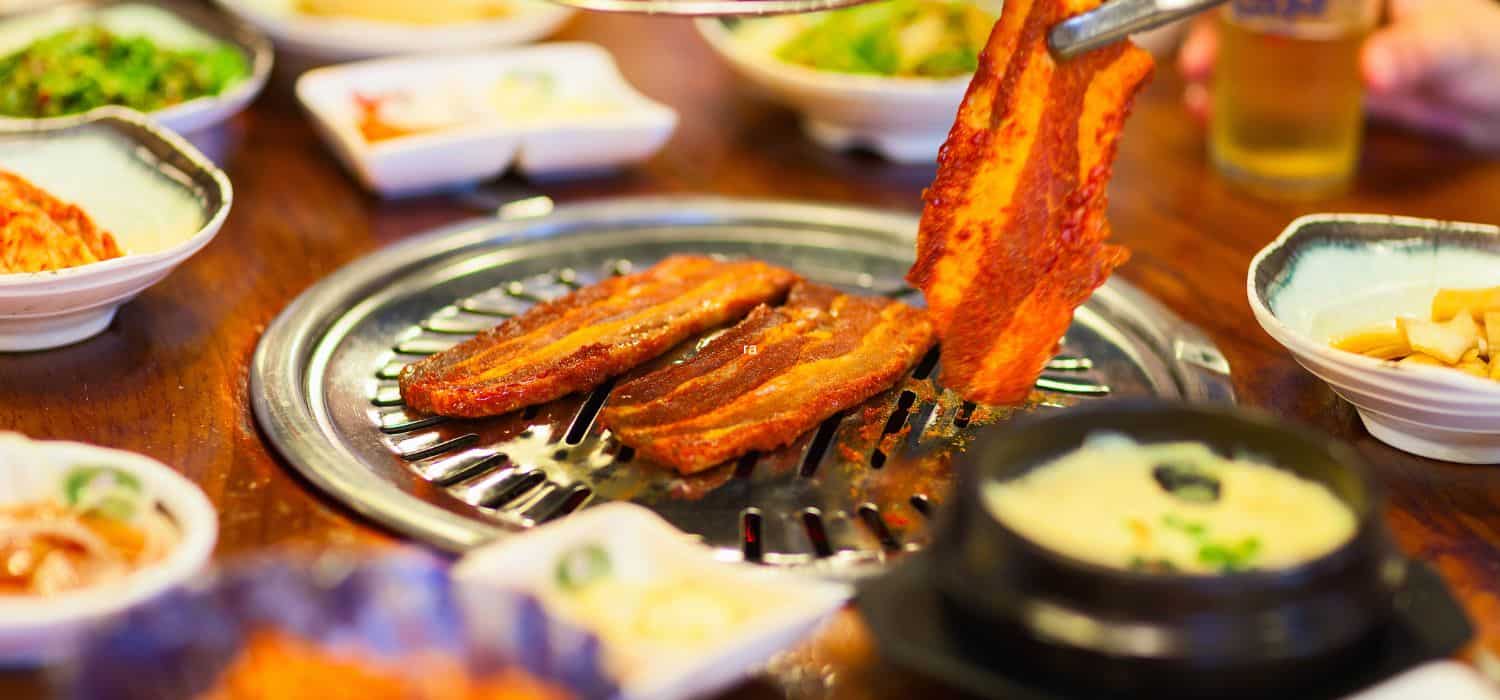
Where To Stay In Seoul
There are hundreds of lovely guesthouses and hotels throughout Seoul, and there are equally as many crappy ones. Most egregiously, some of them are both expensive and crappy. So here's my selection for the three best places to stay in Seoul . Each spot is centrally located, high quality, and foreigner-friendly. These are listed in order from least expensive to most expensive.
Budget: G Guesthouse
There's a reason this is always the recommended guesthouse in Itaewon. Not only does it always come in under budget, but the facilities are clean, the staff is helpful but unobtrusive, and the beds are comfortable. They even provide towels, a luxury not as common as you'd like.
Although you can't control what other guests do or what time they come back, my friends & I have always found that G provides a quieter environment for late-night entries than the other hostels in the area. Pro tip: the kebab place just down the street has the best kebabs in Seoul hands-down.
Mid-Range: Solaria Nishitetsu Seoul
Voted a traveler’s favorite in 2017, Solaria Nishitetsu is part of a Japanese hotel chain which combines comfort & convenience at a reasonable price. Guests love the huge rooms and large, firm beds, a real find in the heart of Myeongdong.
Because of its popular with business travelers, there are lots of harder-to-find amenities for digital nomads and other business people on-the-go, like work spaces and less-expensive single rooms.
Luxury: Signiel Seoul
Located in the top floors of Lotte Tower, Signiel is truly in a league of its own. Its sauna, gym, and pool facilities are world-class, with a staff and suites to match. Each room has a spa-style bathroom and a cozy place to rest your head, in addition to their unparalleled views of the city.
There are even free drinks and appetizers for guests in the hotel lounge, at all times of day. The Signiel is truly the place to get pampered, perfect for those looking for a honeymoon hotel .
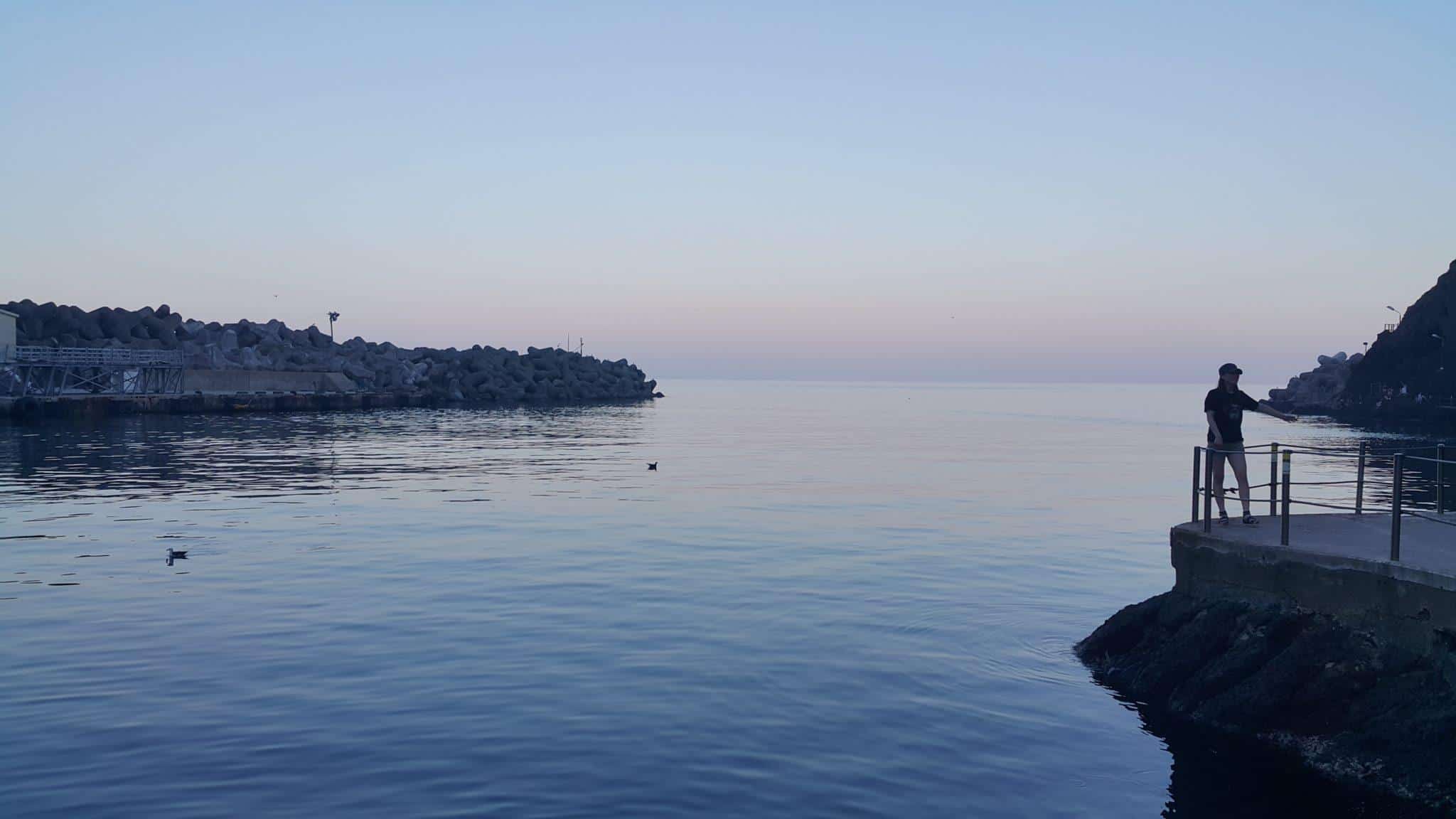
✈ Busan
What busan is known for.
Even though it's the second-largest city in Korea, and a metropolis in its own right, Busan doesn't get a lot of love from tourists. Most people think of it as a smaller version of Seoul, with a lot of the same cultural attractions but just harder to get to.
They have a point; Busan and Seoul are both massive port cities with cosmopolitan & hipster neighborhoods, alike. However, I'd argue that the feel of a place and its unique natural landscape plays a big role in your experience there.
In that regard, Seoul and Busan are more comparable to LA and San Diego. Seoul has glitz & glamour and a little of everything, while Busan has a more relaxed ocean-side vibe with lots of fresh seafood & quick flights to neighboring Japan .
As one of Korea's most popular weekend destinations, 3 days in Busan is plenty to see the city's highlights and get a feel for the ancient seaside temples , the beaches , and the local importance of cinema .
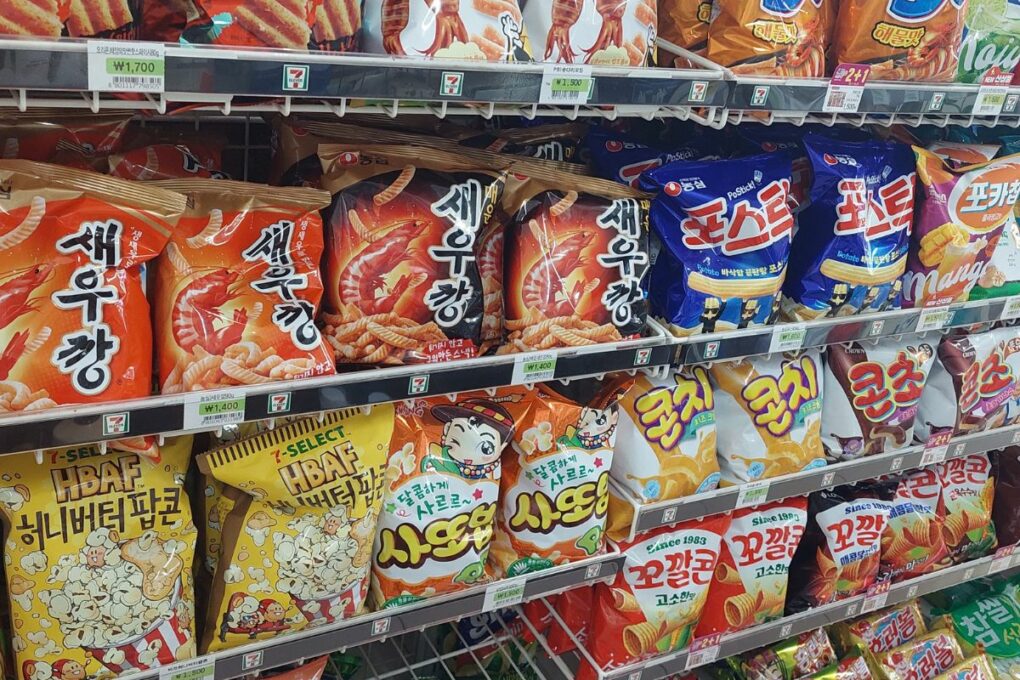
What To See In Busan
I won't write up everything you can do or see in Busan, since that'd take hours for you to pour through. So here are 7 things you can't miss seeing or doing in Busan (since 7 is a lucky number).
Lounge on Haeundae Beach. Undoubtedly the most popular beach in Korea, Haeundae is always packed in the summer, especially with families. But public schools don’t actually let out until mid-July, so if you time your visit well, you may just have a patch of sand to yourself. Note that beaches are only open for swimming from June to August.
Skip down Cheongsapo Daritdol Skywalk. This unique attraction has become quite popular over the last few years. It's basically a see-through bridge out over the ocean, perfect for showing off the ocean without you having to get in it. There’s also an observatory in the area, one of just 3 in the city. The skywalk is located a short walk from Haeundae Beach.
Explore Busan Cinema Center. As home to the Busan International Film Festival, which is held each fall, this is a great introduction to the film culture for which Busan is famous within Korea. The center has 3 buildings containing theatres of varying sizes, each offering daily tours & lectures. There are restaurants and cafes on-site.
Have a photoshoot in Gamcheon Culture Village. Probably the most popular photo backdrop in all of Busan, "GMC" has become known as a sort of Korean Cinque Terre . The calming blue houses look right out over the ocean, and are actually still people’s homes.
You'll see many an older person drying their laundry on their balconies and chatting on rooftops on sunny afternoons, so remember to stay respectful of the residents.
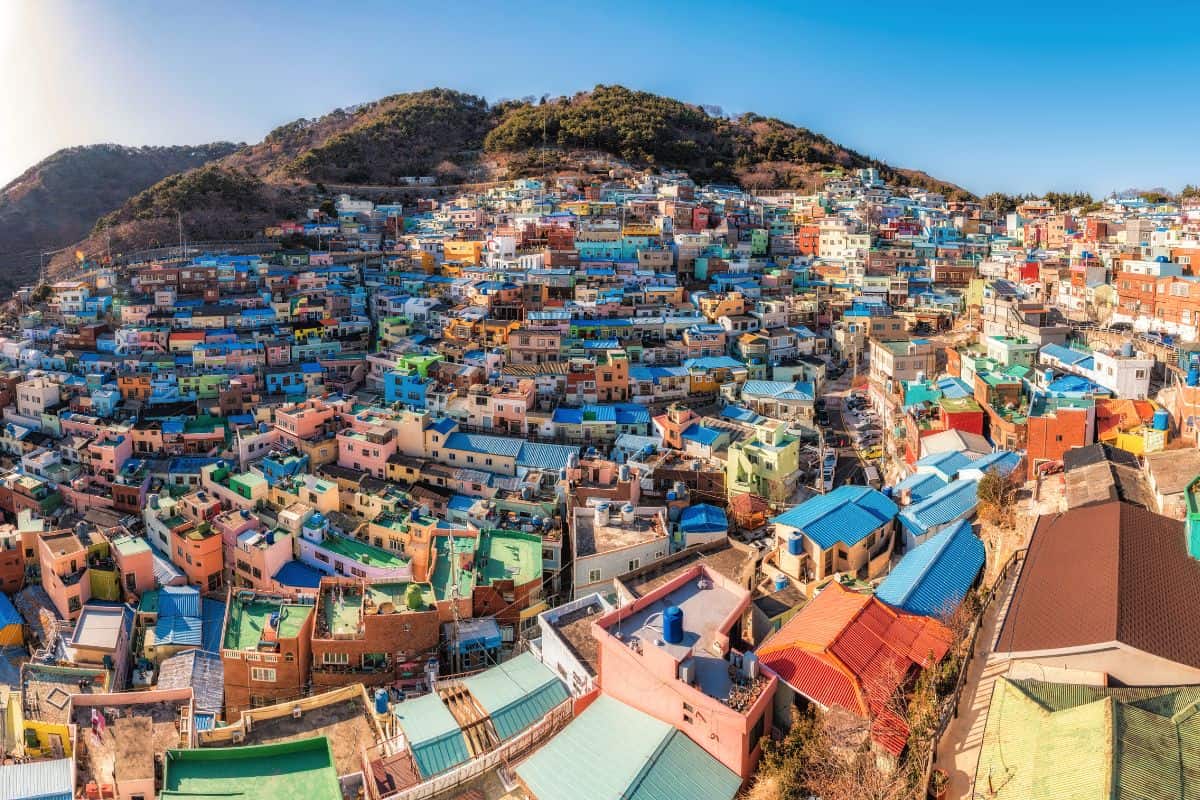
Have a meal at Jagalchi Market. This is the largest open-air seafood market in Korea, often compared to Noryangjin Market in Seoul. It’s actually become so famous that each October the city holds the Jagalchi Cultural Tourism Festival.
But even if you can’t make it on time for the festival, seafood lovers will have a blast walking through the market and exploring the diverse sea life found in Busan’s waters. The entire first floor is a wet market, while restaurants and the like are found on floors 2-7.
Wander the grounds of Taejongdae. Of all the things to do in Busan , this is by far one of my favorites. Equal parts resort & park, Taejongdae has become famous for its beautiful views and colorful tourist train.
The area's temples are accessible within an hour's walk, but even right around the entrance you can hike down and reach the shore in less than 10 minutes. Basically no matter where you go on the grounds, you’ll find a great view. Note that while it’s free to enter the grounds, this is likely to take up half of your day since it's so far south of downtown.
Watch sunrise at Haedong Yonggungsa Temple. In case you don't have the time to spare for a visit to Taejongdae, this is your alternative glimpse at Korea's ancient seaside temples. Most of Korea's temples are in the mountains, offering tranquility and spectacular views of life below.
But Haedong offers a broader view of the life going on below, focusing on the deep blue sea rather than countryside valleys. Some people come here to watch the sunrise, which is a spectacular choice considering it's on the east coast & opens at 5am!
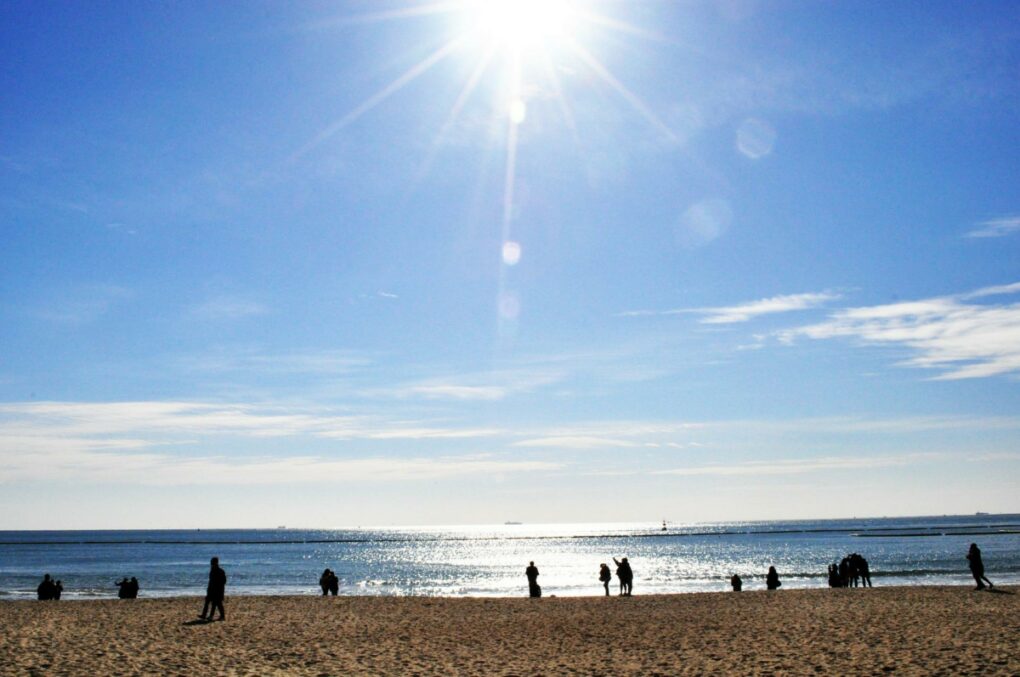
What To Eat In Busan
Busan is not a city for vegetarians or non-adventurous eaters, unless you're looking for chocolate in Busan , that is. The region's most famous foods are definitely of the sea variety, and thus, so are most of these 5 foods you should try in Busan. I have included a couple of land-based options for those who aren't into eau de ocean , however.
Sannakji : likely one of the most famous Korean foods, sannakji is often translated as “live baby octopus.” Cut & served immediately after being pulled from the water, sannakji are squirted with sesame oil & acidic fruit juices, making the tentacles continue to move around for minutes after death.
Haemul Pajeon : this is a seafood pancake, basically, but a Korean version (made with rice flour). They usually include tiny octopus, and are especially popular as a drinking snack, though many people come to Busan’s fish markets to enjoy them with family and friends.
Busan Jokbal : I don’t think I’ve ever met a Korean who didn’t like this dish. The jokbal , or pig’s feet, are cooked in a sweet cinnamon & honey mixture which reminds me of spiral-cut ham on Christmas. They're then served cut-up and ready for eating; the meat is fatty and rich, so don’t knock it ’til you try it.
Dwaeji Gukbap : this is a very hearty pork-based stew, prepared by slowly boiling pork bone into a broth & adding tender little pork bits. It’s served with rice and side dishes; you plop the rice into the stew and then eat it with side dishes of your choosing. It’s popular year-round, but is a must-try in winter.
Mulhoe : hoe literally means raw seafood, while mul means water. Mulhoe is therefore a raw fish soup, served cold & spicy with a variety of noodles and veggies. I'd only recommend it if you're eating somewhere right off the coast, like in Busan's Jagalchi market.
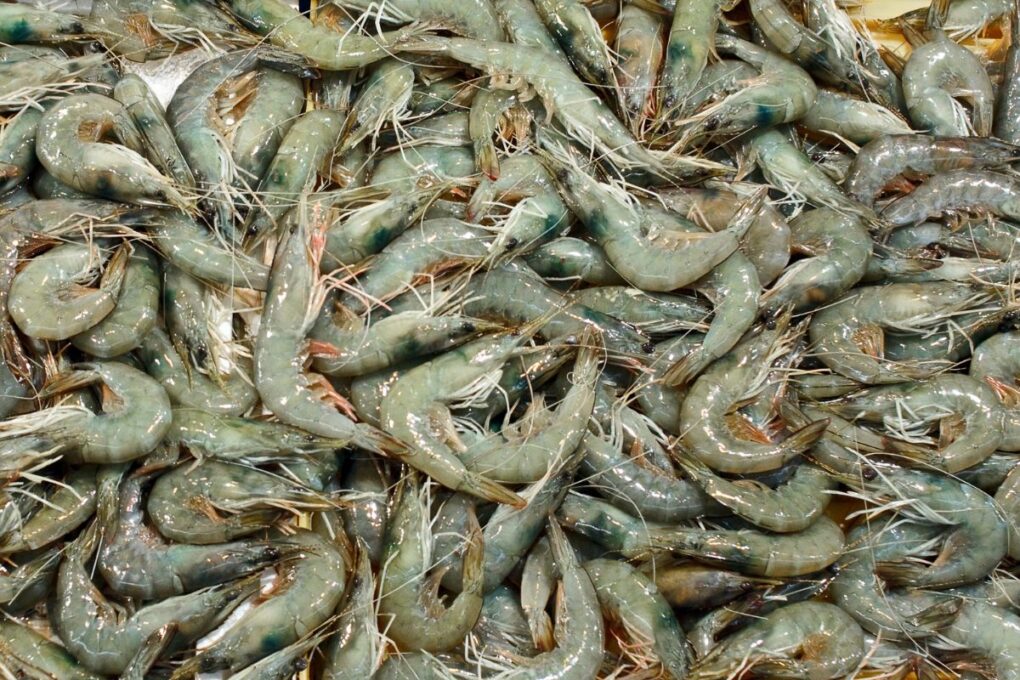
Where To Stay In Busan
Domestically, Busan is just as much of a tourist destination as Seoul is, since most of the people who travel around regularly are actually coming from Seoul. So Busan has hundreds of quality guesthouses, and probably an equal number of not-so-great ones.
So here's my selection for the 3 best places to stay in Busan , because there's no reason to suffer through a crappy, expensive hotel. Each of these spots is centrally located, high quality, and foreigner-friendly. These are listed in order from least expensive to most expensive.
Budget: The Bay Guesthouse
The Bay has become my go-to guesthouse in the warmer months, just 3 minutes from the beach & 2 minutes from the metro. It’s centrally located, the beds are large & comfortable, and the style is as a cross between a capsule hotel and a more typical hostel.
Every morning the manager even cooks breakfast for the guests, and there’s coffee brewed in the dining room.
Mid-Range: Stanford Inn Busan
Stanford Inn is a relatively new addition to Busan's "affordable luxury" lineup. But in the few years since it's opened its doors, guests have been very impressed with the high quality of the rooms & breakfast buffet.
Port-side suites garner the most praise, with guests impressed by the view and the proximity to the metro, just a few blocks in either direction.
Luxury: Lotte Hotel
Though best known internationally for department stores & perishables, domestically Lotte is known for offering a variety of luxury experiences; this includes their chain of hotels. Each suite in Lotte Hotel offers big fluffy beds and a spacious bathroom, as well as a bevy of modern furnishings.
Lotte Hotel is especially popular with families, thanks their reputable spa & restaurant facilities.
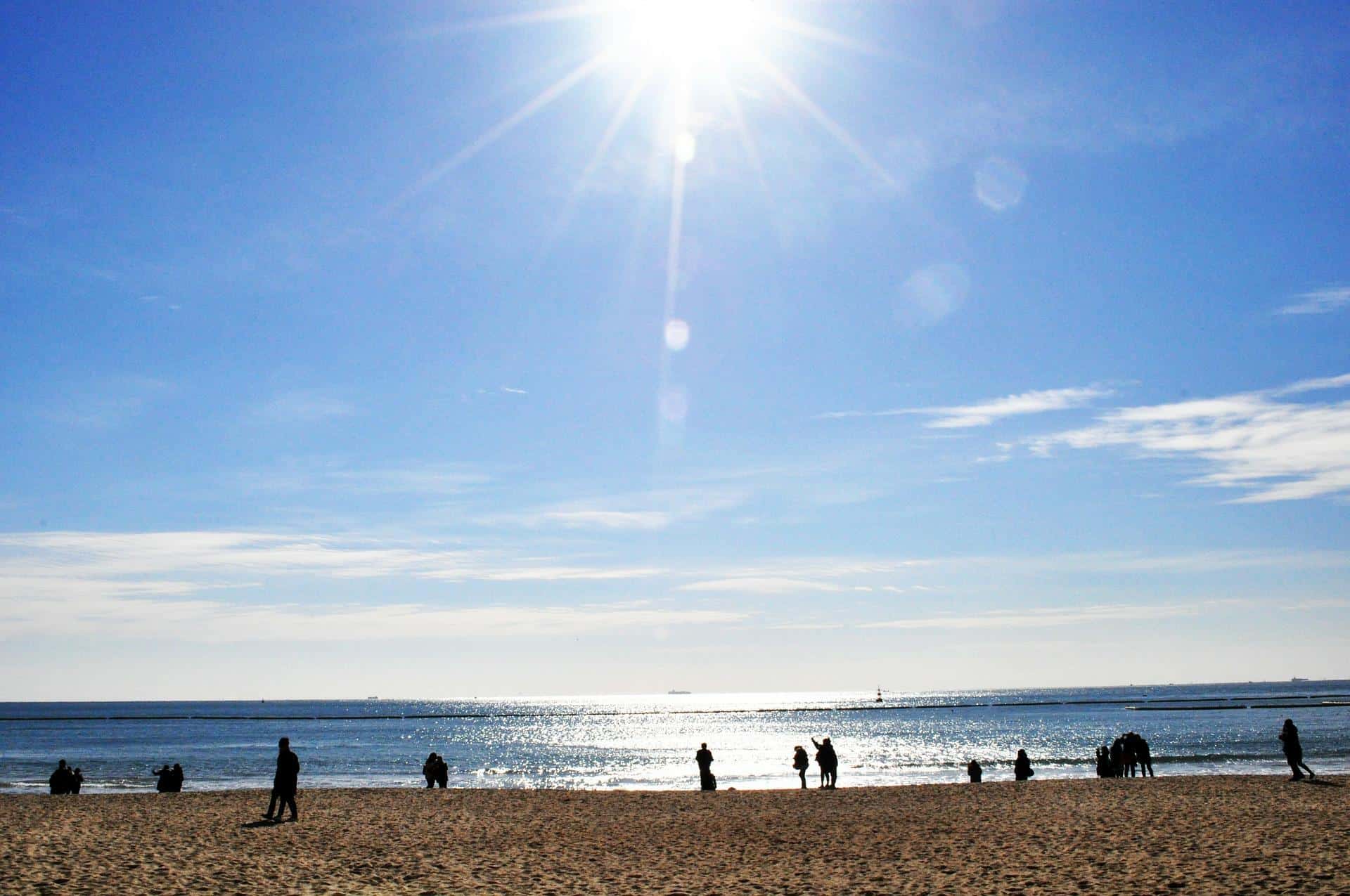
✈ Jeju
What jeju is known for.
A few days after one of my trips to Jeju, a Korean friend told me he was jealous that I went without him, because Jeju is his "stereotype of a beautiful place." Well to be honest, it's mine, too. Jeju is breathtaking in the spring & fall, and somehow a haven from the mainland's overwhelming weather in winter & summer.
The route from Seoul's Gimpo Airport to Jeju is actually the most traveled route in the world . That's how much Koreans love visiting this idyllic little island off their southern coast. But tourists? Not so much. Every time I visit Jeju, mine is one of the very few foreign faces I see.
But Jeju Island has so much to offer, from gorgeous hikes to unique local foods , that there's no reason it shouldn't be on every South Korea travel itinerary. Jeju is the place for you if you love exploring natural beauty , learning about sea life , and relaxing seaside .
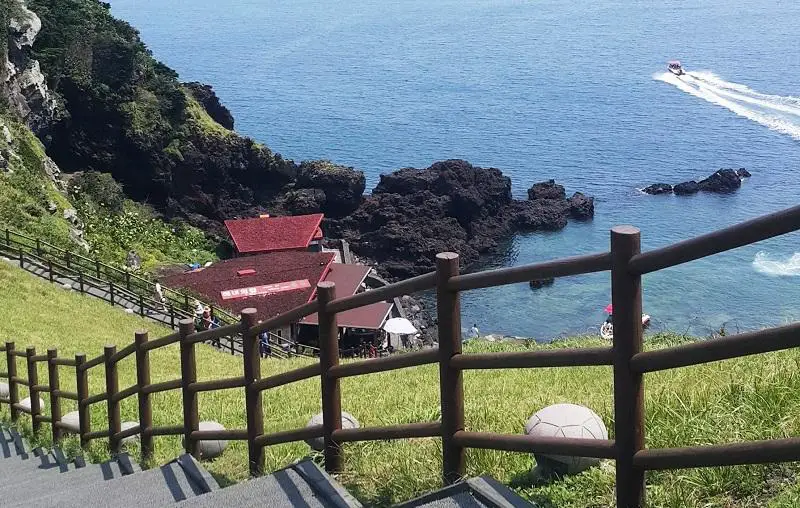
What To See On Jeju
There is such an incredible number of things to do on Jeju, in every season, that you could spend hours researching. But to give you an idea of some of the many Jeju attractions across the island, here are 7 things you should do or see on Jeju Island.
Pose in Love Land (erotic museum). This is often one of the most unexpected sites to find in Korea: a park full of penises & other various erotic sculptures. The park was opened in 2004 by a group of art students from Seoul’s prestigious Hongik University, and since then the park has been a surprising success, where selfies abound. You must be at least 18 to enter the park .
Watch sunrise at the top of Seongsan Ilchulbong. Is this in Korea or the Highlands of Ireland? The immensity of the green and the brightly colored flowers that greet you in the spring could very well distract you from ever climbing to the top of Seongsan.
From the hike to the viewpoint, horseback riding, and boating, you could easily spend half a day here. If you’re lucky, this is also where you’ll catch site of some of Jeju’s famous women divers, though you may see some on the walk over.
Hike around Seopjikoji. Just across from Seongsan Ilchulbong is Seopjikoji, an area famous for being the filming location for several dramas, and just a stunning place in general. The stairs built into & walking trails leading along the cliffs can get a bit crowded on weekends in the summer.
But if you get too hot, there's also a sea side restaurant at the top of the climb. Seopjikoji's most gorgeous scenes are in the spring, when the hills are vibrant green and dotted with bright yellow canola flowers.
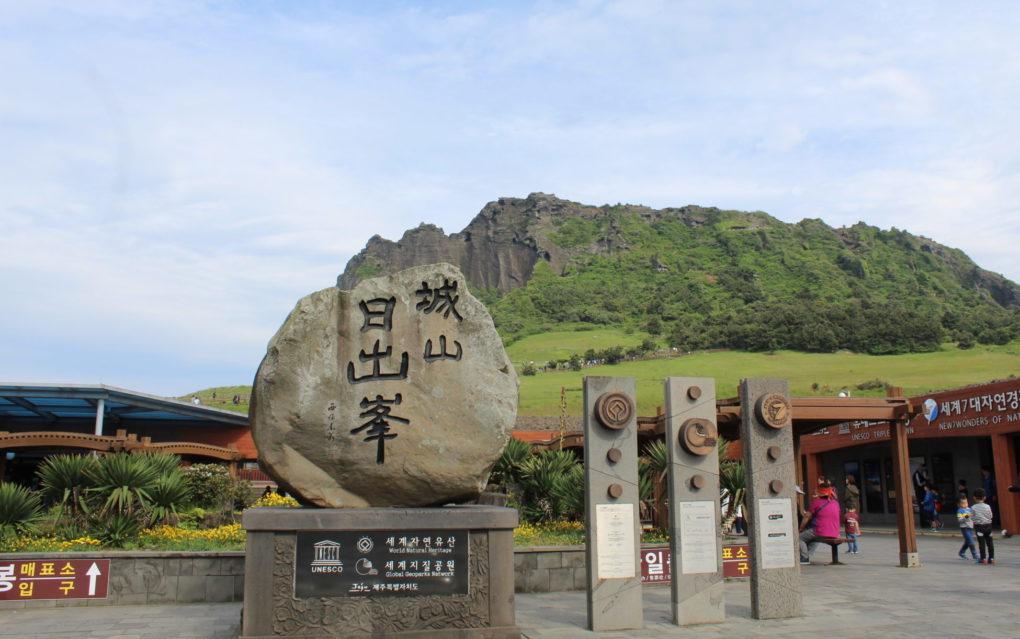
Stare in awe at Jeongbang Waterfall. Jeongbang’s claim to fame is that it's the only waterfall in Asia to fall directly into the ocean. It's honestly a cool sight to see, basically from the parking lot, making it my pick for the best waterfall in Jeju.
There’s even a tiny beach in front of it, just before the vast ocean extending way beyond. The shops just along the parking lot will also be selling souvenirs, oranges, and Jeju chocolates.
Walk the Jusangjeolli Lava Cliffs. Often compared to Giant’s Causeway in Northern Island, Jusangjeolli is another act of nature bestowed upon Jeju by the volcano from which it was forged. Less than 5 minutes from the parking lot, the cliffs are deep grey rectangular formations jutting out into the ocean.
It almost looks as if they were formed by a child slowly stacking blocks. They’re quite the popular photo spot, and certainly worth a stop, though lines for selfies can get long on weekends.
Bathe in Sanbangsan Carbonate Springs. This will be one of the strangest experiences of your life, if you’ve never been to a Korean sauna. Everybody here is separated by gender, and then strips themselves buck naked.
It takes some getting used to, but when you do, it’s glorious. These hot springs are divided by each temperature and healing properties, making for a very soothing way to spend an evening.
Sip on a cup of tea at O’Sulloc Tea Fields & Museum. The museum is tiny, but if you came to the fields for the tea products, then this is your spot. The aforementioned museum is attached to a massive cafe serving up a variety of teas from their farm, plus coffee and desserts.
The entire complex is located next to a cosmetics shop & a second cafe. But the best part for most people will be the tea plantation itself, situated across the street from the museum, and laid out with pictures in mind.
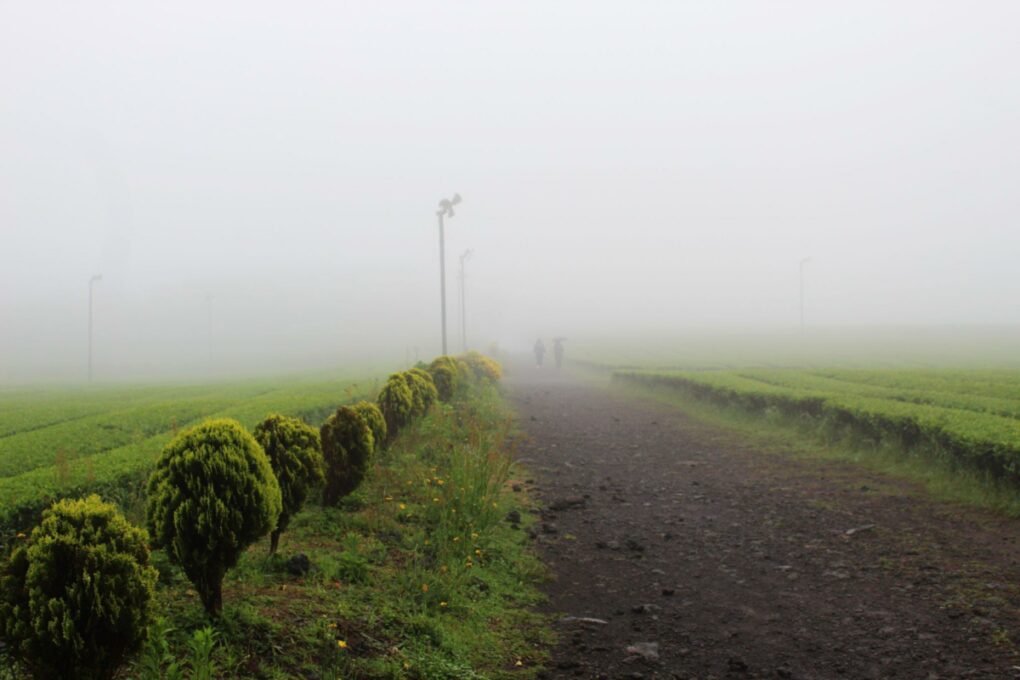
What To Eat In Jeju
Like all other provinces and cities in Korea, Jeju has a few foods it's famous for, but unlike most of those other regions, Jeju is famous for them because they're actually grown there. A few of these products have turned into a whole range of foods, all focused on that one crop. Take a look.
Abalone (Sea Snails). I know the translation doesn't sound very appetizing, but abalone are actually shellfish, more like oysters than snails (but don’t go looking for any pearls). They’re one of the many sea foods caught by the women divers of Jeju, and are caught & served fresh daily. Local favorites are abalone rice porridge and grilled abalone.
Black Pork. This is meat from a specific type of pig raised mainly on Jeju Island , and I find it to be a softer & more flavorful version of the meat found on the mainland. If you’re looking for easy pickings of a variety of black pork restaurants, check out Black Pork Street in Jeju City.
Hallabong (those big oranges grown throughout the island). The season for hallabong is actually winter time, but some of the groves manage to grow oranges year round. So you’ll see these thick-skinned beauties for sale in boxes along the side of the road, and at gift shops in most of the major tourists sites. Keep an eye out specifically for hallabong tea.
Green Tea Anything . Home to the well-known O’Sulloc tea fields, you’ll see green tea-flavored things for sale throughout Jeju. But nowhere is there a higher concentration of tea-flavored items than at the O’Sulloc tea museum, itself, which is profiled above.
Peanut Ice Cream. Depending on where you get it from, the cream flavor can be more or less intense, and the ice crystals can be very strong. But peanuts are actually grown on Udo, an island off the coast of Jeju, making it a truly local food. Though honestly, most people just buy it for the cute pictures.
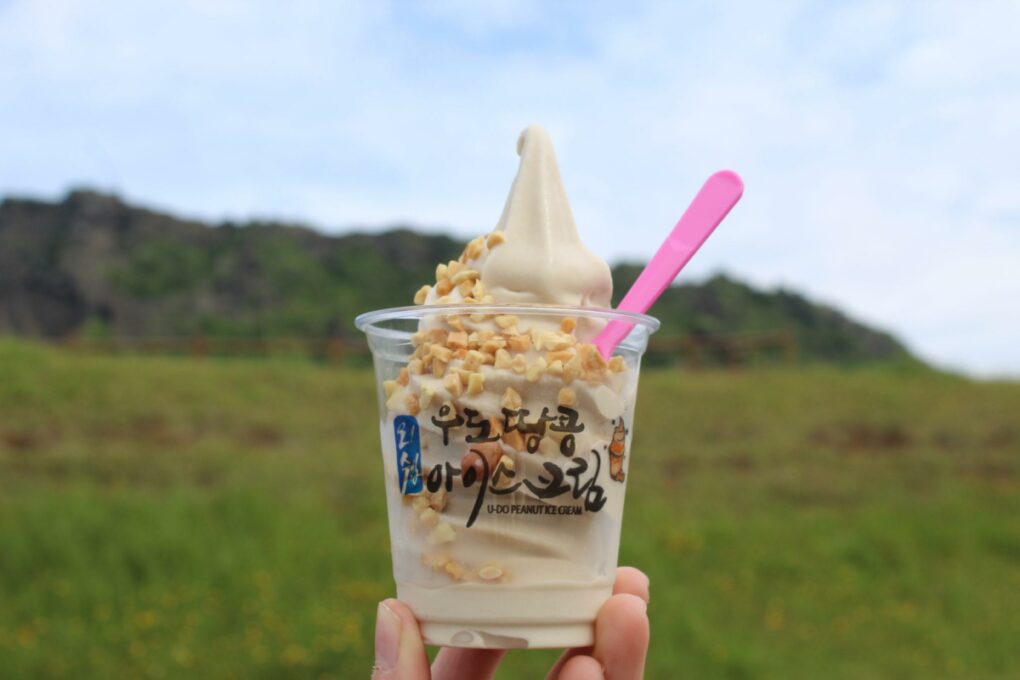
Where To Stay On Jeju
Since so much of the Island's economy depends upon tourism, you'll have your pickings of Jeju accommodation, especially in Jeju City and the southern city of Seogwipo.
But there are some hidden gems, so allow me to shine light on 3 of the best places to stay on Jeju . Each spot is centrally located, high quality, and foreigner-friendly. These are listed in order from least expensive to most expensive.
Budget: Yeha Guesthouse
Seoul is famous for their inexpensive accommodation, but Jeju City really puts up a fight. Yeha is the best choice for backpacking or budget-minded visitors, with a solid 9/10 rating for their dorm beds, and a good connection to island's public transporation.
To top it all off, they’ll happily store your luggage for you if you want to explore a bit before your flight back.
Mid-Range: Color In Jeju
If you’re looking to stay on the eastern coast and want to splurge a bit, Color In is the move. They’ve got immaculate rooms, a small outdoor pool, and the rugged surroundings typical outside of the big cities. Front desk hours are limited, but that’s easily overlooked once you get to the pool.
With just 6 guest rooms in the entire place, odds are good that yours will be poolside.
Luxury: Kensington Hotel Jeju
One of the highest-rated hotels in Jeju, the Kensington contains all the opulence one expects from a 5-star hotel, infinity pool included. If the layers of indoor & outdoor pools isn’t enough, however, consider the superb staff and various on-site restaurants; their breakfast buffet is included in your stay.
Within walking distance of the hotel are a botanical garden and the teddy bear museum.
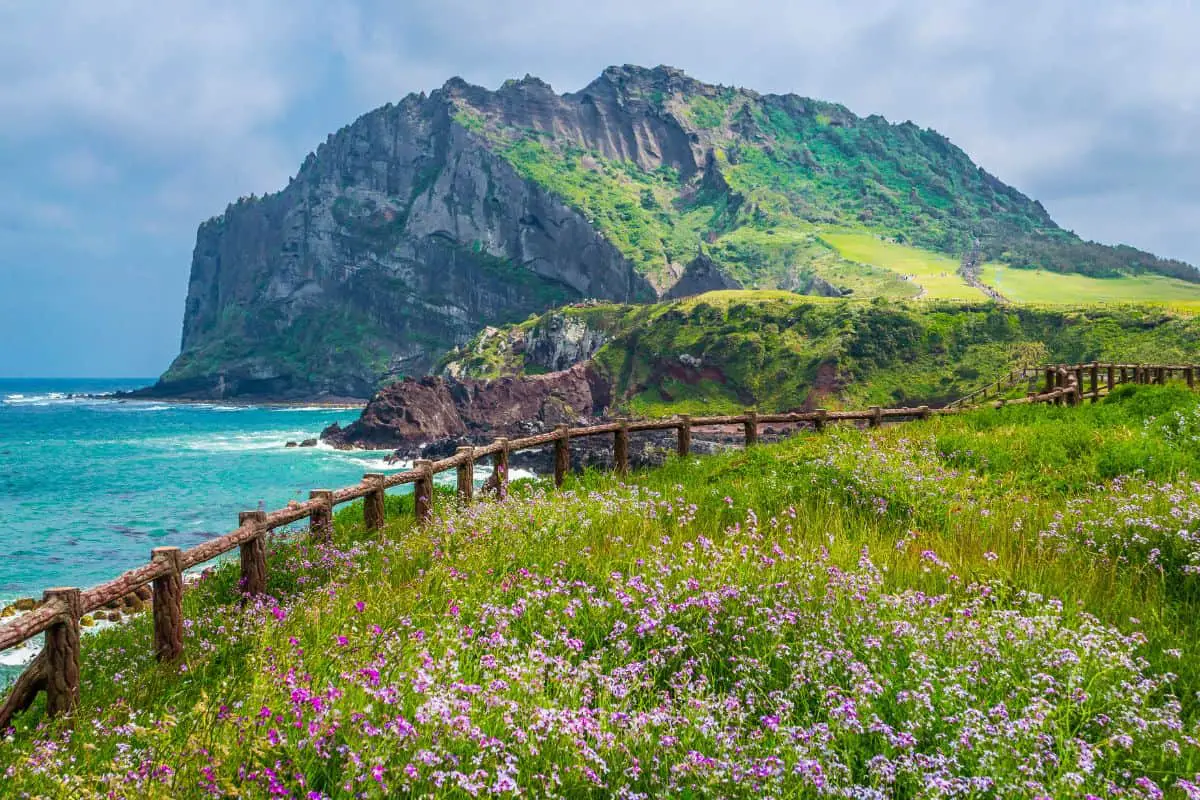
✈ Suncheon
What suncheon is known for.
Of all the cities in this Korea itinerary, Suncheon is probably the least famous internationally. The city has just a few hundred thousand residents, quite small by Korean standards, but each spring the county is flooded with domestic tourists chasing beautiful flowers and stunning natural landscapes .
But despite its size, I'd recommend Suncheon because of its great potential as a base from which to explore the rest of southern Korea. Just south of Suncheon are Boseong, where most of the country's green tea is grown, and Yeosu, a beautiful island with lots of attractions in its own right.
Northeast of Suncheon is Gurye, whose spring flower festival & fall cherry festival are famously striking. Simply put, people visit Suncheon in order to revel in the beauty of nature , get away from the big cities , and enjoy the festival culture of small Korean communities.
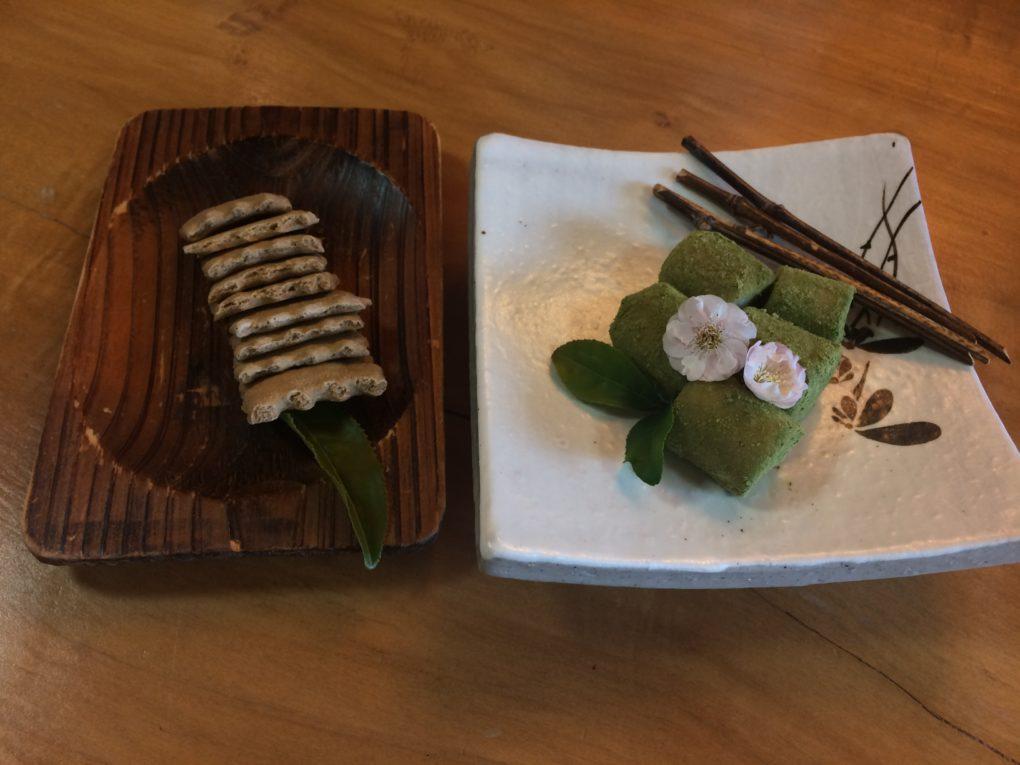
What To See Around Suncheon
As just one of four great cities to explore in southern Korea, it's difficult to distill Suncheon attractions into one post. But in order to lend an idea of some of the things you can do around Suncheon, here are 7 things you should do or see near Suncheon City.
Learn hands-on at Naganeupseong Folk Village. With remaining residents numbering in the hundreds, calling this a village is a bit of a stretch. But Naganeupseong is more like a demonstrative village, offering visitors performances and traditional experiences you couldn't find even in Seoul.
Each region of Korea has their own unique traditions that they've chosen to keep alive and highlight here. This means that for as vast & varied as Seoul is, you won't find as many ways to experience southern Korean culture up there.
This is honestly in large part because most Seoulites see Korea's southernmost areas as countryside and backwards and unworthy of a visit. However, I think that each is gorgeous (including my own countryside town), and this one in particular is worth a trip.
Hike the Suncheon Bay Gardens & Wetlands. Small crabs reach up at you from the mud, wheat whispers in the wind, and old people are probably yelling from just behind you. So go the wetlands. Starting from the parking lot and continuing on through the carefully-curated gardens, you'll reach the wetlands themselves.
From there you can cross the gardens via a long bridge. On the other side is a small mountain, which you can take about half an hour to hike up, or you could stop and turn around where you are, admiring the other side of the wetlands' natural beauty.
Picnic at Suncheon Bay National Gardens. When I think of gardens, I think of somewhere well-kept and brightly-colored, maintained within a specific small area. Suncheon's National Gardens are a vast and impressive version of that, including not just flowers but also sculptures, a bridge covered in hangeul , and a variety of cafes & eateries on site .
In peak bloom season, from around mid-March to mid-May, you could easily spend a whole day walking across the ponds and admiring the colorful fauna, wondering why you didn't come here sooner.
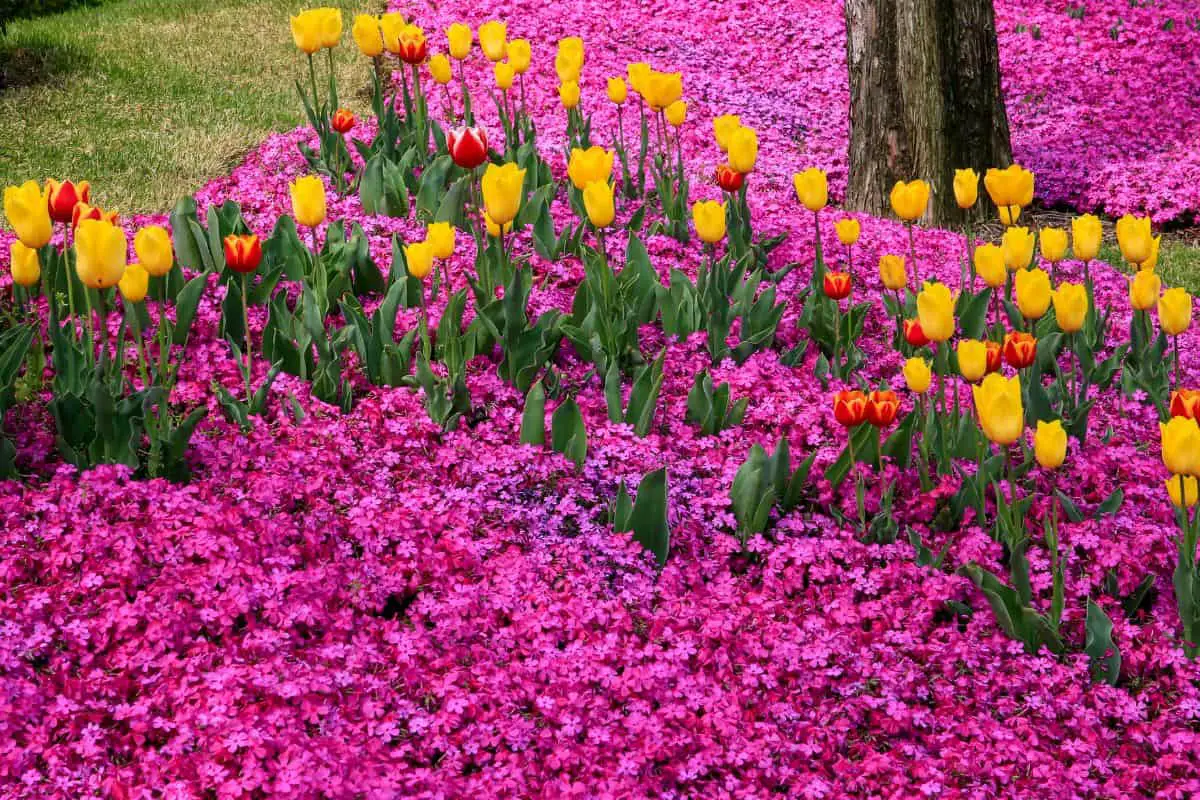
Relax at Jirisan Spa Land. If you've never been to a Korean sauna, you are missing out. Spas are a national past time here, and they're also quite affordable, and fun in a group, couple, or solo.
Jirisan is particularly well-known because it features hot springs-supplied baths. Keep in mind that like all Korean spas, the indoor regions of the spa are separated by gender and have a no-clothes policy.
Do a photo shoot amongst Gurye Cherry Trees. These bright yellow blossoms have taken up root throughout the village of Gurye, bringing hoards of people (& tourism dollars) to town every spring. In the fall, the trees' cherries cover them in color once again, this time a deep red. If you manage to visit in March (outside of festival time), you may even find this to be the perfect spot for a photo shoot.
Ride the Yeosu Cable Car. Especially beautiful around sunset, Yeosu's cable car takes you across the bridge which connects Yeosu to the mainland. From an incredible height it gives you a look at the still-active port area and many smaller surrounding islands. Not to mention it saves you a taxi ride!
Drink up at Boseong Green Tea Fields. The green tea fields of Boseong hit their peak around mid-May, but they start turning a deep green color as early as March, continuing to lighten until late September. Koreans come to visit the main green tea plantation in order to hike up to the top of the hill on which the tea trees are planted.
Most people end up taking selfies and enjoying the view of everyone walking around far below them. At the plantation, other than the tea itself, you can enjoy green tea-flavored churros, lattes, and even a few savoury dishes (though don't expect much tea to be put in those).
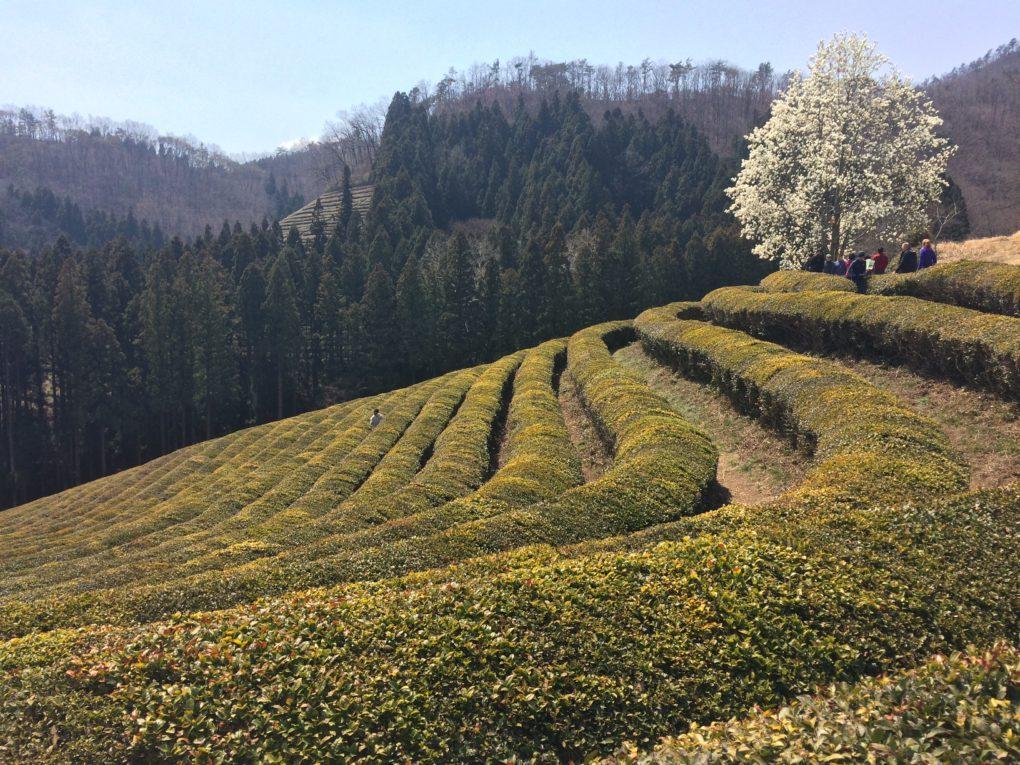
What To Eat In Suncheon
Suncheon is often hailed as the foodie capital of the southern part of Korea. Located near the coast, in Jeollanam-do, local restaurants in Suncheon will serve all the classics, but with a southern twist. Popular themes include seafood, fresh local vegetables, and abundant side dishes.
Mudskipper Soup. Arguably the most popular way to consume this local fish, the soup is prepared using boiled fish, radish leaves, and soybean paste. It's a very strong flavor, but all the side dishes it's served with temper it beautifully.
Kongnamul Gukbap . Literally "soybean soup rice," you can find gukbap all over Korea; I actually recommend trying a hearty pork or beef version in Busan.
But each region has their own special recipes for the soups and when they add the rice and where they source the ingredients. In the case of Suncheon's gukbap , the soybean sprouts add beautiful crunch to a very traditional Korean dish.
Sannakji Bibimbap. Another dish I sort of recommended in Busan, sannakji is basically the freshest form of raw octopus you could eat, served with lemon juice and seasoned with sesame oil. This iteration is less of a snack and more of a full meal, incorporating fresh vegetables and rice. Look for 산낙지비빔밥 on a menu.
Green Tea Churros. I couldn't recommend visiting the green tea fields of Boseong without also recommending the snacks! Only available on the weekends, these churros are nice when paired with a cup of green tea soft serve ice cream.
Grilled Duck. Suncheon famously raises about half the duck in Korea, meaning that finding a local duck dish is more likely than not. If you can find it, my favorite is Yangnyum Ori (양념오리).
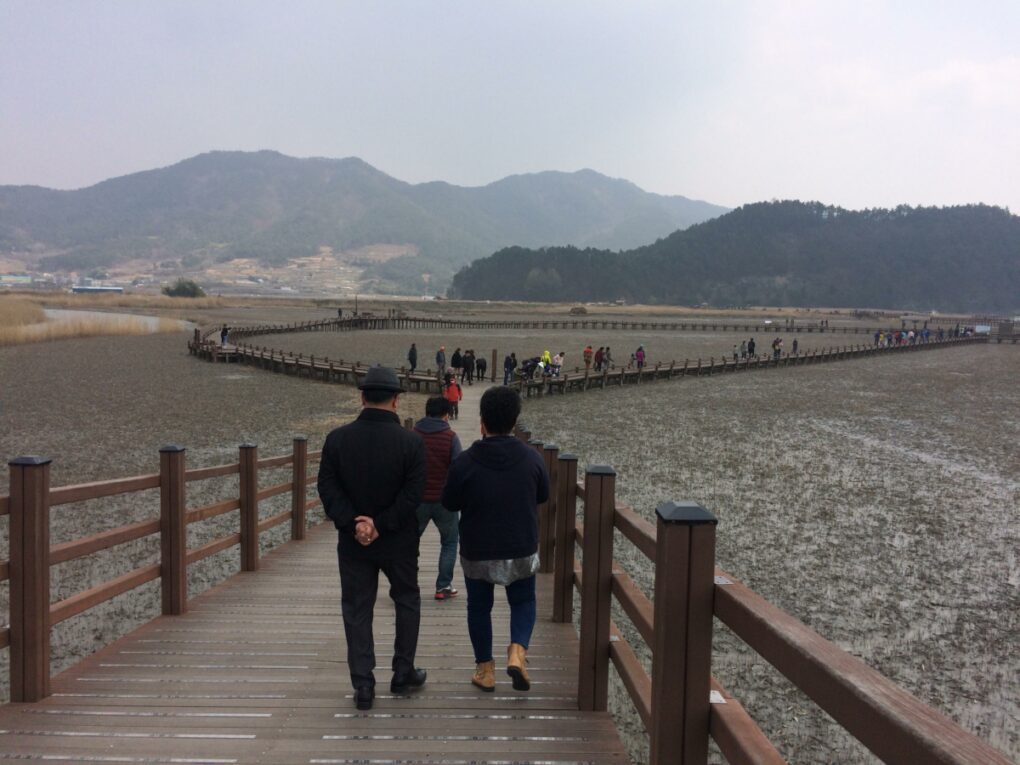
Where To Stay In Suncheon
Suncheon is quite the hot spot for domestic tourism, so most of the places to stay in Suncheon are Korean-style. This means that you sleep on the floor, and usually call to book directly. But there are some nice western-style guesthouses to choose from, three of which I've listed below. If you're visiting Suncheon between April and June, I'd recommend booking a guesthouse in advance!
Budget: Suncheon Namu Guesthouse
You can't get much closer to Suncheon bus terminal than Namu Guesthouse. No matter what time of day or night you arrive (or depart), if you stay at Namu you're just a few minutes from the city's bus terminal.
The beds are pretty standard for Korea, on the hard side, but the shared space is very homey and comfortable. At just $16USD a night for a dorm bed, it's the perfect spot for those planning to stay awhile and do a lot of day trips.
Budget: Baguni Hostel
It's rare to find a hostel with affordable dorm beds and a decent sense of privacy, but Baguni manages to strike this balance with grace. The dorm beds are each in their own little cubbies, with privacy curtains and fluffy bedding.
But the building itself makes use of lots of white and neutral tones, choosing to focus mainly upon providing a clean, comfortable, and affordable environment for guests.
The hostel is located right in the city center, a short walk from the bus terminal, making it a great choice for visitors who can't or choose not to rent a car. Single hostel beds start at $18USD a night.
Mid-Range: Hotel Iam
Every room at Iam includes an en-suite bathroom and complementary breakfast in the dining room. For those looking to upgrade their stay in Suncheon, this is an affordable hotel with comfortable beds, a nice staff, and a central location.
It's family-friendly, but more popular with couples looking to get away from hostels without breaking the bank. Double rooms start at $40USD.
Click here to check out prices for other hotels in Suncheon
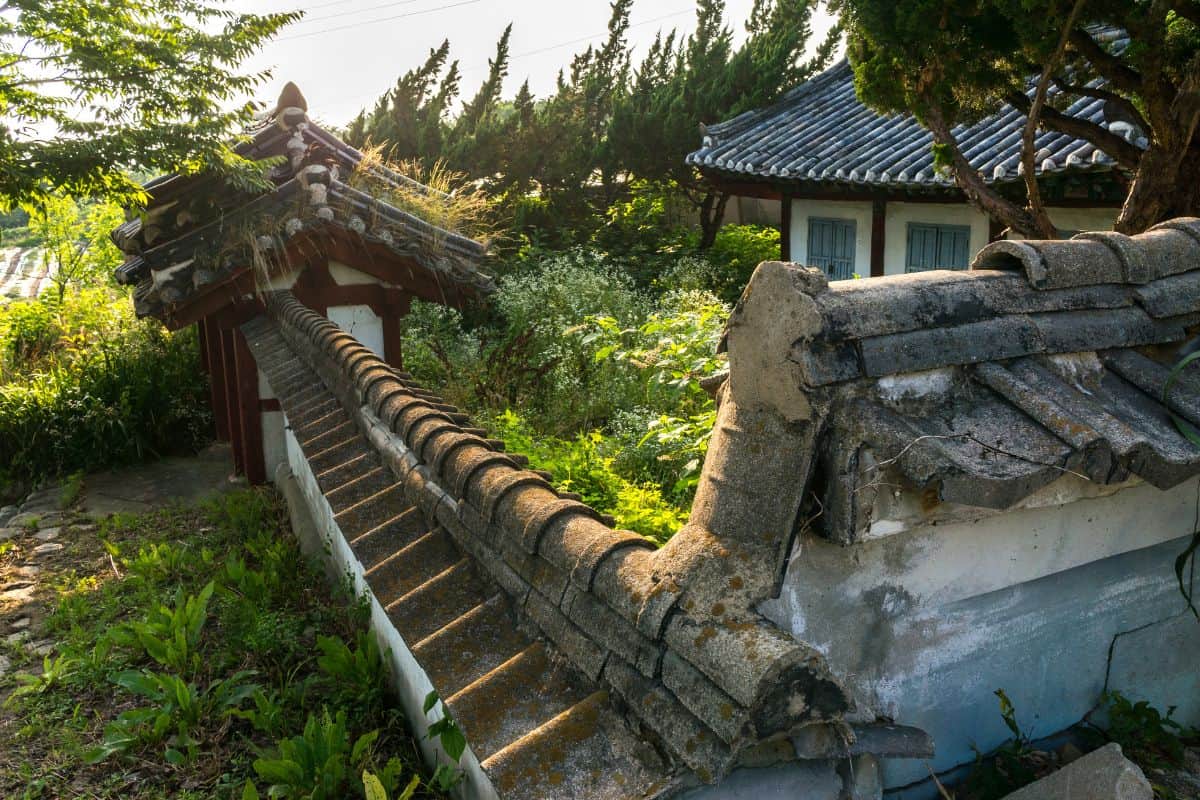
✈ Jeonju
What jeonju is known for.
Despite being just 1.5 hours from Seoul, Jeonju rarely features on a Korea itinerary, and that is a mistake. While you can easily visit Jeonju on a day trip from Seoul, I humbly recommend you spend at least two days in the city.
Preferably while staying in one of the historic houses & enjoying traditional Korean dishes in Korea's "Foodie Capital." Unlike Suncheon, most of the things to see in Jeonju are within the city itself, making it walkable and perfect for any wintertime Korea itinerary.
Seoulites tend to visit the city on the weekends, so take a couple of weekdays to discover the city whose name literally translates as "perfect region." While you're there, make the most of your time with visits to local galleries and walks around the city's many parks and green spaces.
Jeonju is seen as a very spiritual city, a place of historical importance for its maintenance of traditional foods, architecture, and those intangible parts of Korean culture we all strive to experience in a new place.
What To See Around Jeonju
Jeonju is a great place to just walk around, similar to some of the neighborhoods in central Seoul, but it's always nice to have a destination in mind. So in order to give you an idea of some of the things you can do in Jeonju, here are 7 things you should do or see in the city.
Photoshoot in Jaman Mural Village. Somewhat similar to Gamcheon Cultural Village in Busan or Rainbow Village in Taiwan , Jaman has become a symbol of revitalization for older parts of the city.
While the nearby hanok village has become well-known, just beyond the overpass is Jaman, a neighborhood painted up & beautified by local artists. The uphill scene is worth the trip, and makes for some very cute photos, especially for families and couples.
Tour a Hanok . A hanok is a type of small house, traditionally one story tall, which were the main type of dwelling in Korea for centuries. Due to Jeonju's ancient status, it was designated a UNESCO City of Gastronomy, and as a result, the rest of the city has also been well-preserved.
One thing that sticks out in Jeonju compared to Seoul or Busan is the height of the buildings. It can be hard to put your finger on at first, but you'll quickly notice how short most places are, and how it opens up the entire city.
This is due in large part to the city's hanoks . Places feel greener, even when you visit Jeonju in the winter. While you can tour a hanok (hopefully stay in one, too!) just by walking by, I'd also recommend checking out Gyeonggijeon Shrine for a more holistic look at how hanok culture shaped contemporary Korea.
Eat Street Food at Nambu Night Market. You can't recommend a visit to Jeonju without also recommending a trip to a night market. Korean night markets are notoriously boisterous affairs, with locals loudly hawking their wares from the safety of their booths, wafting any number of smells your way. The market is open every day, but Fridays and Saturdays are the busiest of all.
Some delicacies to enjoy once you've feasted your eyes are the grilled meat skewers, daepae saewoo (pork-wrapped shrimp), and hoddeok (honey cinnamon-filled rice cakes), though there are many international dishes, as well.
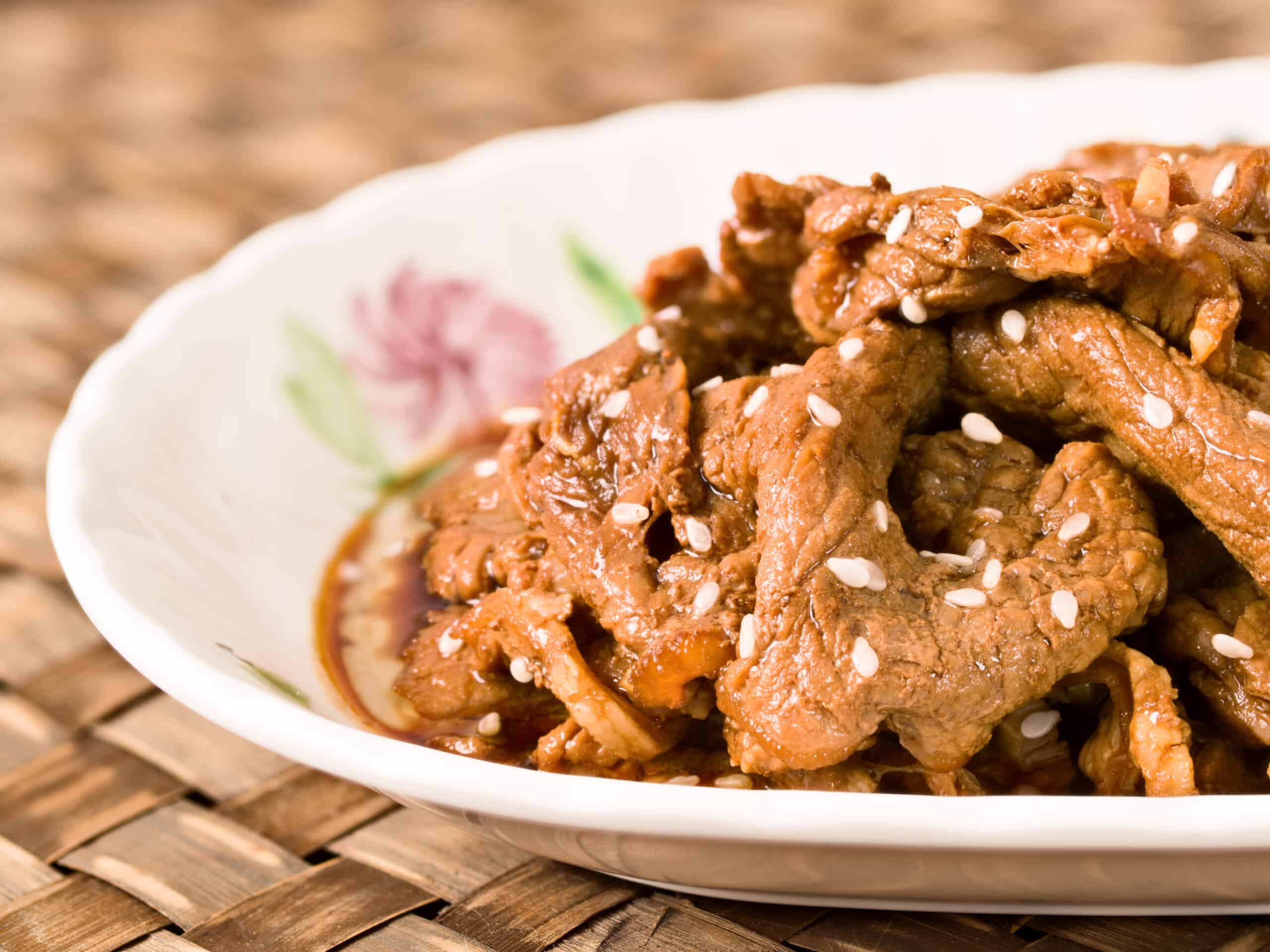
Try Dolsot Bibimbap With Makgeolli . Those little gold bowls full of translucent white liquid have become a staple in my life. Anytime staff at my job went out to dinner together, we always had makgeolli (rice wine), usually served from a big pot in the center of the table.
This is the most traditional way to consume the traditional rice liquor, and it's a great accompaniment to Jeonju's famous version of bibimbap (mixed rice). Try it almost anywhere in the ancient village, and I guarantee a smile.
Wear a Hanbok Amongst Hanok. Similar to the beautiful hanbok (traditional Korean outfits) you'll see in Seoul and Busan, it's almost a rite of passage to wear a hanbok around Jeonju. If you want a more unique experience in the city, this is the move. Rentals start from ₩8,000 (~$7USD), and range from 1-4 hours.
Have Tea in an Ancient Cafe. Or at least in a cafe that looks ancient, as many of the cafes in Jeonju's downtown area have been styled to look.
Some of the cafes are even in a hanok , which makes the tea-sipping feel all the more event-like. Some great cafes in Jeonju are Café Haengwon and Swan Park Cafe, but just remember to have a translation app on hand for the menus.
Admire the Flowers in Deokjin Park. One of the most popular gathering places in Jeonju, Deokjin Park has now become a draw for visitors, as well. In the spring there are flowers everywhere, while the summer sees the lotus blooming on the lake & fall brings changing colors to the leaves.
If you visit from July to August you'll notice crowds of locals taking pictures with the lotus flowers, as the high season coincides with kids' summer break.
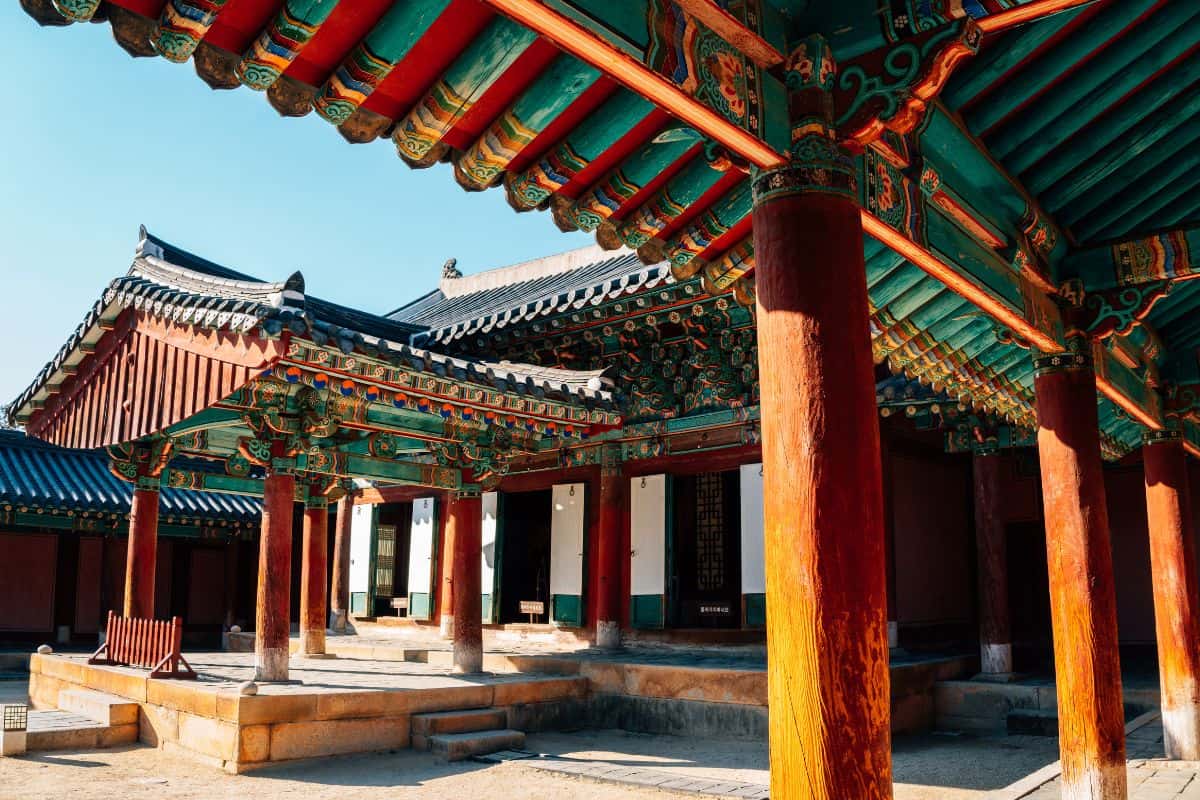
What To Eat In Jeonju
Despite the popularity of Suncheon as Korea's underground foodie capital, Jeonju is the official foodie capital of the country. In fact, in 2012 it was named a UNESCO City of Gastronomy. Domestically, Jeonju is known for its fresh vegetables and locally-grown rice, as well high levels of spice, so prepare your palate.
Legit Choco Pies. The infamous Korean treat of Choco Pies, which my students simply adore, were actually born at a bakery here in Jeonju. The bakery, PNB, has branches throughout the city, where you can find the layered chocolate and marshmallow pastry in multiple iterations.
Grilled Imsil Cheese. Korean cheese is notoriously gross. But many years ago, in a town just outside of Jeonju, one company faced this problem head-on: Imsil. In street food regions throughout the city you can find thick skewers of carefully grilled Imsil cheese, lightly sweet and crispy on the outside, halloumi-like in texture.
The brand also makes some delicious yogurt, and if you took the bus to & from Jeonju, you may even stop at an outpost where you can buy some of their cheese & yogurt. Go for the blueberry flavor; you can thank me later.
Jeonju Royal Court Cuisine. Gung hanjeongsik , as it's called in Korean, is the modern retelling of the special food eaten at the King's palace during the Joseon Dynasty. Even back then it was so intricate to prepare that it was only consumed once a month. One of my friends insisted that we try this type of meal when we went to her hometown, and it does not disappoint.
The setup is basically three tables covered in dozens of side dishes and a few main meals, all emphasizing local specialties from different parts of the country. This special meal is an investment, maybe $45USD per person. But it's seriously worth it.
Ddeok-galbi. Another local recommendation, these short rib patties will make your mouth water. They're prepared using marinated galbi , usually pork, and onion, garlic, ginger, and a umber of other spices. The meat is ground and then reformed into thin patties before being grilled on skewers or back on the bones; they're served with white rice and numerous side dishes.
Dolsot Bibimbap. While bibimbap (rice with steamed vegetables) is common throughout Korea, this version is unique because it's prepared in a piping hot stone bowl ( dol is Korean for "stone"). The rice is allowed to crisp up on the bottom, adding a delightfully different texture to the mix of ingredients.
This mix almost always includes fresh vegetables, kimchi, oak jelly, a small amount of beef, and a raw egg to stir into the steaming hot dish. Jeonju is so synonymous with bibimbap that there's now Bibimbap Festival every year. Just don't touch the bowl!
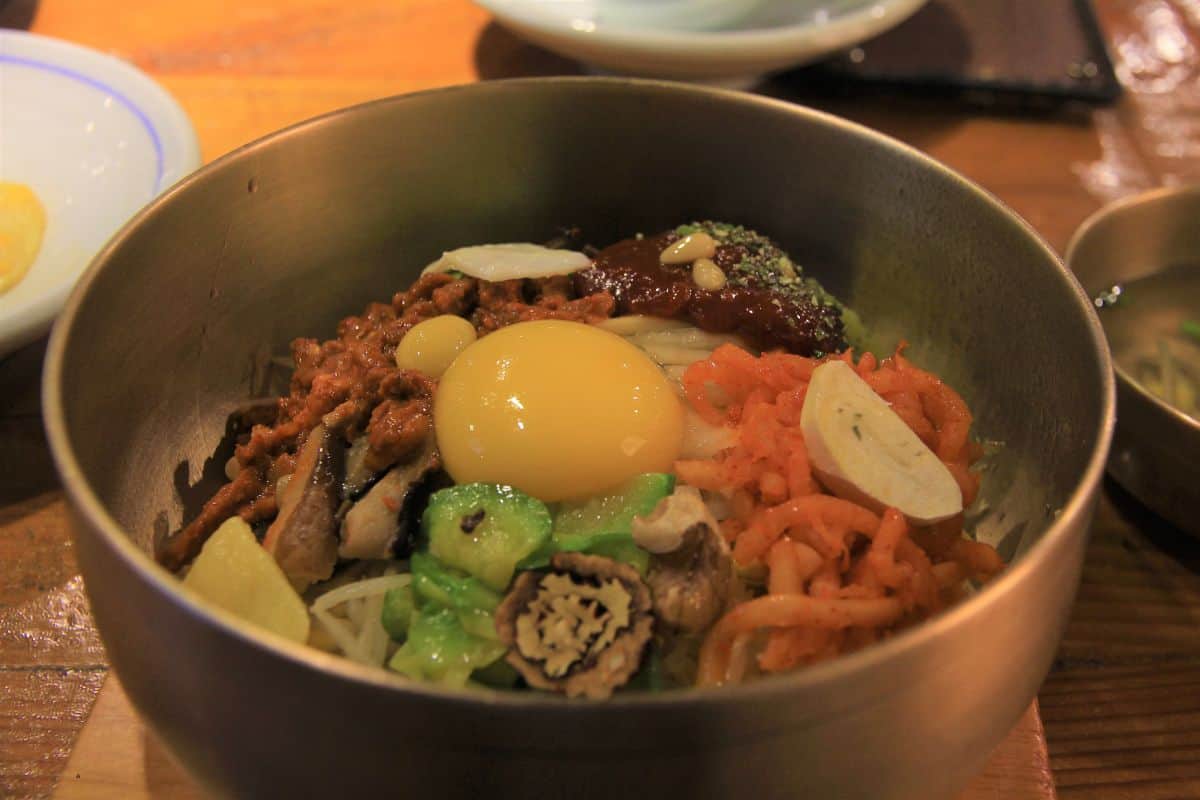
Where To Stay In Jeonju
One of the main reasons people choose to visit Jeonju over any other destination in Korea is for the hanoks (traditional Korean houses). All of them are now also equipped with ondol , the typical Korean floor heating system, making them quite comfortable even on the coldest of nights.
So most visitors do opt to spend the night in one of these beautiful guesthouses, most all of which are clustered in the famous Jeonju Hanok Village (in the southeastern part of the city).
But I'm not a huge fan of sleeping on thin blankets on a hard wooden floor, despite having done it a few dozen times. So here I've recommended just one hanok -style guesthouse, the two other being more western-style accommodations.
Budget: 24Guesthouse Jeonju
24 is a popular guesthouse chain, and I've stayed in several of their locations throughout Korea. They offer affordable double rooms with en-suite bathrooms, as well as 3- to 4-person hostel-style rooms for some of the cheapest prices around. A simple coffee & breakfast is included.
The guesthouse is a few blocks north of the Hanok Village, allowing you to be near but not right inside all of the action. At just $14USD a night per dorm bed, it's hard to beat the price if you're visiting Jeonju on a budget.
Hanok: Bu Kyung Dang Guesthouse
This is one of the most beautiful and most-loved hanoks in the whole village; no exaggeration. The entirety of the property consists of just 8 rooms, surrounded by greenery, which is found in full bloom if you visit in the spring.
On the outside is the traditional slatted doors with a paljak roof and paper lanterns around the perimeter. But heading inside you'll find a beautifully refurbished stone-tiled bathroom and wide open rooms. Grab a blanket from the stack and settle in for the night. Rooms start at just $32USD per night.
Mid-Range: N Bridge Hotel
Non- hanok accommodation in Jeonju is incredibly hard to come by; most people want to stay the night in the famous Hanok Village, and seem to have no problem sleeping on the floor. But for my fellow non-floor sleepers— at least those not on a budget— I'd recommend N Bridge.
It's got big fluffy beds, 24-hour service, and a fridge in every room. Unlike most of the hanok options, it also has multiple floors and a marble bathroom in every suite. Just be sure you don't book their futon room unless you actually do want to sleep on the floor, Korean-style. Double rooms start at $74USD.
Click here to check out prices for other hotels in Jeonju
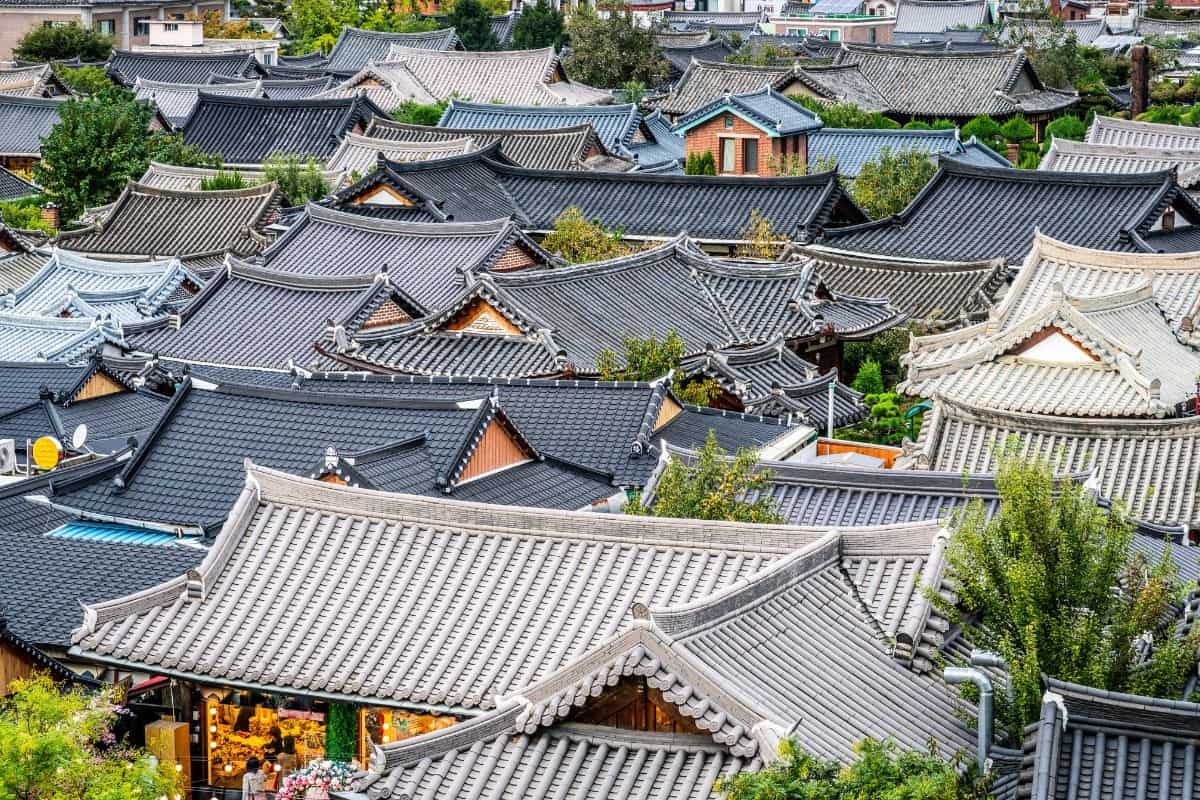
🧳 Budget For A Trip To South Korea
Of all the countries in East Asia, I'd argue that South Korea has become the most affordable to visit. There are many extremes to be found in the ROK (Republic Of Korea), a fact which extends to my daily life here over the last few years.
Visitors could stay in super cheap dorm beds booked way in advance for about ₩12000 ($10USD) a night, eat street food for another $10USD a day, and otherwise spend money only on transportation. I wouldn't recommend it, but it's doable.
On the other hand, Seoul is a massive city with plenty of hotels always ready to take your money. $500USD a night hotel rooms aren't the norm, but they're there. The key is to find a balance, and if you're looking to travel Korea on a budget, then make a list of priorities.
Do you most want a nice place to sleep? Fancy meals? Involved day trips? Budget travel in Korea is 100% possible, but it takes planning. So here's a rundown of the costs of traveling in Korea.
Note that this South Korea travel guide covers such a wide range of days that the budget below is a snapshot of how much you could spend in one day. My dad would call them "guesstimates." It also covers the cost of basic activities which most everyone would do. Remember to multiply this Korea travel budget by the number of days you'll be visiting us for!
ESTIMATED COSTS:
- Visa Fee : ₩30000 (to check if you need a visa, click here )
- Day Tours : ₩70000 (some day tours cost more, but these kids of trips include visiting the DMZ , Nami Island, and Jeju tours)
- * Each Trip To A New City : ~₩30000 (one way; this is an average)
- * Round Trip Airfare to Jeju : ₩80000 (if booked well in advance)
Decent Guesthouse : ₩25000
Meals & Snacks : ₩20000
Attractions & Activities : ₩10000
Transportation : ₩5000 (4 trips on the subway or bus)
Souvenirs & Cafes : ₩5000 (coffee or tea)
Average Cost Per Day : ₩ 65000
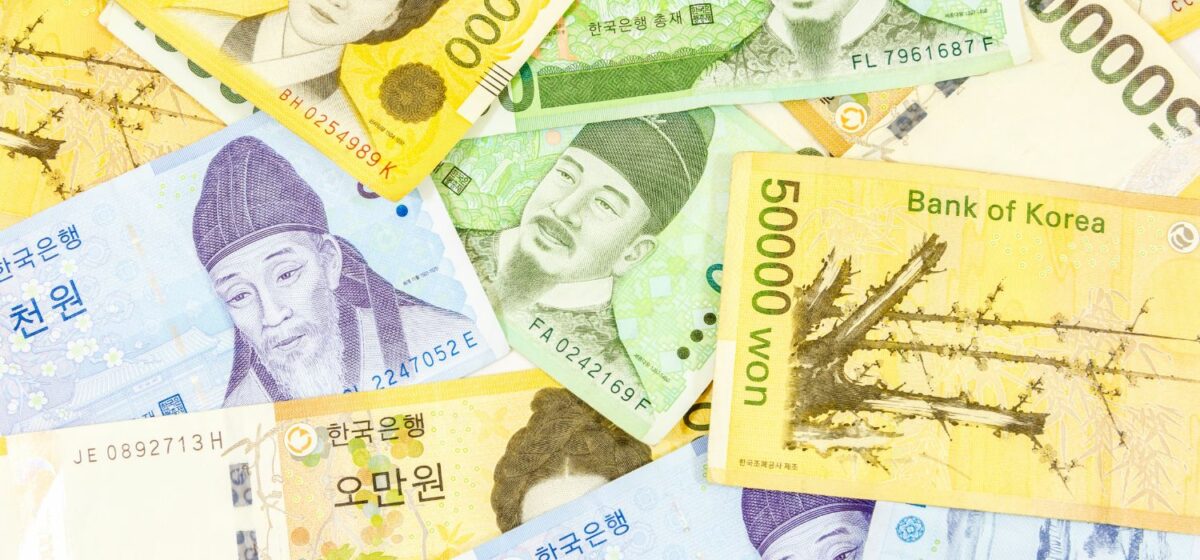
🚈 South Korea Travel Tips
- Metros aren't very accessible but the buses and taxis are. So if you're in a hurry or disabled, then you should take a taxi. They're very cheap and fast, though during rush hour they'll take as long as the metro. Most shops are clustered right around metro stations anyway, so even if your driver doesn't speak much English you can tell them the name of the metro station closest to where you're going.
- Korean winters are not for the faint of heart . My friends from Vietnam visited me last winter and spent their first day alone— they were shivering for hours after we came inside. Even my sister was not very happy with all the snow over New Year's when she visited a few years ago. It can get brutal, thanks to winds coming down from Siberia.
- Also not for the faint of heart, entitled old people . They will push you, publicly and without shame if they think you're in their way. I understand that they act this way because they don't think young people respect their elders like they should, and they don't, in my opinion. But no matter how you think, it is something to be aware of.
- Korea is basically a cashless society , except for in the markets. This means that you can use your credit card most everywhere, but international cards aren't always accepted, so still keep some cash on hand.
- Along similar lines, in Korea you should expect late nights and late mornings . Cafes, restaurants, and shops are open very late, usually between 10pm and midnight, but rarely open before 11am. If you want morning coffee if Korea you'll have to either be at the airport or grab canned coffee from a convenience store.

- Even though it's a more developed country, Korea has their share of travel scams. One of the most common is the fortune teller scam , in which a woman stops you on the street and offers to take you to have traditional experiences, only to scam you out of money. Either way, if someone stops you on the street, 95% of the time they want your money or to convert you. NYC rules apply.
- Pollution is horrible. Sometimes the skies aren't as bad, but spring 2018 and winter 2019 were particularly harsh, with many days seeing pollution levels as high in Seoul as in Beijing, China. Bring a mask, or buy one, especially if spending 2 weeks in South Korea, or longer.
- Naver Maps will tell you which door of the subway you should go to for the faster arrival at your next destination.
- If you're a bigger person , look for handicap-accessible or family bathrooms, as Korean public bathroom stalls are made for small people, especially the women's bathrooms.
- Look up . If you're looking for an office or guesthouse or restaurant, and you'd swear you're at the right address, just look up. It's probably just on a much higher floor, like the 11th or 32nd.
- However, when you do look up, don't make eye contact unless you want to start a conversation or get stared at as you walk away (though that might happen anyway, in the countryside).
- Hospitals are for everything , even if you're a visitor taking various South Korea tours and end up with a cold. The hospital is like the doctor's office, and in small towns like mine, they're open 9 to 5 like everything else.
- Always count to 5 before crossing the street , because without fail, at least once a week I watch someone go after the light turns red, be it a car or a motorbike. Better safe than sorry.
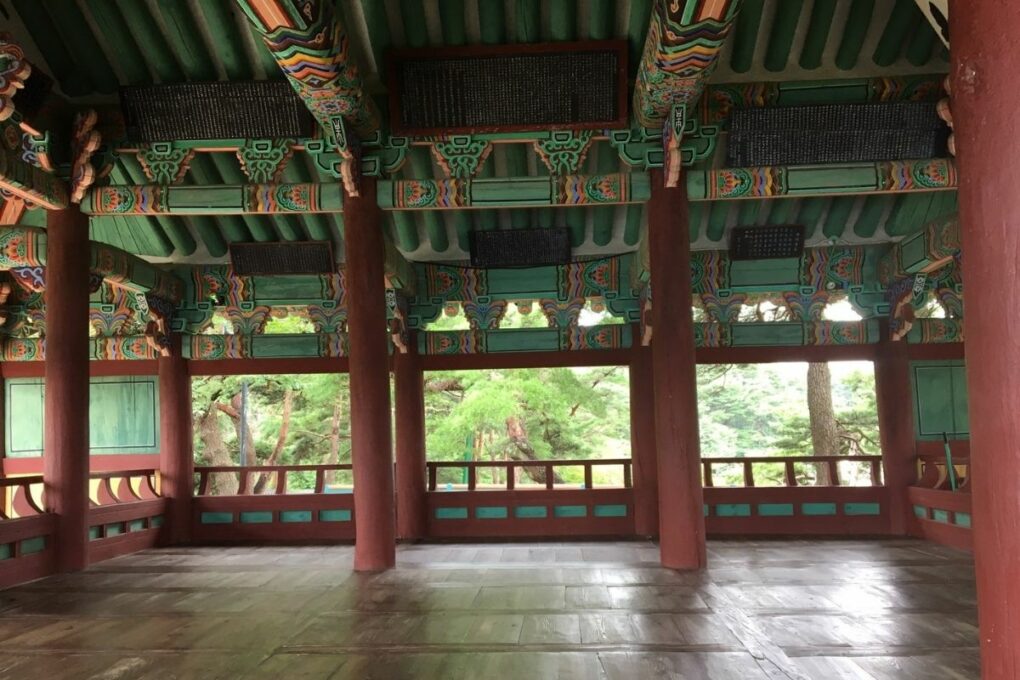
☺️ Basic Phrases For Your Trip to Korea
Hello // An-nyeong-ha-se-yo . (안녕하세요.)
Thank you // Gam-saahm-ni-da . (감사합니다.)
How much is it? // Eegaw eol-ma-yeh-yo? (이거 얼마예요?)
Do you speak English? // Yeong-aw jal-hae-yo? (영어 잘해요?)
I don’t speak any Korean. // Han-guk-aw jal-moat-hae-yo. (한국어 잘못해요.)
One of these, please. // Ee-gaw ha-na ju-say-yo. (이거 하나 주세요.)
It’s to-go/takeout. // Po-jahng ee-eh-yo or Tae-ee-kow-shi-yay-oh. (포장 이예요.)
Lesson complete! Now let’s get packing.
More All Things South Korea

Sharing is caring!
Reader Interactions
Cherene Saradar says
June 02, 2019 at 3:58 am
Such a fabulous thorough post. Will definitely use it when I finally visit South Korea someday!
June 02, 2019 at 11:52 am
Thank you so much, Cherene! I hope you're able to visit sooner rather than later. ?
June 03, 2019 at 2:59 am
I’ve been postponing Korea because I think it deserves time. These two weeks sound fantastic! I saved your post for future references. Thanks for all the great details! ❤️
June 03, 2019 at 8:19 am
Agreed! Korea deserves some time and a return trip or two. I hope you can make it sooner rather than later. 🙂
Amanda C Bowers says
June 04, 2019 at 8:02 am
Beautiful photography and helpful advice.
June 04, 2019 at 10:02 am
Thanks, Amanda! Hope it helped you plan your visit.
June 11, 2019 at 12:14 am
South Korea is such an amazing travel destination for me. I have been there for a couple of time.
I loved your honest and resourceful travel guide, photos are mind-blowing.
June 11, 2019 at 10:53 am
Thanks, Sarah! It's been a few years in the making, so it was more a question of which photos to use & which destinations to choose. Hope you can make it to a variety of destinations on your next visit!
July 10, 2019 at 1:41 am
Hi Max, some great suggestions on Korea. A lot of good information. I would suggest spending a lot of time in Busan as it has a lot to offer. Thanks again for sharing your post.
July 10, 2019 at 9:26 am
I've been to Busan several times, and it's yet to offer me much more than a weekend of activities beyond what I could get in Seoul. I'm sure living there is a very different experience, but for visitors I'm sticking to my guns on 2 or 3 days!
jagjit singh says
July 19, 2019 at 8:24 pm
I heard a lot about south Korea tourism so me and my friends are planning our trip to South Korea for next month but as me and my friends have nothing knowledge about SK so we are a bit worried about our trip but after reading this blog I know to do their what things to keep in mind for traveling safe thanks!
July 19, 2019 at 9:40 pm
I'm so glad you're planning a visit! Be sure to bring lots of light clothes and rain jacket, as Korea is very hot this time of year!
December 08, 2019 at 3:12 pm
Its great to learn about interesting itinerary... Yhanks
December 08, 2019 at 9:45 pm
You're very welcome, Neha! 🙂
Christine says
January 10, 2020 at 5:33 am
My family and I are coming to South Korea at the end of May for 2 weeks. Do you have any advice for travelling with 3 teenagers?
January 11, 2020 at 4:34 pm
Hi, Christine. That's a lovely time to visit weather-wise, and a great amount of time to spend. I'm not sure what your teens are into, but they may enjoy doing some of the more cheesy and kitschy things in Korea, like visiting the Toilet Museum in Suwon, and seeing Cookin' With Nanta in Seoul. A road trip around Yeosu could also be fun, as it's packed with lots of natural attractions very close together. I remember not wanting to help my parents plan anything as a teen, but maybe show them some lists of interesting things to do around Korea, as ask them each to pick 3-5 things? I have such a list that I compiled over three years of traveling across the country: https://damecacao.com/expat-south-korea-bucket-list-adventures/
Each description is short, so they can glance over it really quickly and give you an idea of what they're interested in! I hope that helps, and I hope you all have a wonderful trip in Korea!
Lauren says
March 16, 2020 at 8:21 pm
Hi! My boyfriend and I are going to South Korea in the beginning of September for two weeks, so your itinerary is perfect for us! But do you have any tips for eating in South Korea as a vegetarian? I do not eat meat, fish or seafood, so I'm a bit worried about the possibilities there.
Thank you so much!
March 20, 2020 at 9:24 am
Hey, Lauren! I hope you're still able to go on your trip, come September. Korea's been doing very well at keeping coronavirus at bay. There are a fair number of vegetarian restaurants in Korea, in particular around Seoul, but I recommend you look up some food guides to vegetarian Korean dishes, keep some cards noting how to tell restaurants you're vegetarian, and take note of some particular restaurant options in bigger cities. Off the top of my head, only bibimbap without the beef is purely vegetarian; most main dishes also use some kimchi (made with tiny shrimp) in the sauce or pork bones in the broth. :/
January 12, 2021 at 9:20 am
Max, with your language lesson I am ready!
January 13, 2021 at 6:39 am
That's great, Lucy! I hope we'll all have the chance to visit again soon. 😀
Sanori says
January 29, 2021 at 12:54 am
Thank you firstly because the article is really helpful. I am planning to visit in December to see the snow. It would be great if you can help me plan. I will be about 14 day tour?
January 29, 2021 at 11:27 am
Perfect! That's exactly what this is. Good luck with the planning & enjoy your trip! ^^
Brian Fernandez says
May 22, 2021 at 9:01 pm
I have postponed my trip to S Korea in April for the second year now but it's definitely on the cards for 2022. I have read most of the write up and it's thorough ,interesting and given me through to want it even more. Now thinking about going there for a little longer than originally planned. Thank you.
May 23, 2021 at 9:13 am
You're very welcome, Brian! It's frustrating to have to keep postponing your trip, but I'm glad you'll finally be going. April is a good time to be there, and generally not too cold (but it can get chilly at night). I'm glad you'll get to spend so much time there-- a bit more could always be put to good use!
Raymond says
March 27, 2023 at 2:19 am
Useful tips, thank you.
March 27, 2023 at 10:33 am
You're very welcome, Raymond!
Su Ling says
April 16, 2023 at 6:14 am
Hi Max, I am planning a trip to Korea in 30 Sept to 10 Oct, tentively as below: 30/9-2/10-Seoul 2/10-4/10-Gyeongu 4-7-Busan 7-8-Boseng green tea plantation 8-9- Sucheon 9-10-Jeonju 10-Back to Seoul and departure in night
Do you think above days allocation in each city, are appropirate to see the main sights in each city without feeling too rush? which is why I allocate 2 nights in Gyeongu and 2 nights in Sucheon. 3 days in busan and 2 and a half days in Seoul (include last day in seoul).
Secondly, is it ok to see Boseong Green Tea planation first and spend a day there, and next day go back to Sucheon and spend a night in Sucheon? Or the other way round?
April 16, 2023 at 10:29 am
Hi, Su! You'll be doing a lot of running around and hauling luggage, so I'd pack light and wear your good walking shoes, but I'd also probably switch and go to Suncheon first, yes, as Boseong will be a slightly longer trip to arrive there from Busan, and it's relatively easy to get to Jeonju by bus from either city/area.
July 22, 2023 at 6:13 am
@Max, thanks Max
Claudia says
May 02, 2023 at 7:31 am
Hi Max! First of all, thank you for your amazing collection of information. I'm currently trying to make up my mind in terms of how I should plan my South Korea trip. Maybe you can help me out a bit: I'm thinking of either going end of this Month so around 23rd of May or wait and flight there during September. What would you suggest? Are there any advantages/disadvantages ?
And the next question is whether I should do 3 weeks in South Korea or 2 weeks and ad 1 week in Tokyo to that.
It's so hard for me to decide ...
Thanks a lot in advance!!
May 02, 2023 at 10:32 am
Hi, Claudia! It's a long trip, so I can understand the trepidation. As for timing, end of May can get quite warm, but September will be HOT. Kids will be in school both times of year, though particularly in early September there is kind of a lot of movement-- new students coming in, new English teachers, certainly tourists. I think you could have a good time no matter what, but I'd generally opt for May because I think it's also the most beautiful time to be on Jeju Island and see all of the blossoms and herbs around the country.
As for a week in Tokyo/Japan, it's a farther trip than you may expect (3 hour flight from Seoul, plus to/from both airports) and will definitely be a hit to your budget. But it will be different foods and a different array of activity options and a somewhat different vibe. While I think you could easily spend a month in Korea and be nowhere near done, it depends on how much you want to see Japan + how willing you are to spend the extra time & money for the experiences you could have in Japan vs. Korea.
Personally, I've been to Japan 4 times (each a different region) and it's cool, but I'll always enjoy going back to Korea more, and I don't believe it's just because I lived there (though that certainly plays a role!).
May 02, 2023 at 11:04 am
@Max, Thanks so much! Going to Japan/Tokyo would basically just be some sort of "teaser" for me as I've always planed to spend at least 2 month there at once. So it was me thinking "okay, if I'm already over there, might as well get a first taste" - that sort of thing 😛 (I'm travelling from Austria). I'm travelling alone, so all responsiblity of making the final decision lies with me unfortunately.
What extra places would you recommend for a 3 weeks trip? Would you add something or just extend the 2 weeks itinerary a bit?
And quick side question regarding Jeju: How much in advance did you go to the airports for the flights? Is it like any other flight (2h)?
Thanks a ton!
May 02, 2023 at 1:41 pm
Ahhh gotcha. Well that's definitely a different scenario. If I were deciding between the two, I would indeed spend the other week in Japan, and try to get a sense of which I like better. If I were spending 3 weeks in Korea, I'd extend the amount of time I spend in each place depending on which one appeals to me the most. Oh, and for Jeju 1.5-2 hours to even as little as an hour for the flights from Gimpo, but I generally err on the side of caution. Enjoy your trip, Claudia!!
June 13, 2023 at 11:05 pm
What a great post! Thanks for sharing. We are planning to come from June 29th to 9th July. What do you think about the weather? Can we come now or delay due to rain and heat? Also, in Seoul what is a good location for a family stay - Four Seasons and something in Gangham?
June 14, 2023 at 12:40 am
My pleasure, VK! And since it's monsoon season, it's honestly pretty unpredictable as to which days might be nice, but with such a long stretch of time, you're bound to get some good weather days and maybe a bit of rain. I have a post covering 100+ things to do in Seoul , so I recommend looking through that and over the map on the bottom to note some things that look interesting & rain-proof, as well as some options for stuff close to where you choose to stay.
Speaking of, the Four Seasons is lovely, but I was also incredible impressed with VOCO Hotel in Gangnam . It's an affordable IHG property a block or two from the metro, and I felt like royalty for much cheaper than the Four Seasons (like 1/3 of the price)! But it's always worth comparing the two side-by-side, as the Four Seasons would offer slightly different amenities and is in an arguably more central tourist location. Either way, summertime will be warm in Seoul, but everythng is open and tends to have longer hours due to the increase in domestic tourism.
Enjoy your trip!
June 14, 2023 at 8:34 am
@Max, Thank you so much for your kind response and the details provided. I am planning to do 4 nights in Seoul, 2 nights in Busan, and 4 nights in Jeju. Is that plan correct? Given a choice you would me to skip summer and rain and come later or it is still okay to come from 27th June - 7th July? As we don't to come and spoil the trip - I hope you understand :).
The Hotel option you gave is great. I will definitely have a look. Is it better to stay in Gangnam or the area where the Four Seasons are? I know I am asking too much but if you have any recommendations for Busan and Jeju as well - would love to take your feedback.
Thanks so much again.
Regards, VK
June 14, 2023 at 5:24 pm
That's how I'd plan it out! And honestly, you can't predict the weather well enough to say whether it will rain half the days or just one or none. It can be rainy from June to September, and it gets quite cold after that, so sometimes you just have to roll the dice. If given the option, summer would be my pick over winter, but even if I knew the other times you'd be able to go, we'd still be in the same predicament about not being able to know for sure how the weather will be.
If the price difference doesn't matter as much, the Four Seasons would be my pick for a first-time visit, because it's truly in the middle of the touristy area with a large chunk of the museums, hanok (traditional) houses, souvenir shopping, royal palaces, and a ton of restaurants with great Korean food and mostly translated menus. Voco (and Gangnam as a whole) is about a half hour metro ride from that area, and while it's great for fancy shopping, visiting Lotte Tower, and some fabulous meals (if you eat beef then definitely try hanu , or Korean domestic beef, while you're there), it has a few tourist-friendly museums and not so much else. But what you save in staying there would more than pay for taxis all throughout the city! So each has their pros, and you should pick the one that's right for your preferences.
As for the other two, I spent many hours compiling accommodation guides for both Busan and Jeju Island , and you can read about the various neighborhoods/parts of the island in each, and make the best pick for each based on what you plan to do there. Again, since I'm not sure what attractions you're most interested in, I do think it would make more sense for you to look through those for the best picks for you personally, rather than booking only based on my recommendation. And if you do still have more questions after reading through those two posts, just leave another comment and I'd be happy to answer them there.
I never mind answering questions, as frustratingly few bloggers seem to still do so. But if you've found any of the info helpful, I always appreciate it if you book through my affiliate links. I specifically work with Agoda for hotels because I've always found that they have the best prices on accommodation throughout Asia, and always throughout Korea. But if you don't, no big deal; just wanted to mention it as a free way to say 'thanks'! 🙂
June 14, 2023 at 10:02 pm
@Max, Thank you so much for your kind help and answering questions. This really helps a lot. I will definitely use the affiliate links:)
Susan Hughes says
February 25, 2024 at 11:01 am
My husband, oldest daughter, possibly a friend of hers and I will be in South Korea, leaving DFW the 9th (not getting there till the 10th at 3:15)-and returning the 20th at 5:25. Trying to come up with a tentative itinerary so we can experience the most of our time there. Seoul, Busan and Jeju Island are my top places to visit. I’m a Korean adoptee and would like to visit an orphanage. If you have information about Holt orphanage that would be wonderful. I was adopted in 1973 which the orphanage was called Livingstone but changed to Holt. Trying to determine if we should stay around Seoul when we get there or when a few days before we head back home. I’m realizing I should have booked 2 weeks which a friend who is living there for a year suggested but i compromised with 10 days. Would love to hear what advice you have to give. I’m just starting to do research so any info other than what you have said in your post would be much appreciated. Wish you were there when we are to be our travel guide😂Looking forward to hearing back from you!
February 28, 2024 at 1:14 am
Hi, Susan! That sounds like a wonderful experience you have planned. I'm sorry I don't know anything about Holt, but I also did my best to include every little detail about visiting in this post - it's over ten thousand words! However, when planning timing, I'd say to know your limits. If you're flying direct from Dallas and know you'd be up for another short domestic flight that would get you to Jeju by 7pm or 8pm, then I'd say to go directly to Jeju, because getting into Seoul formt he airport in Incheon take about 2 hours. It's a trek, and your time is better spent getting your sea legs, so to speak. From a few days in Jeju first, I'd fly from Jeju to Busan, then take the train from Busan to Seoul and leave form there. Lots of options depending on your particular interests!
Jochen says
August 04, 2023 at 5:48 am
Hi, we are going to prepare a tour with golfers to Korea and beside of golf your information are very helpful. Do you live in Korea and work as DMC?
August 04, 2023 at 1:36 pm
That sounds like a very fun tour indeed, but unfortunately I don't like in Korea anymore, nor have I ever worked as a DMC. But good luck with your search, and enjoy your trip!
August 07, 2023 at 6:14 am
Thanks for your great posts! I used this one (and a few others including the Seoul and Jeju one) to help me when I went to South Korea for two weeks. I read a few blogs on the internet, but your style and interests most closely matched me. Hope you are doing well one your new adventures 🙂
August 10, 2023 at 9:26 am
Thank you for the kind words, Kim! I'm glad you've found it all helpful. 😀
August 18, 2023 at 4:02 am
Thank you for your post. I wonder how to use 'Kakao talk' app during travel in Korea. Is there any way to use it?
August 20, 2023 at 5:55 pm
My pleasure, Kim! You can download Kakao Talk before your trip, but since it's connected to your phone number, if you need to get a local sim card in Korea, you'll just need to make a temporary new account for use in Korea. So unless you'll use your phone's regular sim card while in Korea, I recommend waiting until you're IN Korea to make your account for use during travel in Korea. Then you can use it to communicate with taxi drivers, food delivery, Air BnB hosts, local friends, etc.
Happy Travelers says
January 13, 2024 at 4:42 pm
Thanks for creating a 14 day with Jeonju! We will be in Korea feb 7-21 and obviously plan on seoul, busan, and jeju. We really wanted to hit Jeonju but was reading about doing a drive from seoul east and then south to hit Chuncheon, Sokcho, Gangneung, Samcheok, Andong, Gyeongju, Seokguram and skipping Jeonju.
I was wondering since we will be there in the Winter, which would you recommend the Jeonju plan or the east plan?
January 14, 2024 at 2:46 pm
Thank you for the kind words! At that time of year, you'd be better off giving Jeonju a visit since the warm weather that would make the east coast drive so pleasant & beautiful would be nonexistent right then. You'll also be overlapping with Seollal, or the Lunar New Year (weekend of Feb 10), with those dates, so renting a car may be a bit harder and traffic will be CRAZY heading out of the city all weekend (everyone is taking their fmailies back to the countryside to see parents/extended family). However it will be just one weekend out of two, so I recommend you just plan around that, and definitely give Jeonju a few days!
April 30, 2024 at 10:27 pm
Hi ! Thank you for this great blog post. Very instructive ! A friend and I are planning to visit South Korea in 12/13 days (not sure yet) in the beginning of November, starting in Seoul and ending in Busan (taking the ferry to Japan after). We would love to go to Jeju as well, which we will try to plan right after Seoul. Given the round trip tickets to Jeju Island are much cheaper than a multi-destination (we are mid-budget travellers), we were thinking of staying 5 days in Seoul, and then a round trip to Jeju Island in two days. But after this, we're a bit lost. We read online that spending a day and a night in Gyeongju is quite nice, as well as exploring Jirisan national park (we love nature and hiking). But, reading your blog, it seems that other destinations such as Jeonju are equally as great. What would you recommend for the second part (6 days) of our trip in November ? Thanks for your help ! Axel
May 08, 2024 at 1:54 pm
Hi, Axel! It totally depends on what you most like to do - at the beginning of November it's pretty chilly, so while hiking would be beautiful, it may be a bit tougher on the body. You're probably also best-off staying in one place for those last 6 days, or maaaaybe 2 places, doing day trips to the destinations you're interested in nearby. With 6 full days before you take the ferry to Japan, if you don't mind moving places a lot you could base yourself in Gwangju (the largest city in the southwest of the country) for 3-4 days, taking buses to do day trips to other areas in the region (Suncheon, Jeonju, Jirisan, etc.), and even fly directly there from Jeju (which I'd actually recommend at least 3 days to explore!). Then you could spend 2-3 days in Busan at the end before your ferry. That would be my inclination, but it totally depends on your interests, as every city has a distinct vibe.
Sorry for the late reply - I just returned from my honeymoon! 🙂
June 27, 2024 at 4:21 am
Hello max! Loving your blog post and very useful information I will be visiting Korea this coming Nov for 10 days My current plan would be seoul + Gangneumg/skocho. Trying to put in daegu into my itinerary but seems a bit far off and required traveling
Appreciate if you can share any ideas please . Many thanks in advance
June 28, 2024 at 2:22 pm
Thnaks, Jay! That might be a pretty chilly time for visiitng those beach towns, but I will say, you'd definitely have the coast to yourself!
As for Daegu, it would honestly be out of the way, but you may be able to take a bus from Gangneung or Sokcho directly to Daegu since they're all relatively large city centers, but there may only be 2 or 3 per week at that time of year. If you're flexible as to whether you'd be heading to Daegu from either Sokcho or from Gangneung, it may be mor elike 5 times a week, which could make it more doable. Heading back to Seoul or even directly to Incheon Airport from Daegu would be quite easy, with several buses each day. I'd check out the bus schedules using Naver Maps to get a sense of how often the buses run between Gangneung/Sokcho and Daegu.
Leave a Reply Cancel reply
Your email address will not be published. Required fields are marked *
SEOUL - north | SEOUL - south
Day Trips from Seoul | Busan | Best Collections
🍁 Festivals ( Seoul • Busan )
5-9 Days Trip Itinerary for First Timers to Seoul, Korea
KoreaToDo has put together a step-to-step detailed trip itinerary for first timers (or any busy travellers with little time for planning) to Seoul , Korea .
It offers ONE central page of information for all your key travel needs to Seoul . They include, where to stay , important mobile apps to use, how to get from Incheon International Airport to your hotel in Myeongdong (the most popular and central place to stay in Seoul ), day-by-day itinerary with detailed transport/walking guides on getting from one attraction to another, recommended tours, shops and restaurants .
The itinerary covers 8 out of 9 Korea's Top 100 Must-Visit Places in Korea (2023-2024) in Seoul (e.g. N Seoul Tower , Gyeongbokgung Palace , Hongdae ), as released by Korean Tourism Organization . It also covers previous attraction winners like Myeongdong .
Itinerary Highlights

🎖 Present/Past Top 100 Must-Visit Destinations in Korea
Before Departure
1. Recommended Activities, Tours & Tickets to pre-purchase before trip (optional)

N Seoul Tower Observatory Ticket
enjoy breathtaking views

4G SIM Card (KR Airport Pick Up) - KT OLLEH (Unlimited data, 3/5/10/20/30 days)
data, calls & texts/24 hrs pick up
![korea trip planner [Incheon Airport] Airport Limousine Bus Ticket (One-way/Round-trip)](https://static.wixstatic.com/media/0505b9_d7d6bd3873ae4f79b6ee1dd30bdef6fc~mv2.jpg/v1/fill/w_217,h_173,al_c,q_80,usm_0.66_1.00_0.01,enc_auto/N%20Seoul%20Tower%20-%20Small%204%20-%20bright.jpg)
[Incheon Airport] Airport Limousine Bus Ticket (One-way/Round-trip)
Myeongdong, Dongdaemun, etc

Namsan Cable Car Round Trip Ticket (weekdays only & min. 2 pax)
beautiful scenery of Seoul

4G Pocket WiFi (KR Airport Pick Up) - SK TELECOM (Unlimited Data)
max 3 devices / 24 hrs pick up

eSIM South Korea with high-speed & stable Internet connection (Data only)
per day data/total data option

4G SIM Card (KR Airport Pick Up) - SK TELECOM (Unlimited, 3/5/10/20/30D)

4G Pocket WiFi (KR Airport Pick Up) - KT OLLEH (Unlimited Data)

Unlimited 4G Data eSIMs - SK TELECOM (3/5/10/20/30 days, calls & texts options)
QR via email. local nbr option.
2. Recommended Hotel Location: anywhere near Myeongdong Station , preferably on the same side of the road as ' Nine Tree Hotel Myeongdong ' (i.e. 2 mins walk to airport limousine bus drop off/pick up bus stop , near exit 8 of Myeongdong Station )

★★★ | 8.5 Review Rating

★★★★ | 8.8 Review Rating

★★★★ | 8.6 Review Rating

★★★ | 8.4 Review Rating

★★★ | 8.8 Review Rating

★★★★ | 8.7 Review Rating
3. Download Mobile Apps
a) Korea Subway Info App - Metroid HD (/ KakaoMap/Naver Map )
b) Location/Walking Direction Map - KakaoMap or Naver Map
more travel tips ....
Day 1: Arrived Seoul / Check in / Namsan Seoul Tower / Myeongdong
At Incheon Airport - Arrival Hall (public area after collecting luggage)
Pick up pre-purchased WIFI Router & SIM Card at Incheon Airport (where applicable).
Recommend to purchase T-money Card at any convenience store at the arrival hall of Terminal 1 (T1) or Terminal 2 (T2). Card deposit is ₩4,000. Suggest to top up at least ₩20,000 to ₩30,000 as the airport limousine fare is ₩17,000.
( Th e card ca n be used on airport limousine bus to city, bus, taxi, subway and convenience stores. Top up at any downtown convenience stores or subway stations. More details ... )
💡If you can't get the card at the convenience store, you can walk a bit further to the subway station to purchase the card. Alternatively, you can get it at most convenience stores when you arrived in Myeongdong. Different stores carry different designs and you can pick your favourite too !

Take Airport Limousine Bus from Incheon Airport (T1/T2) to City (i.e. Myeongdong Station Bus Stop )
Bus #: 6015
Interval: 2-6 departures per hour
Duration: 80 mins
Fare: ₩17,000 (discount may apply when used with T-money Card)
No reservation required. Just join the queue and it is free seating on board.

Departing from T1 to Myeongdong Station :
First bus 05:40 | Last Bus 23:00
Walk outside of arrival hall (1F) at Gate 5, look for Bus #6015 to Myeongdong at bus platform 5B.

Departing from T2 to Myeongdong Station :
First bus 05:20 | Last Bus 22:40
Go to Basement 1 for platform No. 28
Tab the T-money Card on boarding.
alternatively, bus ticket can be purchased at counters/machines (recommended) outside arrival hall (T1, 1F), bus waiting area (T2, B1) or by cash to driver.

Refer to Incheon International Airport official website on the latest bus schedule and updates.
Alternative ways to get to Myeongdong from Incheon International Airport :
a) book your Private Airport Transfer by Car OR
b) take the non-stop AREX Airport Railroad express train from Incheon International Airport direct to Seoul Station (Terminal 1: 43 mins / Terminal 2: 51 mins, ₩11,000) and transfer to subway for Myeongdong Station (line 4, 3 mins, 2 stops, ₩1,400). Luggage carrying up/down the stairs might be required. There are taxi stands outside Seoul Station too.
Check into accommodation booked after alighting from Airport Limousine Bus at Myeongdong Station Bus Stop.

N Seoul Tower 남산서울타워

👉 How to get to N Seoul Tower
From N Seoul Tower, take the Shuttle Bus No. 01B to the last stop (i.e. Namsan Yejang Bus Transfer Parking Lot). 13 mins bus ride. From there, walk towards Myeongdong Station , 4 mins.
💡Myeongdong's main shopping area is right at Myeongdong Station's exit 5-8.

Food & Drinks

Street Food

Day 2: Seoul Plaza / Cheonggyecheon Stream / Gwanghwamun Square / Gyeongbokgung Palace / Tosokchon Samgyetang / Bukchon Hanok Village / Insadong
Depart 9:00 or earlier [ in time for the 10:00 changing of guard ceremony at palace]
Using KakaoMap or Naver Map , take an easy leisure walk from your accommodation to Seoul Plaza (15 mins) , located right next to City Hall Station (line 1, exit 5) and facing The Plaza Seoul (hotel). The very popular Lotte Department Store (main branch) and the established Lotte Hotel Seoul that every taxi drivers know even in English are located nearby too.
Seoul Plaza 서울광장

Walk along the straight road, Sejong-daero at the side of Seoul Plaza (passing by City Hall Station , line 1, exit 4/5) towards Gyeongbokgung Palace (20 mins) , bypassing Cheonggyecheon Stream and Gwanghwamun Square along the way . This is a nice, spacious and modern area in Seoul .

Cheonggyecheon Stream 청계천

Gwanghwamun Square 광화문광장

Gyeongbokgung Palace 경복궁
To arrive before 10:00 for the Changing of the Royal Guard Ceremony (20 mins) , followed by the optional Free English Guided Tour at 11:00 (1-1.5 hrs) . No reservation required.
The next Changing of the Royal Guard Ceremony is at 14:00.
For those who wish 'conserve' energy, you can take a taxi direct from Myeongdong to Gyeongbokgung Palace (20 mins, ₩7,200) or subway to Gyeongbokgung Station with 1 transfer (15 mins, ₩1,400). Use subway mobile app Metroid HD or KakaoMetro for the lines and transfer station.

Hanbok Experience (Hanboknam Gyeongbokgung Store)
incl. basic hairstyling & inner skirt

Hanbok Rental (& Photoshoot) Experience by Hanbok That Day
3 mins walk fr. Gyeongbokgung
Walk from Gyeongbokgung Palace to the popular Tosokchon Samgyetang (Ginseng Chicken Soup) Restaurant. 10 mins .
Tosokchon Samgyetang (Ginseng Chicken Soup) 토속촌 삼계탕 @Seochon Village

Seochon (Sejong) Village 서촌마을

Walk back to Gyeongbokgung Station (line 3).
Take the subway from Gyeongbokgung Station to the next stop, Anguk Station (line 3, exit 2). Walk to Bukchon Hanok Village ( 10 mins) .
Bukchon Hanok Village 북촌한옥마을

Walk from Bukchon Hanok Village back towards Anguk Station to Insadong . 3 mins walk from exit 6.
Insadong 인사동

Dinner at one of the quaint restaurants at Insadong .
After dinner, walk back to Anguk Station (line 3). Take the subway back to Myeongdong Station (line 4, 1 line transfer, 10 mins).
Alternatively, at any point along Insadong , you can take a taxi back to Myeongdong (11 mins, ₩5 ,600).
Day 3: Day Trip from Seoul
1. Recommended Day Tours from Seoul

DMZ 3rd Invasion Tunnel & Korea Traditional Boat Voyage Day Tour
river flowing out of North Korea

Everland Day Tour (Admission, Tour Guide & Round Trip Transfer)
Eng./Mandarin speaking guide

Nami Island, Petite France, Italian Village & The Morning Calm Day Tour

Nami Island, Alpaca World & Samaksan Mountain Lake Cable Car Day Tour
longest cable car in Korea!
2. or Pick a Day Trip from Seoul under 3 hours

Day 4: Gwangjang Market / Hongdae / Ikeongdong Hanok Village
Gwangjang Market 광장시장속박물관
Take the subway from Myeongdong Station to Euljiro 4-ga Station (line 2/5, 1 line transfer, 11 mins, exit 4). 5 mins walk to Gwangjang Market .

Take the subway from Euljiro 4-ga Station to Hongik Univ. Station (line 2, 14 mins journey, exit 9).

Hongdae / Kakao Friends Hongdae Flagship Store / Line Friends Hongdae Flagship Store

Seoul Personal Color Group Consulting Experience Using Self-Tester
Hongdae/Garosu-gil Branch

Nail Art & Hairstyling Experience at OLRANG, Hongdae
onsite English translation

Seoul Personal Color & Make-up Analysis in Hongdae
with English speaking expert

Nanta Show Seoul @Myeongdong / Hongdae
Korea's longest running show
Walk back to Hongik Univ. Station. Take the subway to Jongno 3-ga Station (line 1/3/5, 1 line transfer, 23 mins, exit 4/6).

Ikseondong Hanok Village
After visiting the hanok village, take the subway from Jongno 3-ga Station back to Myeongdong Station (line 4, 1 line transfer, 8 mins).
Day 5... : Self-explore based on your interest

Hwaseong Fortress, Starfield Library Suwon & Korean Folk Village Day Tour
modern & historical tour

Incheon Day Tour (Ganghwa Luge, Rail Bike, Wolmido & Fairy Tale Village)
enjoy the best of Incheon!

Alpaca World, Nami Island & The Garden of Morning Calm Day Tour
walk with adorable alpacas

Legoland Korea & Samaksan Mountain Lake Cable Car Day Tour
longest 3.61km cable car ride!
2. or Pick a Day Trip from Seoul under 3 hours

3. or Explore more on North of Han River / South of Han River (i.e. Gangnam)

Day before departure: last minute shopping / chilling out
Last Minute Shopping
or Chill Out...

Buy your favourite Korean goodies back home!

Duty free shops, food court & supermarket.

Largest underground mall in Seoul with over 600 shops (GOTO MALL).

For those who must see Gangnam & its underground shopping mall.

cluster of shopping malls that open past midnight.

12 floors of shopping, dining & entertainment experience.

Hairstyling at Franck Provost in Myeongdong
premium hair salon

O HUI & WHOO SPA Myeongdong
25% off skin care kits

Art De La Peau Massage Shop in Myeongdong
K-beauty by the professionals
Last Day: Getting to Airport...
Take the Airport Limousine Bus, #6015 (or #6001) from the same drop off stop ( Myeongdong Station ) to Incheon Airport (T1/T2)
Bus stop location: near exit 8 of Myeongdong Station and right in front of KB Bank.
Duration: 80 mins (T1) / 90 mins (T2)
Fare: ₩17,000 (discount may apply when used with T-money Card)
First bus 04:35 | Last Bus 20:15 ( refer to the information at bus stop for the latest schedule )

Alternatively, you can book on a private car transfer to Airport as well .

Private Transfer: Incheon Airport (ICN) to Seoul (1-3 or more pax/car)
Myeongdong, Hongdae, etc

🎵 SEASONAL HOT PICKS 🎶 Handpicked Experiences from Seoul

The 61st Suwon Hwaseong Cultural Festival Day Tour
4 - 6 Oct 2024
UNESCO World Cultural Heritage event

Nari Park (Pink Muhly Grass & Kochia) & Dumulmeori Half Day Tour
23 Sep - 18 Oct 2024
incl. Dumulmeori special hotdog

Sanjeong Lake, Apple Farm, Waterfall & Pocheon Herb Island Day Tour
2 Sep - 28 Nov 2024
pink mullies bloom only in fall
♔ KoreaToDo recommends Klook.com , Asia leading in-destination service provider.
Other KoreaToDo Collection that you may like:
Seoul & busan travel itinerary, cherry blossoms & spring flowers travel itinerary in seoul, autumn foliage itinerary, still looking explore koreatodo handpicked collection of:, seoul - north of han river, seoul - south of han river.

- South Korea
Navigate forward to interact with the calendar and select a date. Press the question mark key to get the keyboard shortcuts for changing dates.
Navigate backward to interact with the calendar and select a date. Press the question mark key to get the keyboard shortcuts for changing dates.
South Korea Trip Planner
Top destinations in south korea.

Top attractions in South Korea

Other notable attractions

Explore nearby places
- Gwangmyeong
- Yangpyeong-gun
- Dongducheon
- Gapyeong-gun
All related maps of South Korea
- Map of South Korea
- Map of Seoul
- Map of Gwacheon
- Map of Seongnam
- Map of Guri
- Map of Gwangmyeong
- Map of Anyang
- Map of Hanam
- Map of Goyang
- Map of Gunpo
- Map of Uiwang
- Map of Bucheon
- Map of Gwangju
- Map of Siheung
- Map of Uijeongbu
- Map of Namyangju
- Map of Yongin
- Map of Suwon
- Map of Ansan
- Map of Yangju
- Map of Gimpo
- Map of Hwaseong
- Map of Incheon
- Map of Paju
- Map of Osan
- Map of Yangpyeong-gun
- Map of Pocheon
- Map of Icheon
- Map of Dongducheon
- Map of Gapyeong-gun
- Map of Pyeongtaek
South Korea throughout the year
- South Korea in January
- South Korea in February
- South Korea in March
- South Korea in April
- South Korea in May
- South Korea in June
- South Korea in July
- South Korea in August
- South Korea in September
- South Korea in October
- South Korea in November
- South Korea in December
Q&A about South Korea
Add places from guides with 1 click, collaborate with friends in real time, import flight and hotel reservations, expense tracking and splitting, checklists for anything, get personalized suggestions.
4.9 on App Store, 4.7 on Google Play
The Ultimate Korea Trip Planner
How to design a dream trip to korea without stress, how to design a dream trip to korea without stress.
Curious how we arranged our stress-free trip to South Korea?
Planning a first trip to the country can feel a little daunting! When we were planning our first trip to South Korea we were completely overwhelmed by the massive stretched-out capital, the unfamiliar, yet delicious food, and the seemingly endless number of sights that made it hard to choose, even for a full-month trip.
We also know by experience how complicated things are when you arrive in South Korea for the first time. In fact, when we had just landed in Seoul and wanted to get some cash from an ATM we had to search for an hour in Incheon airport before we found an ATM that worked with out European card.
We often hear how people are a bit reluctant to plan their first trip to South Korea, but don’t let all of this stop you from visiting this beautiful country.

We created this Korea trip planner to stop you from making the beginner mistakes we made and to grant you a perfect stress-free trip.
The document guides you step by step through the preparations and takes the stress out of your trip planning.
It contains all the information you need to plan an amazing vacation in the land of the morning calm for just the price of 2 coffees or a takeaway lunch.
The Ultimate Korea Trip Planner: How to design a dream trip to South Korea without stress

The Proof Is In Our Users' Words
"I’m using your Trip Planning Guide. It’s a great aid and one less thing I have to think about organizing. Love it!"
(Bought the planner in May, 2023)
"The planner has been really helpful for my wife and I as we plan our first trip to Japan and has given us a good insight on how to spread out our accommodation bookings. Cheers and keep up the good work."
(Bought the planner in January, 2023)
"Thank you for sharing the Japan Trip Planner. I purchased it yesterday and am very pleased."
(Bought the planner in October, 2022)
“You both did a beautiful job of the design, not forgetting any details. Love them!”
(Bought the planner in June, 2021)
"It is a terrific resource and a great starting point for us to build our trip. First time in Japan so this is really helpful."
This planner is for you if....
- You always wanted to travel to South Korea on your own but didn’t know where to start...
- You feel overwhelmed by what there is to do and to see in South Korea....
- You’re wondering what to pack and take with you to South Korea...

About the authors
We are Sylvia & Kris, 2 passionate travelers, and we have been exploring the world independently over the last years. We like the freedom that we have to explore places that we otherwise wouldn’t have seen with an organized tour. We completely fell in love with South Korea and spent an amazing time in the country in 2018. After that we visited the country several more times. We created this Korea trip planner based on our experience of the country so you can enjoy South Korea as much as we did.
The Ultimate Korea Trip Planner: How to design a dream trip to South Korea without stress
Korea Travel Planner
Here is how our korea travel planner will help you to plan your dream trip to south korea..
- We’ve mapped all preparations on a timeline so you know what to do and when to do it.
- Overwhelmed by the many highlights in Seoul and the rest of the country? This document includes itinerary planners for all of Korea's premier tourist destinations, Seoul, Busan, Jeonju, and Gyeongju.
- We have also included some useful checklist for your planning and packing. These lists will ensure you arrive in South Korea with everything you need without overpacking.
- Don’t lose sleep over your budget. The included budget and expense sheets mean that you can keep track of how much you spend during your planning as well as in South Korea.
The benefits don’t stop there. This document is also created to take with you to South Korea. Write down your carefully crafted Korea planning on the provided pages and use them as a guide during your trip.
In the blink of an eye, you will be able to retrieve all the crucial information about your vacation.
Detailed list of everything included in this Korea Travel Planner
- Daily Planner – Outline your everyday plans and take them with you on vacation so you don’t miss any of the sights you absolutely want to see
- Budget Planner – Keep track of your budget while planning
- Expense tracker – Note your daily expenses while traveling and avoid nasty expensive surprises when back home
- Travel checklist mapped against a timeline – Follow this checklist and forget about those stressful days in the run-up to your vacation.
- Itinerary planners for Seoul, Busan, Jeonju, and Gyeongju – We brought together all key sights of these cities in a handy one-page overview to help you with your planning.
- Share your travel plans with your loved ones who stay at home – Let them know where you are and how to contact you if needed
- Useful Korean Phrases – A selection of useful Korean expressions to interact with Koreans in a courteous and polite way. Useful if you need directions to your hotel or want to join Seoul's vibrant nightlife.
- Packing List for your Korea trip – Use this packing list and you’re sure to arrive in South Korea with everything you might need.
- Outfit Planner – Are you a serial overpacker? Use this sheet to plan your outfits so you know exactly how many dresses and shoes you will need to stuff in that suitcase.
- Emergency contacts – Write down all emergency contacts on this paper and you will have them within easy reach whenever something might happen. We pre-filled Korea's emergency numbers for you.
- Photo Bucket List – Are you an avid photographer? Use this sheet to start keeping track of those iconic photo locations before you even set foot in Korea.
- Food Bucket List – Foodies will love Korea's varied and healthy kitchen. Ready to taste all those delicious dishes? Make a note of everything you want to taste and make reservations in your favorite restaurants.
This is an editable PDF. Depending on your preference you can complete everything digitally or print the templates.

Buy your Korea Trip Planner now and get these 3 amazing bonuses for FREE

Free Bonus #1: 3-7 days Seoul Itinerary ($3.97 value)

Free Bonus #2: Busan 2-day Itinerary ($2.97 value)
Take our nicely formated 2-day Busan itinerary with you on your mobile phone. Read about the places you visit when you visit them without the need for a Wifi device.

Free Bonus #3: South Korea Festival Guide ($2.97 value)
Immerse yourself in Korea's vibrant cultural traditions with this Festival Guide. Uncover Korea's top festival experiences across the nation.
Get your copy now and you will also get all the above bonuses!
How is this guidebook different from others.
This isn’t a guidebook but a trip planner that will help you plan your trip at ease.
How does the purchase work?
We use Stripe to handle the payment transaction. Your transaction is completely secured by Stripe. You can use a credit card to make your payment.
Once the transaction is completed you will be taken to a page where you can donwload the documents.
A few minutes after you’ve made your payment you will receive a confirmation email that also includes the link to download your documens. You can save this e-mail in case you want to redownload the files in the future.
The email will be coming from [email protected]. Please whitelist this e-mail address or add it to your contacts to ensure that the mail with the download link does not go to your spam folder.
What to do if you don't see the e-mail:
- Double-check if you have entered a working e-mail address.
- Check your spam, junk, promotional, ... folders. Search for an e-mail from [email protected].
- Contact us if you cannot find the e-mail
Can I download the book as many times as I want?
Yes, once you’ve purchased this e-book it remains yours forever.
Can I get a refund after purchase?
Unfortunately, we cannot offer any refunds because this is an instant download. However, don’t worry, we’re committed to your satisfaction. Be sure to contact us if you have any problems with the travel planner. Click here to send us an email .
What happens if I have problems downloading the book?
We’re here to help! Don't hesitate to send us an email in case you experience problems with your download.
Have a great trip!

South Korea
South Korea’s harmonious blend of precious tradition and modernity is simply captivating.
Located in the southern half of the Korean Peninsula, South Korea is an area of Asia which hasn’t yet been widely discovered by tourists - but a fascinating, beautiful, and increasingly cool destination awaits. In fact, the experience begins upon landing at Incheon International Airport, the country’s new sleek hub, which is about way more than just flying. It is home to a golf course, skating rink, casino, spa, museum, cinema, and an array of dining options that makes choosing between them a challenging task.

Trip Planner - South Korea
Create your perfect trip to seoul, south korea.
Easily plan your trip based on your preferences, budget, and style
Plan your trip with RoutePerfect’s AI and optimize it by using RoutePerfect’s crowdsourced database, based on proven and enjoyable, well-crafted itineraries of thousands of travelers.
South Korea is characterized by its lush countryside sprinkled with cherry trees and historic Buddhist temples, sub-tropical islands, and quaint coastal fishing villages, alongside state-of-the-art cities such as Seoul , its capital, and a demilitarized zone with North Korea. In short, traveling in South Korea means uncovering five thousand years of culture and history, basking in the beauty of outstanding landscapes, tall mountains, and tranquil bays, and enjoying cutting edge contemporary amenities.
Seoul, the starting point for most trips to South Korea, is a bustling city where you’ll find ultra-modern design right next to traditional, small homes and historic icons. Royal palaces, which have been restored to their former glory, are among the top Seoul attractions. The five major palace complexes in Seoul are: Gyeongbokgung Palace (the Northern Palace), Changdeokgung Palace , Changgyeong Palace, and Deoksugung Palace. While the palaces have been popular day destinations, they are now teeming during the night hours, as well, as tourists flock there for moonlight tours when the subtle lighting and different acoustic effects create a magical atmosphere.
Gyeongbokgung Palace, built in 1395, is the oldest and largest of the palaces and is thought to be the most beautiful. Changdeokgung Palace (the Eastern Palace), built in 1405, is the best preserved palace and served as the main residence of many of the kings from the Joseon dynasty. Changgyeonggung Palace, also dating back to the 15th century, was originally built by King Sejong for his retiring father, King Taejong. Deoksugung Palace is located in the heart of Seoul’s busiest district, alongside Western style buildings, and is known for its graceful stone-wall road. Gyeonghuigung Palace (the Western Palace) served as a secondary palace for the king and was used in times of emergency to ensure his safety.
What other tourist attractions are there in Seoul?
If you’re looking for culture, Seoul’s many museums don’t disappoint. Within the Gyeongbokgung Palace grounds, you’ll find the National Palace Museum of Korea with a myriad of fascinating items from the Joseon Dynasty, and the National Folk Museum of Korea which tells the story of the Korean people throughout history via historical objects from daily life. The Seoul Museum of Art (SeMa), located behind the Deoksugung Palace, is home to large collections of art- mainly Korean art from the modern era, though it also has a significant collection of international pieces. The National Museum of Korea illustrates the history and artwork of Korea and its people, with a vast collection of art, history, and archeology, some of which date back to prehistoric times.
Looking for spectacular views of the city?
The N Seoul tower, a communications tower which rises almost 500 meters above the city, is perched on the side of Mount Namsan . A cable car will bring you to the base of the tower, and from there you can climb up the tower to its four observation decks, one of which is a revolving restaurant. And, from the top of the vase-shaped Lotte World Tower skyscraper, the tallest building in South Korea and one of Seoul’s newest attractions, there are 360-degree views of the city from the indoor and outdoor observation areas (the Seoul Sky). Don’t miss the Sky Deck on the 118th floor with its glass floor which changes from opaque to clear. Known as the Giant Vertical Metropolis, the tower also includes a luxury hotel, the Lotte World Aquarium, the Lotte Museum of Art, and a huge shopping mall.
For a slice of Korean tradition, culture, and architecture, visit the Bukchon Hanok Traditional Village. This preserved district of several ancient neighborhoods will take you back 600 years to life in Korea.
Other Seoul attractions include The Blue House, the official residence of the Korean president which is actually a campus of traditional-style buildings featuring blue tile roofs, and Bongeunsa, one of the city’s famous Buddhist temple complexes. The ancient Sungnyemun Gate, also known an Namdaemun Gate, is the largest surviving castle gate stone structure and one of South Korea’s famous treasures.
Seoul also has many options for a green escape. Take a stroll along Cheonggyecheon , known as Seoul's Urban Stream, which flows through the central part of the city. Having been covered by highways after the Korean War economic boom, seven miles of the creek have been uncovered and turned into walking, hiking, and biking trails. Bukhansan National Park offers another beautiful green escape with its forested areas, temples, and granite peaks. Set within the park’s beautiful landscape and trails is Jingwansa, an ancient temple complex, which offers visitors the opportunity to learn about and experience Buddhism. The Han River, which played an important part in the country’s history, is now a great destination for bike riding, picnics, watching night light shows - and, of course, river cruises.
Shopping in Seoul? The massive commercial district, Dongdaemun Market (officially known as Heunginjimun Gate), is a great place to start. Dongdaemun encompasses four large markets, many of which sell clothing, and the Gwangjang Market which also has a wide array of famous Seoul street food. With all the choices, it’s hard to know what to choose so be sure to ask for samples- and you’ll be tasting your way through the market. Namdaemun Market is another large traditional market filled with things to buy, eat, and see. And Insadong, a unique neighborhood teeming with shops and galleries selling traditional Korean handicrafts, art, and clothing is another must. The area also has many tea houses and cafes.
Venturing out of Seoul, what areas are worth visiting?
Nami Island is one of South Korea’s most popular destinations – especially for those looking for a romantic get-away. Located near Seoul, Nami is a half-moon shaped island full of beauty, charm, and mystique which has also been a popular filming spot for a variety of movies and shows, including the popular Winter Sonata.
The five-kilometer long DMZ, Korean Demilitarized Zone, which separates North and South Korea is another top attraction. The area, which can only be visited as part of an organized tour, is surrounded by electric fences and soldiers on both sides of the border. The nearby Imjingak Park, outside the city of Paju, has many statues and monuments related to the Korean War, and the Freedom Bridge, located in the park, is a former railway bridge which repatriated soldiers and POW’s crossed as they returned home from the North after the Korean War.
Whether you’re traveling with kids or just adults, Everland Resort is a destination to be enjoyed by young and old alike. The largest theme park in Korea, Everland encompasses not only a massive complex of exciting shows and rides, but themed festivals, a water park, and a zoo.
Another destination for thrills and fun is Seoulland, Korea’s first theme park. The park is surrounded by beautiful scenery and includes over 50 rides and seasonal attractions such as its famous Laser Show.
Busan is South Korea’s second largest city and offers a range of popular attractions from seafood markets and skywalks to beaches and bars. Haeundae Beach , where skyscrapers overlook the South Sea, and the Haedong Yonggungsa Temple which is perched on a cliff are must-sees in Busan as is the Gamcheon Culture Village and the observation deck at Mt. Hwangnyeongsan. For seafood lovers, Jagalchi market , is the place to be. Nightlife in Busan? Korean barbecues, night markets, and karaoke abound. Shopping is a favorite recreational activity in Busan and, in addition to the traditional markets, there are large modern malls and department stores.
Since seventy percent of the Korean Peninsula is covered by mountains, these ranges are part of many tourist itineraries. The Bukhan Mountain outside Seoul with its spectacular views and relaxing saunas is a popular destination as is Seoraksan National Park in the north. The park encompasses crystal clear streams and lakes, jagged mountains, unusual wildlife, and beautiful vegetation.
A trip to South Korea wouldn’t be complete without a visit to the southern island of Jeju , a UNESCO World Heritage Site, and one of the new seven wonders of the natural world. Jeju, the country’s largest island, is known for its resorts and exceptional volcanic terrain. Among the island’s many volcanic cones, Abu Oreum and Baekyaki Oreum are among the most famous. The island’s unusual Dragon Coast is a well-known attraction, and the Hyupjae, Hamdeok, and Gumneung beaches lure visitors with their fine sand and crystal emerald-shaded water. Jeju’s Hallim Park has a variety of beautiful botanic gardens and its two-dimensional caves are extraordinary. The Jeju Osulloc Tea Museum, shaped like a green tea cup, teaches visitors about Korea's traditional tea culture. Take your cup of unique Osulloc tea and relax near the lotus pond in the indoor garden.
The best time of the year to visit South Korea?
March to May is ideal for experiencing the vibrant cherry blossoms in bloom and the most moderate temperatures. The Korean rainy season starts in mid June and can last through August, and this period tends to be also hot and humid. September to November bring peak foliage season and moderate temperatures, and January, the cheapest time, enables you to partake in a range of winter sports activities at some of South Korea’s great ski resorts.
A ten to twelve day trip to South Korea is considered to be the minimum for exploring Seoul as well as a variety of the country’s other popular destinations.
Ready to experience South Korea’s enchanted harmony between East and West? RoutePerfect is your address for planning, organizing, and booking your personalized, magical vacation to South Korea. Unlike any other company, Routeperfect offers its exclusive popular itineraries written by tourism professionals and experienced travelers to jumpstart your planning, helping you to customize your travel and book your accommodations so that you can experience the country YOUR way.
Regions in South Korea
Attractions in south korea, popular itineraries in south korea.

10 Days in South Korea: Best 4 Itineraries for a First Visit 2025
When visiting South Korea, 10 days is the most popular length of time for both families and couples. You could explore major highlights of Seoul and Busan without feeling rushed. You would also have the flexibility to visit Jeju Island, traditional Gyeongju and Andong, or other places that interest you.
In this article, we've handpicked four 10-day South Korea itineraries to help you plan a once-in-a-lifetime vacation and stress-free journey. We would customize any itinerary based on your preferences.
Itinerary 1: Classic South Korea
- Itinerary 2: For Family with Teenagers
Itinerary 3: Modern and Historical South Korea
Itinerary 4: south korea off-the-beaten-path.
- How Much Does a 10-Day Trip in South Korea Cost
This 10-day itinerary is excellent for a first visit to South Korea. It covers the must-see attractions in Seoul, Busan, Gyeongju, and Jeju Island, as well as a variety of authentic activities to enrich your trip.
- 3 nights in Seoul
- 1 night in Gyeongju
- 2 nights in Busan
- 2 nights on Jeju Island
- 1 night in Seoul
Begin your adventure in Seoul. Explore iconic landmarks, such as Gyeongbokgung Palace, Bukchon Hanok Village, Myeongdong, and N Seoul Tower with your private guide. Your guide would help you to understand the culture and history of Seoul in a more interesting way.
To fully immerse yourself in Korean cuisine, taste authentic Korean food at Gwangjang Market. You would also have the chance to try your hands at a cooking class in a local home.
Next, head to Gyeongju, the ancient capital with many historic sites. Don't miss experiencing a night's stay at a traditional Hanok hotel. A Hanok hotel usually has 5–15 rooms and they're easily booked up, so you're advised to make a reservation at least 3 months in advance.
Continue your adventure to the seaside city of Busan. You could quickly get a feel for the city's cultural-rich atmosphere at Haedong Yonggung Temple and Gamcheon Culture Village.
Take a short flight to end your journey on Jeju Island. Be amazed by the natural wonders of Manjanggul lava tube, Hallasan Mountain, and Seongsan Ilchulbong ('Sunrise Peak'). Watch Haenyeo divers catch seafood in a traditional way and enjoy some free time on the beaches. After that, back to Seoul to depart from the country.
Our South Korea travel expert would tailor-made a private tour for you based on your preferences and requirements.
Itinerary 2: for Families with Teenagers
This 10-day South Korea itinerary is suitable for families with teenagers and allows for a relaxing travel pace. It would satisfy your kids' love for K-pop and provides abundant family-friendly experiences. What's more, you don't need to change hotels a lot.
- 4 nights in Seoul
- 3 nights on Jeju Island
Start your trip in Seoul. For a special family experience, we could arrange many authentic activities to help you delve into Korean history, culture, and food. For example, experience a private K-pop dancing class and shoot a video, explore the DMZ tunnels with a guided tour, indulge in a cooking class, and spend a night at a traditional Hanok hotel.
Then, take a comfortable KTX (Korea Train Express) to Busan. Enjoy the natural beauty of Taejongdae by traveling effortlessly on the Danubi Train and then sample various street food at BIFF Square.
If you want to see the full view of Busan's coastal line, Songdo Skywalk is a must-visit. We suggest picking the high-end crystal cable car with a glass bottom instead of the regular one. That way, you could enjoy the beautiful sea view of Busan from every angle, feeling like you're walking on air.
Finally, you would fly to Jeju Island and be immersed in its attractive highlights: Seongeup Folk Village, the performance of Haenyeo divers catching seafood, and a sightseeing cruise to watch whales.
Our travel expert would carefully design each private tour to cater to your unique interests and requirements .
With this 10-day South Korea itinerary, you would explore the top two modern cities of Seoul and Busan, and also delve into the profound history of the ancient cities of Andong and Gyeongju.
- 1 night in Andong
- 2 nights in Seoul
Your journey through South Korea would begin in Seoul, a capital with a vibrant culture. You would take a leisurely walk in Insadong and Myeongdong, cruise on the Han River, and sample local Korean food at Gwangjang Market.
During your stay in Seoul, you could also consider taking 1–2 days for a day trip to explore nearby cities like Suwon, known for its rich traditions, and Chuncheon, a paradise for outdoor sports.
On day 4, you would head to the birthplace of Korean philosophical culture, Andong. Highlights include seeing a unique mask dance performance at the famous Hahoe Folk Village and creating your mask at Hahoe Mask Museum. With the company and guidance of a local guide, you would gain a deeper understanding of historical stories.
On day 5, travel to Gyeongju to visit the "museum without walls". There are many historical sites with thousands of years of history waiting for you to explore: Bulguksa Temple, Seokguram Grotto, and Donggung Palace and Wolji Pond. Don't forget to spend a night at a Korean-style Hanok hotel.
Then, spend 3 days in Busan, where you could wander around Haedong Yonggungsa Temple, experience the fun Songdo Skywalk, and sample the freshest seafood. After that, head back to Seoul to depart from South Korea.
You can just tell us your preferences and requirements, and we will customize a tour for you.
With this 10-day itinerary, you would visit the bustling city of Seoul and explore three off-the-beaten-path cities: Sokcho, Andong, and Suncheon. Immerse yourself in traditional villages and enjoy serene natural views.
To make the most of your time while visiting the attractions, you're recommended to travel in a private car when visiting the three hidden gems of Sokcho, Andong, and Suncheon.
- 1 night in Sokcho
- 2 nights in Suncheon
You would start in Seoul. Explore the highlights with a guided tour of Changdeok Palace, Bukchon Hanok Village, Jogyesa Temple, the DMZ, and any other attractions that you're interested in.
One of the highlights of this itinerary is the Seoraksan National Park in Sokcho. This is the highest peak near Seoul, featuring strange rocks and rare wildlife. It's a great place for travelers who love adventure and outdoor sports.
The traditional city of Andong is your next stop. Enjoy a unique mask dance performance at Hahoe Folk Village and visit the local Confucius temple and school to gain insights into the culture that has deeply affected Korean history.
Another highlight of this itinerary is Suncheon Bay Wetland Reserve in Suncheon. It's one of the world's top five coastal wetlands. You could take a sightseeing cruise to visit the rare birds with a guide and wander across the wide reeds. Finally, take a private car and return to Seoul to depart South Korea.
If you have other requirements, contact us and we can make it happen.
How Much Does 10 Days in South Korea Cost?
US$400–500 per person per day is the typical cost for a private tour with 4-star hotels, based on a family of 3–5 people. This includes a private guide, private car, full-day itinerary, tickets for attractions, all intercity transport within South Korea, and handpicked 4-star hotels.
Therefore, the total cost for 10 days in South Korea would be about US$4,000–5,000 per person (international flights not included).
Get Inspired with Some Popular Itineraries
At Asia Highlights, we create your kind of journey — your dates, your destinations, at your pace. You can have any trip tailor made for your travel.
More Travel Ideas and Inspiration
Sign up to our newsletter.
Be the first to receive exciting updates, exclusive promotions, and valuable travel tips from our team of experts.
Why Asia Highlights
Where can we take you today.
- Middle East
- African Safari
- Travel Agents
- Loyalty Program
- Privacy Policy
Address: Building 6, Chuangyi Business Park, 70 Qilidian Road, Guilin, Guangxi, 541004, China
- Search Please fill out this field.
- Newsletters
- Destinations
One Week in South Korea: The Ultimate Itinerary
There’s a lot more to South Korea than Seoul. Despite the country’s compact size (it’s roughly the same size as Indiana or Portugal), this vibrant East Asian nation is brimming with genteel Buddhist temples, mist-capped mountains, and buzzing cities. Although one could easily spend a week in Seoul alone, a seven-day itinerary encompassing the entire country is entirely doable, and will give you a thorough overview of Korea’s natural beauty and cultural treasures.
South Korea is well known for its vast and easy-to-use public transportation system; a seamless network of subways, trains, buses, flights, ferries, and (relatively inexpensive) taxis that can take you almost anywhere in the country. The backbone of north-south travel is the KTX, a high-speed train that can reach top speeds of 190 mph, and travels from Seoul to the southern port city of Busan in approximately three hours. Domestic flights are also offered to many larger cities around the country, and mainly depart from Seoul’s Gimpo International Airport; about 21 miles away from Incheon International Airport , the city’s main international hub, buses run every 15 to 25 minutes between the two airports, and cost 7,500 won.
For those who prefer autonomy, car rentals are possible but require an International Driving Permit in addition to a valid driver’s license issued in your home country. (FYI, an IDP must be obtained in the same country your driver’s license was issued in.) Another consideration before you get behind the wheel is that Korea’s main routes are toll roads, so plan accordingly.
Patrick Foto/Getty Images
Most foreign visitors to South Korea will arrive at Incheon International Airport just west of Seoul, making the capital a perfect starting point on your itinerary. Take either a limousine bus or the AREX Airport Express train to downtown Seoul to get your trip started. Once you’ve stashed your bags at one of the city’s numerous hotels, motels, or guesthouses, it’s time to hit the streets.
In the geographical center of Seoul lies Namsan Mountain, topped with the spindly N Seoul Tower . This futuristic landmark is visible from many areas of Seoul, and makes a good point of reference as you navigate your way around the capital. Starting your tour from the observation deck at the top of the tower will help you get your bearings on the layout of the sprawling city. Enjoy lunch at the tower’s rotating N Grill , a chic restaurant that offers customers 360-degree views of Seoul while they dine on fine French delicacies and wines.
Next, take a bus or subway to the 14 th -century Gyeongbokgung Palace , the largest of Seoul’s five royal palaces from the Joseon dynasty. The grand entrance gate is an impressive work of architecture guarded by traditionally clad performers who reenact historically accurate Royal Guard Changing Ceremonies daily.
To get a big picture perspective of the nation, a visit to the National Museum of Korea is in order. The majestic, striking building houses approximately 15,000 items dating from prehistory to the modern era, and is Korea’s largest and most impressive museum.
For more essential travel tips, including how to navigate the city's public transportation, where to stay, and what to pack, check out our complete guide to Seoul .
ericfoltz/Getty Images
History buffs, political aficionados, and curiosity lovers alike will revel in a bizarre day trip to one of the world’s most notorious borders. The Korean Demilitarized Zone (DMZ) is the 160-mile long border that divides the Korean Peninsula into the North and South, and lies only 31 miles from central Seoul.
Various tour options take visitors by bus from Seoul to the DMZ’s most popular sites, including the Bridge of Freedom, the 3rd Infiltration Tunnel, and Dora Observatory with views over North Korea. Plus, you can see the iconic blue buildings in the Joint Security Area, which is guarded by fierce-looking soldiers from both sides.
Many sights of the DMZ can also be reached via a special roundtrip “ Peace Train ” that departs from Seoul Station. Upon reaching Dorasan Station, the last stop before reaching North Korea, the tour continues via bus. (The DMZ Peace Train tour doesn’t include a visit to the Joint Security Area, which can only be accessed via specific tour companies, such as DMZ Tours .)
Bukhansan National Park
KR_nightview / Imazins/Getty Images
Seoul is one of the only cities in the world that has a national park within its borders. This easy access has made Bukhansan National Park a favorite among Seoulites, and has won a spot in the Guinness Book of World Records as having the highest number of visitors per square foot of any national park on the planet.
Filled with jagged rock formations, miles of hiking trails, and sweeping views of the capital, Bukhansan is well worth a day trip. Buses from Seoul Station take approximately 40 minutes to reach Bukhansan National Park Jeongneung Visitor Center, which lies just outside one of the park’s entrances.
Across from the visitor’s center is a 7-11, where you can pack your rucksack with hiking snacks like dried squid or kimbap (Korea’s version of sushi) before hitting the trails.
Aside from the natural beauty of the rock formations, 1,300 species of animal and plant life (the latter of which is especially lovely and photogenic during the colorful spring and fall seasons) and over 100 Buddhist temples can be found within Bukhansan’s borders. Hwagyesa Temple is renowned for its graceful 17 th -century architecture and its popular temple stay program, where visitors can learn what it’s like to live as a Buddhist monk.
Akanit Laveewan / EyeEm/Getty Images
Time to board the KTX train and head south to Daegu, South Korea’s fourth largest city.
Sports fans may recall that the city played host to the 2002 FIFA World Cup and the IAAF 2011 World Championships in Athletics, where superstars such as Usain Bolt and the now-infamous Oscar Pistorius wowed crowds.
Whether you’re a sports enthusiast or not, make your first stop a visit to Daegu Stadium . In addition to the stadium itself—which is surrounded by landscaped parks, mountains, and hiking trails—check out memorabilia at Daegu Sports Museum or stock up on K-Beauty products at Color Square , a shopping and entertainment complex.
Afterwards, take a cable car to the top of Palgong Mountain for lunch at a restaurant that may serve simple food, but features some of the best views of the city. Then hike down to Dongwhasa Temple and the famed Gatbawi Buddha, a 7 th- century stone statue that's said to grant one wish to each visitor who prays here.
Round out your day with a stop at Seomun Night Market , which features traditional and surprising street food from over 65 vendors, making it South Korea’s largest night market.
Insung Jeon/Getty Images
Catch an intercity bus for about 5,000 won, and an hour later you’ll find yourself in Gyeongju, the capital of Korea during the ancient Silla kingdom that reigned from 57 BC to 935 AD.
Marvel at the exquisite architectural details of Bulguksa Temple ; originally built in 528 BC, the current temple is a restored version since between then and now it was destroyed many times by fires, theft, and war. After your visit, hike to the nearby UNESCO World Heritage Site of Seokguram , a temple built inside a grotto of granite and graced with a carved seated Buddha.
Gyeongju National Museum is a must-see for insights into the Silla dynasty, and features numerous exhibits on culture and daily life of times past. But to get really up close and personal with history, head down the road to the Daereungwon Tomb Complex , where the otherworldly burial mounds conceal the underground chambers of ancient kings and queens.
Hop on a train or intercity bus to reach Busan in about 1.5 to two hours. As Korea’s second largest city and the country’s largest seaport, Busan is always bustling with things to do.
Start with a hot soak and a skin-tingling body scrub at Spa Land Centum City , a contemporary take on the traditional Korean bathhouse. There are 22 different indoor and outdoor spring water soaking pools of various temperatures, as well as 13 different types of saunas ranging from Finnish to Turkish.
No visit to Busan would be complete without a stroll along Haeundae Beach , South Korea’s equivalent to the world-famous Waikiki. The golden sand remains largely vacant in winter, but come summer it’s awash with bright beach towels and parasols. The street lining the shores houses a wide array of bars, restaurants, and hotels, as well as an aquarium and a coastline hiking trail.
Adventurous eaters can catch dinner at the Jalgachi Fish Market , Korea’s largest seafood market, which sells both live and dried fish. Options range from crab and abalone to the more exotic grilled eel and raw octopus.
Natthawut Utsawachaichot / 500px/Getty Images
The semi-tropical volcanic island of Jeju is 181 miles south of Busan, and while it merits a multiple-day visit of its own, a whirlwind tour can be done by the determined in just one.
After landing at Jeju International Airport (or taking an overnight ferry from Busan if you have more time), make use of the extremely efficient bus system that connects the most popular tourist sites.
Jeju’s most iconic destination is Seongsan IlchulBong Peak , a tuff cone crater that formed 100,000 years ago during a submarine volcanic eruption. Take a walk along the rim for some seriously sensational views of the sunrise and the surrounding sea and countryside.
Hike the network of trails through Hallasan National Park to the 6,397-foot Halla, a volcanic peak that’s the tallest mountain in South Korea. Home to 1,800 plants and 4,000 different species of animals and insects, this UNESCO World Heritage is known for its unique vertical ecosystem resulting from the varying temperatures at each elevation.
Another UNESCO site worth admiring is the Manjanggul Lava Tube . At 59 feet wide and 75 feet high, it’s one of the largest lava tubes in the world, and stretches nearly 5 miles into the subterranean darkness.
Related Articles
More related articles.
September 15, 2024
Celebrating Chuseok: A Guide to Korean Thanksgiving
Why korean olympians are the most lethal, a guide to korea’s elegant and enigmatic moon…, the top k-news from around the world, the 5 best korean sunscreens right now.
Join Our Newsletter

- DOLJANCHI: Korean First Birthday
- HWANGAP 60TH BIRTHDAY
- LEARN THE KOREAN LANGUAGE
- KOREAN ZODIAC
- Korean Weddings
- TRAVEL GUIDE
- RESTAURANTS
- FOOD STORIES
- K-DRAMA & MOVIE
- South Korea Travel Guide
Where to Go, What to See & How to Stay on Budget
Now is the perfect time to visit South Korea. Known for its beauty, cleanliness, safety, and sophistication, this destination beckons for repeated visits. As Korean culture captivates globally, the nation enjoys a cultural revival, ideal for those eager to explore its vibrant offerings .
South Korea seamlessly blends ancient traditions with the most modern advancements and offers futuristic technology, dynamic markets, and a thriving pop culture scene. Its strict safety measures and no-tipping culture make dining and transport exceptionally pleasant and affordable.
As an added bonus, the favorable exchange rate between the Korean won and the US dollar makes this an opportune moment for Western travelers.
Our streamlined South Korea Travel Guide provides essential itinerary ideas, travel tips, and the best day trips to enhance your experience. Dive into the heart of Korean culture and start planning your unforgettable journey. Let’s go!
Here are some of our most popular articles that will help you make the most of your trip to South Korea.
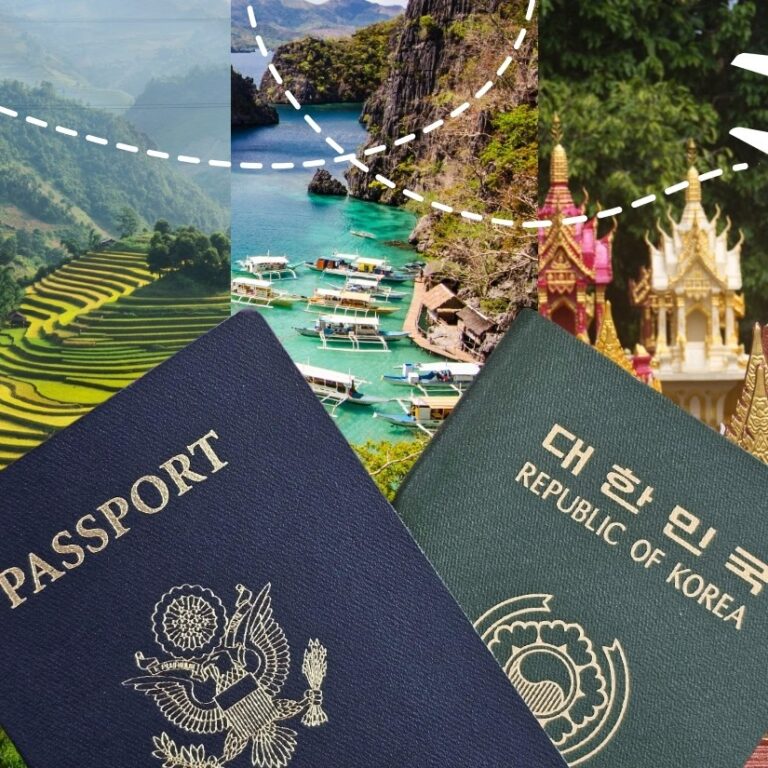
A Travel Guide to Exploring Asia From South Korea

An Insider’s Guide: 30 Essential Travel Tips for South Korea

A Local’s Guide to Gyeongju
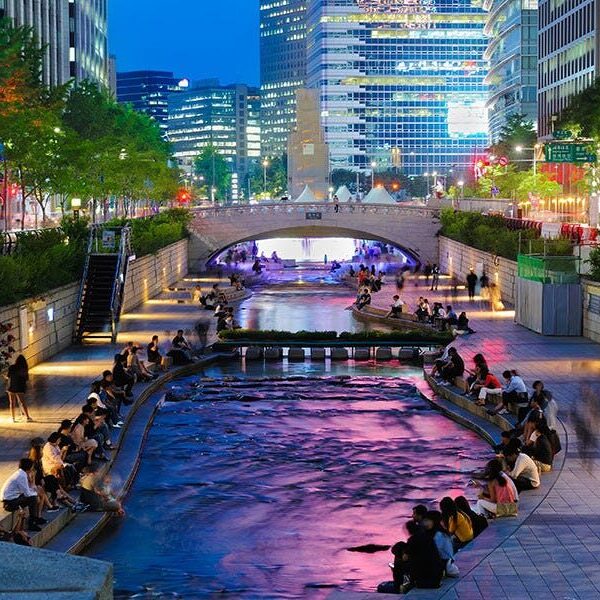
19 Did-You-Knows About Korea
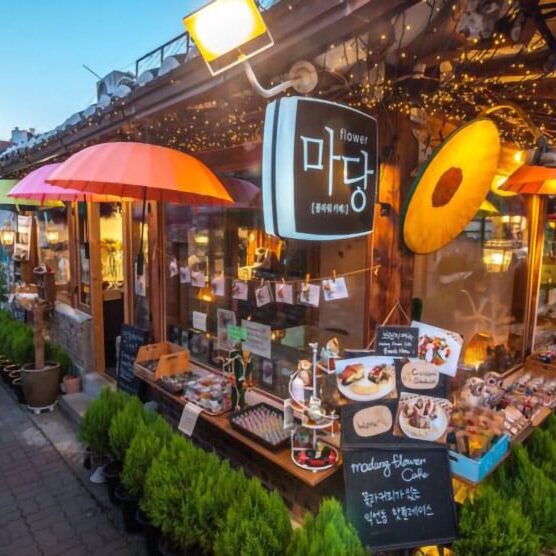
19 Best Things to Do in Seoul – An Insider’s Guide
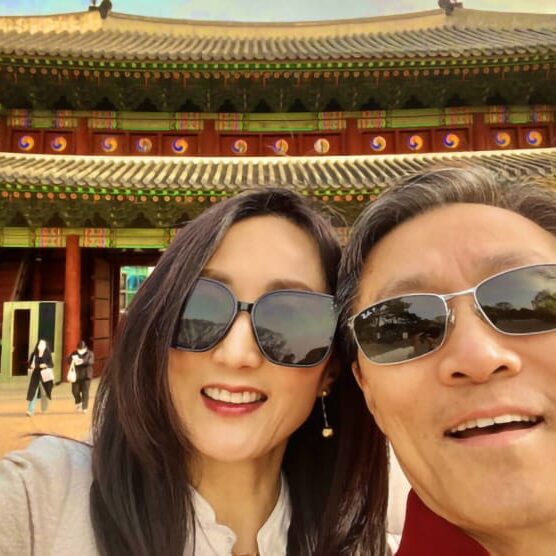
23 Reasons Seoul Will Be Your New Favorite City
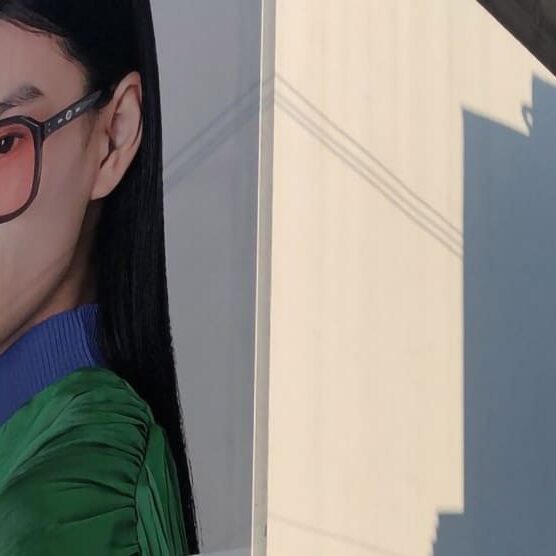
Off the Beaten Path: 5 Cool Things to do in Seoul
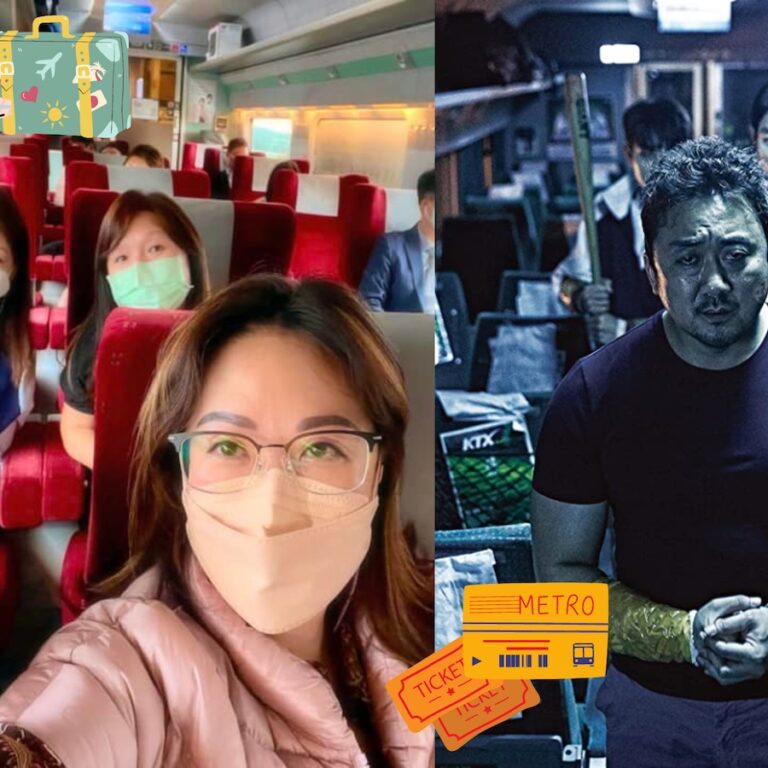
7-Day Trip to Korea Including a Train to Busan
Latest travel updates.
- Vaccination is NOT a requirement for entry into Korea.
- There is no requirement on the passport’s remainder validity for entry. You may travel to Korea as long as your passport remains valid throughout your stay in Korea.
- From April 1st, 2023, travelers from the USA, Canada, and 21 other countries no longer need to apply for the K-ETA to travel to Korea. This will run at least until 31st December, 2024 and is designed to make it easier to travel to Korea.
Planning Your Trip To Korea
Check the Korean Embassy for any possible travel restrictions.
- If you’re not sure where to stay, check out our guide to the best hotels in Seoul . You can find our recommendations for the best luxury, mid-range, and budget hotels in Seoul, as well as long-term apartments that you’ll love.
- For the best flight deals to South Korea, we recommend Skyscanner and Expedia .
- For the best hotel prices in Seoul, we recommend Klook 0r Agoda – they cover most hotels in Korea and offer the best prices without hidden fees.
- Before you travel to Korea, it’s a good idea to think about your SIM options. SIM stands for Subscriber Identity Module and unless you have the proper SIM service, you will not be able to use your phone. You can order an eSim card, regular sim card or portable WiFi router to collect at the airport so you’re connected as soon as you arrive. You can also check with your phone provider to see if you can turn on a dual SIM function on your phone.
- You can change a small bit of money before you travel, but you can also use the airport ATM to get some Korean won.
- There are sizeable differences in exchange rates depending on where you go, so you will need to do some comparing before you exchange large sums of money. You can exchange USD to KRW easily at banks or money exchange shops in all major tourist areas. Myeongdong and Namdaemun offer many options, and the Coex Center also has a money exchange facility. If you find a place that is out of line with other options, try negotiating the exchange rate with the vendor. Sometimes they will accommodate.
- You can withdraw cash from bank ATMs but be aware of bank fees. Alternatively, use a pre-paid travel card like the one offered by Wise , which allows ATM withdrawals and payments and works well in Korea.
- Don’t forget to bring a travel adapter for your electronics and leave plenty of extra space in your suitcase for the many Korean souvenirs and goodies you’ll buy on your tri
Do US Citizens Need A Tourist Visa?
No, travelers from the USA don’t need a tourist visa to enter South Korea. You can visit for up to 90 days visa-free.
Current COVID-19 Rules In Korea
Most COVID-19 rules in Korea have been dropped and now there are only 2 main rules to be aware of. First, face masks are mandatory when visiting medical facilities (hospitals). There is no longer a 7-day mandatory quarantine for people in South Korea. If you’re infected with COVID, the Korean government recommends a 5 day self-quarantine, but it’s not currently enforced.
Korean Tourism Support Hotline
If you have any concerns or problems when traveling in Korea, you can call 1330 . This is a dedicated tourism support hotline where trained specialists provide tourist assistance and is available in Korean, English, Japanese, Chinese, Russian, Vietnamese, Thai, and Malay.
US Government Travel Advisory For Korea
The U.S. Department of State currently has a level 1 travel advisory (Exercise Normal Precautions) for the Republic of Korea (ROK). Find out more about current travel advisories for South Korea on the Department of State website.

6 Best Destinations In Korea
South Korea is truly a country of contrasts. From the bustling, modern city of Seoul , with cutting-edge designer buildings, VR labs, and AI robots, to peaceful UNESCO World Heritage cities like Jeonju and Gyeongju , there are many unique places to explore.
There’s nothing worse than coming back from vacation and hearing about incredible places you missed that you wished you’d seen, such as a beautiful Buddhist temple by the beach (Haedong Yonggungsa Temple) or a leafy island getaway where deer and rabbits roam freely (Nami Island).
Here are 6 of the best destinations in Korea that you absolutely must visit, as well as some of the sights you’ll want to check out while you’re there. We’ll be bringing you lots more detailed destination guides in the future, so be sure to visit again soon.
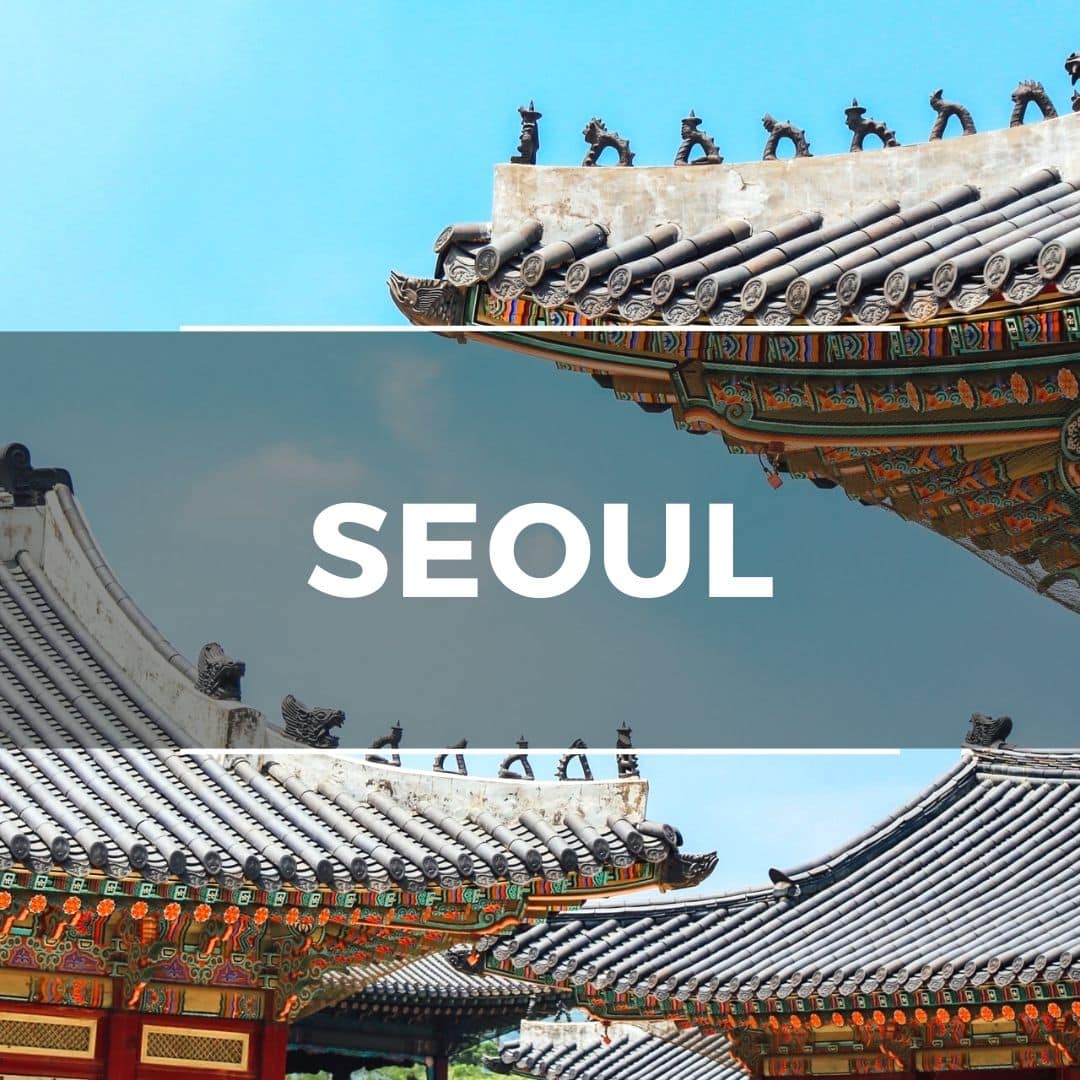
Korea’s Busy Capital
Seoul is Korea’s largest city, capital, and first, stop for most travelers to Korea. There are many beautiful places in Seoul , including landmarks, relics from ancient kingdoms, towering skyscrapers, Buddhist temples, Michelin-starred restaurants, and some of the best street food you’ll find in the world. If you see only one city in Korea, you should definitely visit Seoul.
You’ll never be bored in Seoul. Whether you’re traveling as a family, as a couple, or by yourself, there’s so much to do. Be sure to plan lots of time to check out Korea’s capital.
This Full Day Tour of Seoul will show you some of the hottest spots in the city, while this Customized Private Tour of Seoul will allow you to choose where to go.
Here are 10 of the best Seoul attractions:
- Gyeongbokgung Palace
- Bukchon Hanok Village
- Starfield COEX Mall
- Bukhansan National Park
- Myeongdong Street Markets
- Lotte World Tower
- Secret Garden (Changdeokgung Palace)
- Dongdaemun Design Plaza
- N Seoul Tower
- Yeouido Hangang Park

Korea’s Second City
Busan, Korea’s second city, is a thriving port city far away from Seoul both physically and culturally. This popular summer destination features some of Korea’s most popular beaches and bars. Explore Busan and you’ll find sprawling markets, fresh seafood, film festivals, the world’s largest shopping mall, coastal temples, and lots more.
Busan is a city with some very photogenic sights. See the sunrise on the beach, hike around leafy coastal streets on the side of cliffs, and marvel at the wide range of (living!) seafood in the markets.
This Full Day Tour of Busan will show you the best beaches, markets, and local sights, while this Customized Private Tour of Busan will allow you to choose where to go.
Here are 10 of the best Busan attractions:
- Haeundae Beach
- Gwangbokdong Food Street
- Haedong Yonggungsa Temple
- Huinnyeoul Culture Village
- Gamcheon Culture Village
- Oryukdo Sky Walk
- Lotte World Busan
- Jagalchi Fish Market
- BIFF Square & Centum City Mall
- Taejongdae Resort Park
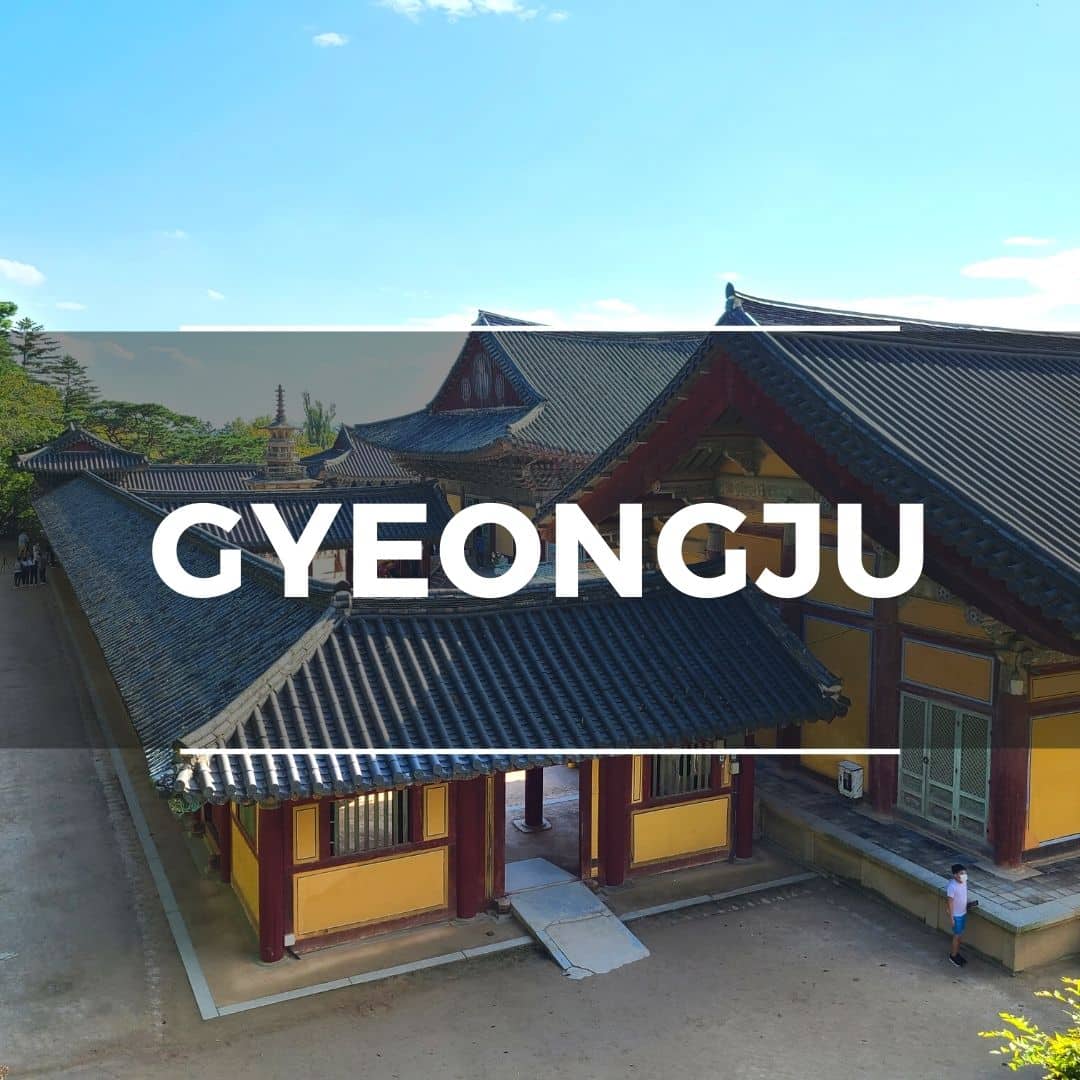
UNESCO City
Gyeongju is the former capital of the Silla Kingdom, part of the Three Kingdoms part of Korean history. These days, Gyeongju is an open air museum housing Korea’s finest history and monument. This UNESCO World Heritage City is a must-see for those who want to learn more about Korea’s deep cultural past.
Gyeongju is packed with temples, palaces, historical sights, and monuments. But it’s not just the history that draws the crowds, the city is an area of natural beauty, lined with cherry blossoms and shadowed by misty mountains.
This Full Day Tour of Gyeongju from Busan will take you around Korea’s open-air museum city, showing the top UNESCO sites along the way, while this Customized Private Tour of Gyeongju will allow you to choose where to go.
Here are 10 of the best Gyeongju attractions:
- Gyeongju Historic Area
- Bomun Lake Tourist Complex
- Bulguksa Temple & Seokguram Shrine
- Donggung Palace & Wolji Pond
- Yangdong Folk Village
- Cheomseongdae Astronomical Observatory
- Gyeongju National Museum
- Gyochon Traditional Hanok Village
- Woljeonggyo Bridge
- Gyeongju National Park
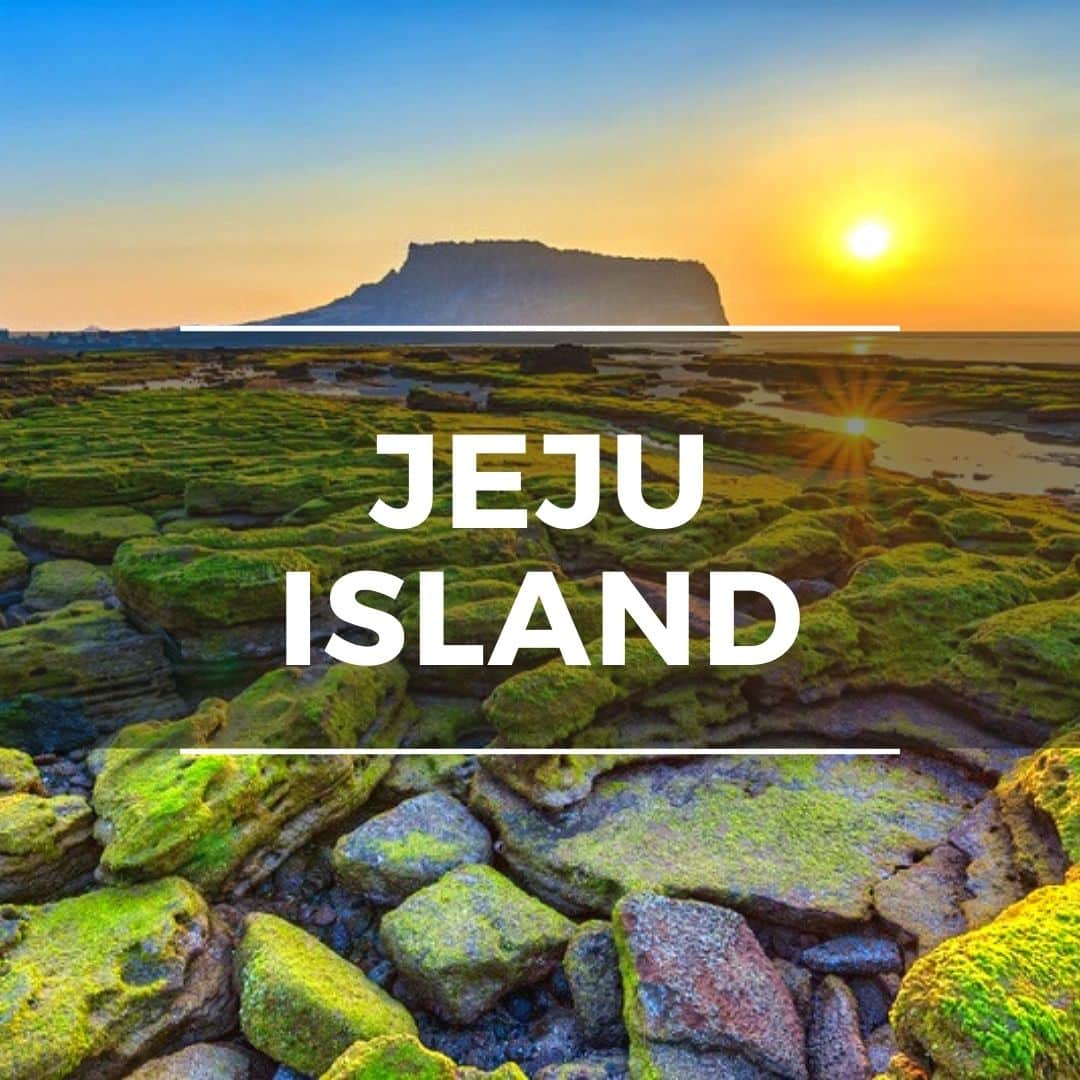
Natural Wonder
Jeju Island is Korea’s semi-tropical island that’s a popular vacation destination for locals and tourists alike. This area of outstanding natural beauty offers up rugged coastal walks, sandy beaches, green hills, and a volcano to hike up for those who enjoy a challenge. Culture and cafe lovers will also find Jeju Island a charm.
From snorkelling under the sea, to hiking above the clouds, sampling Jeju’s black pork BBQ, and drinking local green tea, there’s so many exciting activities, sights, tastes, and experiences waiting for you on Jeju Island.
This Full Day Tour of Jeju Island will show you some of the most incredible UNESCO World Heritage sites on Jeju’s East Coast, while this Customized Private Tour of Jeju Island will allow you to choose where to go.
Here are 10 of the best Jeju Island attractions:
- Seongsan Ilchulbong Sunrise Peak
- Jusangjeolli Hexagonal Lava Cliff
- Hallasan Mountain (Volcano)
- Hamdeok Beach
- Jeju Folk Village
- Hyeopjae & Geumneung Beach Areas
- Cheonjeyeon & Jeongbang Waterfalls
- Udo Traditional Island
- Yakcheonnsa Coastal Buddhist Temple
- O’Sulloc Green Tea Fields
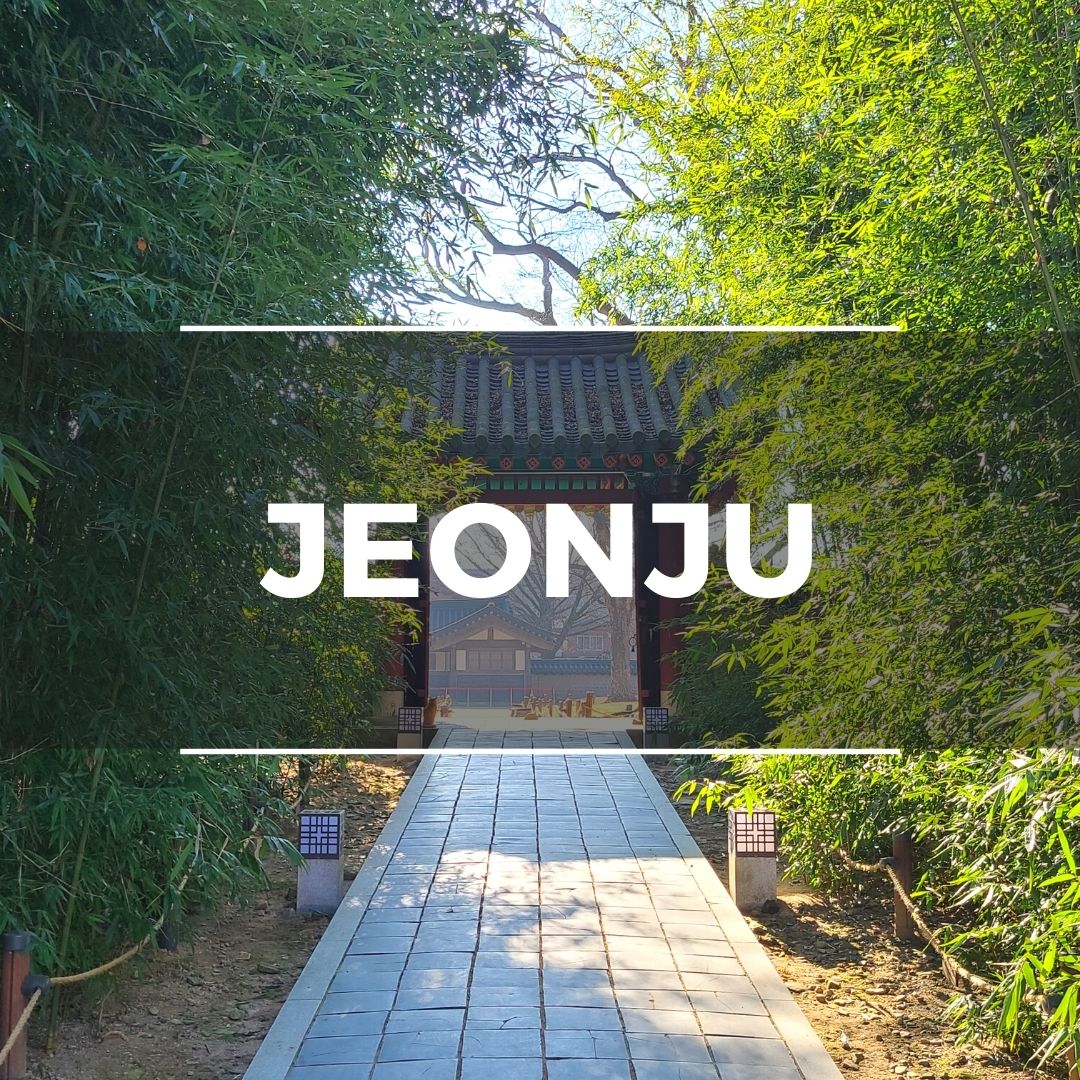
Traditional Korea
Jeonju is famous for its historical and cultural sights, including the sprawling Jeonju Hanok Village, packed with more than 700 traditional hanok houses. Jeonju’s many impressive sights are close to each other and perfect for a day trip from Seoul or Busan. You can even stay overnight in one of the traditional houses.
Jeonju is a tourist hotspot so there are plenty of things to keep travelers entertained and places to experience traditional Korean food and drinks. Be sure to check out the Jeonju bibimbap, one of Korea’s national dishes. Rent hanbok (traditional clothes), take lots of pictures, and see the sights.
This Full Day Tour of Jeonju will show you around the beautiful hanok houses and traditional Korean restaurants, while this 2-Day Tour of Jeonju includes an overnight stay in a hanok and lots of delicious Korean meals.
Here are 10 of the best Jeonju attractions:
- Jeonju Hanok Village
- Gyeonggijeon Shrine & Portrait Museum
- Jeongdon Catholic Church
- Jeonju Hyanggyo Confucian School
- Nambu Traditional Market
- Jaman Mural Village
- Omokdae Viewpoint
- Deokjin Park
- Hanbyeokdang Pavilion
- Taiji-ro & Hyangoyo-gil Shopping Streets
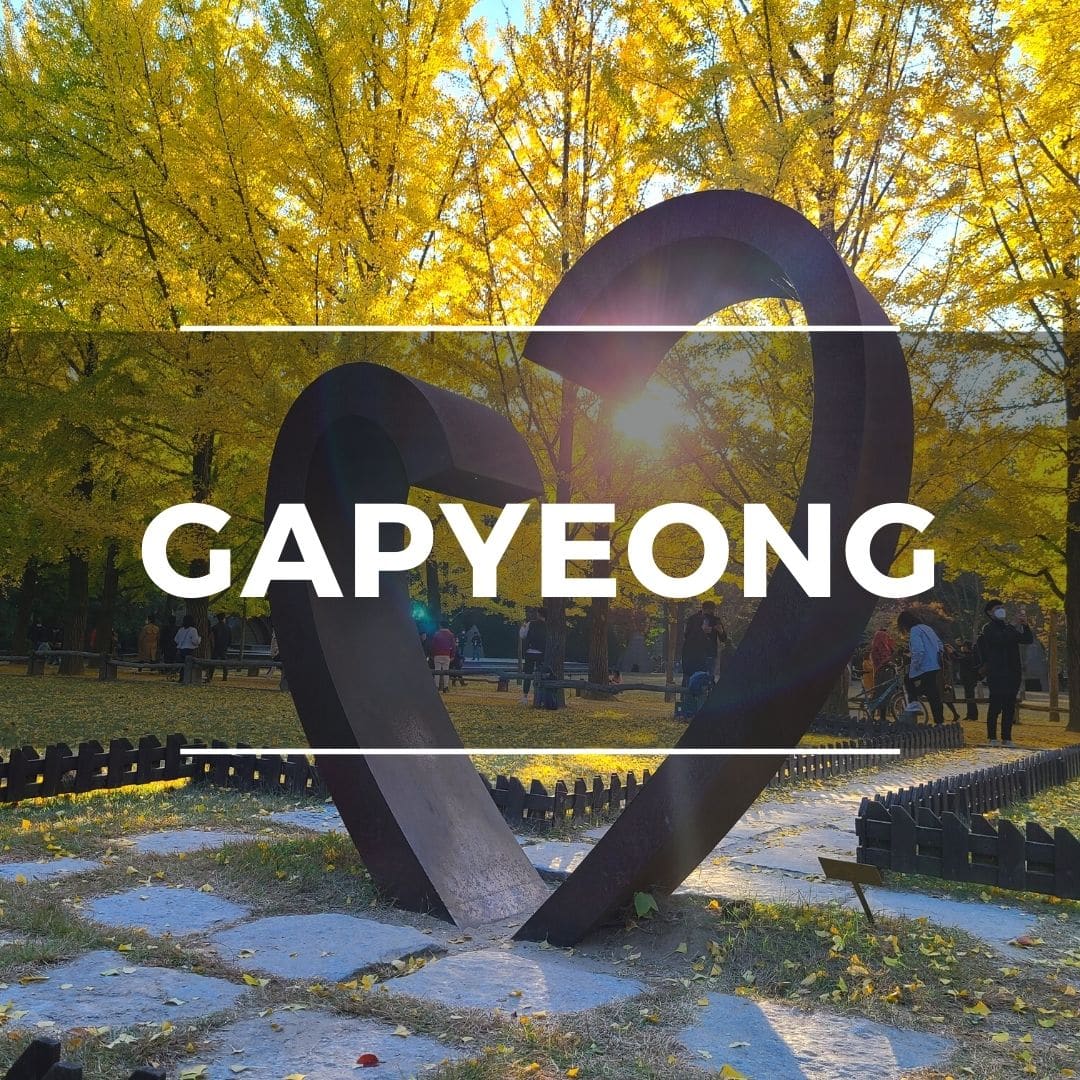
Rural Attractions
Gapyeong County is an area just outside of Seoul that’s home to several interesting attractions celebrating Korean and foreign culture. The lush green hills and blue rivers of Gapyeong make it a great place to immerse in Korean nature.
You’ll find some of the hottest day trip locations here. Explore Gapyeong County on a day trip from Seoul. You can see romantic tree-lined streets and cafes on Nami Island, explore one of Korea’s most beautiful gardens, take a trip to Petite France, and enjoy cycling through the hills on an abandoned railway track.
This Full Day Tour of Gapyeong will show you around Nami Island, Garden of Morning Calm, and the Rail Bike Park.
Here are 10 of the best Gapyeong attractions:
- Nami Island
- Garden of Morning Calm
- Petite France
- Ganchon Rail Bike Park
- Edelweiss Swiss Village
- Cheongpyeong Lake
- Jarasum Island
- Kalbongsan Recreational Forest
- Gapyeong Sledding Hills
- Nami Island Zip Line

There are loads of locations to visit in Korea that make for a perfect day trip from Seoul. Hop on a coach, train, or tour bus in the morning and explore one or more of these unique destinations.
Here are 10 of the best day trips from Seoul to discover on your next journey to Korea:
- DMZ (North Korean Border)
- Suwon Hwaseong Fortress
- Everland Theme Park
- Jeonju Historic City
- Seoraksan National Park
- Korean Folk Village
- Alpaca World
- Gwangmyeong Cave
Most travelers to Korea arrive at Incheon Airport and then travel into Seoul (it’s only 40 minutes away) to begin their journey. Seoul is certainly an incredible place to start traveling, but it definitely shouldn’t be your only destination. Korea has a lot to offer, including a lot of seasonal activities and events that you should take into consideration.
Spring and fall are the best seasons to visit Korea and during these times the traditional cities like Gyeongju and Jeonju look amazing. They’re covered with cherry blossoms or fall foliage and this creates some postcard-like scenes. Gapyeong area is packed full of natural sights to enjoy, so definitely check out these areas.
If you’re visiting during summer, head towards the coastal areas, including the north-east coastal towns of Gangneung & Sokcho, or the south-east coastal areas of Busan and the nearby islands, such as Geoje, Tongyeong, and Yeosu. You’ll find lots of winter activities to enjoy in these areas.
Winter is cold and dry and, ironically, a great time to visit Jeju Island . This semi-tropical island is warmer than the mainland, but still gets snow on the mighty Hallasan Mountain. You can sit on a sunny beach one day and then hike knee-deep in snow the next. Jeju is also famous for its citrus, with thousands of tangerine trees dropping their juicy fruits in early winter.

Where To Stay In Seoul
South Korea is truly a country of contrasts. From the bustling, modern city of Seoul , with cutting-edge designer buildings, VR labs, and AI robots, to peaceful UNESCO World Heritage cities like Jeonju and Gyeongju , there are many unique places to explore. If you’ve decided on Seoul, here are some of the best hotels that are well located and highly reviewed.
Choosing the best destinations to visit in Korea can be a challenge, especially if you don’t know what there is to see. You might not have heard of some of these destinations, which is not surprising. Korea is a country of undiscovered wonders that are waiting to be found.
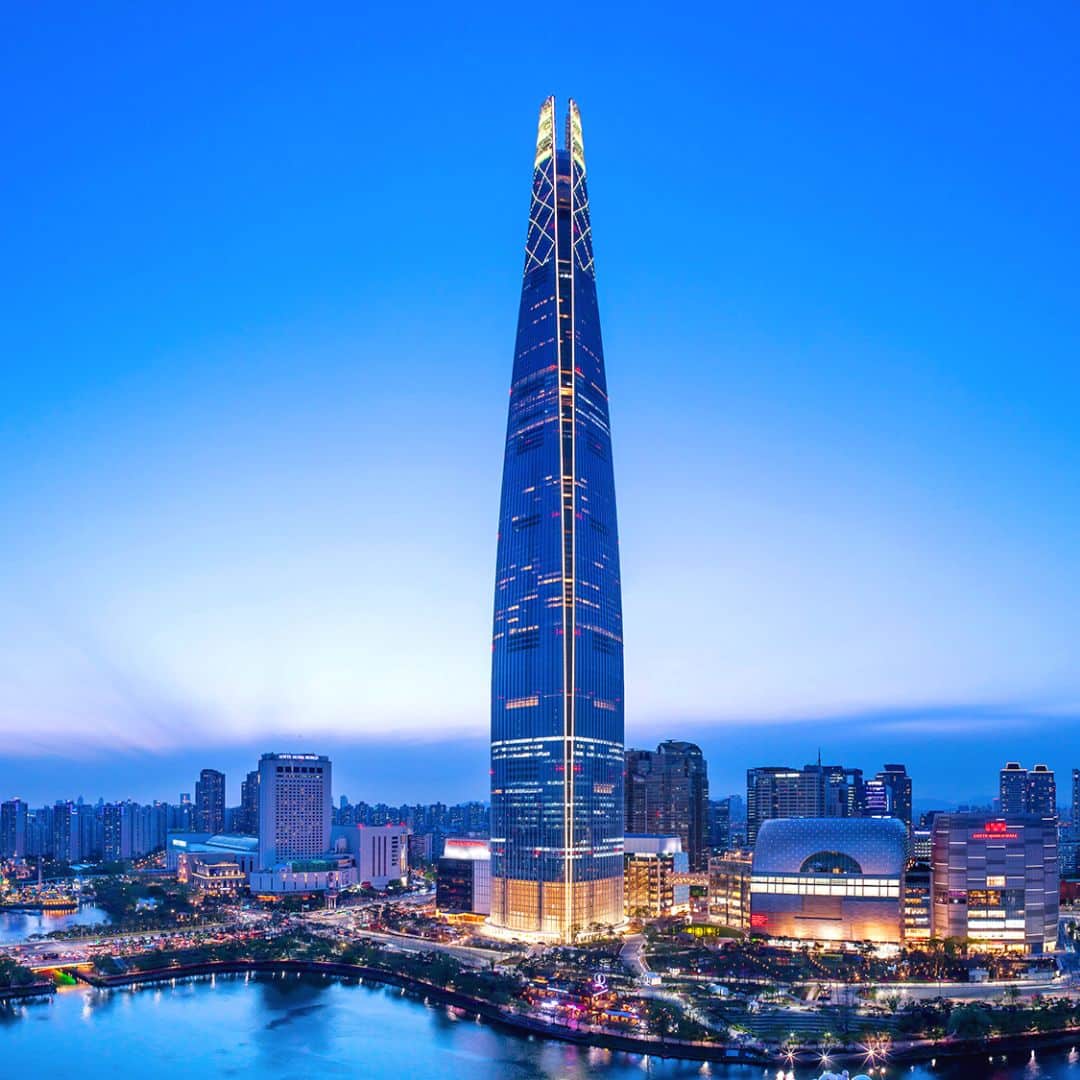
If you want the best Seoul has to offer, these luxury hotels are for you. Located in Seoul’s glitziest neighborhoods, these hotels are within walking distance of Michelin-starred restaurants, chic boutiques, galleries, museums, and the finest shopping experiences available.
Expect nothing but the best in terms of service and style at these luxury hotels. Silky soft sheets, immaculate rooms with the finest fixtures and fittings, and true 5-star service from the hotel staff. These hotels have sports, dining, and entertainment facilities to make you comfortable during your stay.
Airport transfers are available with these hotels, making your journey into and out of Seoul a breeze. Located in popular upmarket districts in Seoul, these neighborhoods have lots of local charm for you to discover, as well as allow easy access to other parts of the city with excellent transport options nearby.
Not only are these beautiful, comfortable hotels inside, but they are also located in some of the most iconic buildings or districts and provide amazing views over some of Seoul’s most interesting districts. The view from the first hotel is worth the cost alone.
Recommended Luxury Hotels In Seoul
Here are 3 of the best luxury hotels in Seoul that we recommend for an unforgettable stay in Korea’s capital:
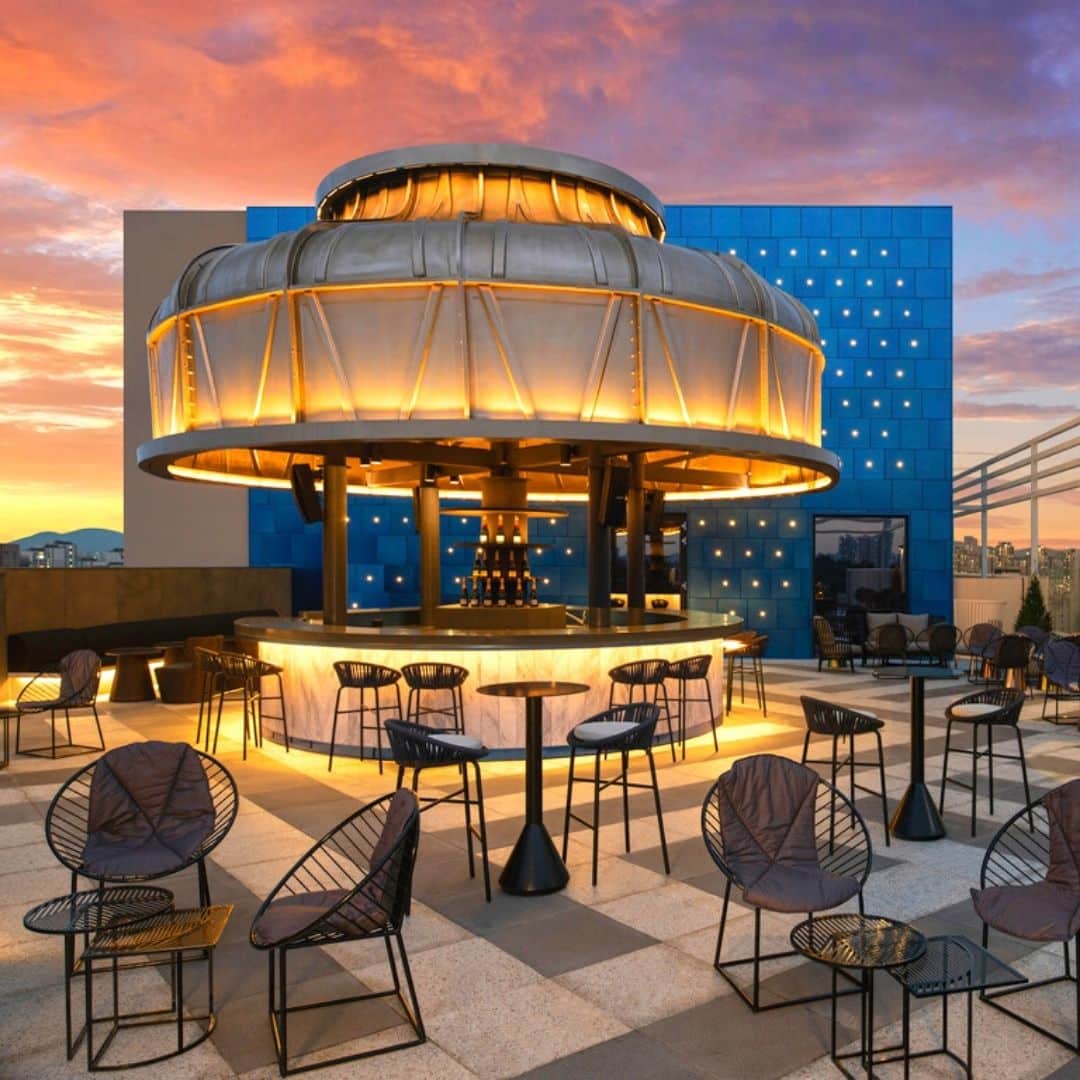
Families. couples and other travelers that want to experience the best of Seoul without breaking the bank can sleep easy with these mid-range hotel recommendations in some of Seoul’s trendy, vibrant districts, including Hongdae, Gangnam, and Myeongdong.
Encounter stylish accommodation in Seoul’s Hongdae districts, which is full of street culture and artistic scenes from the district’s eponymous Hongik University – one of Korea’s leading art centers.
Fashion lovers and shoppers will find lots to love in downtown Gangnam, with its wide streets and glassy storefronts bracketing narrow side streets and hidden delicacies.
Myeongdong is famous for its budget and mid-range accommodation options, including several hotels by the famous Lotte chain – one of Korea’s best mid-range brands.
Whichever mid-range hotel you choose in Seoul, you can be sure you’ll have fantastic city views, convenient subway access, and lots of unique cultural sights, sounds, and tastes to experience.
Recommended Mid-Range Hotels In Seoul
Here are 3 of the best mid-range hotels in Seoul that we recommend for an comfortable stay in Korea’s capital:
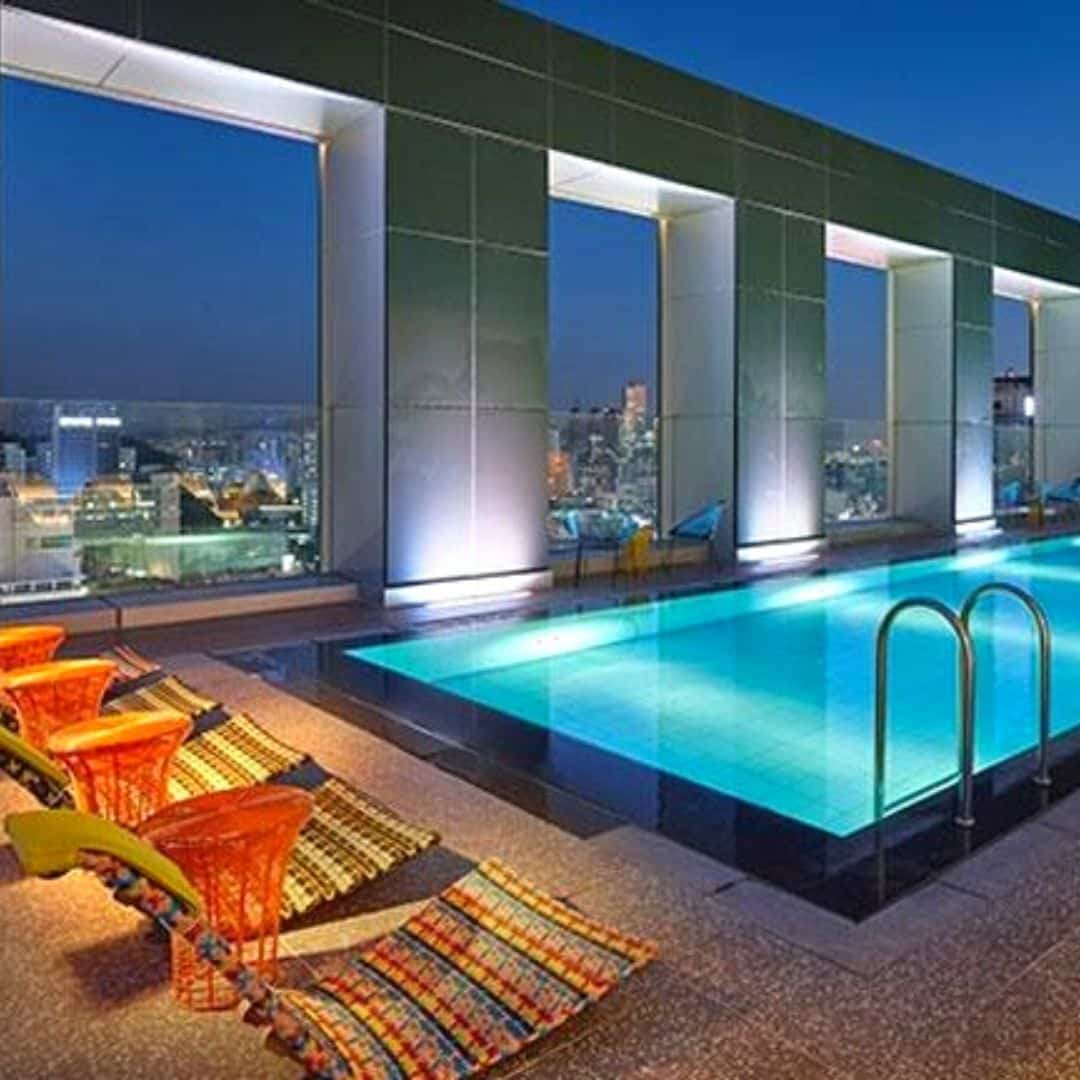
Seoul has a wealth of budget accommodation options that will help make your money go further. These hotels are all around $100 or less but offer the comfort and convenience that you’d expect to find in a mid-range hotel. One even has a beautiful rooftop pool.
Although these hotels are cheaper, don’t lower your expectations. You’ll always find great service in Korea. Save on sleeping to spend more on shopping, souvenirs, sights, and all the other fun things there are to do in Seoul.
These budget hotels in Seoul are also in great locations for shopping, enjoying local culture, and seeing the real side of Seoul and Korea. Hongdae offers bargain hunters the chance to get boutique fashion at market prices, Gangnam has plenty of cafes and cheap eats tucked away off the main avenues, and Myeongdong is a budget traveler’s paradise full of $1 street food and bargain souvenirs.
You won’t be disappointed with a night at any of these hotels. If you want to make your budget go further so you can spend more on some of the incredible day trips Seoul has to offer, definitely book a night at one of these hotels.
Recommended Budget Hotels In Seoul
Here are 3 of the best budget hotels in Seoul that we recommend for an affordable stay in Korea’s capital:
Korea Travel Tips
Korea is a unique country with a written language that looks nothing like English, fascinating etiquette rules , and an always busy lifestyle. Travelers may be lost trying to do even the simplest things.
These travel tips include the best options for staying connected, how to use public transportation easily and cheaply, great discount cards that will save you money as you travel, where to exchange money, and how to learn some basic Korean phrases for when you travel.
These essential Korea travel tips have been crafted by experienced travelers who love to save time and money. Only the best quality services and products are recommended here.
Here are our Korea travel essentials that’ll help you get around more easily, save you money, and let you get the most out of your trip.
Plan ahead now and you’ll have fewer troubles on your travels, giving you more time to enjoy your time in Korea.
If you’re traveling to Korea, you’re almost certainly going to want to get access to the internet to help you navigate, translate Korean, or even book tickets to attractions. Korea has one of the world’s best mobile internet and the prices are very reasonable. 5G mobile internet services are available across the country and Korea was one of the first to get the super-fast service. You won’t have problems connecting with a sim card or WiFi router when you travel.
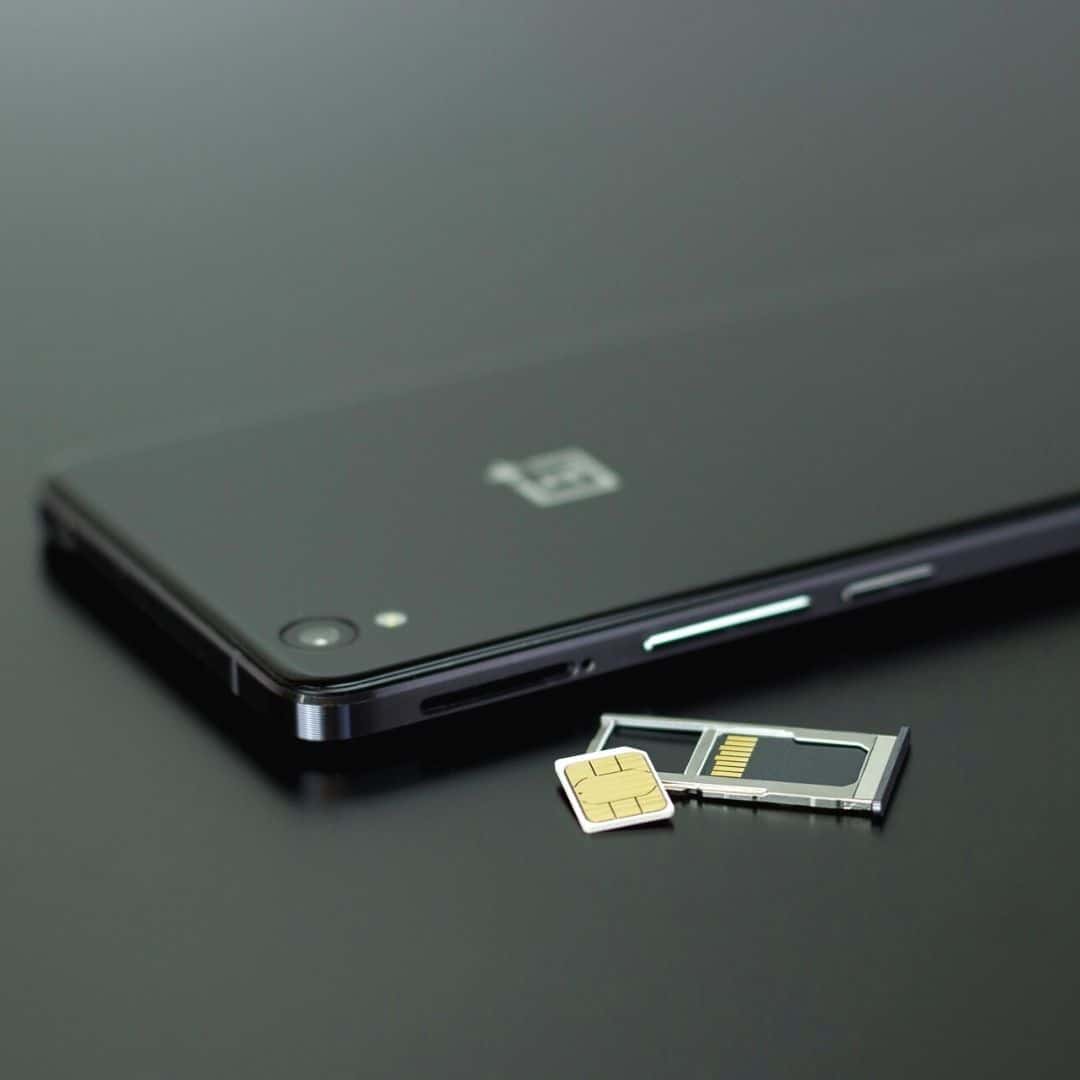
Sim Cards & Data Plans
A Korean sim card is a great way to get access to all your usual cellphone services when you travel to Korea. Sim cards come with data-only packages, or data and phone services combined.
Buying a Korean sim card will give you access to a Korean phone number, which is useful when using Korean apps. If you want to order food online in Korea, you need to have a Korean phone number to complete the order.
Korean Sim Card Costs
Prices start at W5,900 ($5) for a 1-day sim. You can also get 10-day sim cards (W34,700/$28) and 30-day sim cards (64,400/$52). These all come with unlimited data, domestic calls, and texts.
You can purchase a Korean Sim Card From Klook and collect it at the airport. This is a very convenient option as you can use it immediately to help navigate and check in back home.
Portable WiFi Routers
A Korean portable WiFi router will give you access to mobile internet throughout Korea by connecting to WiFi hotspots run by the major phone companies in Korea and comes with great coverage.
The major benefits of a portable WiFi router include a lower cost than a Korean sim card and also the ability to connect up to 3 devices to 1 router. That means that families and groups will be able to share the service.
Korean Portable WiFi Router Costs
The cost of a Korean portable pocket WiFi router is W3,200 ($2.60) per day. You can rent the WiFi router for as many days as you require and pay in advance and pay any excess days when you return it.
You can also purchase a Korean Portable WiFi Router From Klook and collect it at the airport. You can book online before you travel so that it’s guaranteed to be waiting for you.
Should I Get A Sim Card Or WiFi Router In Korea?
Both a sim card and WiFi router are great options for travelers to Korea and will almost guarantee a great reception for mobile internet. The choice between whether you should get a sim card or WiFi router in Korea really comes down to the costs involved and if you need a Korean phone number.
WiFi routers are cheaper and allow you to connect 3 devices, so they’re perfect for families. However, a sim card gives you a Korean phone number, which means you can call people and also register for Korean apps which require a phone number.
Check out our detailed article about the Best Sim Card & Portable WiFi options for traveling to Korea.
Traveling to any country involves potential scams, bad exchange rates, mistakes, and confusion when it comes to dealing with foreign currency. Fortunately, travelers to Korea have a wide range of options for travel money both before and while they travel.
Korea is a safe, modern country and one that has pushed hard for the mass adoption of cards. Almost every location that deals with money is required to accept card payments. This is great news for travelers to Korea as you can use a card to pay for meals out, entrance tickets, trains, and lots more.
Cash is still needed for some things, such as topping up transportation cards like the T-Money Card (more on that soon) and for paying for small things like street food. Please note, as Korea doesn’t have a tipping culture, you don’t need cash for leaving a tip. In fact, if you try to leave a cash tip, it’ll be returned to you in most places.
Read on to find the best tips to avoid getting ripped off when exchanging money and how to pay the lowest fees when you use a card to pay in Korea. Be a smart traveler and save more money for shopping and souvenirs.
Korean Money Exchange Options
Once you arrive in Korea, there are several options for exchanging money. First, you can exchange money at a money changer in tourist areas such as Myeongdong. These money changers used to have the best rates in Seoul.
However, a better option these days is to use the currency exchange machines from WOW Exchange. These machines are located all over Seoul’s most popular tourist spots, stations, and hotels. They allow you to exchange foreign cash directly to Korean won, with better rates than at the airport. You can also use these machines to claim a tax refund for your shopping before heading to the airport. Both options require a passport.
Should I Change Money At The Airport?
Exchanging money at the airport is easy and convenient as you can instantly get cash to use for shopping, transportation, and general use. However, the exchange rate at the airport is usually much worse than you’ll find in other places in Korea, as mentioned previously. If you need cash as soon as you land, withdraw a small amount ($50) and then exchange the rest in Seoul.
Travel Money Cards For Korea
While cash is useful and familiar when traveling, a much better option is to use a travel money card (also known as a currency card). Travel money cards, such as the Wise Travel Money Card, allow you to pay for travel expenses without the need to carry cash or convert money.
A travel money card offers the convenience of using a credit card without high fees that a regular bank could charge. It also allows you to withdraw cash from an ATM without a fee (up to a limit), so you can avoid carrying any cash on the flight or using a money exchange. The exchange rate is the mid-market rate, meaning it’s better than you’ll find even at the money exchanges listed before.
Can I Use My Bank Card In Korea?
Credit cards are widely accepted in Korea. Visa and Mastercard users shouldn’t face a problem, but other cards aren’t as widely accepted. Debit cards and cash withdrawals might not work depending on the bank. Your bank may charge a fee when using it overseas, or give a bad exchange rate. Check with your bank before traveling.
The best option for travel money in Korea is to have a mixture of cash and cards, with a backup credit card just in case. Taking some USD with you is always a good option as you can find plenty of places to exchange it to Korean won and probably at a better rate than you’ll get in the US. If you want to withdraw money in Korea, look for the global ATMs in tourist areas.
Taking a travel money card will be safer, cheaper, and more convenient than relying on your own bank or credit card, too. These cards offer competitive rates and are widely accepted around the world so you can use them to visit other countries, too. If you use a travel money card and it gets lost or stolen, you can freeze the card instantly with the app and not have to worry about losing the balance on the card.
When you visit Korea, you’ll notice that most people pay for goods with a card or payment app, even for small purchases like a bottle of water. Unfortunately, the payment apps that are common in the US, such as Apple Pay or Google Pay, aren’t available in Korea. Korean apps, such as Kakao Pay, require a Korean bank account, and therefore aren’t an option for travelers.
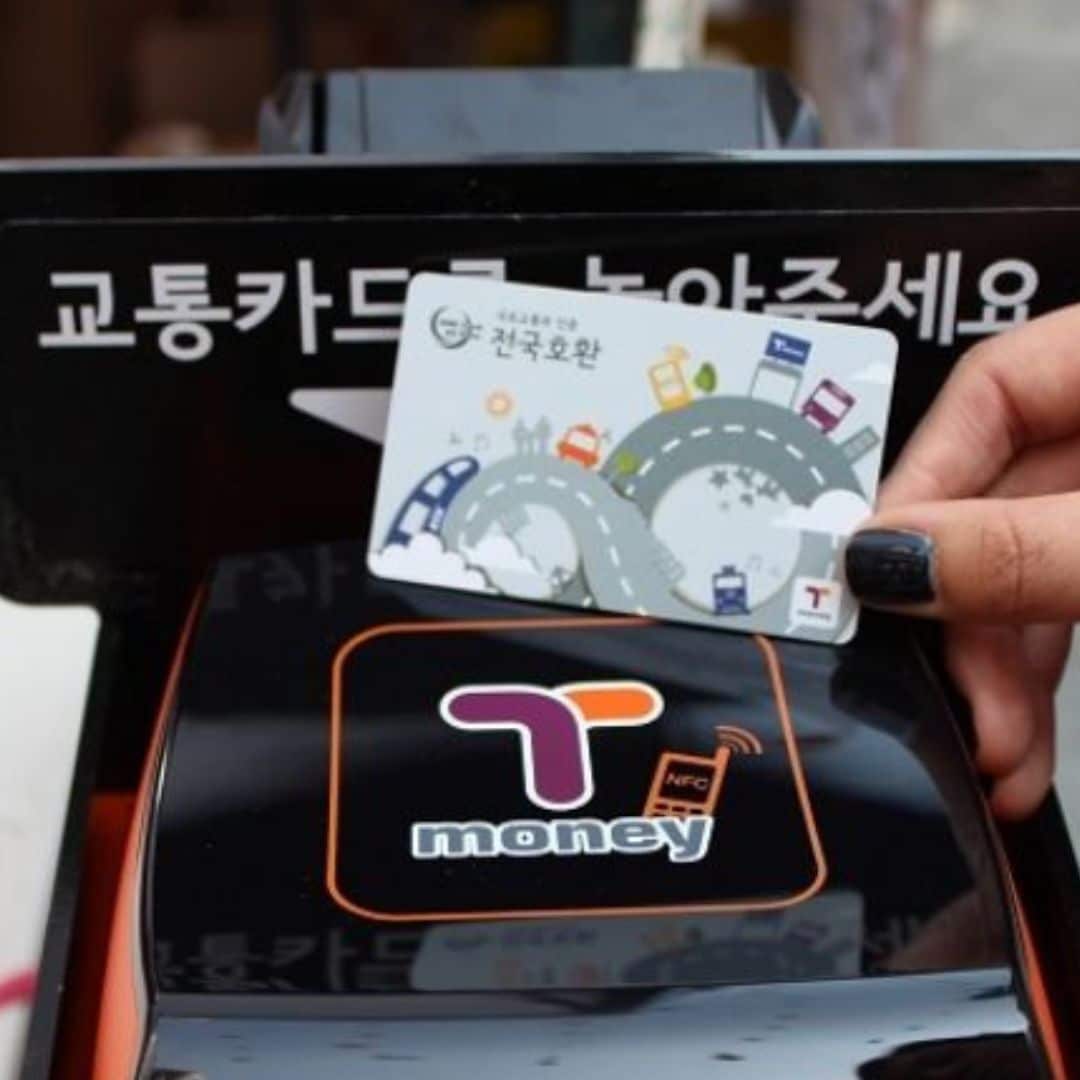
T-Money For Public Transport
The T-Money Card is an essential purchase for every traveler to Korea. The T-Money Card is a transportation card that allows contactless travel on Korea’s buses and subways. Simply buy a T-Money Card, top-up the card, then use it to travel.
Not only is this transportation card really convenient, it also saves you money. You’ll receive a discount on every bus or subway journey when you pay with the T-Money Card. These discounted fares are available in all cities across Korea, not just Seoul.
This isn’t the only use of the T-Money Card. You can also use to buy a coffee from Starbucks, get lunch in McDonald’s, shop for Korean cosmetics, and even to watch a baseball game. It’s a very useful card that can be used anywhere you see the T-Money Card.
You can get the T-Money Card in Korea from subway stations and at certain transport centers, including Seoul Station and Incheon Airport. The card costs 2,500 KRW. You can buy the card with a credit card, but to top-up the card, you need to use cash. If you buy a Discover Seoul Pass, this card includes the T-Money functions.
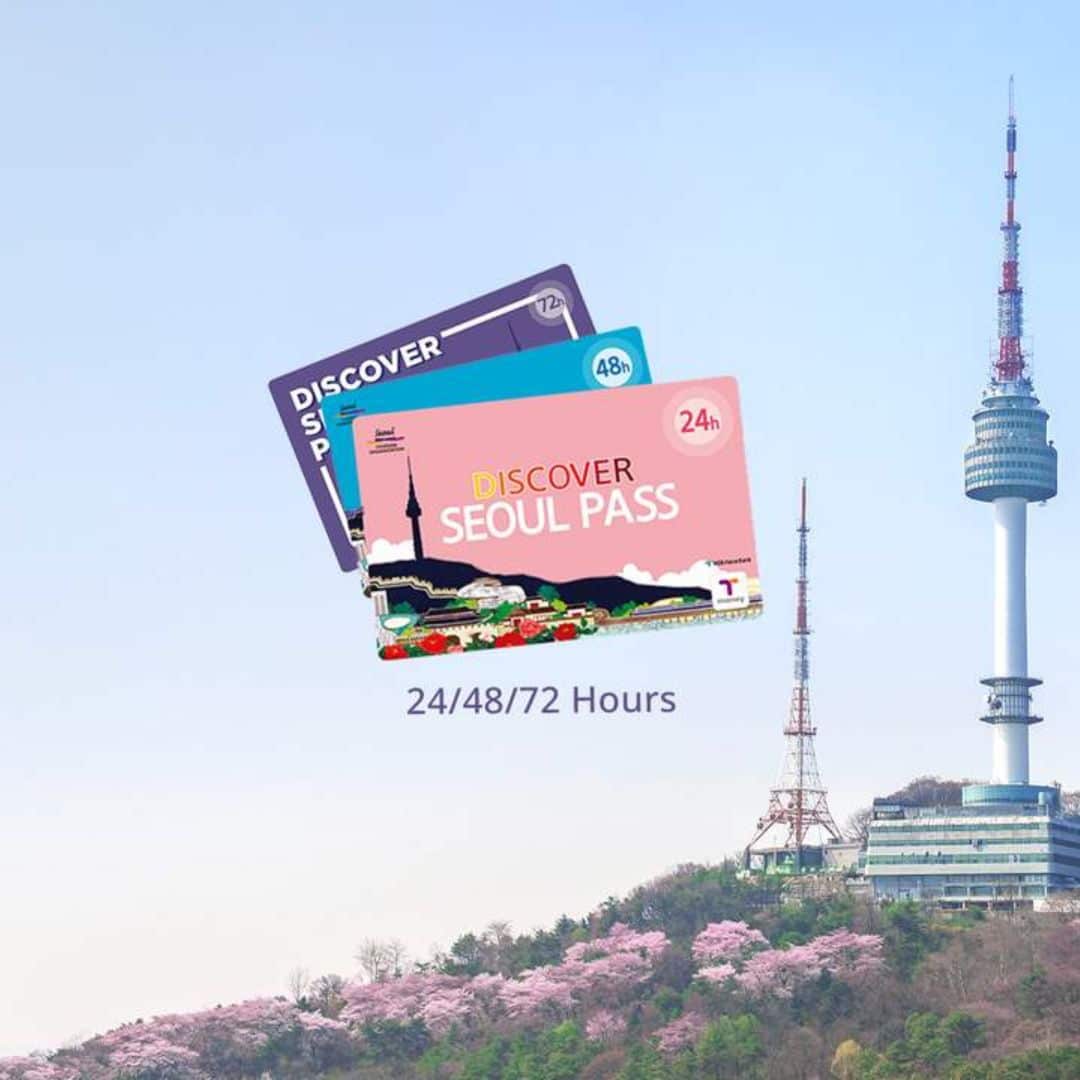
Save With The Discover Seoul Pass
Travelers to Seoul have a lot of options for incredible attractions to enjoy and experience. However, tourists, especially families, can find that the cost of these attractions quickly add up, especially when you are visiting many locations in a short time.
A great way to save money when you travel in Seoul is to buy a Discover Seoul Pass – a special card that offers you big savings on some of Seoul’s top attractions, as well as other benefits.
If you plan to visit Seoul’s Royal Palaces, N Seoul Tower, Lotte World Adventure Theme Park, the COEX Aquarium, Alive Museum, Seoul Zoo, or other premium attractions, you can gain free entry when you purchase a Discover Seoul Pass.
Not only that, you can also get a free river cruise, free hanbok rental, free ride on the Airport Express from Incheon Airport to Seoul, free City Tour Bus Ride, free T-Money Card and lots more.
The Discover Seoul Pass is valid for 24 | 48 | 72 hours and is valid from the moment you first use it until that many hours later.

Things To See & Do In Korea
If you want to build your own itinerary for South Korea, then this section of the South Korea Travel Guide will provide the building blocks you need to craft the perfect trip.
South Korea is a country packed with famous landmarks and sights, unique culture – modern & historical, family-fun activities, outdoor adventures, cozy cafe districts, and natural wonders. There’s more to do in Korea than you could imagine and it’s impossible to explore it all in one trip. Try to plan your itinerary by cities and locations. For example, plan your day in Seoul stay by district.
Here are some of the best things to see and do in South Korea, broken down into different themes so you can find things that interest you the most. The location of each of these attractions is included, too, so you can create a city by city itinerary, seeing the best South Korea has to offer.
These attractions are available all year round so whenever you go to Korea, you can enjoy them. There are plenty of things to see and do in Korea that only happen during certain seasons. Check out the Season Guide in this South Korea Travel Guide for more information about Korean festivals and seasonal events.
Here are 10 of the best Korean landmarks:
- Lotte World Tower (Seoul)
- Bukchon Hanok Village (Seoul)
- Nami Island (Gapyeong)
- Banwol ‘Purple Island’ (West Coast)
- N Seoul Tower (Seoul)
- Dongdaemun Design Plaza (Seoul)
- Seoraksan National Park (Gangwon Province)
- Hwaseong Fortress (Suwon)
- Cheonggyecheon Stream (Seoul)
- Gamcheon Cultural Village (Busan)
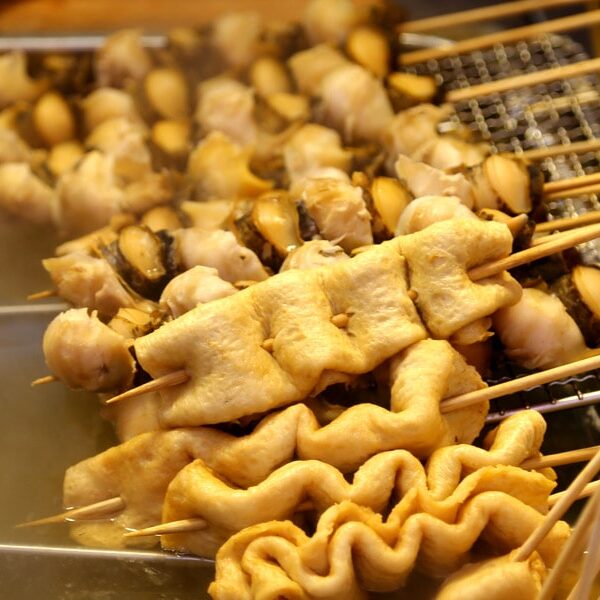
Why travel to a diverse country such as Korea and not embrace the local culture? Here are 10 of the best unique Korean experiences you can only enjoy fully in Korea. Be brave, try something new and create lasting memories of your Korean adventure.
Here are 10 of the best uniquely Korean experiences:
- Wear Traditional Korean Hanbok (Royal Palaces)
- Sing In A Korean Noraebang (Everywhere)
- Sleep In A Korean Hanok House (Hanok Villages)
- Visit The Kimchi Museum (Seoul)
- Eat Street Food (Traditional Markets)
- Experience A Korean Temple Stay (National Parks)
- Drink Makgeolli – Korean Rice Wine (Everywhere)
- Visit The World’s Most Dangerous Border – The DMZ
- Relax In A Korean Sauna (Everywhere)
- Visit A Korean Green Tea Field (Boseong, Jeju)

Here are 10 of the best Korean historic sights:
- Gyeongbokgung Palace (Seoul)
- The Secret Garden (Seoul)
- Bulguksa Temple (Gyeongju)
- Jeonju Hanok Village (Jeonju)
- Seoul Fortress Walls (Seoul)
- Haedong Yonggungsa Temple (Busan)
- Andong Hahoe Folk Village (Andong)
- Gyeongju Historic Area (Gyeongju)
- Baekje Historic Area (Gongju, Buyeo)
- Jangsaengpo Whale Museum (Ulsan)

Here are 10 of the best modern K-Culture spots:
- K-Pop Headquarters (Seoul)
- HYBE Insight (Seoul)
- COEX Artium (Seoul)
- K-Style Hub (Seoul)
- Hongdae Shopping Street (Seoul)
- Hallyu K-Star Road (Seoul)
- Asia Culture Center (Gwangju)
- Busan International Film Festival Square (Busan)
- MBC World Theme Park (Seoul)
As you’ll see, there’s just so much to see and do in Korea. You could spend a whole week in Seoul and not run out of exciting activities to do and sights to explore. Our advice is to try to avoid planning to do too many things in one day and adding in plenty of free time.
There’ll be many random things that catch your eye, such as a curious side street, or your nose, like the delicious smells from a food stall. Make sure you’ve got flexibility in your schedule to investigate these surprises and to take a rest if you need to – walking and traveling for days on end can get tiring.
Korea comes alive at night and markets and city streets are often best explored after the sun goes down. Drab concrete buildings come alive with neon signs, lanterns, and electric lights and are quite a sight to be seen. Visit popular tourist attractions such as the royal palaces and hanok villages during the morning as they’ll be less crowded.
If you plan to visit the Secret Garden in Changdeokgung Palace (you really should!), tickets are available on the day and sell out fast. Getting to these places early can guarantee you get tickets, see the sights unobstructed, and have time in the evening to soak up the night life and culture.
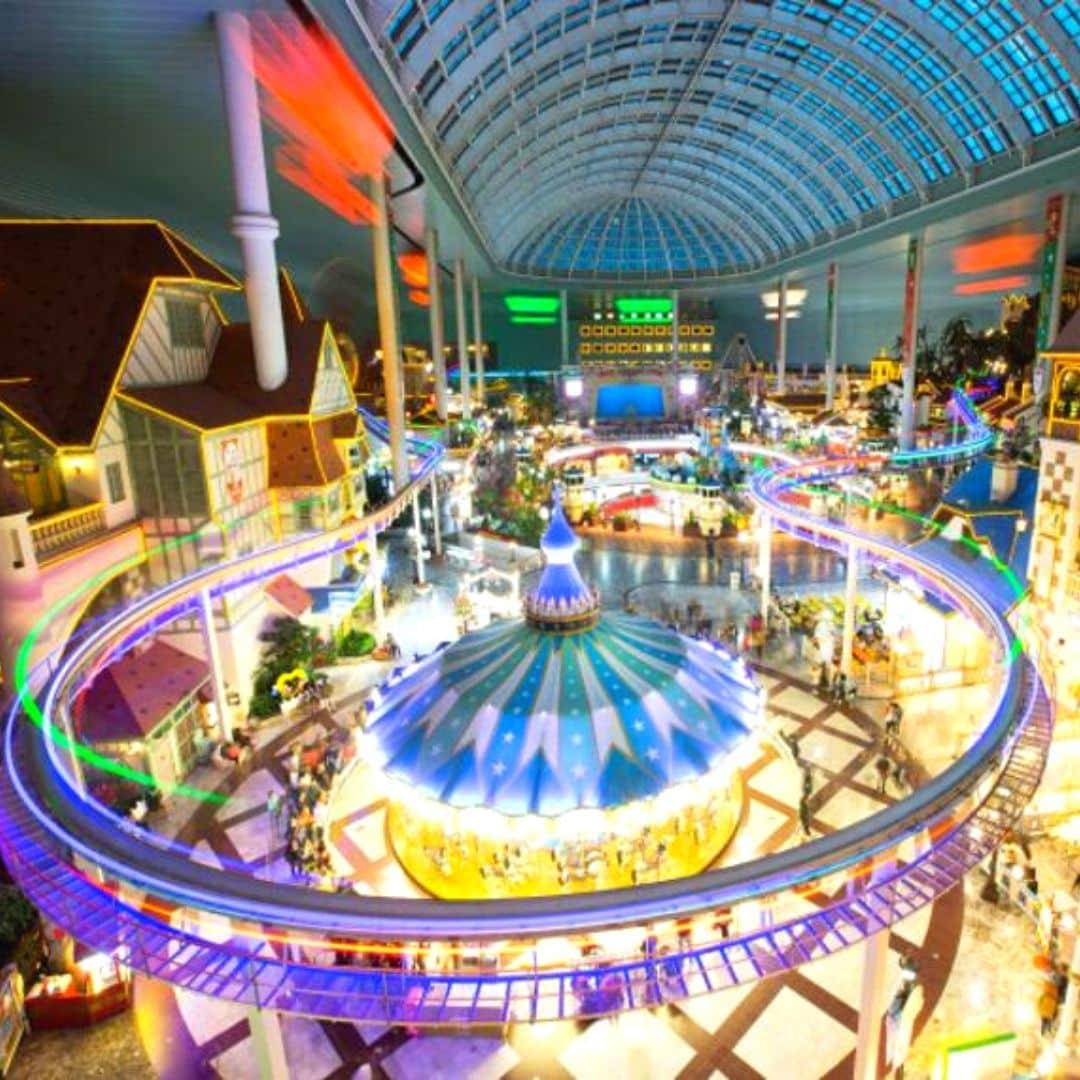
Here are the 10 best family-friendly activities in Korea:
- Nami Island & Garden of Morning Calm (Gapyeong)
- Seoul Grand Park & Zoo (Seoul)
- Lotte World Adventure (Seoul, Busan)
- Alive Museum & Dynamic Maze (Seoul)
- Seoul Children’s Grand Park (Seoul)
- Seoul Children’s Museum (Seoul)
- Everland & Caribbean Bay Theme Parks (Near Seoul)
- Sea Life Busan Aquarium
- Jeju Dinosaur Island (Jeju)
- Alpaca World (Gangwon Province)
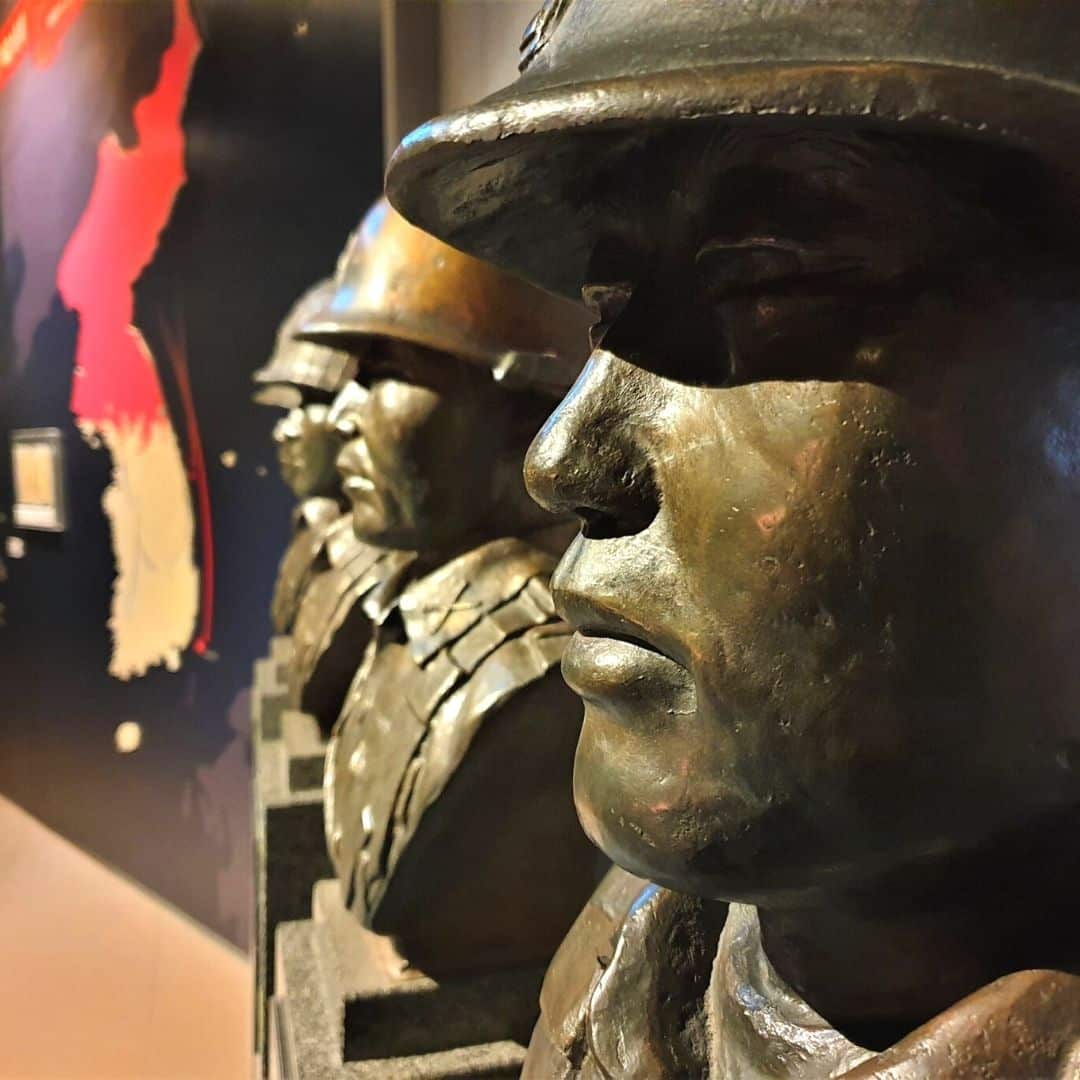
Here are the 10 best museums & galleries in Korea:
- National Museum of Korea (Seoul)
- Seoul Museum of Art (Seoul)
- Gyeongju National Museum (Gyeongju)
- War Memorial of Korea (Seoul)
- National Folk Museum of Korea (Seoul)
- National Maritime Museum (Busan)
- Seodaemun Prison History Museum (Seoul)
- Seoul Museum of History (Seoul)
- Museum Kimchikan (Seoul)
- Daegu Art Museum (Daegu)

Here are the 10 best cafe areas in Korea:
- Ikseondong Hanok Village (Seoul)
- Gyeongui Line Hongdae (Seoul)
- Samcheondong Cafe Street (Seoul)
- Jeonpo Cafe Street (Busan)
- Hwangnidan-Gil (Gyeongju)
- Gangneung Coffee Street (Gangneung)
- Sinsa-Dong / Garosugil Road (Seoul)
- Jukjeon Cafe Street (Seoul)
- Hwaseong Haenggung Area (Suwon)
- Kim Kwang Seok Gil Street (Daegu)

Here are 10 of the best Korean markets and shopping areas:
- Gwangjang Market (Seoul)
- Myeongdong Market Area (Seoul)
- Jagalchi Fish Market (Busan)
- Centum City Mall (Busan)
- IFC Mall (Seoul)
- Starfield COEX Mall (Seoul)
- Nambu Market (Jeonju)
- Seomyeong Underground Shopping Center (Busan)
- Seogwipo Maeil Olle Market (Jeju)

Here are 10 of the best natural sights in Korea:
- Hallasan Mountain (Jeju)
- Jirisan National Park (Jeollanam Provice)
- Seoraksan National Park (Gyeonggi Province)
- Seongsan Ilchulbong Sunrise Peak (Jeju)
- Damyang Juknokwon Bamboo Forest (Damyang)
- Boseong Green Tea Plantation (Boseong)
- Haeundae Beach (Busan)
- Udo Island (Jeju)
- Hwaamdonggul Cave (Gangwon Province)

Travel Itinerary For Korea
When planning a travel itinerary for South Korea, it’s best to think about what kind of experience you want when you travel to South Korea and build your itinerary from that. What kind of traveler are you and what do you want to take away from your Korea trip? Are you planning a trip for yourself, for your family, or as a romantic escape?
Do you want to learn about traditional Korean culture and history? Are you visiting to immerse yourself in modern Korean culture and maybe meet your idols? Are you planning to get out into Korea’s mountains to hike and join a Buddhist Temple Stay? Or are you going to eat, drink, shop, and make the most of Korea’s discounted goods? Or all of the above?
This section of this South Korea Travel Guide will offer some of the best one-week and two-week itineraries for South Korea. These itineraries are rough guides, created to help you begin planning your trip. Feel free to pick and choose the parts from them that you like to create your own travel itinerary for South Korea. We’ll be adding more great itineraries soon, be sure to check back for the latest ideas.
Classic 1 Week Itinerary For Korea: Seoul, Busan, Gyeongju
This is one of the most popular of the 1-week itineraries for South Korea and will take you to the most famous and interesting places that are top of most travelers’ South Korea bucket lists. Starting in Seoul, Korea’s capital, you’ll explore the best sights in this city before taking a day trip out to the lovely Gapyeong County to get a breath of fresh Korean countryside air.
From day 4, zip across the whole of Korea on the high-speed KTX train and explore Korea’s second city, Busan. See coastal temples, fish markets, wide beaches, and more in Busan before taking a day trip to Korea’s historic UNESCO World Heritage City, Gyeongju. On the last day, it’s time to return to Seoul to pack your bags full of the best souvenirs and snacks and say farewell in the highest part of the city.

Afternoon : Dressed in your hanbok, enjoy more traditional Seoul with a walk around the narrow streets of the Bukchon Hanok Village. Visit traditional Korean teahouses, galleries, markets, and more.
Evening : Check out the stalls and shops of artsy Insadong, contemplate Jeogyesa Temple, and take an evening stroll along the Cheonggyecheon Stream before dining in Myeongdong or the Jonggak Avenue of Youth. This Full Day Tour of Seoul will show you some of the hottest spots in the city, while this Customized Private Tour of Seoul will allow you to choose where to go.
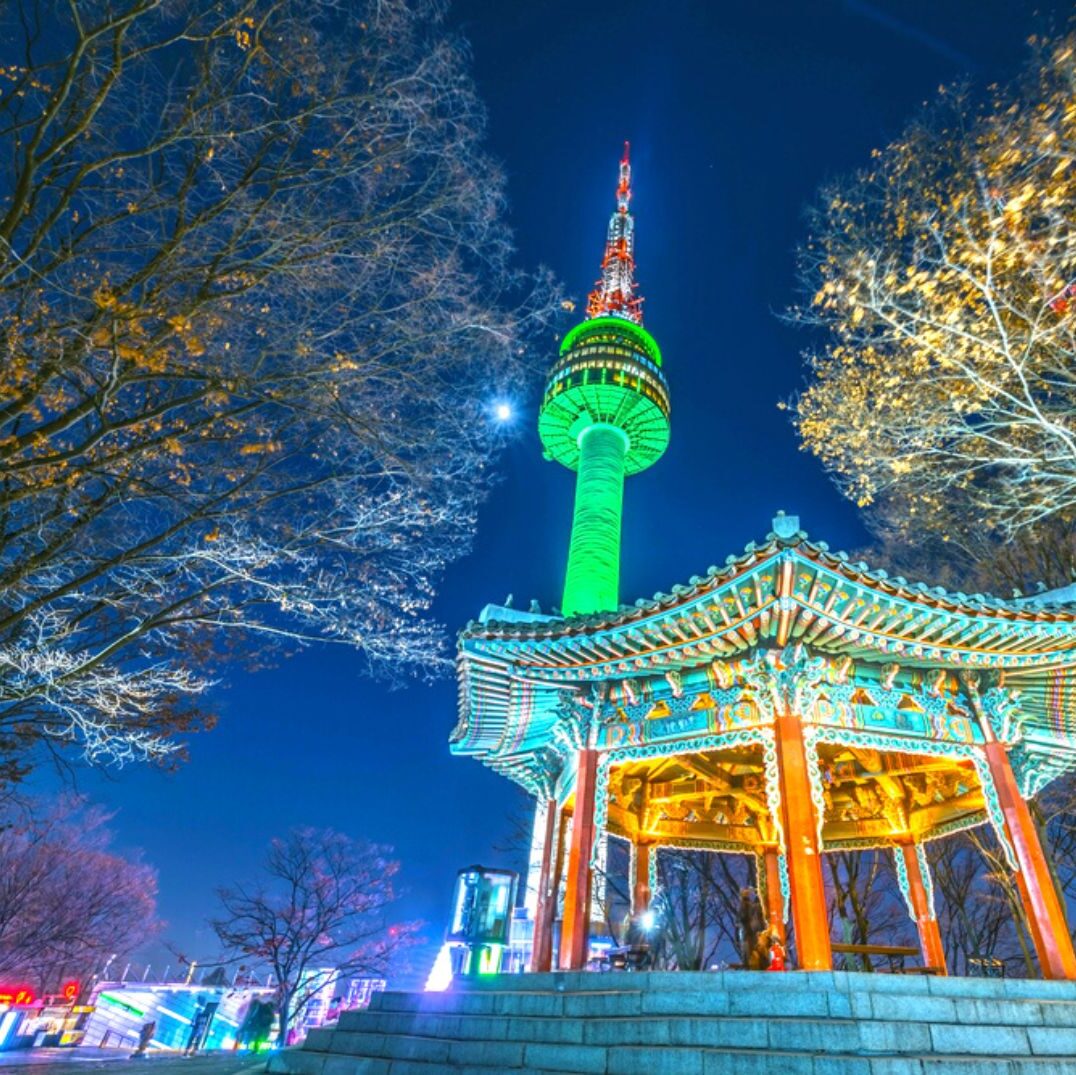
Afternoon : Head back to central Seoul and witness the bustling sights and delicious smells of Seoul’s traditional Gwangjang and Dongdaemun Markets. Try delectable Korean street foods here.
Evening : Take the Namsam Cable Car to the top of Namsan Mountain and watch the sunset from N Seoul Tower. See some of Seoul’s fortress walls before heading back down to go late-night shopping at Myeongdong Market.
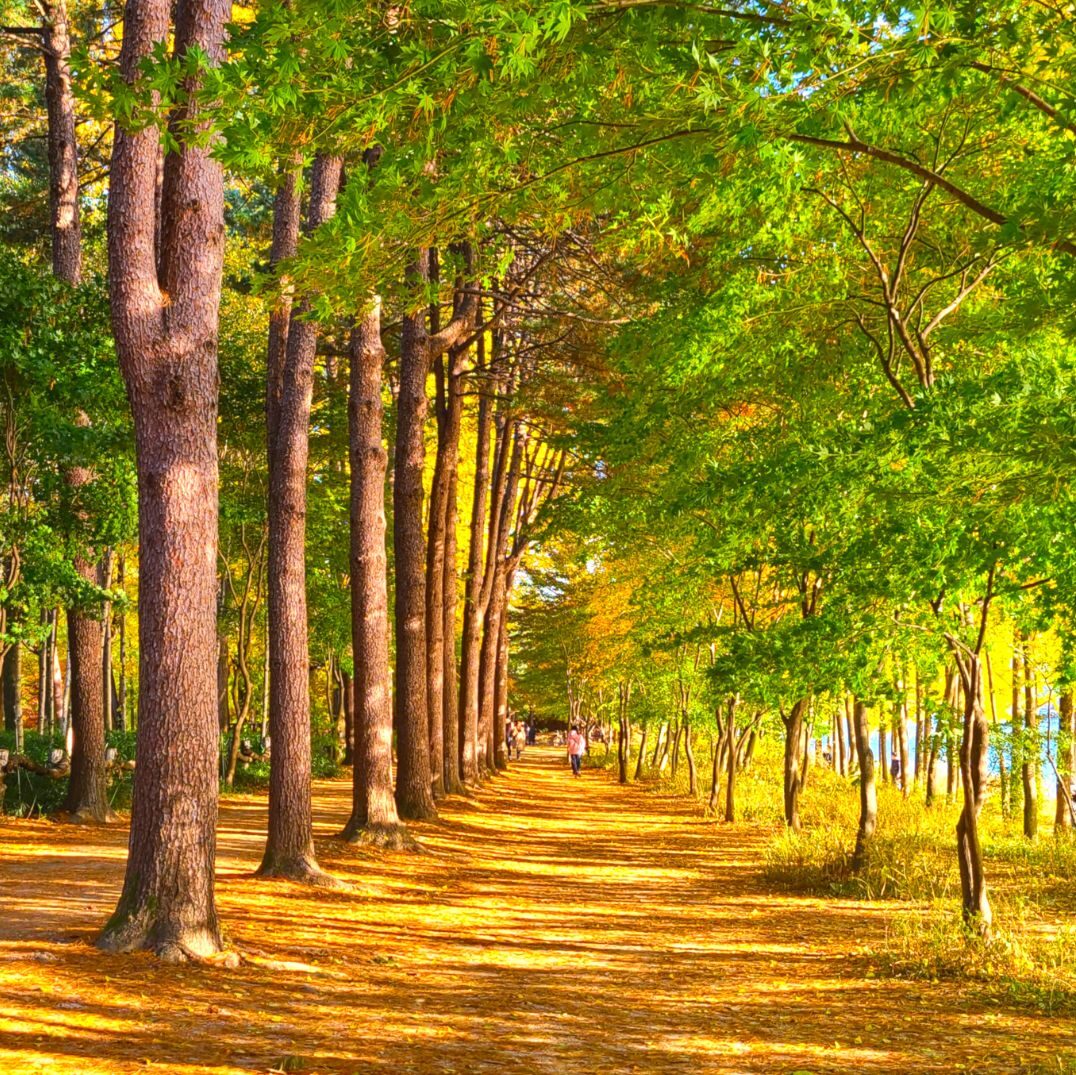
Afternoon : Zip line or sail over to Nami Island for impressive nature, bike rides, leafy walks, and cozy cafes. See popular scenes from K-dramas and even some wild animals, like deer and rabbits.
Evening : Pedal your way along an abandoned railway at the Gangchon Rail Bike Park before heading back to Seoul for fine dining in Gangnam’s Apgujeong Rodeo district.
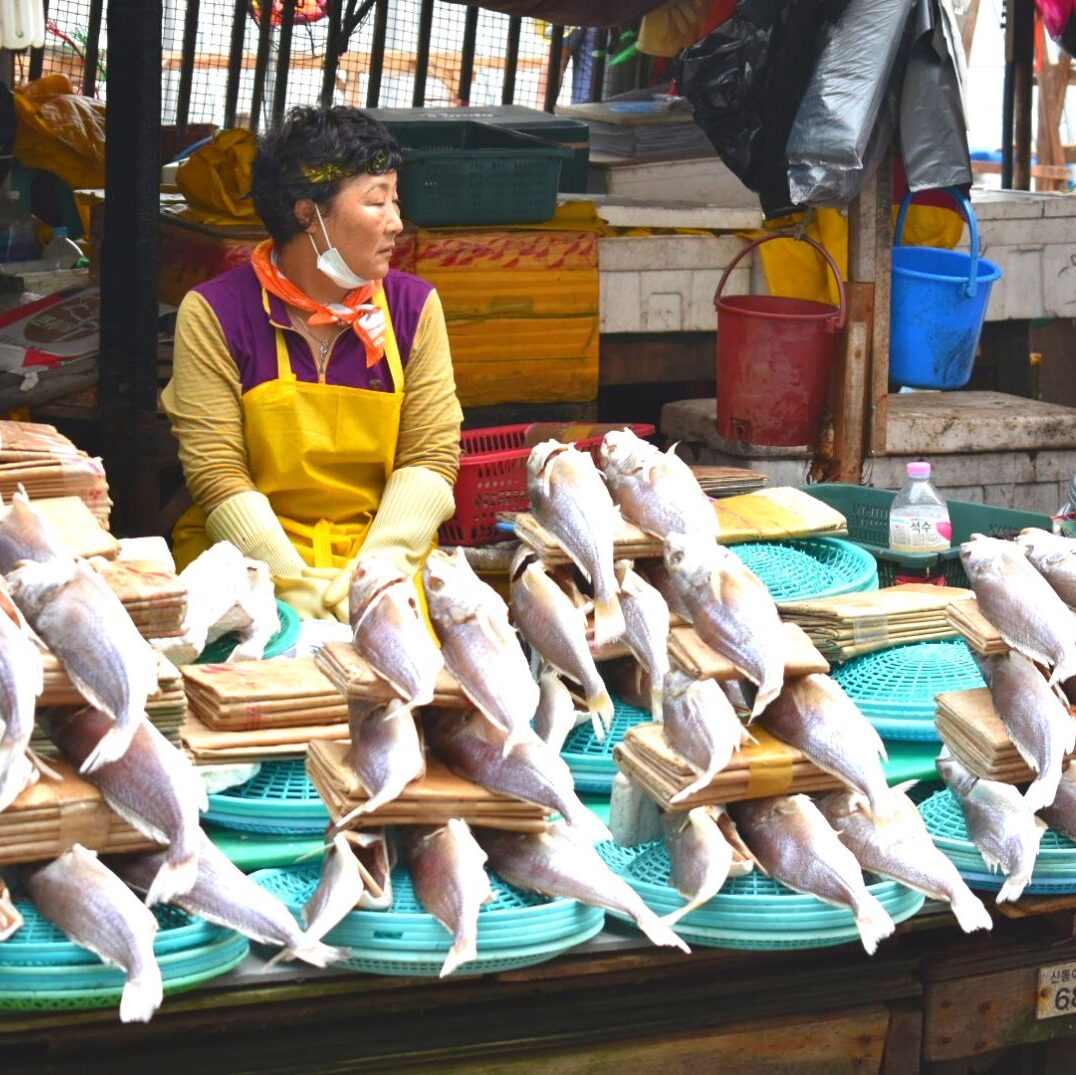
Afternoon : Head to the Nampo-dong near Busan Station and visit Jagalchi Market for a fresh seafood lunch. Then explore cosy Bosu-dong Book Alley or take a taxi to the Huinnyeoul Culture Village.
Evening : Take the subway up to Haeundae Beach for Busan’s best night-scenes. Grab dinner overlooking the beach, or at one of the market stalls. If you’re feeling brave, visit BUSAN X the SKY to see breathtaking views over the coast and city.

Afternoon : Head to the Gyeongju Gyochon Traditional Village for a traditional meal and to see the stunning Woljeonggyo Bridge. Gyeongju National Museum is nearby, too.
Evening : See the tranquil night views of Wolji Pond where palace buildings reflect perfectly in still waters. Stop at Hwangnidan-gil area for dinner and drinks before returning to Busan.
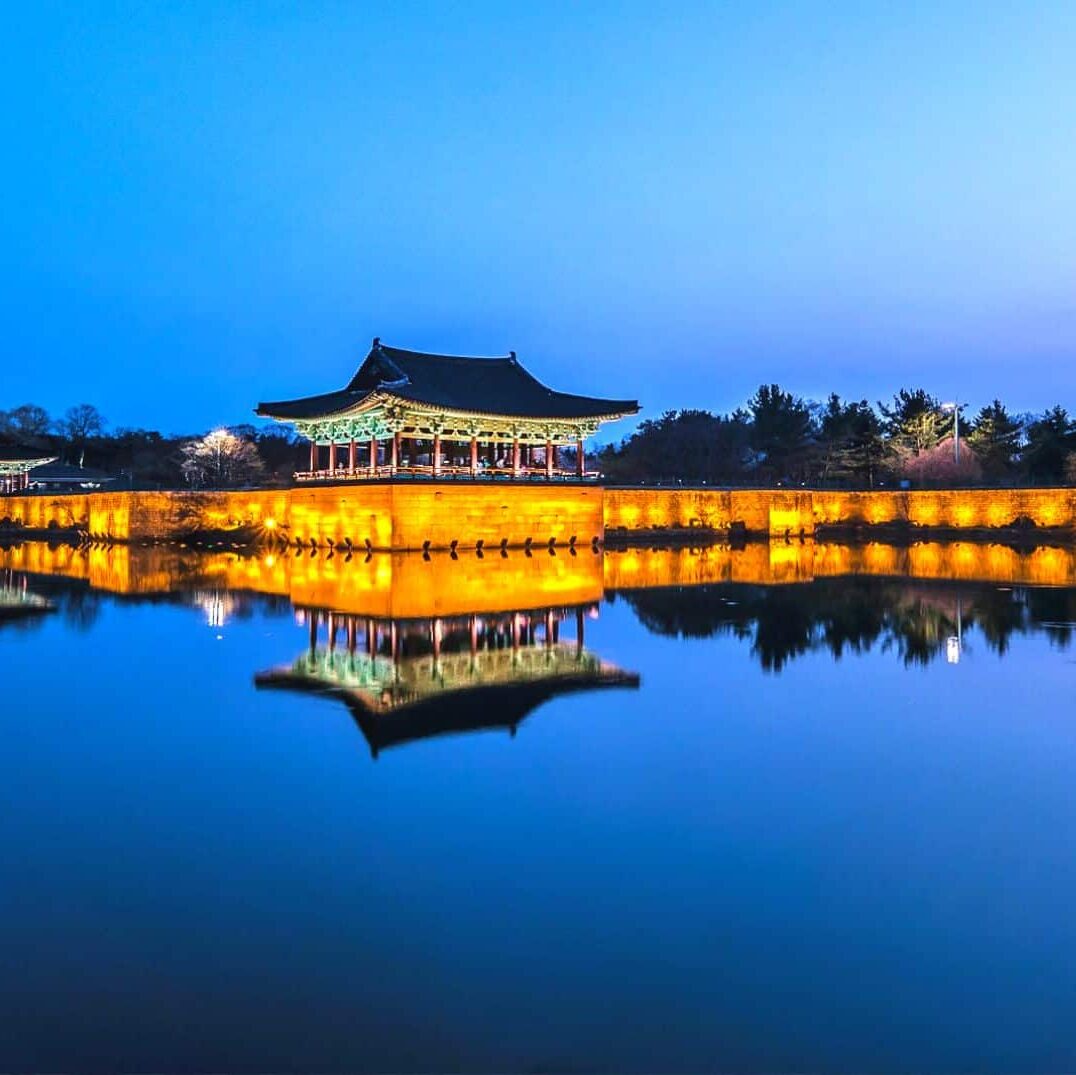
Afternoon : Explore the artistic shopping streets of Hongdae for last minute souvenirs and gifts for yourself. Take a break in one of the unique animal or artsy cafes.
Evening : Either take a night cruise along the Han River from Yeouido Hangang Park or dine in style at the Lotte World Tower in Jamsil, the world’s 6th tallest building. Both offer great night views of Seoul and unforgettable memories to take home.

Korean Seasons Guide
The best time to visit South Korea is during the warm spring or fall seasons. The weather is mild and clear, there’s a range of festivals and seasonal activities to enjoy, and you can travel to Korea comfortably.
The best months to visit are April, May, September, and October. These months are all during the Korean school semester, so there won’t be as many local travelers around during the weekdays. However, expect the weekends to be busy as people leave the cities to travel within Korea.
Large public holidays, including Chuseok (mid-autumn festival) in September / October) and Buddha’s Birthday (May), provides travelers with the opportunity to experience Korean culture and celebrations. These holidays change each year based on the lunar calendar.
Korean Weather & Climate
South Korea is a country that experiences four very distinct seasons, with temperatures ranging from 100 Fahrenheit in the summer to below 0 Fahrenheit in the winter . Each of South Korea’s seasons brings opportunities to see unique natural views and enjoy the different climates in Korea.
Spring has some of the gentlest weather, with light rain and a quick jump in temperature to the 60s and 70s by late March. Summer begins with the rainy season in late June and becomes extremely humid and hot throughout July and August before cooling again in September.
Fall has the best weather in Korea, with many warm, sunny days. Cold winter weather appears very quickly in mid-November and the first snow usually appears by late November. Winter is dry and sunny with the lowest chance of rainfall but is also very cold. Snow isn’t constant, but can fall for several weeks on and off during winter.
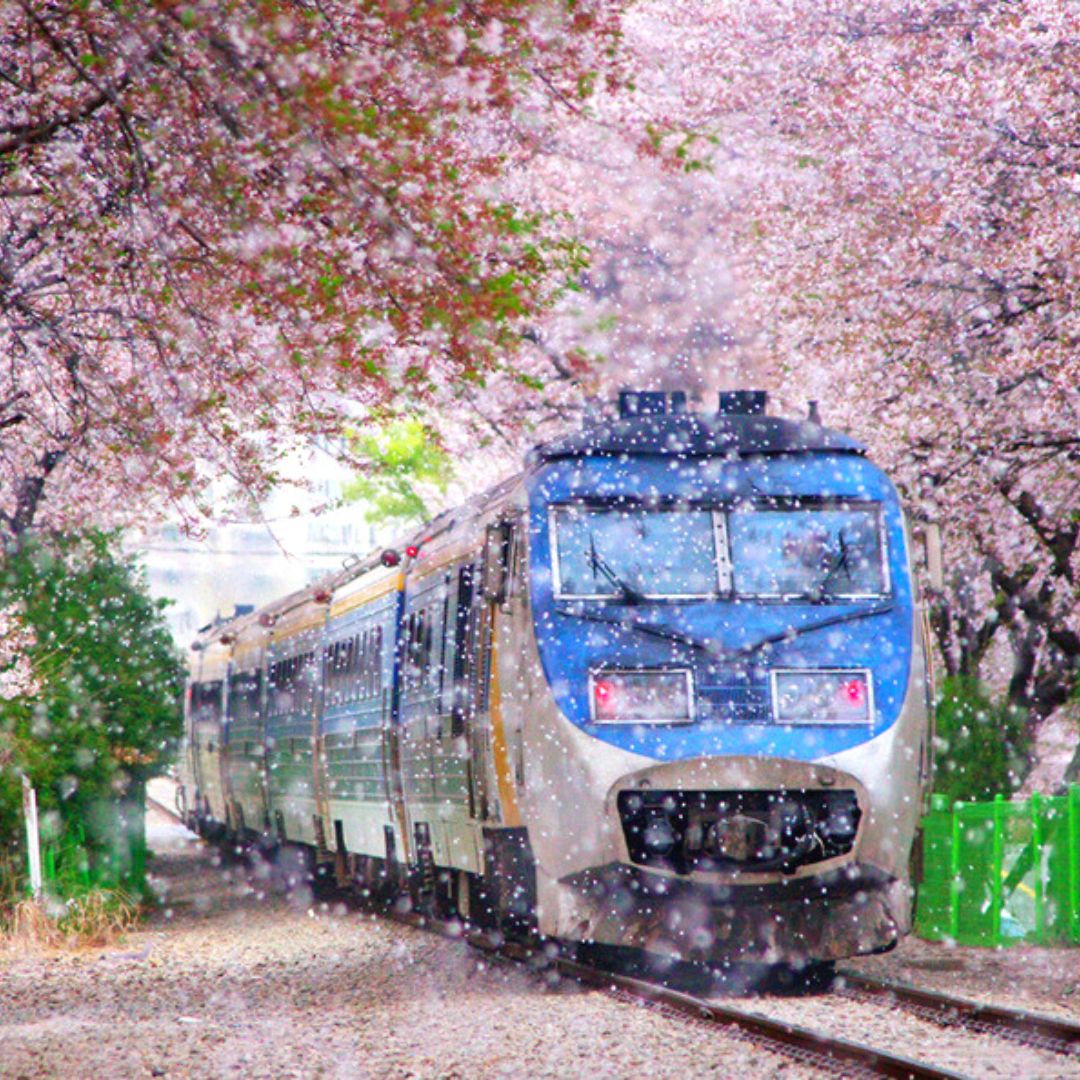
Visiting in spring offers the chance to see beautiful cherry blossoms stretch across the country, as well as many other spring flowers that brighten up Korea after a cold winter.
Spring starts in late March with the awakening of the cherry blossoms and ends in early June with the start of the rainy season. South Korea is a country with a close connection to nature, which can be witnessed in the many spring festivals and celebrations that happen throughout the year.
Some of the best spring festivals include the Jinhae Cherry Blossom Festival, Damyang Bamboo Forest Festival, Yeon Deung Hoe Lotus Lantern Festival, Jindo Sea Parting Festival, and Boseong Green Tea Plantation Festival.

The weather in summer is perfect for getting outside and relaxing on one of Korea’s many beaches. Some of the best activities include spending a weekend camping or glamping by the beach, hiking in shaded valleys in the national parks, and water sports such as surfing, kayaking, and scuba diving.
Unfortunately, the heat may put off some travelers, and high humidity makes it uncomfortable to move around too much. Fortunately, Korea is a modern country with lots of air-conditioning and ways to deal with the hot weather, including delicious summer dishes.
Cool down with a bowl of Korean bingsu (shaved ice dessert) or a cool latte in one of the many cozy Korean cafes in popular beach destinations.

Travelers to Korea in the fall are treated to spectacular fall foliage creeping far and wide. You can see it falling on palace grounds, sprawled on mountains in national parks, and along city streets.
The start of the fall foliage season in Korea coincides with the end of the hot and humid summer, with clear skies and cool weather, making it the perfect time to travel in Korea. Like spring, the fall season in Korea is one of the festivals and celebrations.
The Chuseok holidays in late September / early October are the biggest public holidays of the year, with cultural events held in popular tourist destinations. There’s also a range of cultural festivals, such as the Andong Mask Festival, Baekje Culture Festival, Jinju Namdang Yudeung Lantern Festival, Jeonju Bibimbap Festival, and the Seoul Kimchi Festival.

Winter, like summer, has more extreme weather than spring and fall, with temperatures often in the 20s and 30s and below. This season, however, is also one of the best for travelers who want to see clear, blue skies and experience good weather.
Winter is the driest season and it very rarely rains. If you don’t mind the cold weather, it’s perfect for traveling around South Korea. One of the biggest draws during winter is the chance to see snowy Korean landscapes, from snow-bedecked royal palaces to frosty peaks atop Korea’s many mountains.
Winter sports are popular in Korea, with ski and snowboard resorts aplenty. Winter also offers the chance for family fun with winter attractions including sledding, winter illuminations, and Christmas parades.

Cost To Travel To Korea
The cost to travel in South Korea largely depends on your personal style of travel. You can travel on a low budget in Korea, for under $50 per day, or you could also travel for 10 times that amount if you wished to.
Food costs range from a few dollars for a bowl of jajang (black soybean) noodles to hundreds for premium hanwoo (Korean beef) steak. The same applies to accommodation, with budget hostels costing $10 per night and premium 5 stars hotels costing hundreds.
Most travelers to Korea will already know what they want to prioritize their spending on. Some travel to Korea to eat, others to shop, and many more to experience the unique culture and history that Korea has to offer.
The costs in this section of our South Korea Travel Guide are based on the latest costs in Korea from this year. Examples of different costs have been covered to give you an idea of what to expect when you try to budget.
Please note, these prices are based on traveling in Seoul during non-peak times. Prices may be higher in peak times, which include cherry blossom season (Apr) and fall foliage season (Oct). Popular tourist cities, such as Gyeongju and Jeonju, may also have higher prices on weekends.
How Much Does It Cost To Travel In South Korea?
Travelers may find they want to spend more on hotels and less on eating out, or vice-versa, so don’t feel like you have to only follow the costs for one section. This is only a guideline to help you plan based on your own personal preferences.
To make it easier to figure out your expected costs to travel in Korea, this South Korea Travel Guide has broken down the costs into 3 different categories. These categories loosely fit 3 different types of travelers, as described below:
- Accommodation: $200+ per night, per room (double)
Korea has a wide range of luxurious hotel options, including rooms in the Lotte World Tower, historic hanok houses, and glamping for those who want to escape to the countryside.
- Food & Drink: $100+ per day, per person
It’s easy to spend a lot on food and drink in Korea as there are so many delectable restaurants. Fresh seafood, Korean steak, or the finest foreign foods are all available.
- Transportation: $20+ per day, per person
Taxis and transportation are relatively cheap in Korea. A taxi journey across Seoul can cost less than $20 for 30 minutes and even the 1st class options on Korea’s high-speed trains are under $100 for the longest journey (Seoul to Busan).
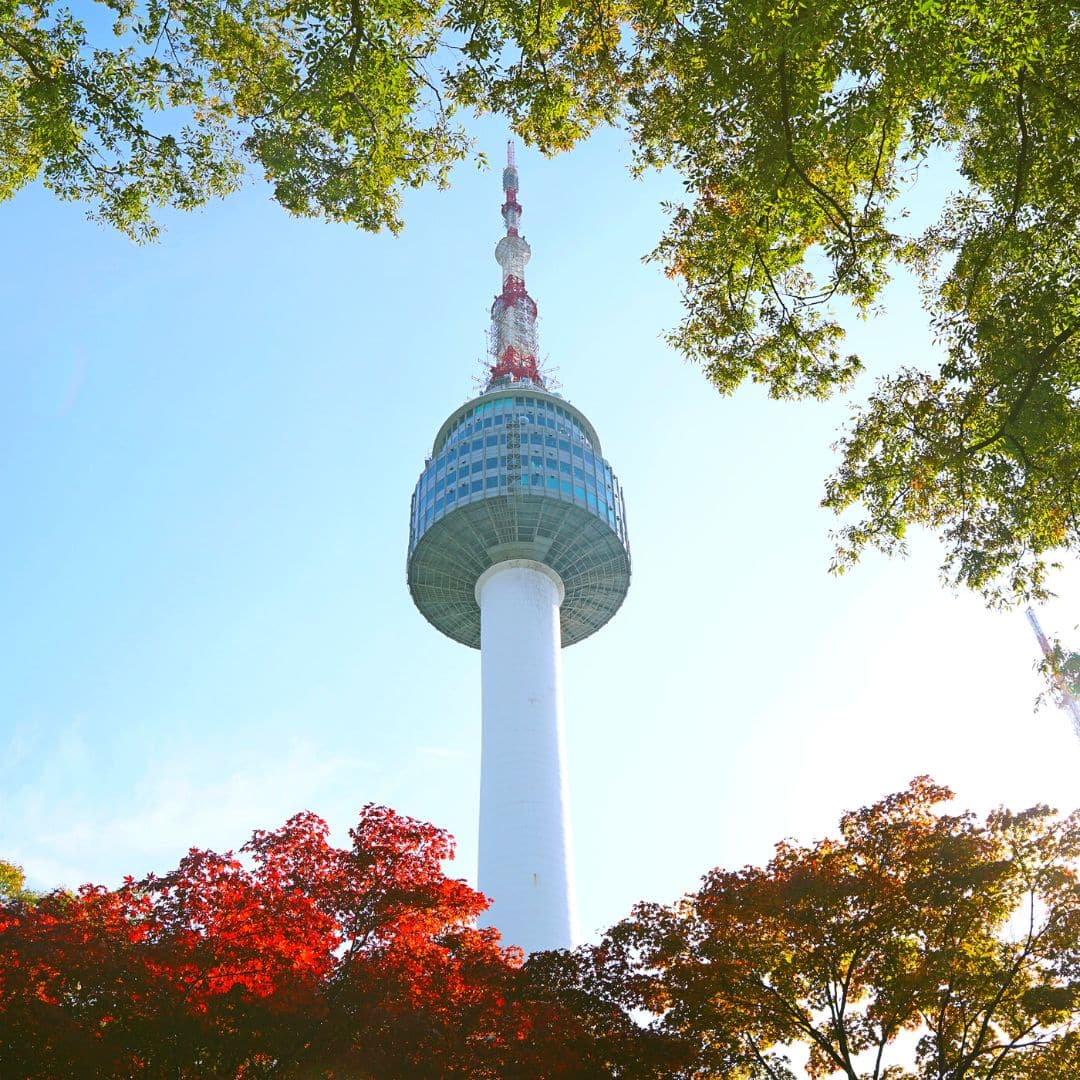
- Accommodation: $100 ~ $200 per night, per room (double)
You can book 4-star hotels in Seoul for very reasonable prices and enjoy both comfort and lower prices than you’d find at home. Korea has a wide range of comfortable mid-priced hotels.
- Food & Drink: $50+ per day, per person
With all-you-can-eat Korean restaurants that serve unlimited Korean BBQ and other dishes for under $20 or $30 per person, it’s easy to enjoy the best food Korea has to offer without breaking the bank.
- Transportation: up to $15 per day, per person
Use the subway and buses to get around the big cities and trains to travel further around Korea without breaking the bank. You can even splash out on a taxi and pay only a few dollars per person when traveling as a group for a few dollars extra.
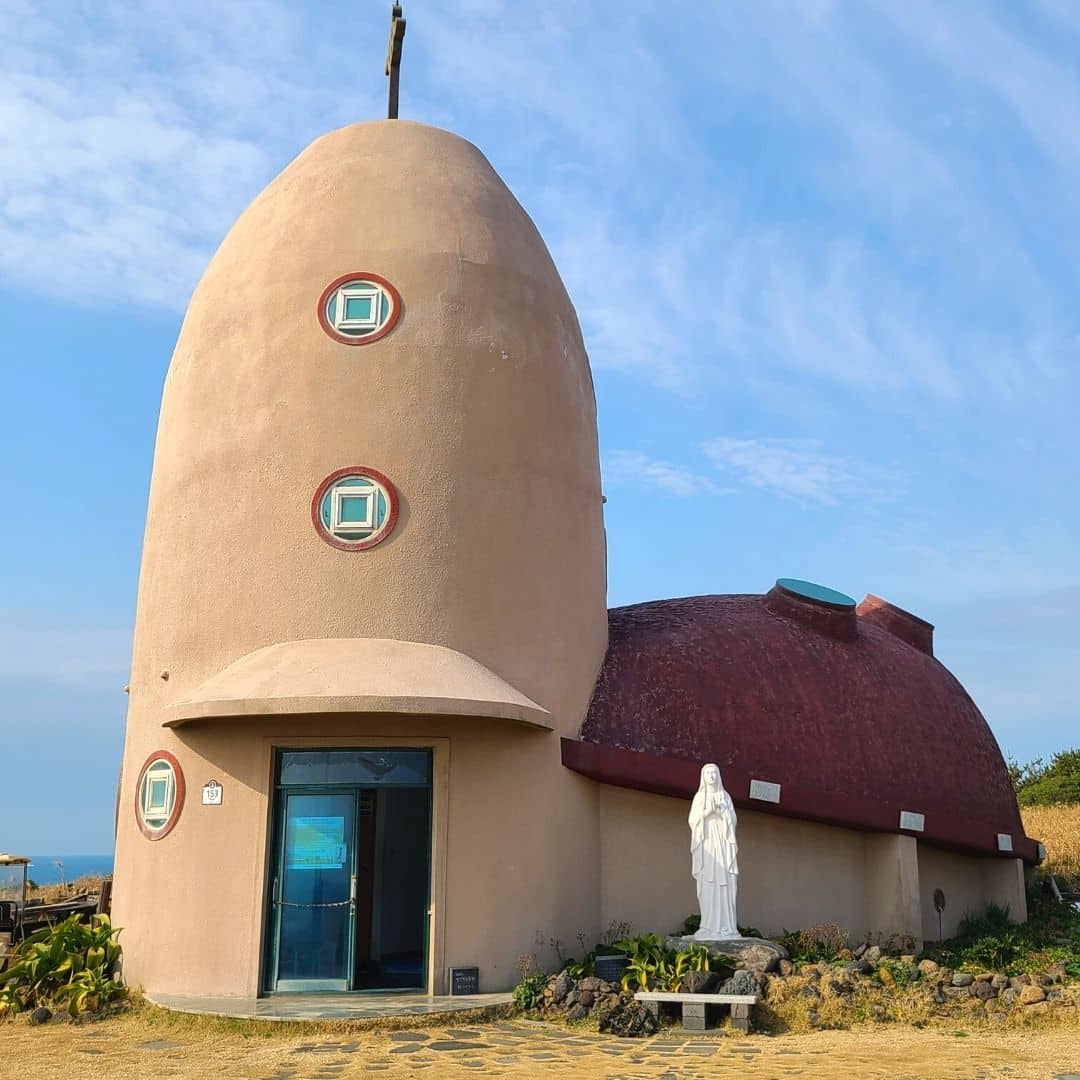
- Accommodation: up to $100 per night, per room (double)
Hostels and guesthouses can be found for under $50 per night and are perfect for somewhere to rest and recharge. If that’s all you need, save money here and spend it elsewhere.
- Food & Drink: $20 – $30 per day, per person
If you budget well and stick to street food, free hotel breakfasts, and convenience store foods, you can eat well and still have enough to splurge on good food for dinner.
- Transportation: up to $10 per day, per person
Walking and buses are cheap and convenient ways to travel around Korea’s biggest cities. Traveling from city to city is also cheap, with intercity buses costing less than $10 for 1-2 hour journeys.

Further Costs To Travel In South Korea
Besides these everyday costs to travel in South Korea, there are other costs that you’ll need to cover from time to time. These costs include internet & phone access, day trips, activities, souvenirs, travel insurance, and flights. These costs will be broken down into low and high-end costs that you can expect to pay in Korea.

Museums and galleries offer unique (and authentic) Korean souvenirs such as pottery, painting, tea & soju sets, and more. If you want something a bit more special, head to the underground markets near Gwangjang Market in Seoul and get your own handmade hanbok, which you can get posted back home to save luggage space.
- Small Souvenirs: $5+
- Korean Cosmetics: $5+
- Korean Artworks: $10+
- Korean Tea (box of): $10 to $20
- Korean Soju Set: $10 to $20
- Korean Handcrafts: $10+
- Tailored Hanbok: $200+
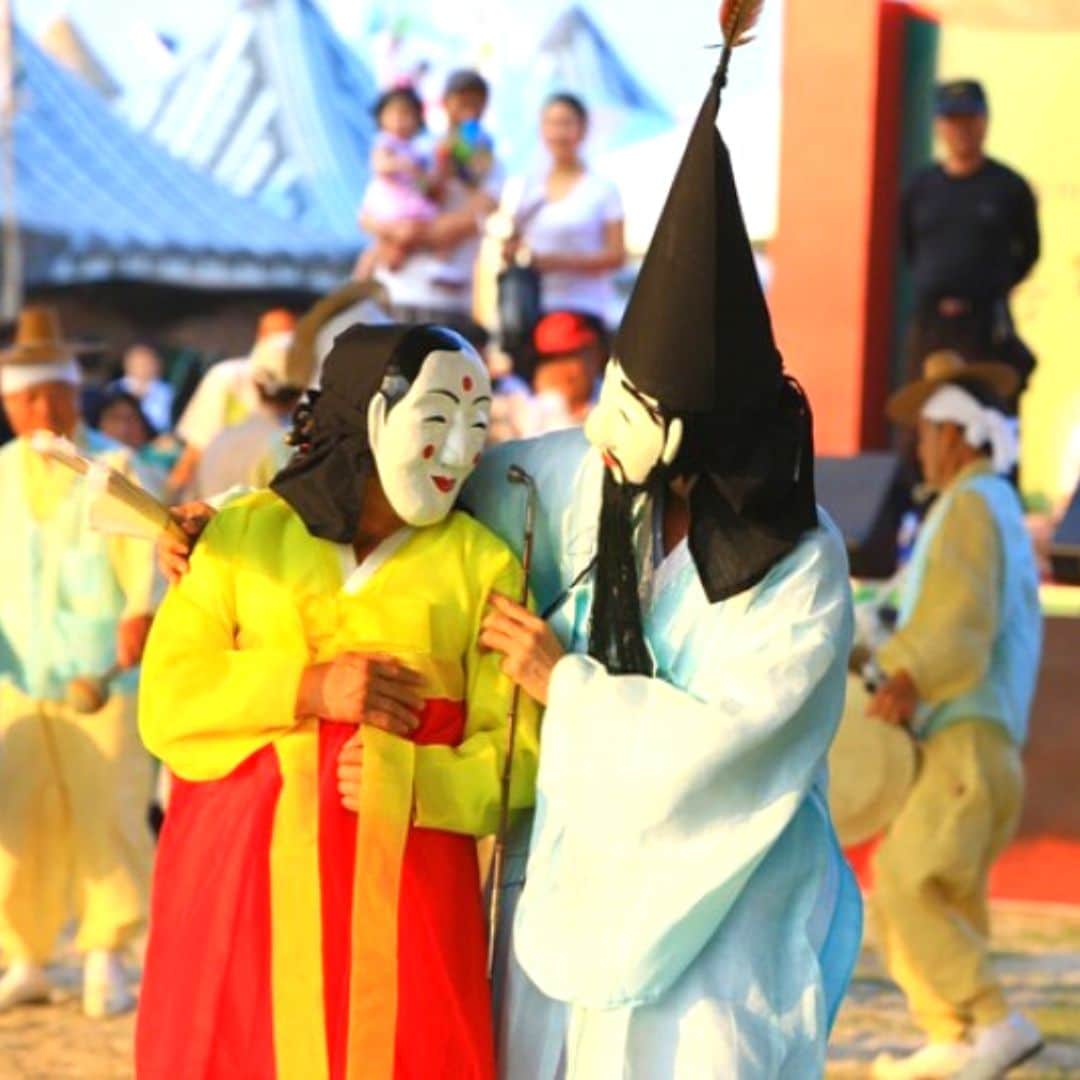
The day trip prices quoted below are the prices you can expect to pay with a reputable tour company like Klook or Trazy . Hiring a private guide will be a lot more expensive and might come to $200+ per day.
Please note: The prices quoted below are estimates and may change depending on the season or tour services.
- DMZ Tour – $50 to $120
- Nami Island Area – $40 to $70
- Everland Theme Park – $30 to $50
- Jeonju Hanok Village – $50 to $70
- Korean Folk Village – $50 to $60
- Seoraksan Mountain – $70 to $150
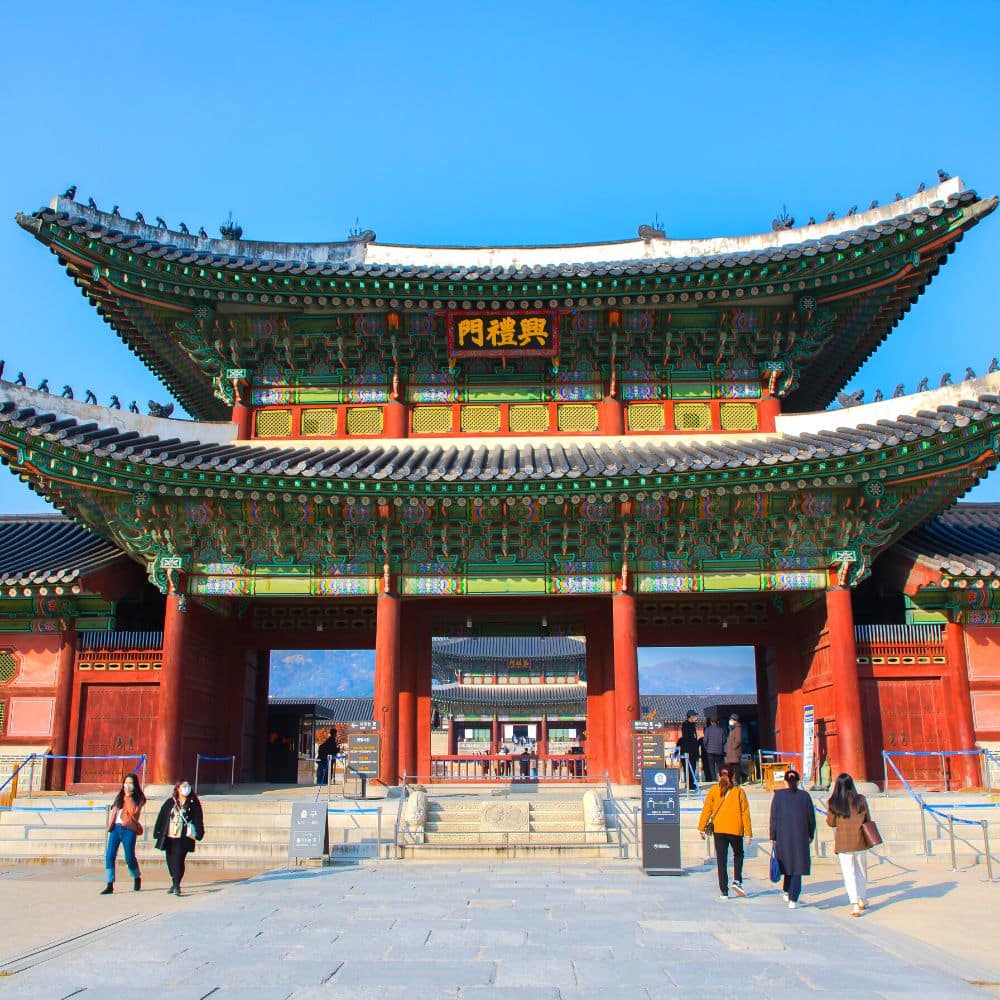
As mentioned earlier in this South Korea Travel Guide, buying a Discover Seoul Pass is a great way to save money on Seoul’s premium attractions.
- Royal Palaces – $3
- N Seoul Tower – $10
- Hanbok Rental – $10+
- Seoul City Tour Bus – $10
- Han River Cruise – $15 to $30
- Seoul Sky Observatory – $30 to $50
- Aquariums – $20 to $30
- Seoul Zoo & Seoul Grand Park $10
- Amusement Parks – $30 to $40
Flight costs depend on which airports you’re traveling from. A flight from Los Angeles to Incheon Airport (Korea’s main airport) costs around $1400 right now. Flight costs vary depending on the season and time of day.
Best of Korea recommends Skyscanner and Expedia for the best flight deals to Korea.

Why Travel To South Korea?
In recent years, travelers from around the world have been increasingly drawn to South Korea. The country is a must-see destination in Asia, with more than 17 million travelers in 2019. After reading this South Korea Travel Guide, you’ll understand what draws so many people to the Land of The Morning Calm, as Korea is also known.
There are myriad reasons why people visit Korea. Many come to experience life in a unique country, packed with historical and cultural sights that you won’t find elsewhere in the world. In the afternoon you can walk through a royal palace dressed in hanbok (traditional Korean clothes), sip green tea in a hanok (traditional Korean house), and pass Buddhist monks walking peacefully through an ancient temple.
Modern South Korean culture is conquering the world, with chart-topping acts that include BTS and Black Pink, Oscar-winning movies like Parasite, and phenomenally successful TV shows like Squid Game. This brings in legions of fans flocking to shooting locations and film sets to relive their favorite K-Culture moments. Some lucky travelers even get to catch sight of their favorite K-Stars walking around Gangnam, a hotspot for Korea’s most famous citizens.
Not only is Korea a beautiful country, it’s a country that will make you beautiful, with some of the world’s best fashion and beauty shops. Korea is famous for its K-Beauty products and is a beauty and fashion shoppers paradise. From the street fashions of Hongdae, to the luxurious fashion malls of Gangnam, and the wall-to-wall malls with discount clothes in Dongdaemun, you’re guaranteed to find something you can’t resist at a great price. If you prefer a cultural shopping experience, there are traditional markets all over Korea, where you can experience street food, buy novel gifts, and see how locals live and socialize.
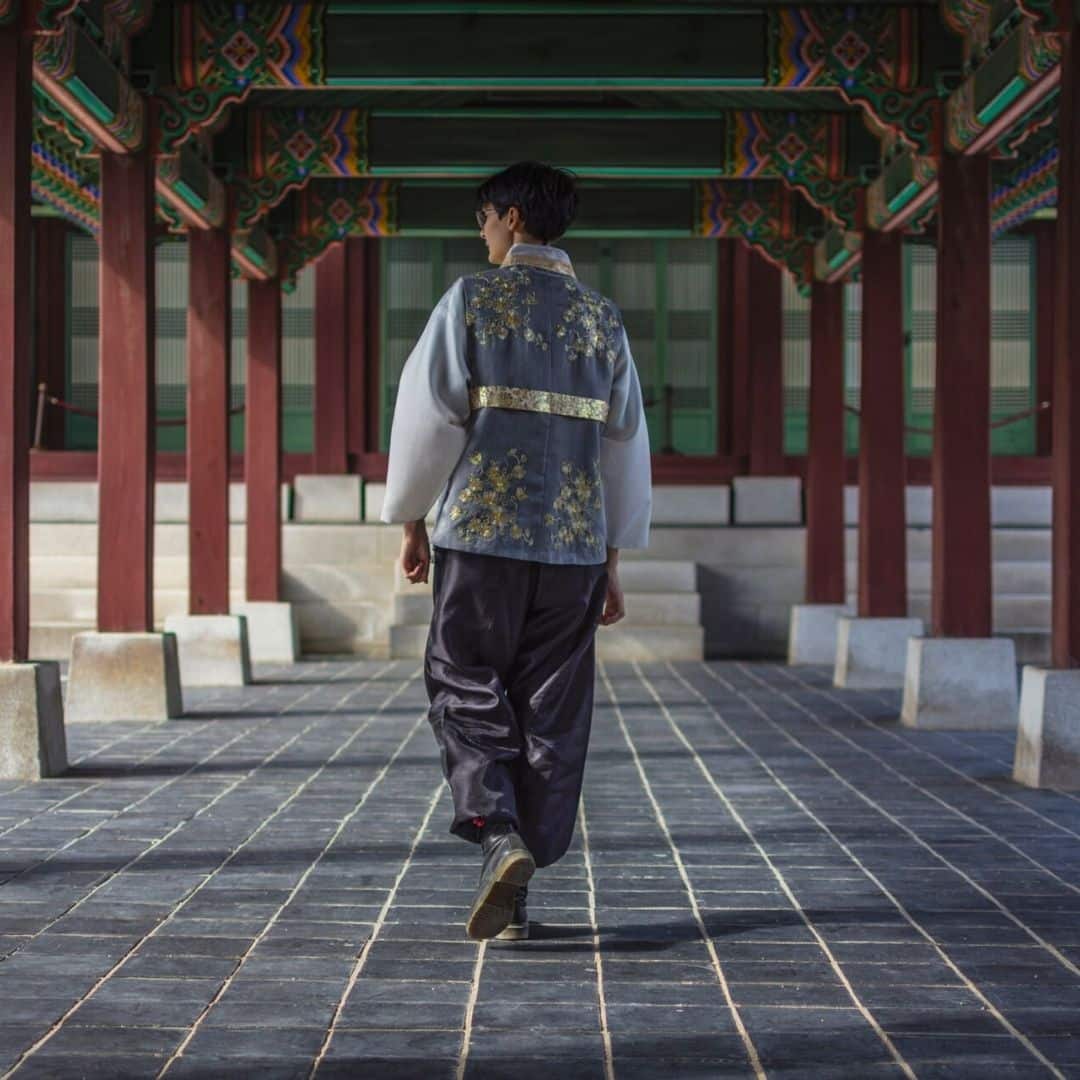
There’s so much more to South Korea than what you’ll find in the cities, however. South Korea, a country that’s 70% mountainous with coasts on three sides, offers so much to nature and adventure lovers. Hiking , South Korea’s national pastime, is a popular way to see more of the Korean countryside, looking down over rice fields, forested valleys, and pockets of urbanization. Skydiving, parasailing, scuba diving, water sports, cycling, rock climbing, white water rafting, and lots more are on offer and very reasonably priced. South Korea is a great place to enjoy the great outdoors.
The real jewel in South Korea’s natural crown, however, has to be Jeju Island – one of the New 7 Wonders of the Natural World. Explore lava caves, hike to the peak of the central dormant volcano (Hallasan Mountain), trek around the rugged coast, relax on a sandy beach in a modern cafe, and even try your hand at horse riding.
Whatever your reason to travel to South Korea, you’re sure to find more and more reasons to return again and again. Let this South Korea Travel Guide whet your appetite for your first trip, inspire you to plan a follow-up trip, and guide you to the best things to see and do in South Korea.
South Korea Travel Guide FAQs
Not sure about the South Korea travel restrictions and want to know more about visas, vaccinations, and what the rules are? This next section covers some of the most frequently asked questions about traveling to Korea now. If you have more questions that aren’t covered below, feel free to write to us on the Best of Korea Facebook page.
Do I need a visa to travel to South Korea?
US citizens and tourists from 111 other countries, including Canada and Mexico, don’t need a visa to travel to South Korea. The US government and South Korea have a visa-free travel arrangement and tourists can stay for up to 90 days.
What happens when I arrive in South Korea?
From May 2023 onwards, there are no forms to fill out as long as you have nothing to declare to customs. Travelers with nothing to declare can enjoy a hassle-free entry procedure by simply walking through the “Nothing to Declare” passage. Travelers who carry items that exceed the duty-free limit, foreign currency that exceed the value of US$10,000, or other items that require customs declaration must still fill out a declaration form and walk through the “Goods to Declare” passage.
Can I travel to Korea if I'm unvaccinated?
Yes, you can still travel to South Korea if you’re unvaccinated. South Korea no longer restricts travel based on vaccination status (as of October 2022).
LET'S GO TO KOREA
Best destinations in korea, where to stay in seoul, korean travel tips, things to see & do, travel itineraries for korea, korean season guide, cost to travel to korea, further costs to korea, why travel to korea now, south korea travel faqs, how to travel to korea.
Requirements To Travel To Korea
- For the best flight deals to South Korea, Best of Korea recommends Skyscanner and Expedia . You can find the cheapest prices and most convenient flights and buy the one that suits you best.
- For the best hotel prices in Seoul, Best of Korea recommends Klook 0r Agoda – they cover most hotels in Seoul and the rest of Korea and offer great prices without hidden fees.
- There are large differences in exchange rates so you will need to do some comparing before you exchange a large sum of money. You can exchange USD to KRW easily at banks or money exchange shops in all major tourist areas like central Seoul (Myeongdong and Namdaemun are good places but the Coex Center also offers money exchange. You can also negotiate the exchange rate with the vendor if you think it is too high.
- You can withdraw cash from bank ATMs. Alternatively, use a pre-paid travel card like the one offered by Wise , which allows ATM withdrawals and payments and works perfectly in Korea.
- Don’t forget to bring a travel adapter for your electronics and leave plenty of extra space in your suitcase for the many Korean souvenirs and goodies you’ll buy on your trip.
No, travelers from the USA don’t need a tourist visa to enter South Korea. You can visit for up to 90 days visa-free. However, you must apply for the K-ETA before traveling and upload your travel plans and hotel details.
Most COVID-19 rules in Korea have been dropped and now there are only 2 main rules to be aware of. First, face masks are mandatory when visiting medical facilities (hospitals). There is no longer a 7-day mandatory quarantine for people in South Korea. If you’re infected with COVID, the Korean government recommends a 5 day self-quarantine, but it’s not enforced. Travelers to Korea should follow the current restrictions or may be liable for fines or deportation.
Here are 6 of the best destinations in Korea that you absolutely must visit, as well as some of the sights you’ll want to check out while you’re there. We’ll be bringing you lots more detailed destination guides in the future, so be sure to visit again soon

This Full Day Tour of Seoul will show you some of the hottest spots in the city, while this Customized Private Tour of Seoul will allow you to choose where to go.

Winter is cold and dry and, ironically, a great time to visit Jeju Island. This semi-tropical island is warmer than the mainland, but still gets snow on the mighty Hallasan Mountain. You can sit on a sunny beach one day and then hike knee-deep in snow the next. Jeju is also famous for its citrus, with thousands of tangerine trees dropping their juicy fruits in early winter.

Korean Travel Tips
Korea is a unique country with a written language that looks nothing like English, interesting Korean Cultural And Etiquette Rules , and an always busy lifestyle. Travelers may be lost trying to do even the simplest things.
These essential Korean travel tips have been crafted by experienced travelers who love to save time and money. Only the best quality services and products are recommended here.
If you’re traveling to Korea, you’re almost certainly going to want to get access to the internet to help you navigate, translate Korean, or even book tickets to attractions. Korea has one of the world’s best mobile internet and the prices are very reasonable. 5G mobile internet services are available across the country and Korea was one of the first to get the super-fast service. You won’t have problems connecting with a sim card or WiFi router when you travel
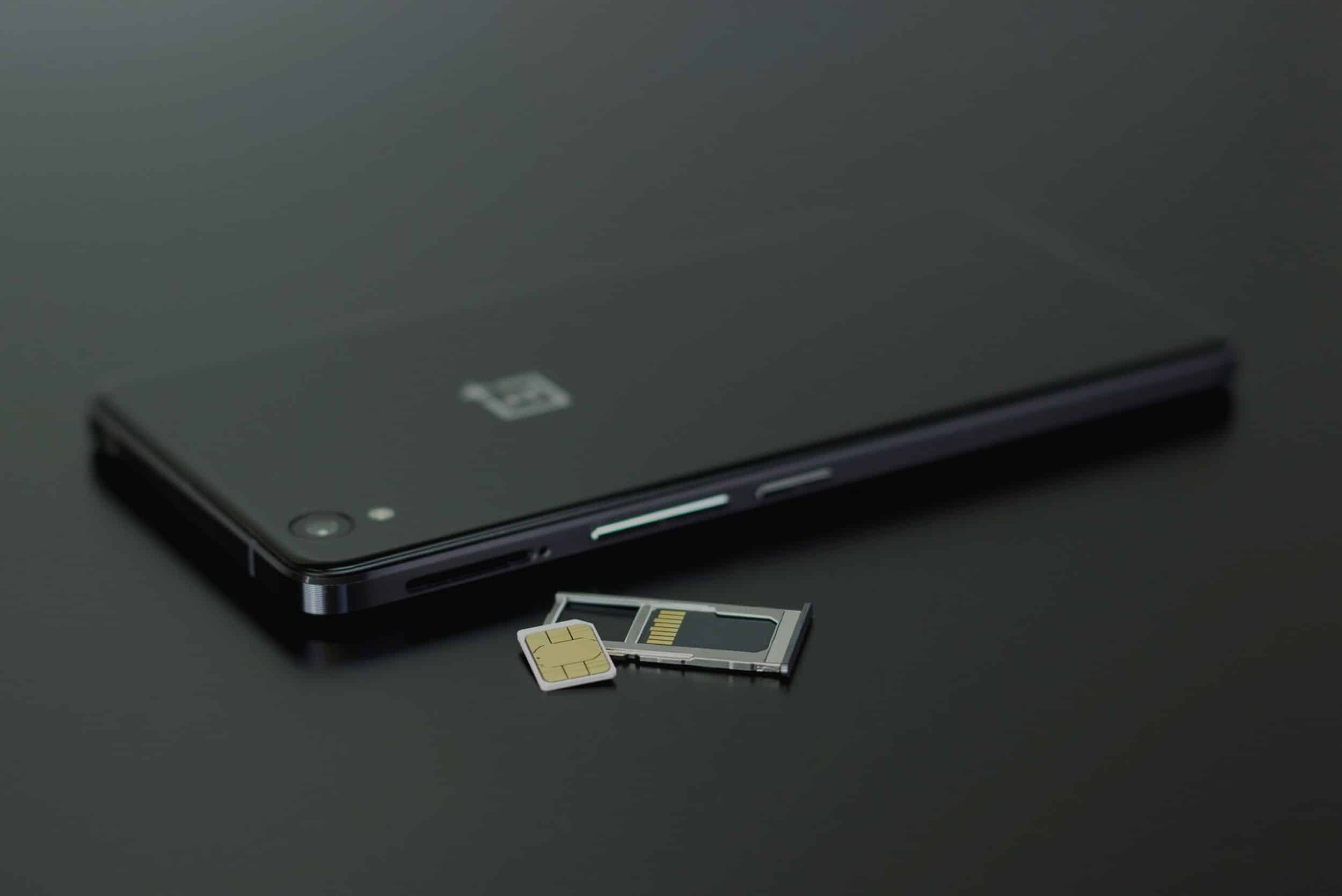
South Korea is a country packed with famous landmarks and sights, unique culture – modern & historical, family-fun activities, outdoor adventures, cozy cafe districts, and natural wonders. There’s more to do in Korea than you could imagine and it’s impossible to explore it all in one trip. Try to plan your itinerary by cities and locations. For example, plan your day in Seoul and stay by the district.
Here are some of the best things to see and do in South Korea, broken down into different themes so you can find things that interest you the most. The location of each of these attractions is included, too, so you can create a city-by-city itinerary, seeing the best South Korea has to offer.
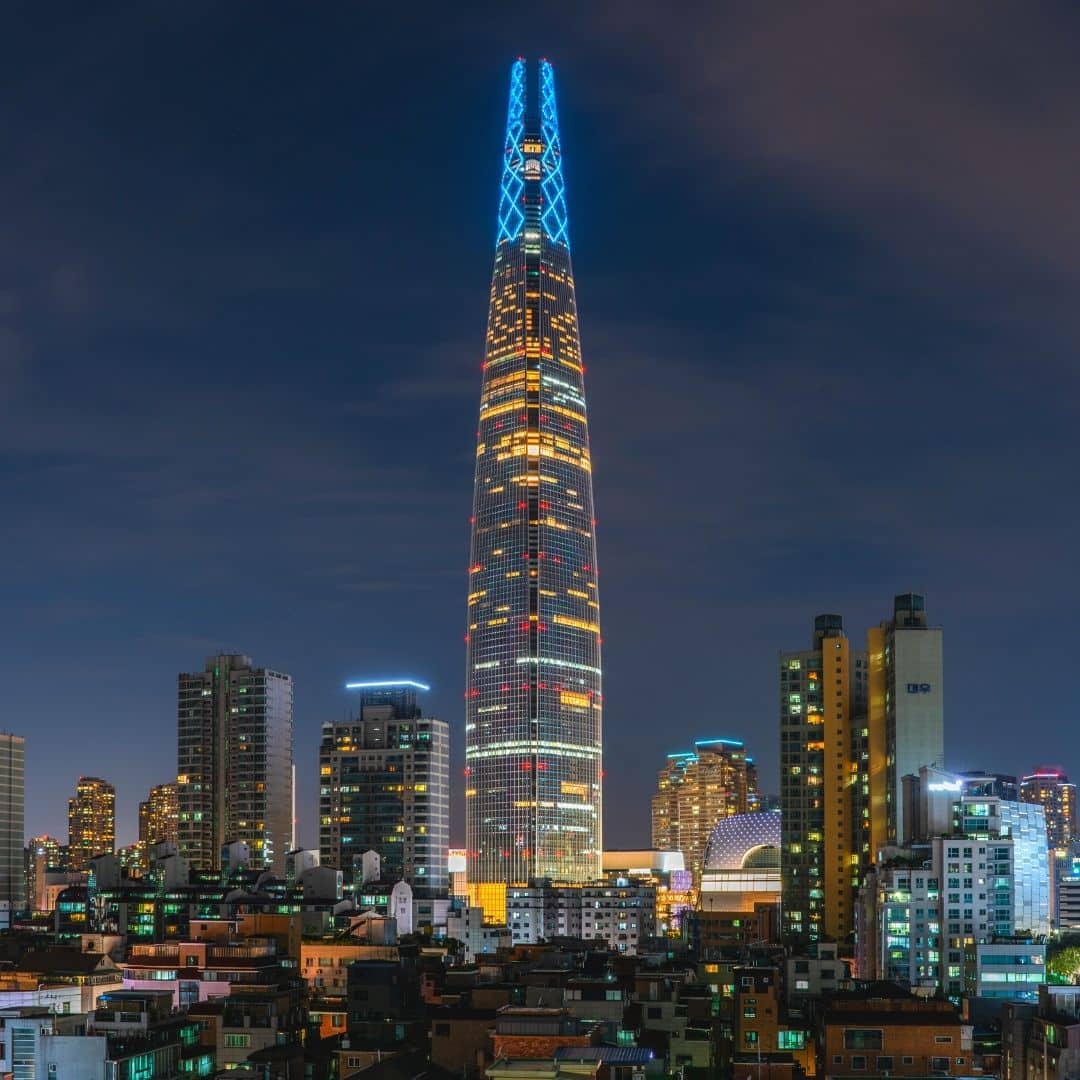
Any South Korea Travel Guide would be incomplete without thee top landmarks & famous areas in Korea. These unmissable Korean attractions offer some of the best sights in Korea, showing you Korean history, culture, design, and sense of humor.
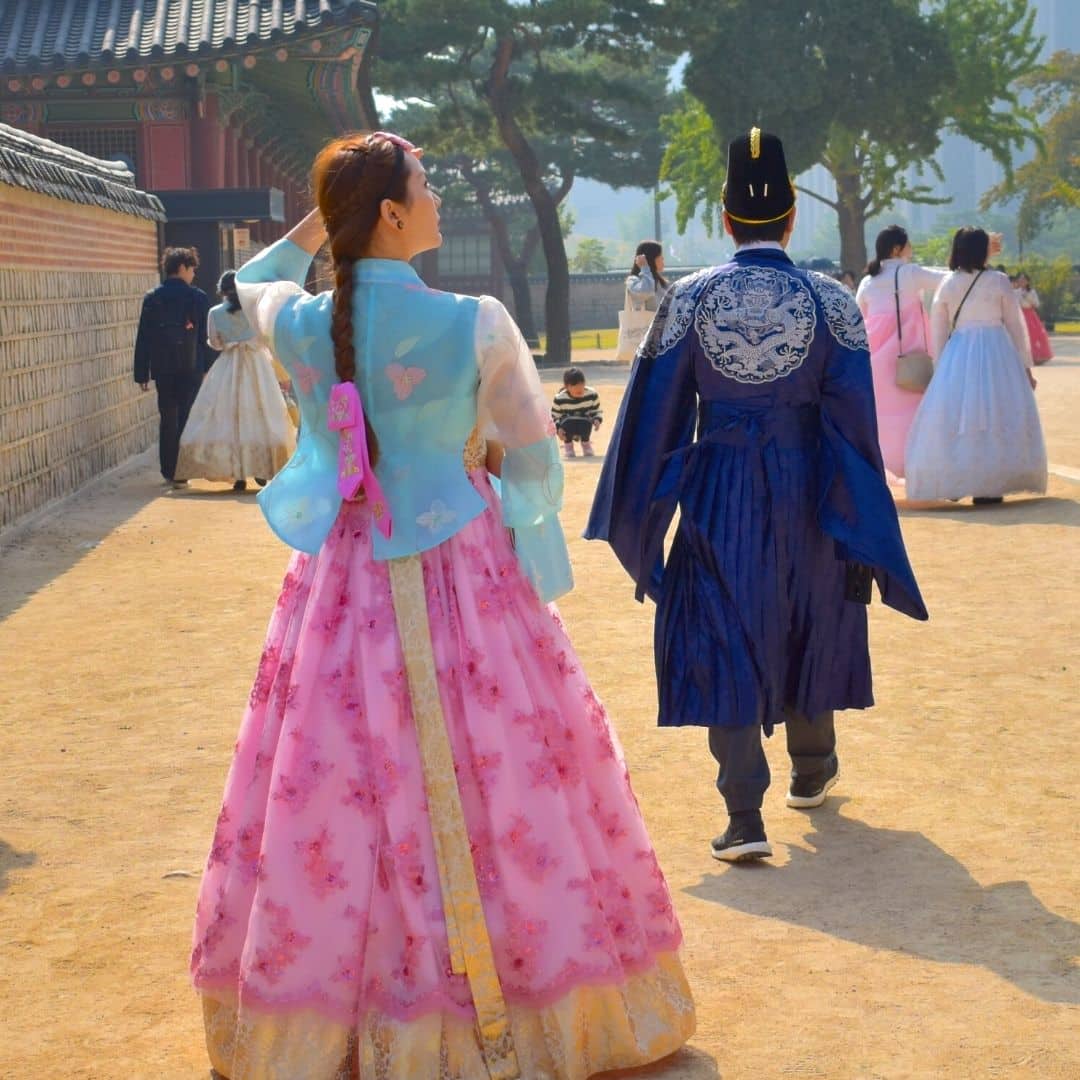
Learning about Korea’s past is not only enjoyable, it’ll also open your eyes to how modern Korean culture has evolved. Witness the majesty of grand palaces and the humble Buddhist temples and gain an insight into life in Korea with these fascination historical sights.

Are you a fan of Korean culture? Then check out these 10 modern K-Culture locations in Korea. Whether you’re ARMY or an arthouse cinema fan, you’ll love these sights. K-Drama fans, check out these K-Drama Filming Spots in Seoul .

If you’re traveling to Korea with your family, you don’t need to worry about the kids getting bored. There are plenty of family-fun attractions in Korea to keep them amused and to show them what Korea’s really like.

Culture lovers will find no shortage of places to learn about Korean, Asian, and world history & culture. Korea has a rich history and displays this through a range of museums. Learn about traditional life, Korean wars, the democracy struggles, and even kimchi .

Once a land of teahouses, Korea has now fully embraced coffee culture. Korea’s late-night culture makes cafes a great place to gather and chat. The rise of social media has also led to hundreds of insta-worthy cafes with photogenic decor, unusual coffee designs, and delicious desserts.

Many people travel to Korea just to shop, thanks to the low prices, haggling in the markets, and good quality items. From traditional markets to high-end designer goods, there’s somewhere to shop for everyone. Be sure to try authentic Korean street foods in the markets, too.

Korea is a country surrounded by sea on 3 sides and 70% mountainous, giving it a wealth of natural beauty. Besides Korean cherry blossoms , flowers, and fall foliage, there are sculpted gardens, shimmering ponds, riverside parks, and a volcano to see.

Morning : Explore Seoul’s historic royal palaces starting with Gyeongbokgung or Changdeokgung Palace in central Seoul. You get free entry if you’re wearing a Korean hanbok, so be sure to pick one up from the rental shops outside.
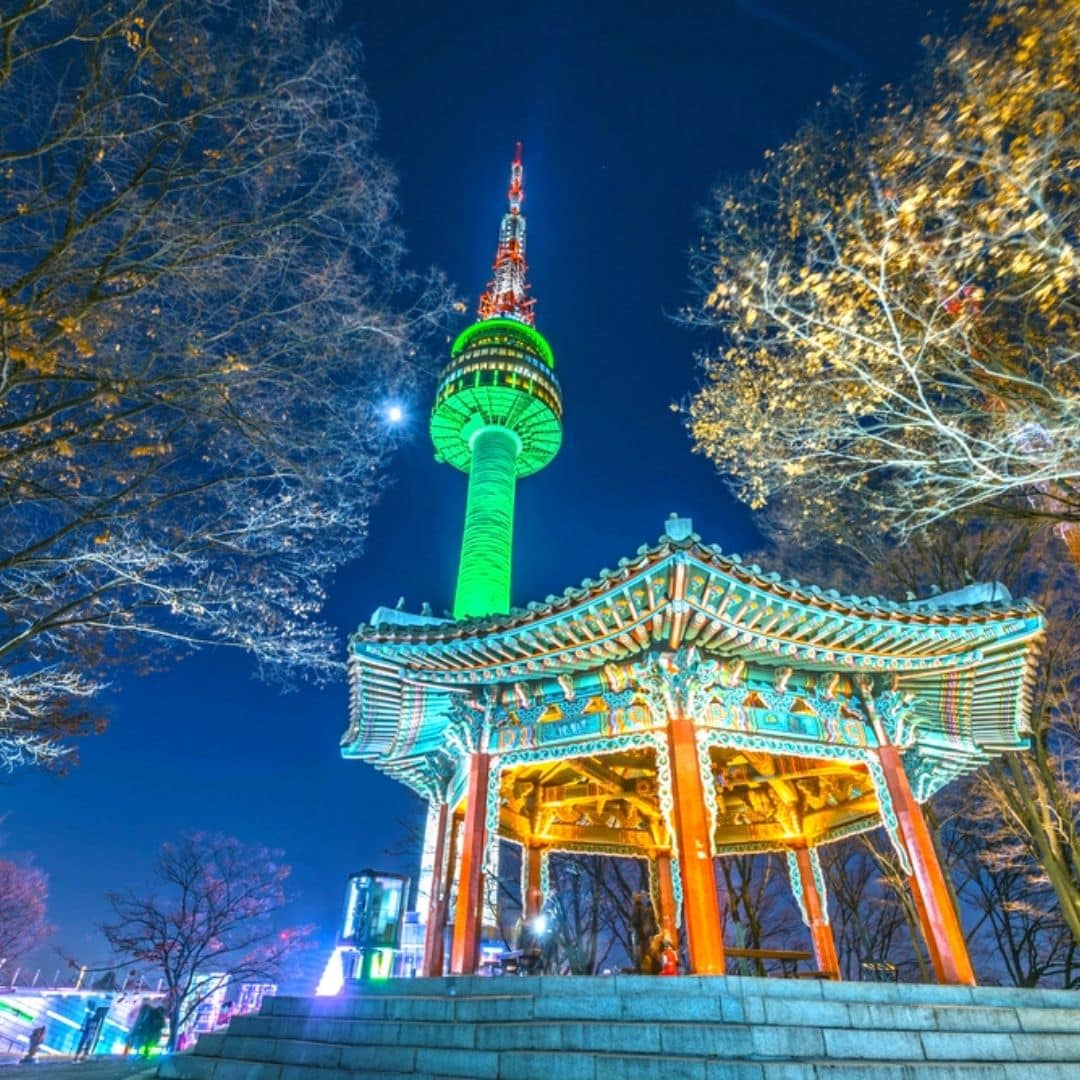
Morning : Learn about Korea’s history at the National Museum or War Memorial in Yeongsan. These fascinating museums have interactive exhibits and feature 1000’s of years of Korean history.

Morning : Take a day trip from Seoul to explore Gapyeong County. See the wonders of the Garden of Morning Calm and its idyllic nature. This is one of the most beautiful gardens in Korea.

Morning : Grab an early breakfast at Seoul Station and ride the high-speed KTX train directly to Seoul. It takes less than 4 hours and rides past rice fields, mountains, and the Korean countryside.

Morning : Take a day trip to the UNESCO World Heritage City of Gyeongju and roam the Gyeongju Historic Area. See Daereungwon Tomb Complex and Cheomseongdae Observatory.

Morning : Pack your bags and ride the KTX back to Seoul. Head to Hongdae for street food snacks or Michelin-starred delights in famous restaurants.
South Korea is a country that experiences four very distinct seasons, with temperatures ranging from 100 Fahrenheit in the summer to below 0 Fahrenheit in the winter. Each of South Korea’s seasons brings opportunities to see unique natural views and enjoy the different climates in Korea.

March to May

June To August

September to November

December to February
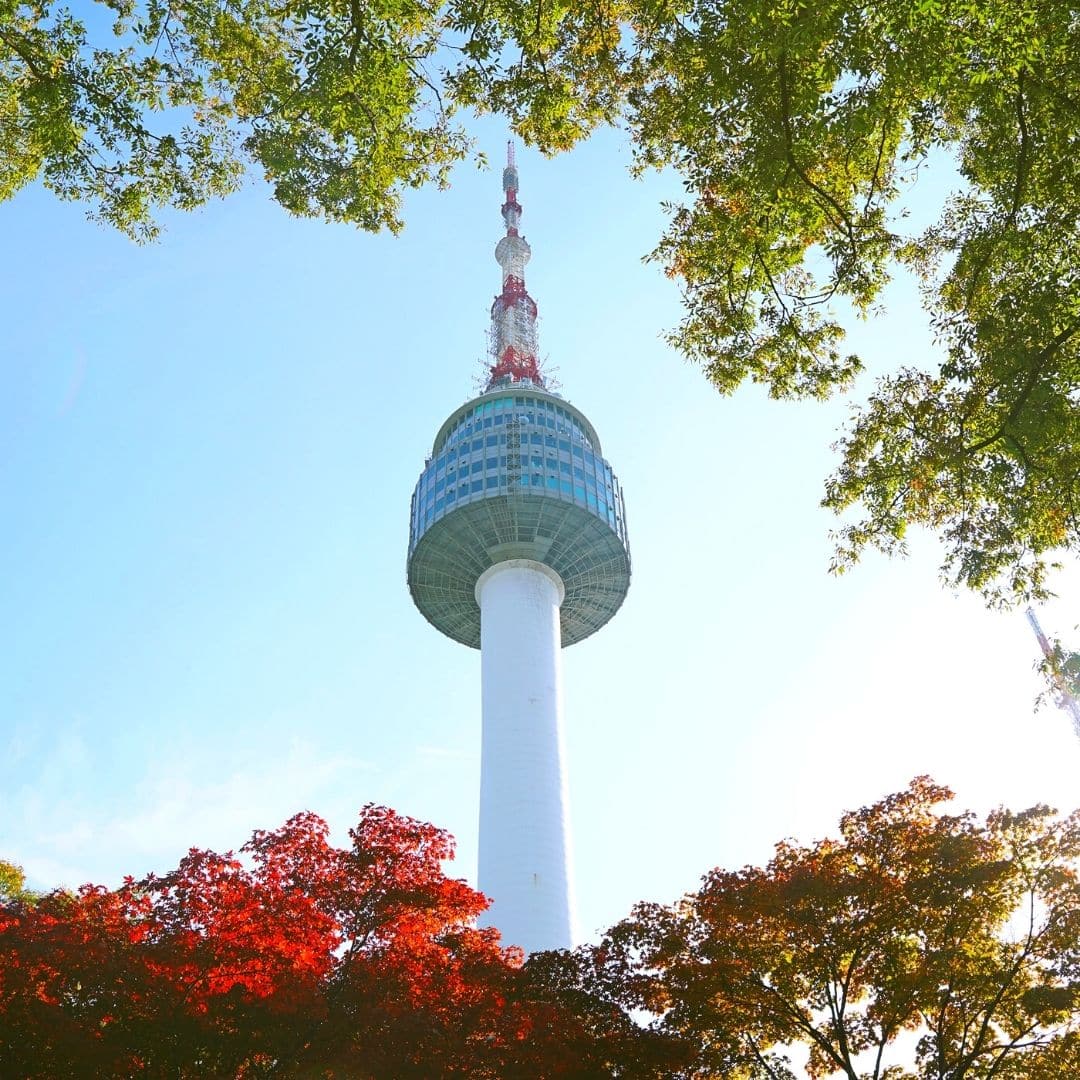
Korean Souvenir Costs
The best places to buy souvenirs in Korea are in the traditional markets and tourist areas. Insadong in Seoul has a lot of art and souvenir shops, as do the market streets around Bukchon Hanok Village. Hongdae offers lots of bargain snacks and souvenirs to take home.

Day Trip Costs From Seoul
A day trip from Seoul is a must to see a different side of Korea from what you’ll experience in the capital. Taking a day trip is a great chance to experience Korea’s countryside, nature, and hard-to-reach cultural attractions.

Korean Activity Costs
Seoul and other Korean cities have so much to offer to tourists. From historical palaces to exciting theme parks and attractions, it’s easy to have fun, explore, and discover more about Korea’s history.
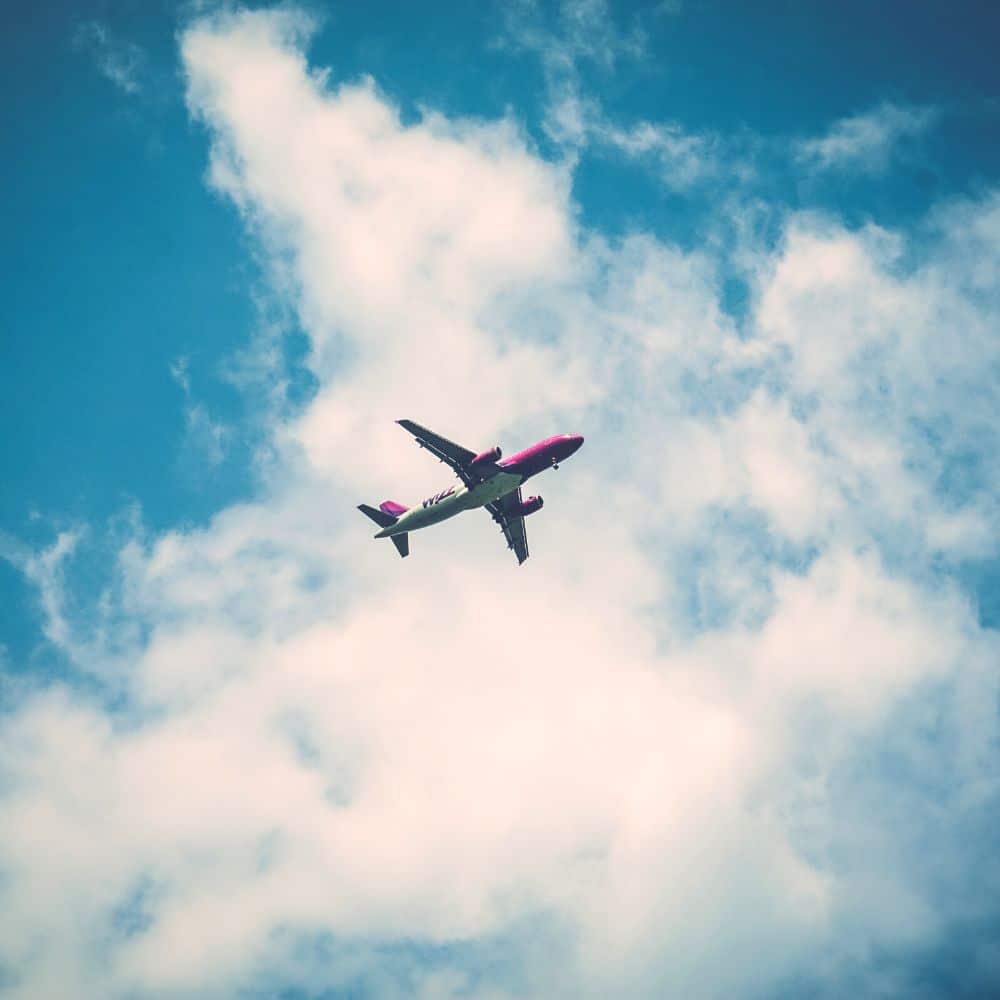
Flight Costs To Korea
Flight costs depend on which airports you’re traveling from. A flight from Los Angeles to Incheon Airport (Korea’s main airport) costs around $1370 right now. Flight costs vary depending on the season and time of day.
The cost to fly to Korea is more than twice the normal price right now. Fortunately, Korea ended the restrictions on the number of flights into the country from June 2022 and flight costs and availability should be improved in the near future.
There’s so much more to South Korea than what you’ll find in the cities, however. South Korea, a country that’s 70% mountainous with coasts on three sides, offers so much to nature and adventure lovers. Hiking, South Korea’s national pastime, is a popular way to see more of the Korean countryside, looking down over rice fields, forested valleys, and pockets of urbanization. Skydiving, parasailing, scuba diving, water sports, cycling, rock climbing, white water rafting, and lots more are on offer and very reasonably priced. South Korea is a great place to enjoy the great outdoors.
From September 2022 onwards it is no longer necessary to provide any vaccination status or take any PCR or RAT tests. A mandatory health check will be required, but this is only a simple form you can fill in on arrival.
What happens if I get a positive PCR result?
If you test positive for COVID-19 while in Korea, you will need to quarantine for 7 days at government facilities. Travelers who break the quarantine rules are subject to deportation or fines.
However, if a traveler (vaccinated or unvaccinated) tests positive for COVID-19 in Korea, they will have to self-quarantine until negative.
Welcome to Best of Korea!
Please Sign Up for Updates
We hate spam. You can unsubscribe anytime.

- Visa Application Helpline
Subscribe to our newsletter
Learn how to live a sustainable long-term travel lifestyle.
By signing up, you agree to the our terms and our Privacy Policy agreement.
Top 27 Places to visit in Darjeeling, Explore the Beautiful Hills of Darjeeling
Top 10 things to do when traveling to shimla: shimla travel guide, the ultimate paris travel guidelines for first timers | top attractions & things to do.

The Best 10-Day South Korea Itinerary: Budget and how to plan
If you’re looking for a travel destination that offers a rich cultural experience and a glimpse into history, South Korea is the perfect choice. Despite its small size, this country is packed with diverse attractions and a unique charm that will captivate any traveler.
Whether you’re interested in exploring ancient palaces, indulging in delicious street food, or immersing yourself in the vibrant K-pop culture, South Korea has something for everyone. With this ultimate 10-day South Korea itinerary , you’ll be able to make the most of your time in this fascinating country.
South Korea will give you the perfect opportunity to create a storming itinerary to explore the bustling cities quiet mountains and countryside. South Korea has a synchronized harmony of traditional culture and modern history.
Tourists can enjoy the cultural heritage through the UNESCO sites and can enjoy the variety of food, local culture, and lifestyles. Along with Korea’s Buddhist temples, and UNESCO sites you will find beautiful mountains, hiking trails, and port cities will let you experience the full range of diversity in the country.
WHAT IS COVERED IN THIS ARTICLE?
Planning a Trip to Korea Preparations

Planning a trip to Korea involves a lot of steps, especially when you have a 10-day itinerary in mind. Here are some details to make your preparation easier:
Visa or ETA: First, check if you need a visa or an Electronic Travel Authorization (ETA) to enter Korea. If you require a visa, you can refer to my visa application guidelines for assistance.
Weather Considerations: Understand the weather conditions during your visit to Korea. Pack your clothes, accordingly, considering the weather or season prevalent during your travel dates.
Flight Booking: Start looking for flights as early as possible. Flight tickets tend to be more expensive if purchased just before your travel dates. Aim to purchase tickets a few months in advance to get the best prices. You can use flight search engines like trip.com or set up alerts on Google Flights for deals.
Travel Insurance: Consider getting travel insurance. It can be immensely helpful in case of flight delays or baggage losses, providing you with financial protection and peace of mind during your trip.
To have a hassle-free trip to South Korea there are few more things you can do to prepare. Few of them are using a language translator app, using specialized local maps, downloading cab app, and getting cashless money transfer systems. Here are the top apps for planning South Korea itinerary 10-days you can use to make your journey easy.
By following these steps and tips, you can streamline your trip planning process and ensure a smoother travel experience to Korea.
10-Day South Korea Itinerary:
Starting your 10-day adventure in Korea by arriving at Incheon, Seoul is a fantastic choice. Incheon Airport is well-connected globally, making it convenient for travelers. Once you’re in Seoul, you’ll dive into the captivating royal history and indulge in the delicious world of Korean cuisine. With so much to see and do, Seoul can easily fill your entire itinerary. However, if you’re landing in Busan or another city first, feel free to customize your schedule accordingly. Flexibility is key to ensuring you make the most of your Korean journey!
Day 1 to 2 in Seoul: 2 Days
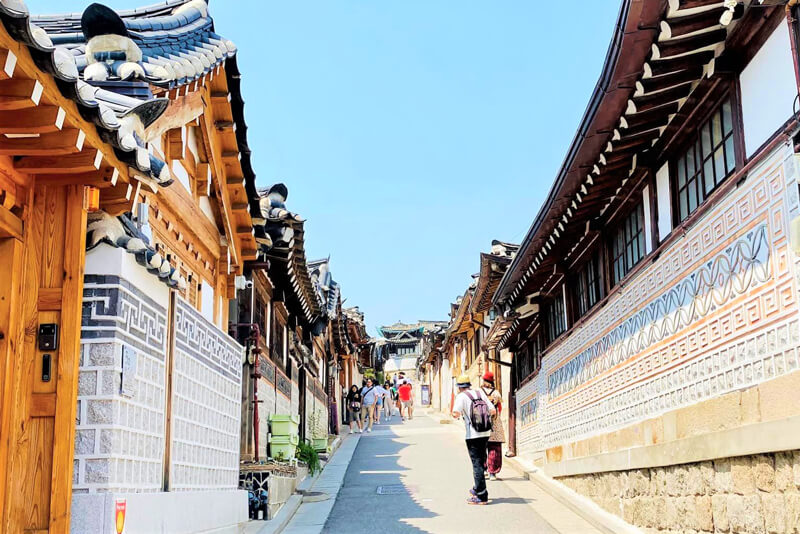
Seoul offering a modern yet traditional lifestyle should be the first place in your south Korea itinerary for 10-days. The Seoul trip for two days will be your first step in familiarizing yourself with the city’s cultural, historical, and traditional sides. Take the first day slow and visit the royal palaces and UNESCO sites. You can start your trip with Gyeongbokgung Palace, and then continue to visit Cheonggyecheon Stream, Gwangju Traditional Market, and Insadong Shopping Street.
Gyeongbokgung is one of the most popular and oldest palaces in Seoul . This served as the main official palace during the Joseon dynasty. The entrance fee to the palace is $2.50 and you can also rent hanboks if you want great pictures in the traditional dresses. After the tour head over to the Cheonggyecheon Stream where you can enjoy a nice walk and enjoy the art murals, greenery, and scenic beauty.
Make your way to Gwangju Market, where you will be enjoying a whole array of foods. Some of the famous foods there as one of the oldest markets in Seoul are bindaetteok, mandu-guk, and bibimbap. From there you can go to visit the traditional Bunchon Hanok village.
For Day 2 in Seoul , start your day with a delicious breakfast in Hongdae. Hongdae is a vibrant area where young people hang out and Hongdae shopping street is also a great area to hang out. From there you can go to museums of the city and during the sunset hike up the N Seoul tower where you will enjoy the beautiful city’s nighttime landscape view. You can also have an amazing dinner on the restaurants of N Seoul tower.
Other places that you can visit in Seoul
Changdeokgung palace:.
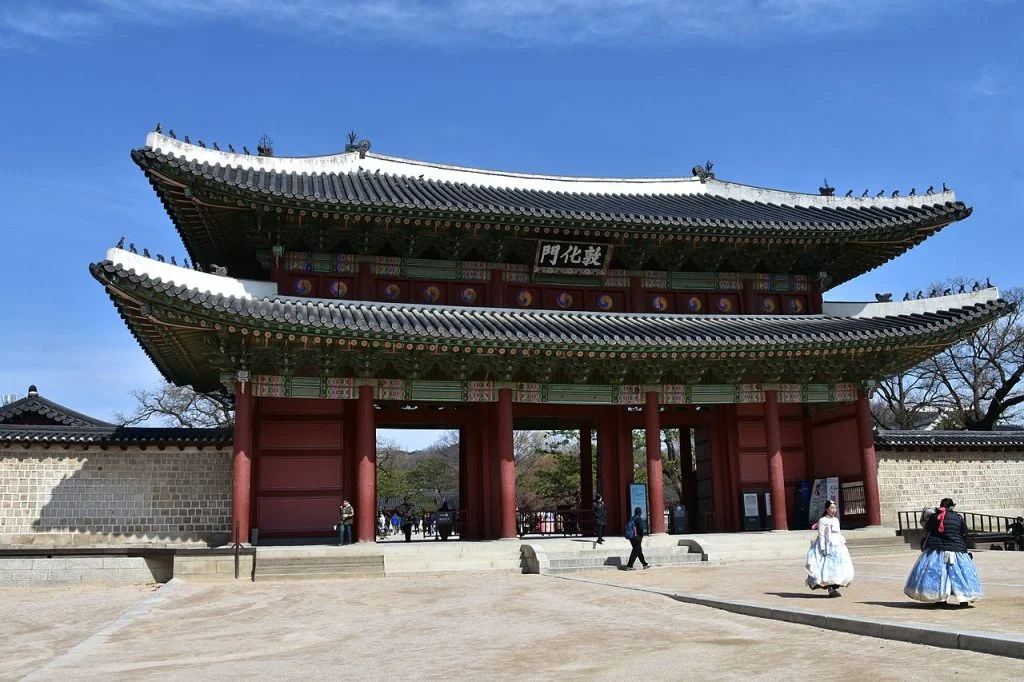
One of the most popular UNESCO sites in Seoul is the Changdeokgung Palace. Changdeokng Palace is an official residential building built in the Joseon dynasty. This complex was built as a secondary palace from Gyeongbokgung Palace to have the administrative work done.
Gyeongbokgung Palace:
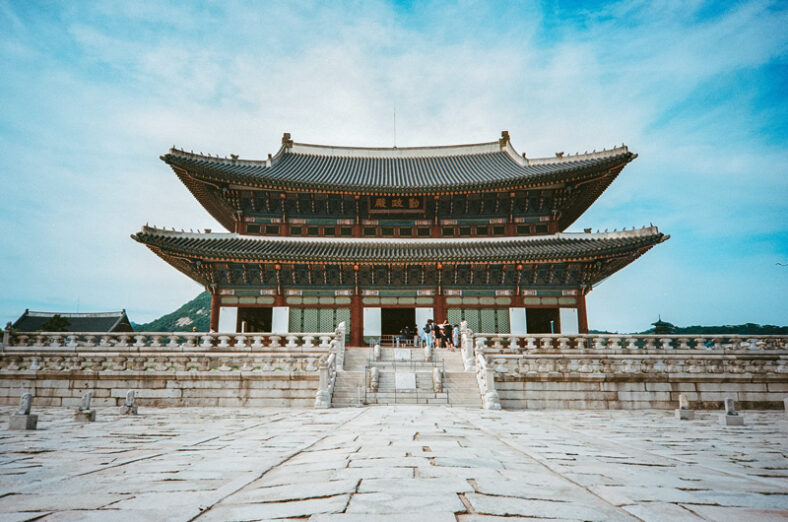
The Gyeongbokgung palace is a South Korean first palaces for administrative work. It was built in 1935 in Hanyang, currently the heart of Seoul. This is quite famous for taking pictures in hanbok, traditional korean dress and visiting the historical settings, and artefacts. At the entrance, you will also find the historical Gwanghwamun gate located at the three-way intersection.
Namsan Tower:
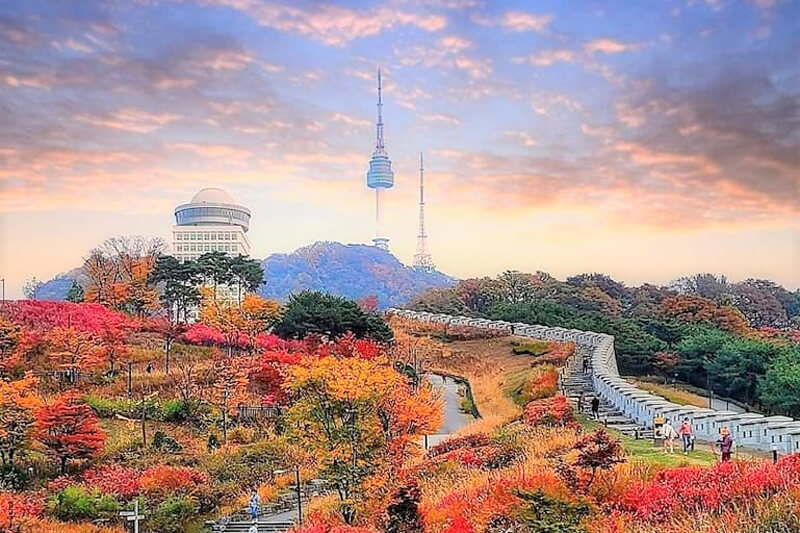
Namsan tower located in Seoul is an observatory tower on the highest hill in Yongsan-gu district of Seoul. It gives undeniably the best view in the city and is worth a visit. The lovelocks there for couples are also quite famous. You can also enjoy the views from the cafe or the restaurant on the N Seoul tower.
Lotte World:

Lotte World is a major theme park in Seoul with indoor and outdoor rides, shows and parades, and an aquarium. If you have come here with children, taking a day to go to Lotte world will really make the trip a lot of fun. The aquariums, ice rink and parades are a true treat to kids.
Nami Island:

Nami Island has gained popularity as a scenic and romantic spot, and you can go there to enjoy cherry blossoms and the tree-lined pathways are quite romantic during Autumn and Spring. You can also enjoy different types of activities like cycling, zip lining and boating in Han River.
Day 3: Trip to DMZ
The DMZ tour from Seoul takes a whole day. You must keep aside a one-full day for this historic area. You can only have guided tours of the DMZ area. The Demilitarized Zone portrays the rich history of the Korean Wars. The DMZ tour packages are available from $25. Visit the freedom bridge, DMZ exhibition hall, and other monuments. You will get a brief recap of the historical moments throughout the trip to DMZ.
Day 4 & Day 5: 2 Days in Andong
By Korean standards, it’s a long journey between Seoul and Gyeongju . For this itinerary, there’s no better place to break up the trip than Andong. Long known for its traditionalism, Andong is a center of culture and folklore. It’s one of the best places to visit in South Korea for a glimpse of its ancient past.
For Day 1: Explore the impressive grounds of the historic Neo-Confucian Academy with a trip to the historic Dosan Seowon and for Day 2: Admire a stunning view of the surrounding natural landscapes from the top of the Buyongdae Observatory.
Also, the Woryeonggyo Bridge, a wooden footbridge crossing the Nakdong River, provides breathtaking views of the surrounding mountains and is a popular spot for photographers and nature enthusiasts.
Day 6: 1 Day in Gyeongju
No place during your 10 days in South Korea will live up to expectation better than Gyeongju. This fascinating city is nothing short of the cultural and spiritual heart of Korea. Gyeongju checks off all the boxes that drove you to visit South Korea in the first place.
Compared to the hubbub of Seoul and brash Busan, Gyeongju is a relaxing respite. And it’s as fulfilling as either. The top attractions in Gyeongju are spread far & wide. They encompass some of Korea’s finest cultural moments. Tumuli Park is one of the few Gyeongju tourist attractions smack dabs in the middle of town. The park is an ancient burial site. About two dozen Korean royal tombs sprout from the earth here.
Day 7 & Day 8: 2 Days in Jeju Do
Jeju is South Korea’s one of the most vibrant islands to experience beautiful braces, local markets, and more. On the first day arriving in Jeju, you can visit the Jeju Folklore and Natural Music and Halla Arboretum. And you can then visit the Jeju five-day folk market and Dongmun Traditional Market.
The next day you can catch the sunrise at Hallasan or at Sarabong Peak early in the morning. Then you can go visit the Hamdeok beach and Manjangul cave. There are a lot of places to explore in the south of Jeju-do and you will have a refreshing experience while travelling here.
Day 9: Busan
Busan is one of those take-it-or-leave-it places. Apparently, suggests that anyone should fall in love with, or even like, this brash Korean port city. And that’s usually where the story ends. When you are in Busan, don’t leave out the bustling J agalchi Fish Market.
It’s one of the city’s top cultural attractions, and an absolute must-see and must-do. This is not just the port city’s most significant market; it’s the biggest fish market in South Korea. All types of seafood caught around the Korean peninsula find their way to the market stalls of Jagalchi Fish Market .

With your trip coming to close soon, make time to fit one more temple into your Korea itinerary : Beomeosa Temple. This ancient temple is Busan’s top tourist attraction. The original temple was founded in AD 678 by Ui Sang, a monk in the Jogye Order of Korean Buddhism. It has since been rebuilt multiple times. Most of the current buildings hail from the 16th and 17th centuries.
From stone pagodas to ornate wooden gates, the beauty of the city entrances you. The temple also benefits from a spectacular location. It sits at the foot of Mount Geumjeongsan. Visiting Beomeosa Temple, it’s easy to forget you’re in Korea’s second-biggest city.

Day 10: Departure
On Day 10, you can either return to Seoul or fly back home from Busan. Make sure to pack your things. The last day is perfect for some last-minute shopping or enjoying a final meal with friends or family. If you have extra time, you can also visit a few more places of your choice.
Most Popular Tourist Attractions in South Korea
There are a lot of beautiful places across South Korea where you can experience a diversity of landscapes, culture and food. Taking a trip to South Korea is a phenomenal way to experience the joys of life. Here are the top few tourist attractions and landmarks of South Korea that any first-time traveler must cover. Also, you may read Places to visit in Korea here.
DMZ is a zone between South Korea and North Korea near the 38th parallel north. And the demilitarized zone is a walk through the history for tourists where you can understand the value of the war history of the country. This area works as a buffer zone between two countries and is a place for maintaining political peace.
Hwaseong Fortress:
Hwaseong fortress is a one-of-a-kind brick and pilestone fortress made in Joseon dynasty. It’s located in the centre of Suwon, a few kms away from Seoul. It was built by King Jeongjo to honour his father, Prince Sado.
Jeju Island:
Jeju Island is one of the most peaceful and pleasant natural spaces that you can visit. It is one of the most beautiful volcanic islands on the planet Earth. Top attractions in Jeju-do are the lava tunnels, Hallasan, Cheonjiyon waterfall, and the hiking trails.
Traditional Villages:
There are a beautiful Korean village like Bukchon Hanok, Yongin-si in Seoul where you can get roam around the beautiful streets, visit artisans and traditional arts.If you travel to Andong during your trip, you must visit Andong folk village to visit the Andong folk museum, thatched house. You can also visit the Jeonju-si for old shrines, Boseon-gun in South Jeolla province for the entrancing beauty.
Dodohaehaesang National Park:
Dodohaehaesang National Park is the largest natural park in South Korea and if you are a nature lover you will have a great time as there are 1500+ plant species and 1200+ animal species. The scenic beauty of the island the park is located on is all the is also an attraction.
National Museum of Korea:
National Museum of Korea has collections of Korean traditional products, and you will find a lot of art exhibitions going on every day worth visiting. You will see the collection of art, artifacts, and crafts from Korean and international artists at the National Museum.
South Korea Food Markets
South Korea has a lot of vibrant food markets which are worth visiting for tasting local foods and get immersed in the local lifestyle. A few of the top South Korean food markets are Gwangjang Market, Namdaemun, and Dongdaemun Design Plaza in Seoul for tasting the most famous traditional foods. You may also visit the jagalchi fish market in Busan for fresh fish and seafood and tasty foods.
Budget for South Korea 10-Day Itinerary
Your travel tastes, style, and the time of year you intend to travel all affect how much money you allocate for a 10-day itinerary in South Korea. I can give you a general idea of the expenditures related to a traveler on a medium budget, though. Please be aware that these projections were created using pricing as of my January 2024 update and may have altered since then.
Flight: Cost: $700 – $1,200 (depending on origin and time of booking)
- Best Deals: Malaysia, Singapore, and the Philippines often have the best cheaper tickets.
- Example: I got a round-trip ticket from Kuala Lumpur to Seoul for around $150.
Accommodation: The price of lodging can change based on the area and the type of lodging you select (hotels, hostels, guesthouses, etc.). Budget travelers should budget $70 to $100 per night for a mid-range hotel or guesthouse, on average.
Food: South Korea offers a wide variety of food options to fit any budget. For about $10 to $15 per meal, budget-conscious travelers can enjoy delicious street food and local dishes. If you prefer dining at mid-range restaurants, expect to spend between $15 and $30 per meal.
Transportation: South Korea has a great public transit system, including buses and subways. For ten days, plan to spend around $100 to $150 on transportation within cities and for traveling to different locations. The KTX train from Seoul to Busan costs $60 to $80 one way, or $120 to $160 for a round trip.
Activities and Sightseeing: Different attractions and activities have different entrance prices. Budget, on average, $5 to $20 per attraction. You can budget between $100 and $150 for this category if you’re going to numerous paid attractions.
Shopping and souvenirs: Depending on your shopping tastes, this expenditure can vary greatly. Budget travelers should set up $100 to $200 for shopping and souvenirs.
Miscellaneous: It’s smart to keep some extra cash for unexpected expenses like tips, extra snacks or drinks, or emergencies. Set aside $100 to $200 for these additional costs. Also, plan to spend $50 to $100 on travel insurance.
Without including international flights to and from South Korea, a rough estimate for a 10-day moderately priced vacation in South Korea is between $800 and $1,000. Keep in mind that this is just an estimate, and the actual cost may vary based on your choices. It’s a good idea to research prices and expenses for your specific route and travel dates to get a more accurate budget. Happy planning and enjoy your trip to South Korea!
Related Posts
Unforgettable honeymoon in new zealand: a complete guide for newlyweds, 20 unforgettable day trips from seoul that you absolutely must experience | exploring the korean lifestyle, the best maldives itinerary: cost-breakdown of maldives vacation packages (4 to 7 days), new zealand itinerary & tour packages to design the perfect vacation.
Save my name, email, and website in this browser for the next time I comment.
This site uses Akismet to reduce spam. Learn how your comment data is processed .
Type above and press Enter to search. Press Esc to cancel.
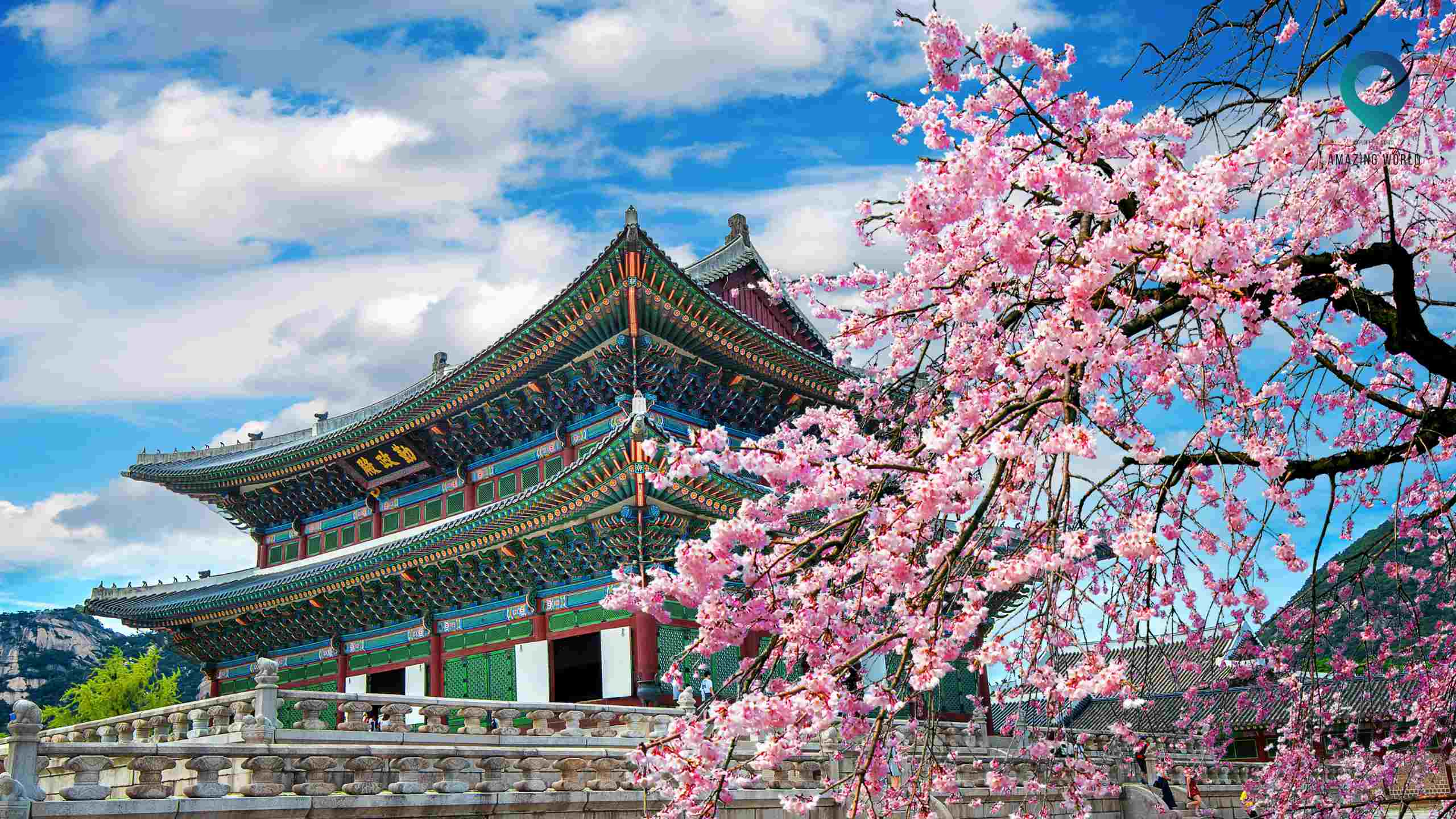
EPIC 7 Days Korea Travel itinerary for first-timers (2024)
- 9 minute read
- September 11, 2023
1-Week South Korea Travel Itinerary | Place to Explore, Safety Tips, Currency or Payment Types
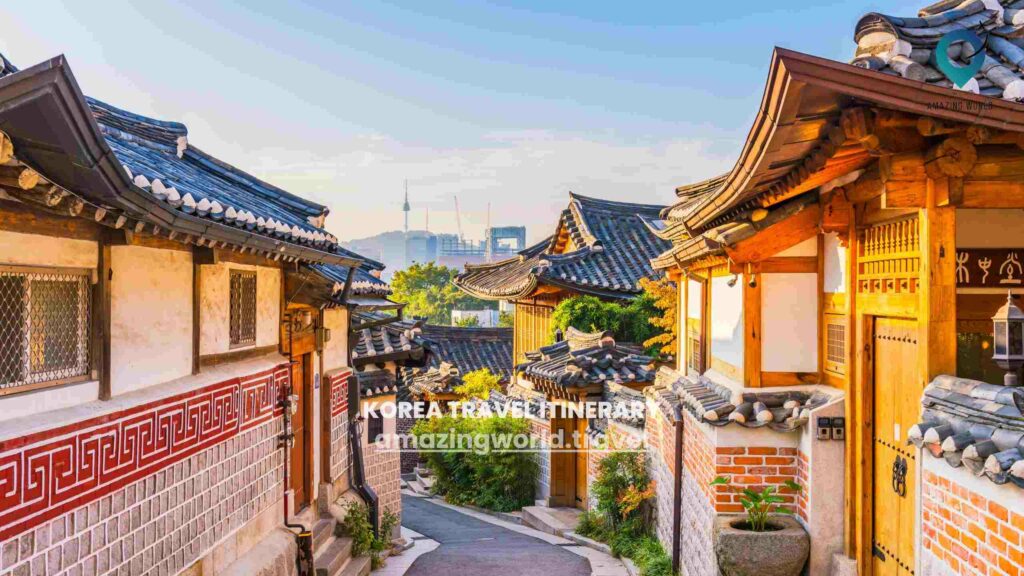
Are you planning a fantastic 1-week journey to South Korea? You’re in the right place! In this travel guide, we’ll help you map out an unforgettable trip to South Korea in just 7 days. We’ll provide you with a detailed itinerary, so you can explore the best of South Korea while staying within your budget and schedule. From exploring vibrant markets to enjoying delicious Korean cuisine, we’ve got your travel plans covered. So, let’s get started on your exciting adventure from India to South Korea!
Visa and Entry Requirements:
Check Visa Requirements: Determine whether you need a visa to enter South Korea. Visa requirements vary depending on your nationality and the purpose of your visit. Visit the official website of the South Korean embassy or consulate in your country to find out the specific requirements.
Prepare Required Documents: Gather the necessary documents for your visa application. Typical documents may include a valid passport, visa application form, passport-sized photos, proof of financial means, and a letter of invitation if applicable.
Submit Your Application: Submit your visa application to the nearest South Korean embassy or consulate in your country. Be sure to follow the specific instructions and pay the required visa fee.
Wait for Processing: Visa processing times can vary, so it’s essential to apply well in advance of your intended travel date. Check the processing times with the embassy or consulate.
Receive Your Visa: Once your visa is approved, you will receive it in your passport. Make sure to check the visa’s validity and any specific conditions.
Booking International Flights:
Research and Compare: Use online travel websites or consult with travel agencies to research and compare international flight options to Seoul. Consider factors like cost, airline preferences, travel dates, and layovers.
Book Your Flight: Once you’ve chosen your flight, book your tickets online through the airline’s website or a trusted online travel agency. Be sure to provide accurate passenger information and pay for your tickets using a secure payment method.
Check Passport Validity: Ensure that your passport is valid for at least six months beyond your planned departure date to avoid any issues with immigration.
Also, if you are looking best Fights at Discounted Rates we recommend booking your Fights with Singapore Airlines
Other Airports Serving Seoul:
Aside from Incheon International Airport (ICN) and Gimpo International Airport (GMP), there are also:
Gimhae International Airport (PUS): Located in Busan, South Korea’s second-largest city, this airport serves as an alternative international gateway to Seoul. You can reach Seoul from Gimhae Airport by taking a domestic flight to Gimpo Airport or using the KTX train service. Reaching Seoul by Flight:
Upon arriving at Incheon International Airport or Gimpo International Airport, you can reach Seoul’s city center by:
Airport Railroad Express (AREX): The AREX train connects both airports to Seoul Station, where you can transfer to the Seoul Metro or other transportation options to reach your hotel.
Airport Limousine Buses: These buses provide convenient transportation to various parts of Seoul, including major hotels and neighborhoods. They operate from both airports.
Transportation Services from the Airport to Hotels:
Taxi: Taxis are readily available at both Incheon and Gimpo airports. Ensure the taxi has a functioning meter, and you can communicate your hotel’s name and address to the driver in Korean or have it written in Korean script.
Airport Limousine Buses: Airport limousine buses operate routes to many hotels and neighborhoods in Seoul. You can purchase tickets at the airport and board the designated bus for your destination.
Private Airport Transfer: Some travelers prefer the convenience of pre-arranged private airport transfers. You can book these services in advance, and a driver will meet you at the airport and take you directly to your hotel.
Public Transportation: If you’re comfortable navigating public transportation, you can take the Seoul Metro or buses from the airport to your hotel or destination in the city.
Remember to check your specific airport and transportation options to your hotel before your trip, as details and services may change over time.
Also, if you are looking best hotels and Homestay deals then we recommend booking your hotels and homestay with priceline.com
Day 1: Arrival in Seoul, South Korea

Welcome to Seoul, the capital city of South Korea! Start your trip by checking into your hotel and taking some time to rest after your journey. In the morning, visit Gyeongbokgung Palace, the largest and most beautiful palace in Seoul, to immerse yourself in Korean history and culture. In the afternoon, explore the vibrant streets of Myeongdong, known for its shopping and street food. As the evening sets in, head to N Seoul Tower for breathtaking panoramic views of the city.
- Gyeongbokgung Palace : Check prices
- Myeongdong : Check prices
- N Seoul Tower : Check prices
Day-2: Seoul
Start your day by visiting Bukchon Hanok Village, a traditional Korean village with preserved hanok houses. In the afternoon, explore the lively district of Insadong, known for its art galleries, traditional tea houses, and souvenir shops. In the evening, enjoy a Han River cruise and admire the beautiful cityscape.
- Bukchon Hanok Village : Check prices
- Insadong : Check prices
- Han River Cruise : Check prices
Day 3: Busan
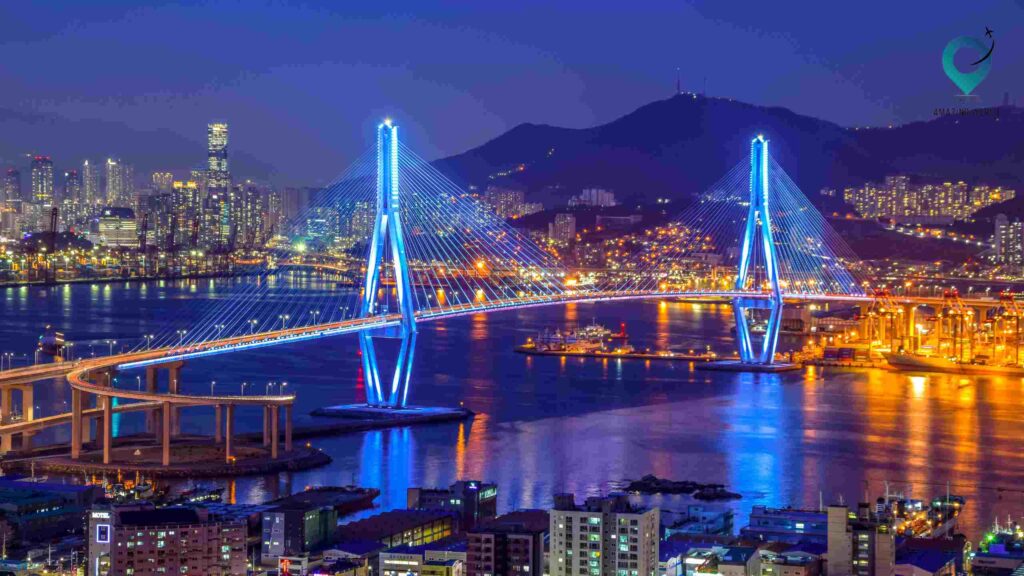
Take a day trip to Busan, South Korea’s second-largest city. Start your morning by visiting the iconic Gamcheon Culture Village, known for its colorful houses and art installations. In the afternoon, relax at Haeundae Beach and enjoy the vibrant beach atmosphere. In the evening, explore the bustling street of Gwangalli and enjoy dinner with a beautiful view of Gwangandaegyo Bridge.
- Gamcheon Culture Village : Check prices
- Haeundae Beach : Free
- Gwangall i: Free
Day-4: Seoul
Explore the modern side of Seoul by visiting COEX Mall, one of the largest underground shopping malls in Asia. In the afternoon, visit Lotte World, an indoor theme park with thrilling rides and entertainment for the whole family. In the evening, wander around the trendy district of Gangnam and enjoy some delicious Korean BBQ.
- COEX Mall: Free
- Lotte World: Check prices
- Gangnam: Free
Day-5: Jeju Island

Take a flight to Jeju Island, a beautiful volcanic island known for its stunning landscapes and natural wonders. Start your day by exploring Seongsan Ilchulbong, a UNESCO World Heritage site with a breathtaking crater. In the afternoon, visit Cheonjiyeon Waterfall and take a leisurely walk along the Olle Trails. In the evening, relax at one of Jeju’s beautiful beaches and enjoy the sunset.
- Seongsan Ilchulbong: Check prices
- Cheonjiyeon Waterfall: Free
- Jeju Beaches: Free
Day 6: Jeju Island
Continue exploring the wonders of Jeju Island by visiting the iconic Jeju Loveland, an outdoor sculpture park showcasing erotic art. In the afternoon, hike up Hallasan, South Korea’s highest mountain, for panoramic views of the island. In the evening, relax and unwind at one of Jeju’s famous hot springs.
- Jeju Loveland: Check prices
- Hallasan: Free
- Jeju Hot Springs: Check prices
Day 7: Departure from Seoul
Say goodbye to South Korea as you depart from Seoul. If time allows, explore the vibrant neighborhood of Hongdae, known for its street performances and nightlife, before heading to the airport.
- Hongdae : Free
Additional Mut Know Information

What To Pack + Weather
When traveling to South Korea in September, it is recommended to pack lightweight and breathable clothing as the average temperatures range from 17°C (63°F) to 25°C (77°F). However, it is important to note that South Korea experiences some rainfall during this season, so it is advisable to bring a lightweight raincoat or umbrella. It is also advisable to pack comfortable walking shoes as there will be a lot of exploring on foot.
Don’t forget to bring a power adapter for your electronic devices, as South Korea uses a 220V electricity system. Lastly, make sure to carry some Korean won for your daily expenses, as not all places accept credit cards. Enjoy your trip to South Korea!
Nearby Shopping
Transportation tips.
When traveling in South Korea, there are several transportation options to consider. In Seoul, the most convenient and efficient way to get around is by using the local public transportation system, which includes an extensive subway network and bus services.
Taxis and ride-sharing services such as Uber are also readily available and can be hailed from the streets or through mobile apps.
For day trips or exploring outside of the city, renting a car is a popular option, but make sure to have an international driving permit. It is recommended to plan your itinerary in advance and check the transportation routes and schedules to make the most of your time.
Safety Tips
- South Korea is generally a safe destination with a low crime rate.
- Take basic precautions and be aware of your surroundings.
- Keep an eye on your belongings, especially in crowded areas, to prevent pickpocketing.
- Respect local customs and etiquette, such as removing your shoes when entering homes or traditional Korean restaurants.
- Avoid discussions or activities that may be seen as disrespectful or offensive to local culture.
- Stick to well-lit and populated areas, especially at night.
- Avoid areas with a reputation for higher crime rates.
- Use licensed taxis and reputable transportation services.
- In areas like Itaewon and Hongdae known for nightlife, stay alert and cautious.
Overall, South Korea is safe, but being prepared and using common sense enhances your trip’s safety and enjoyment.
Travel Requirements
For traveling from India to South Korea, it is important to have a valid passport with at least six months of validity. Indian nationals are generally required to obtain a visa before entering South Korea. Visa applications can be submitted to the Embassy or Consulate of South Korea in India.
Additionally, it is advisable to check the travel advisories and entry restrictions for foreign visitors by contacting the Embassy or Consulate. Regarding vaccinations, it is recommended to consult a healthcare professional or a travel clinic for any specific requirements or recommendations for South Korea.
Cultural Norms + Etiquette
When visiting South Korea, it is important to be aware of and respectful of local customs and etiquette. South Koreans place a strong emphasis on politeness and respect, so it is customary to bow when greeting someone, especially when meeting someone older or of higher social status.
It is also important to remove your shoes when entering someone’s home or certain establishments, such as temples or traditional tea houses.
When dining, wait for the eldest person to start eating before beginning your meal, and use chopsticks instead of your hands. Tipping is not common in South Korea, as service charges are often included in the bill.
However, it is appreciated to leave a small token of appreciation, such as a small gift or a sincere thank-you. Overall, being respectful, polite, and mindful of local customs will make your visit to South Korea more enjoyable and memorable.
Some Local Daily Common Use Words
Health + medical facilities.
South Korea has a well-developed healthcare system with a wide range of medical facilities available. Hospitals in major cities like Seoul and Busan are generally of high quality and provide advanced medical treatments. Some recommended hospitals in Seoul include Asan Medical Center, Seoul National University Hospital, and Samsung Medical Center.
Pharmacies are easily found throughout the country, and they usually offer a variety of over-the-counter medications. It’s important to note that most pharmacies in South Korea close early, so it’s advisable to purchase any necessary medications during the day.
For travelers visiting South Korea, it is recommended to have travel insurance that covers medical expenses. This ensures that you are financially protected in case of any unforeseen medical emergencies or accidents during your trip.
Accepted Currency + Payment Types
Conclusion ..
crafting a memorable 1-week South Korea travel itinerary involves a blend of exciting places to explore, essential safety tips, and insights into currency and payment types. By following this guide, you’re not only well-prepared to navigate the wonders of South Korea but also ensure a safe and convenient journey. So, pack your bags, embrace the adventure, and let the beauty of South Korea unfold on your 7-day expedition.
How much did you like Our detailed EPIC 7 Days Korea Travel itinerary for first-timers (2023) ? Review Also, please share these Blogs with your friends on social media.
Related Article –
- Road Trips Ideas | 12 Tips to Prepare Your Car for a Long Road Trip?
- 150 Best Places to Visit in the United States In 2023
- Road Trip With Kids
- How to Stay Awake While Driving Long Distances
- Audiobooks to Listen to On Your Road Trip
- How to Create an Epic Itinerary Road Trip
- Best Rental Cars For Travel Adventures

Meet David Hoper, a passionate travel Blog writer with 7+ years of experience in travel content. Through his exemplary storytelling and engaging narratives, he shares his experiences and brings destinations to life. With a keen eye for detail and a love for exploration, he has cultivated a diverse portfolio of travel blogs that inspire and inform readers worldwide.
In this article:

Post written by: David Hoper
Leave a reply.
Your email address will not be published. Required fields are marked *
Save my name, email, and website in this browser for the next time I comment.
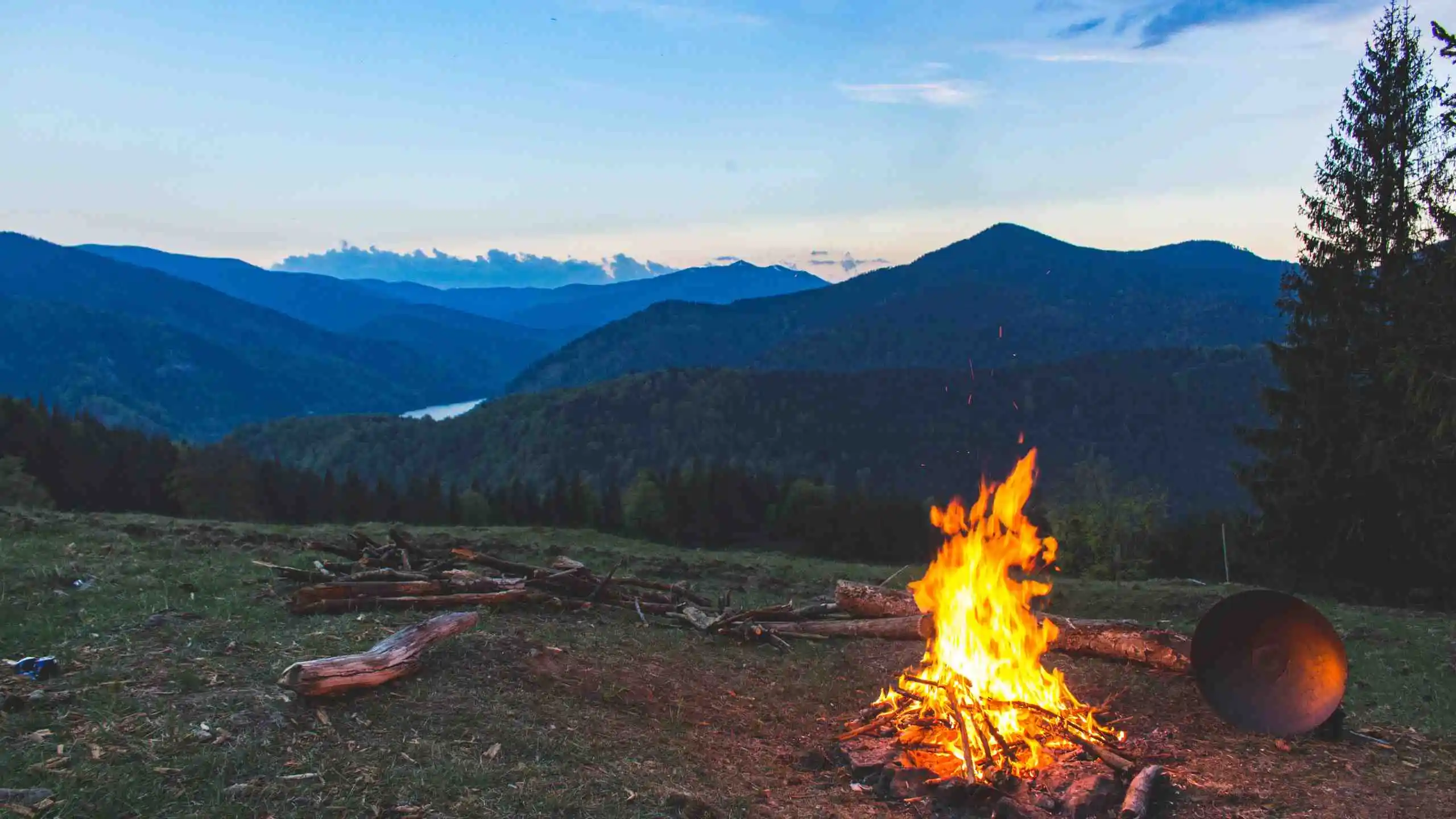
Camping Camping vs Glamping: Which is Best for You?

- September 12, 2023
Camping Luxury Glamping 101: Your Ultimate Guide to Luxurious Outdoor Adventures
You may also like.
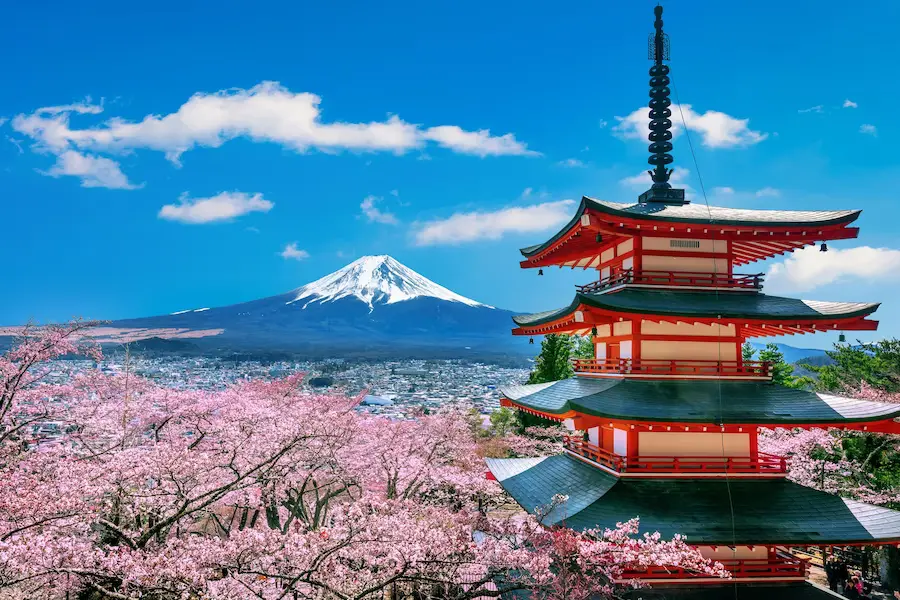
The best 5-day Japan itinerary suggestions for first-timers

Pattaya Itinerary: Best Places to Visit in Pattaya
- 2 minute read

Uncover the Southwest Road Trip Itinerary: A 7-Day Epic Road Trip itinerary
- 12 minute read

7-Day Road Trip from Delhi to Manali | Full Itinerary
- 7 minute read

7 Day Phuket Itinerary (2024) | The Best Things to Do in 7 days in Phuket
- 6 minute read

Explore Morocco: A 7-Day Family Travel Itinerary (Updated 2024)
- 5 minute read
Our Latest Instagram Posts
@amazingworld.travel8.

A Very Efficient Korea Itinerary for 7 Days
Okay guys, I’ve done a few itinerary guides now, but I haven’t done the most classic one of them all — a Korea itinerary for 7 days or one week.
Just know, this isn’t my favorite length of time because it’s so fast. Minimum, I recommend spending 2 weeks in Korea and for the most complete trip, I recommend my one month itinerary . Of course, the absolute best length of time is teaching here for at least a year or more ;).
However, I’ve realized that a lot of people I know in real life usually schedule out exactly one week in Korea, and, of course, most people I know don’t get more than a week or two for vacation at a time. So, with that in mind, I thought I’d outline the perfect Korea itinerary for 7 days, including flying in and flying out! It’s a little hectic, and you won’t get to see everything, but you will get a nice taste of the country and see some of the big landmarks.
Quick Korea Travel Guide
- Getting in: Assuming you’re flying into Incheon, expect it to take around an hour to get to where you’re staying in Seoul. DON’T spend a ton of money on a taxi! The subway is very user-friendly and easy to use. If you do need a private transfer, just book ahead .
- Stay in Touch: Korea has the best thing ever – eSIMs! No need to worry about losing your physical SIM card anymore. Just buy here and you’ll be emailed a QR code which will set you up!
- Download New Apps: When it comes to Korea, the app game here is a little different than anywhere else I’ve been. At minimum download KakaoMap for navigation, Kakao T for taxis, and Papago for more accurate translations. Check here for my full app guide.
- Where to Book Activities: I always like checking Klook or Trazy for the best deals on anything related to tours and day trips in Korea.
- Getting Around: All major cities have some sort of subway system and there’s a pretty robust bus system all around the country even in more rural areas. Download KakaoMap for the most up to date information. In between cities, you can take the train or bus. For trains, I always use Let’s Korail to buy tickets ahead of time as they can sell out. For buses, I usually just show up to the terminal and buy tickets, but my friend told me you could use TxBus , Kobus , or Bustago to order online.
- Travel Insurance: Korea can be expensive if you wind up in the hospital! I recommend getting either World Nomads or SafetyWing . I personally have an annual plan with Allianz.
For more in-depth planning: Read these 50 South Korea travel tips as well as this trip planner guide for the random logistics!
Fly Into: Incheon International Airport
Your best bet is to get into Seoul early in the morning so you don’t lose a day just for travel. It’s probably going to be a struggle, but fight against the jet lag!
Incheon is the main international airport for Seoul and the rest of Korea. It’s honestly one of the best airports I’ve ever flown into or out of, and very tourist-friendly. They even have arrows on the ground to point you to the subway!
Transport: Get into the city via the subway or a shuttle bus. If you need to, book a private transfer ahead of time . Taxis are the most expensive option!

Day 1: Historic Seoul
Stay Overnight: Seoul. To be near the sightseeing stops, look around Insadong . Here are some quick options:
- SeoulStory Hanok $$ – Great option to try a hanok stay. Right between Gyeongbokgung and Changdeokgung.
- Four Seasons $$$ – Ultimate in luxury; right by Gwanghwamun Square.
- Grid Inn Hotel $ – Walking distance to Gwangjang Market and near Jongno-3ga Station, Exit 15. Great mid-range option; stayed here my last visit.
- Mini Hotel Insa $ – Super cute budget stay in Insadong.
Your first day in Seoul is going to be dedicated to everything historic! Much of the historic architecture you can find in the city, including its five grand palaces , are from the Joseon era. Spanning from 1392 to 1897, it was Korea’s last real royal dynasty and has played a huge part in establishing the country’s identity and modern culture.
Also, on a simpler note, it’s left some really beautiful buildings and landmarks.
Check-in & Eat Something
Drop your bags off at your hotel and then head to any restaurants nearby to grab something to eat and down a coffee. If you’re on the go, you can just pop into Paris Baguette, Tours Le Jours, or any of the Korean bakery chains to get a quick sandwich and coffee. No, it’s not the most delicious first meal, but it’ll do in a pinch. I honestly wouldn’t judge you if you just grabbed Starbucks – they reliably have milk alternatives and are still the only place I’ve found in Korea with good iced chai lattes.
Now… get reading for a lot of sightseeing in one go!
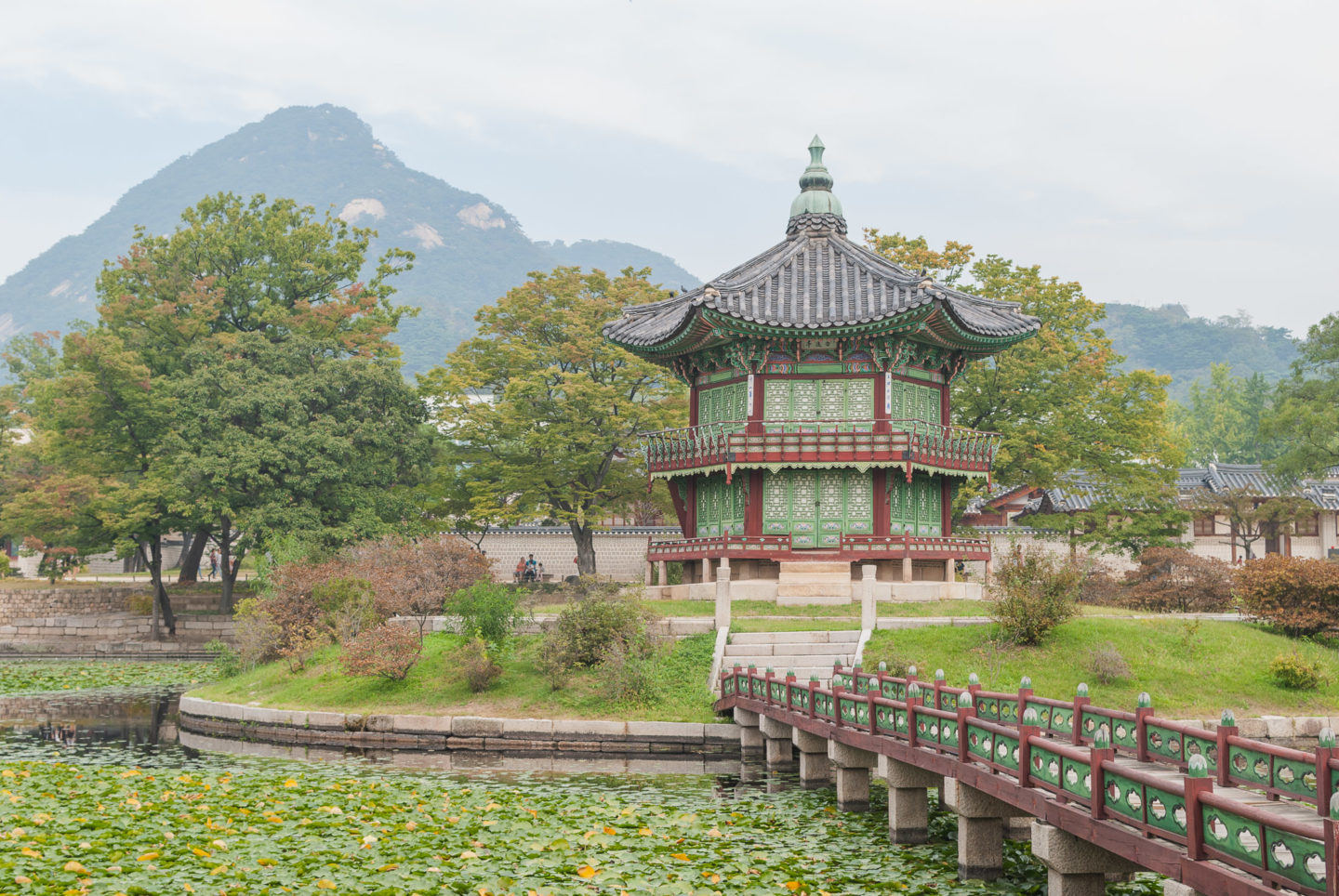
Stop 1: Gyeongbokgung
- Get There: Depending on where you’re staying you can either walk over or get a subway. The closest stops are Gyeongbokgung Station, Exit 5 or Gwanghwamun Station, Exit 2.
Gyeongbokgung opens at 9:00 AM year-round, so by the time you get into Seoul, drop your bags off, and eat something, it should be open. This is the main palace of Korea and also the largest. First built in 1395, it’s undergone a ton of renovation (thanks, Imperial Japan), and is just incredible.
Give yourself at least 2 hours – the palace grounds are huge. I’m pretty sure I spent 3 hours wandering around. If you also visit the National Palace Museum and National Folk Museum as well, it’ll be even longer. While you can do a tour ( this one starts at 9:00 am ), you can also pick up a map and do a self-guided tour as well.
I also recommend trying to time your visit with a changing of the guards at 10:00 AM; it’s a pretty cool sight to see.
Feeling extra? Rent a hanbok and do a whole photoshoot ! Don’t worry, if there’s one country where selfies and photoshoots are encouraged, it’s Korea. Before selfie was even a word , there was selca.
KEEP IN MIND: Gyeongbokgung is closed on Tuesdays. If your itinerary starts on a Tuesday, swap Day 6 and 1. (This will also mean Changdeokgung is open since it’s closed on Mondays, which would be your Day 7).

Stop 2: Bukchon Hanok Village
- Get There: On foot
From Gyeongbokgung, walk over to to Bukchon Hanok Village. This is an example of traditional housing in Korea and just a charming area to walk around. I love popping into the shops and boutiques and just doing a little people watching. Stop into Green Mile Coffee to grab a drink and check out the views from their roof.
Also if you see signs for the observatory, go and pay! It’s run cute ajumma who owns the house, and she was so sweet both times I went. Most people are cheap and only want to see the main pathway in Bukchon, so it’s never been overly crowded in the observatory, and on a clear day you’ll get a view straight to Namsan Tower like above.
Also – stop into the Granhand shop! It has the best essential oils and fragrances; I pick up the same scent each time.
Stop 3: Insadong for Lunch
- Get there: On foot
If you’re hungry, this is a good time to stop for lunch. Go over to Insadong to find a restaurant and try some Korean food . I haven’t eaten too much around here, but I do have Imun Seolnongtang on my list as it’s the oldest restaurant in Korea. For vegetarians, try Oh Sae Gyae Hyang .

Stop 4: Changdeokgung
Once you’re fueled up, time for palace #2! Now, I know what you’re thinking, “Really two palaces in a day?” But I promise, Changdeokgung is worth it. The palace grounds are cool but the real jewel is the palace’s “secret garden,” also called Huwon.
Here’s the kicker, though, you need a tour to see Huwon, aka the secret garden. If you want an English tour, aim for either 2:30 PM or 3:30 PM (available March – November) and book ahead or you run the risk of it selling out, especially around fall foliage season .
Check their website for all the info. It’s kind of complicated but not really. And give yourself time to get to Huwon’s entrance from the main gate.

Stop 5: Deoksugung from above
- Get There: From Changdeokgung, the easiest way is via bus. Get Bus 172 from the Changdeokgung,Seoul Donhwamun, Korean Traditional Music Hall Stop (창덕궁.서울돈화문국악당 정류장) and get off at Seosomun Stop (서소문 정류장)
By the time you finish, it should be close to golden hour. You’re going to see your 3rd palace but this time from a different angle! From Jeongdong Observatory, there’s a great aerial view of Deoksugung and Seoul City Hall. It’s really more of a cafe, and you’ll be joined by plenty of other observers, but it’s so worth it for the views, especially in autumn.

Stop 6: Dinner at Gwangjang Market (광장시장)
- Get There: Walk 6min to City Hall Station (시청역) and use Line 2. Get off at Euljiro-4ga Station (을지로4가). Then walk about 10 mins to the market entrance.
For your final stop of the day, get some dinner at Gwangjang Market . I finally visited on my last trip, and I actually really loved it! it’s bustling and fun but the food is actually quite good, and you’ll get to try a bunch of different dishes in one go.
If the name sounds familiar, it’s been featured on Netflix’s “Street Food” and the stands featured are still there with signs to let you know who they are.
Once you’re full, head back to your hotel, and collapse in exhaustion because this itinerary is not slowin’ down!

Day 2: Through Jeollabuk Province
Get breakfast and checkout fairly early, then head over to Seoul Station or Yongsan Station to get the KTX down south. I say KTX and not the other trains because it’s much faster, and at least for this stretch, it’s better to cut your travel time down by an hour.
If you leave from Seoul Station, aim to get the KTX that leaves at 9:46 am. If you leave from Yongsan, you can aim for 8:40 am, 9:55 am, or, at worst, 10:55 am. Check here for exact times , in case they change a bit. You can also book your tickets here too.

Stop 1: Jeonju
First stop is in Jeonju , the capital of the Jeollabuk province. The city was also the capital of the Hubaekje Kingdom (892-936) and the spiritual capital of the Joseon Dynasty (Korea’s most definitive era).
You’re now in foodie country because, in my not so humble opinion, Korean food is leaps and bounds better here than anywhere else! It’s the country’s main agricultural center, and I was thoroughly spoiled getting to live in first Jeollabuk and then Jeollanam for three years. It’s to the point that I really don’t like eating Korean food in Seoul because it’s not as good, and all my friends and students agree.
ANYWAY, the two big things you want here are eat bibimbap and explore Jeonju’s Hanok Village . Store your luggage at the train station and then grab a taxi to the Hanok Village, which is where you can grab a lunch of bibimbap. I personally liked the bibimbap at Jongno Hwegwan 종로회관 .
Walk off lunch by wandering around the village! It’s such a cute area, and I actually like it better than Bukchon because it’s more enclosed. The best view is if you climb up the small mountain nearby and look over the hanoks.

Stop 2: Namwon
You don’t have to do this if you’re exhausted, but I love Namwon , and it has the best food in the whole country (again, not so humble opinion), so I always recommend stopping here.
Grab a taxi back to Jeonju’s train station and then catch any of the trains down to Namwon. It’s fine to take the slower, cheaper trains now because the time difference isn’t that big!
You should get in around golden hour, so head over to Gwanghallu to see Namwon’s biggest attraction and learn about Chunhyangga , which is Korea’s Romeo + Juliet but much happier and more focused on the female lead, Chunhyang.
For dinner, you have a few options, and you really can’t go wrong with any of them:
- Go to 25시 (25-shi) for my favorite dish EVER — 뼈다귀탕 (bbyeo-da-gwi-tang). I honestly still think about how much I love this dish. If 25시 is too crowded, walk along that street as there are other restaurants that serve it too.
- Head across the river to get naengmyun at 봉가면옥 ( bong-ga-myeon-ok). It’s seriously the BEST naengmyun I’ve ever had, and I dream about that broth even now.
- If you didn’t get BBQ in Seoul, go across the river for all you can eat BBQ at 미가 (mi-ga).
If you stay overnight in Namwon, I know of a few options. The Kensington Hotel is the main one and they opened up a fancy hanok stay before I left, but I don’t know anyone who’s stayed there. Namwon also has a hanok stay area , and Mua Guesthouse is run by a lovely couple who’s friends with some of my friends.
Or you can push on and get the train to Suncheon. Again, any train is fine because they all take under an hour. If you stay the night in Suncheon, then stay in the same area as the train station or bus terminal.

Day 3: Boseong & Suncheon Bay
Exhausted yet? Haha I told you this was fast! Obviously, if you’re dying by now, take it easier, but if you’re still energized, today’s another double down day.
If you stayed overnight in Namwon, you can do two things:
- Get the train to Suncheon super early to drop your things off at your accommodation and then head to Boseong from Suncheon’s bus terminal.
- Go straight to Boseong by bus – first you’ll have to go to Gwangju bus terminal and then transfer from there
Both will take about 2 hours (Namwon – Suncheon – Boseong or Namwon – Gwangju – Boseong), but one of them means you’ll have your luggage with you.

Stop 1: Boseong Green Tea Fields
Time for Boseong’s famous green tea fields! They’re about an hour from Suncheon, and one of the most beautiful places in Korea. If you go at the right time, you can get the bus to the tea fields or just take a taxi.
You can read my guide on visiting here . It should take you a few hours to visit the area. Just a warning, if you wind up wanting to up to see the sea from the fields, it’s a steep hike! Get lunch at the restaurant right near the entrance and try the green tea pajeon!

Stop 2: Suncheon Bay
After lunch, head back to Suncheon. From the bus terminal, get a local bus over to Suncheon Bay . This is another small hike, just warning you! Ideally, you’ll get to the top right around golden hour, so you can enjoy the bay at its prettiest!
From there, head back to the area with your accommodation. There are a few places to eat in Suncheon, and the closest is a Korean-Chinese restaurant near the bus terminal.
If you want, though, venture over to Jorye-dong and find 순천양꼬치 (Suncheon Lamb Restaurant). It’s SO good. I used to live less than a 5-minute walk from it, and I was a bit addicted. Get the eggplant dish too. Most of the expats in Suncheon love this place, so they have a whole English menu with photos and are used to foreigners. For more on Suncheon, see my full guide
Stay Overnight
Stay the night in Suncheon .
Day 4: Busan

Get up early and head to the bus terminal to grab a bus over to Busan! The earliest one leaves around 7:00 am and takes around 3 hours to get to Busan Seobu Sasang Terminal . If you didn’t grab breakfast before you left, there are a ton of restaurants in this terminal, so you can always get something to eat here.
Now I recommend staying the night in Haeundae (hotel options below). This is on Line 2 and kind of all the way at the other end of the subway line. You could go over and drop your things off at your hotel, but if you want to maximize your time, do this instead:
Take the subway from Sasang Station to Seomyeon Station. You can leave your things in a locker there, and then you’ll want to switch over to Line 1.
While there’s a lot to do in Busan , I say head right over to Gamcheon Culture Village (Toseong Station, Line 1). It’s pictured above and one of my favorite places in all of Korea. The colorful houses and cute, artsy vibe make for a fun few hours of walking around. Plus it’s seaside, so when you get to the top, you’ll get a beautiful view out to the ocean.

Once you’ve seen Gamcheon, head back two stops over the subway (Nampo Station, Line 1) and walk around the markets and alleyways. Get lunch here! Ddeokbbeokki and pajeon are especially delicious if you’re getting elbowed by the shopping crowds haha. You could also go over to the famous Jalgachi Fish Market and eat there.
(Alternatively – you can do this tour which goes around Gamcheon and Jalgachi. They meet at Jalgachi Station which is right in between Toseong and Nampo. If you have time, you can still walk around Nampo’s alleys after)
For sunset, head back to Haeundae or go all the way over to the seaside temple. If you’re here in hot weather, enjoy the beach at Haeundae or Gwanghalli!
Stay the night in Haeundae Beach . There are quite a few options:
- Signiel Busan – luxury option (a little farther)
- Park Hyatt Busan – another popular luxury option in opposite direction
- Hound Garden & Terrace Hotel – nice room decor, close to beach
- MAMA Guesthouse – cute budget pick
Day 5: Gyeongju

Day trip from Busan! So, you could DIY this and go yourself, but everything was super spread out when I visited. It was way more spread out than we were ready for, and the local bus system wasn’t the most reliable. We essentially spent a ton of money renting a taxi for the day to drive us around. It’s been a few years, so maybe they updated the buses by now!
Gyeongju is such a cool city to visit because it has everything from the Silla Dynasty. Silla pre-dates the Joseon era (which is what you see represented all over Seoul and Jeonju) and lasted from 57 BC – 935 AD. Back then it was part of the Three Kingdoms of Korea with Goguryeo and Baekje. It’s kind of crazy how many landmarks you can still see today.
The most efficient way to visit Gyeongju is booking this day tour from Busan . It’ll pick you up from a few different places in Busan and take you to Daereungwon, Hwangridan-gil, Bulguksa, Gyochon Village, and Donggung before bringing you back.
Stay the night again in Haeundae . If you want, go out and experience the nightlife in the area! I’d offer suggestions but… I have none. I usually go to Busan for day trips and when I have stayed over, I only went out once to a random bar.
Day 6: Back to Seoul
Okay for today, I have two options and then two sub options if that makes ANY sense.

Option 1: Busan & Seoul
Experience one of the biggest jimjilbangs in Korea. Of all my jimjilbang experiences in Korea, SPA Land Centum City is by far the fanciest. ( Get discount tickets here ). Basically – you’ll split up by gender into various baths (prepared to get naked). Enjoy soaking in all sorts of tubs before showering off, donning your jimjilbang set (seen above) and enjoying the mixed gender area. Besides the common area and food options, this also has various rooms to decompress and get zen.
It’s only 3 stops from Haeundae at Centum City Station (Line 2), so you can leave your things at your hotel or bring them with and put them in lockers at Centum City.
Once you’ve fully relaxed, grab some lunch, and then head back to Seoul! The most efficient way to do this is to grab the KTX as it takes under 3 hours. You could also fly, which’ll take an hour, but the KTX is easier much easier. There are so many trains that go between Busan and Seoul, so you don’t really have to worry about getting a specific one. Again, check Korail for times.
In Seoul, you’ll want to check into Hongdae this time. This is because Hongdae Station is right on the airport line, so it’ll be easy to get to Incheon from here. Plus, Hongdae is a fun, trendy neighborhood since it has three big universities nearby. I wrote a post on my favorite Hongdae hotels , but here are a few I particularly love:
- RYSE – the ultimate chic hotel to stay in Hongdae – don’t miss the “secret” bar. I stayed here on my last visit and loved it.
- TwoTwo House – has that fun, hipster decor
- L7 Hongdae – nice, clean design with a pool!
By the time you get to Seoul, transfer over to Hongdae, and check in to your hotel, it’ll be close to dinner time. I would say get dinner and just walk around to experience Hongdae night life. It’s such a fun vibe – even if you’re over 30 like I am now and seeing all the college students out and about makes you feel ancient !
Off the top of my head, I don’t have any specific restaurants to recommend but you’re in a great spot for just about every type of dish under the sun. (I once went here for buffalo mac and cheese lol). Ask your hotel for recommendations based on what you’re craving!

Option 2A: Fun Things to See in Seoul
Another big thing to do is to head over to Namsan Tower and go up ( get ticket here for the observatory). It’s a cool area and you get a ton of views of Seoul from above.
Stop over in Dongdaemun if you want to do some shopping and see Dongdaemun Design Plaza . Eat lunch in this area.
Now, time for a little relaxing! If you didn’t go to Spaland in Busan, go to Siloam Sauna off Seoul Station. It’s so nice here.
Sightseeing Option 2B: A DMZ Tour
If seeing the DMZ is on the top of your list, then I’d suggest booking a day tour for that instead. They typically take the full day, so you won’t have room for much else! However, it’s a pretty interesting, ongoing part of history, and it’s the only way of “visiting” North Korea that I recommend for now.
Like before, grab dinner in Hongdae.

Day 7: Sightseeing & Souvenir Shopping
There are honestly so many ways to enjoy your last day in Seoul before heading to the airport. It really depends on how much time you have. At the very least I’d hit up one or two of Seoul’s trendiest cafes and checkout Olive Young (specifically in Hongdae) for an absolute mecca of smaller K-beauty brands!
And there you have it! The absolute PERFECT itinerary for 7 days in Korea. There are three big things I cut out — Jeju, any sort of real hiking, and Gangwon-do.
With Jeju, I feel you need a slower mindset to really enjoy it, so I don’t want to rush you through in a day or two, especially as it involves flying. With hiking , you’re going to basically be hiking a bit when you visit Boseong, Suncheon Bay, and Gamcheon. And, as for Gangwon-do, I don’t have a ton of experience in the area as it was so far from where I lived, so the main things I know to do involve hiking.
Of course, depending on the seasons, you can always mix and match your trip. After all, this whole itinerary is going to look different if you’re chasing cherry blossoms or fall foliage! Check these seasonal guides if you want to change it up:
- Autumn in Korea
- Winter in Korea
- Spring in Korea (and cherry blossom guide )
- Summer in Korea
Want to stay longer? Check out my two week itinerary (with four different options) or my ultimate one month itinerary .
FAQ for this Korea Itinerary
You can never spend too many days! Seriously, I lived here for three years and visit frequently, and my bucket list is never ending. Seriously, though, I’d say at least a week to get an introduction. If you can do two weeks, that’d be great and if you can do a month, you can fit a lot of the country in.
Frankly, no! But as you can see above, I tried to fit a lot in so you could get a taste of its two major cities as well as one of its prettiest provinces.
I mean, I have a ton of posts that explain just this. But I would start with these questions: – Why do I want to visit Korea? – What are the main things I want to do? – How much is my budget? – How much time do I have? And then you can start planning from there. Check my main Korea travel guide for all my posts in one place.
And there you have it! Anything you’d want to add to this Korea itinerary for 7 days?
SHARE THIS ON PINTEREST

want to support?
I’m always grateful when friends and readereach out wanting to support There She Goes Again . Truthfully, I’m just happy my posts are helping people travel! If you’d like to support the blog, here are some companies and brands I’m affiliated with. Simply click the links, and I receive a small commission at no extra cost to you!
- Booking (Hotels)
- Sixt (Car Rental)
- Klook (Tours)
- Viator (Tours)
- Get Your Guide (Tours)
- Trazy (Korea Tours)
- Tiqets (Entrance Tickets)
BLOGGING / SOCIAL MEDIA
- WPX Hosting (Advanced)
- Bluehost (Beginners)
- Lezé the Label (Clothing)
- Printfresh (Pajamas, etc)
- Promptly Journals
- Encircled (Clothing)
- Girlfriend Collective (Athleisure)
- Birkenstock (Sandals)
- Bookshop (For Local)
- Amazon Books
Thank you for this! Such a nice read :)
Thank for reading and commenting!
Thank you for sharing this itinerary. Very helpful.
Very much excited to visit after looking these scenarios.
I’m glad! Hope you enjoy!
Leave a Reply Cancel reply
Your email address will not be published. Required fields are marked *
This site uses Akismet to reduce spam. Learn how your comment data is processed .

Ultimate 2 week South Korea Itinerary: Best Places (2024)
Are you planning a 2 Week South Korea itinerary in 2024? This is our in-depth guide on how you can travel 2 weeks in South Korea visiting beautiful temples, eating the best food and learning about the Korean culture.
We’ll show you the best places to visit in South Korea and the best things to do in each place – tips on how to get around the country, what apps you need and how to budget for a 2 week South Korea trip. Let’s explore what to do in South Korea and create your South Korea route!
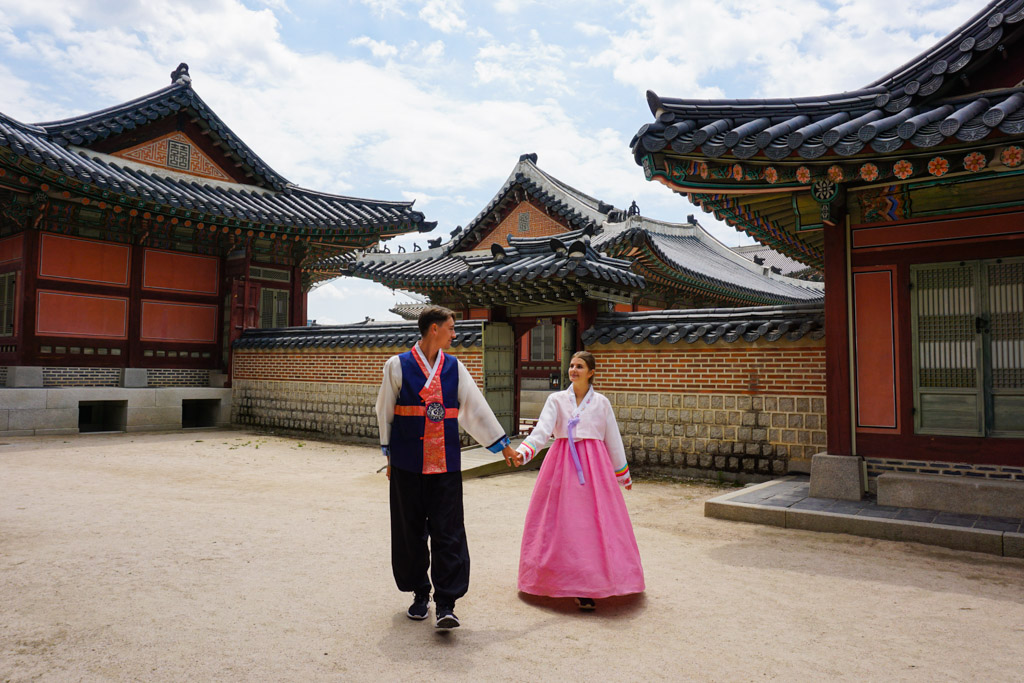
This post may contain affiliate links. We will receive a small commission if you make a purchase using these links, at no additional cost to you .
Quick Tips for 2 weeks in South Korea
Table of Contents (Skip to a section!)
- Currency – Korean Won (compare to your own currency here )
- Language – Korean (한글)
- Cuisine – Korean Cuisine (noodles, rice, BBQ & kimchi)
- Apps – NaverMaps (like GoogleMaps) & Kako Talk (like Google Translate)
- Transport Card – T-Money Card (the easiest way to use public transport in South Korea)
- Korea Power Voltage – Plugs C & F (220 V)
Simcard options for South Korea
E-Sim – A great option if you don’t need a Korean number! Purchase the sim online and with instructions you can install the sim on your phone settings! Here’s a 12 Day E-Sim . (£9.50 for 12 days)
Prepaid Sim – This may be preferred if you also want a Korean number as well as data. Price changes depending on the length you want the sim. Find a sim card on Klook here ! (£15 for 10 days) Pick up at the airport.
Portable Wifi – A great option if you want to connect more than just your phone! Find a portable Wifi on Klook here ! (£20 for 10 days) Pick up at the airport.
We also recommend having a portable charger for your phone so you always have enough battery to last the day and still use wifi! We recommend this one – Anker Power Bank !
Best time to visit South Korea
The best time to visit South Korea is around March – June (Spring) and September – November (Fall)! This doesn’t mean you won’t enjoy visiting in other months however the winter will be very cold and the summer will be very hot and humid!
Visiting South Korea in the winter means you have a chance to see snowfall and join in with winter activities. But in Spring you can see the cherry blossoms and in Fall you can see the autumnal foliage.
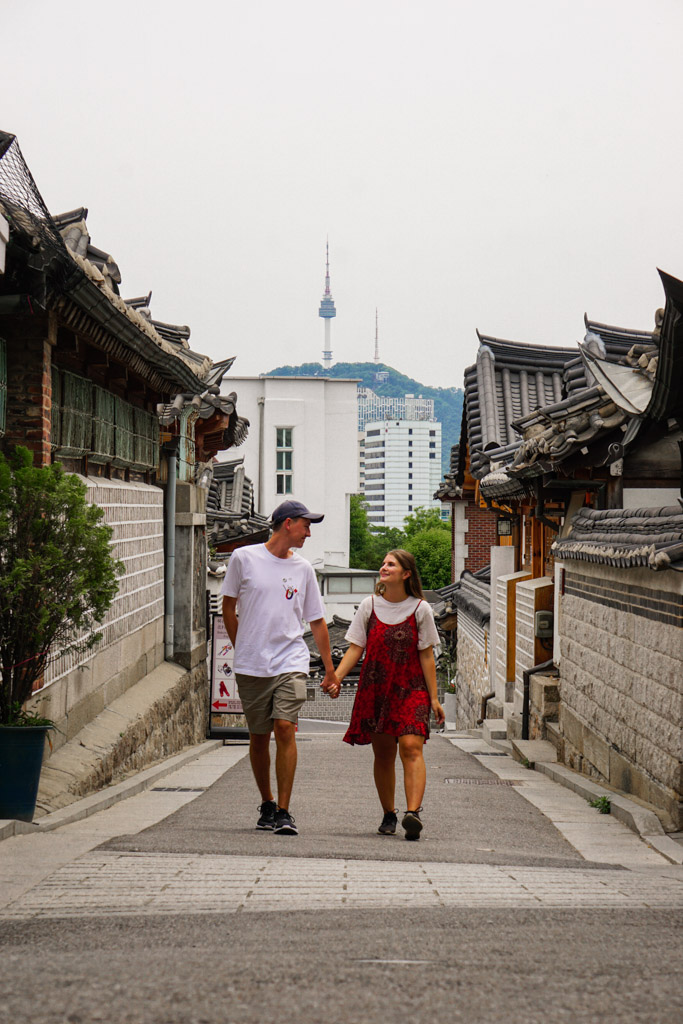
How to get around South Korea
South Korea is one of the easiest countries to get around – there are speed trains, well-connected cities, intercity buses and local buses! In the big cities, there are also metros to help you get to your destination. A Korea Rail Pass is a discounted train ticket that can help you get around the country – Find tickets on Klook here !
Trains – The fastest way to get around South Korea ( Korail tickets here ) ( Korea Rail Pass here)
Express & Intercity Buses – Another easy way to get around & cheaper than trains! ( Kobus tickets )
Flights – Flights to Jeju Island from Seoul or Busan – Check Skyscanner for flight times and prices !
2 Week South Korea Itinerary
Now that we’ve explained a few things about arriving in South Korea, let’s get down to the South Korea 14 day itinerary! We have written separate in-depth guides about most of the places on our list , so check out our page after you’re finished with this 2 weeks in South Korea route!
Day 1 – 5 | Seoul
The best way to start your 2 week South Korea itinerary is in the capital – Seoul! This city has a lot to offer and it’s one of the best places to learn about Korean culture whilst you get settled into the country.
How to get to Seoul
It’s likely you’ll be arriving at Incheon Airport which is just outside of Seoul. The best way to get to the city centre is to take the Airport Rail Road on the AREX Line. You can buy a ticket at the machines ( there’s an English option! ) and just follow the signs for the platform heading to Seoul Station. Find tickets on Klook here .
You can also buy a T-Money Card from a convenience store at the airport and top up here too ( 10,000 is a good starting point !). You’ll definitely want one for travelling around Seoul, so it’s best to buy one now!
Once you arrive at Seoul Station, you can head to your accommodation using buses or the metro. Naver Maps will be the best app for directions!
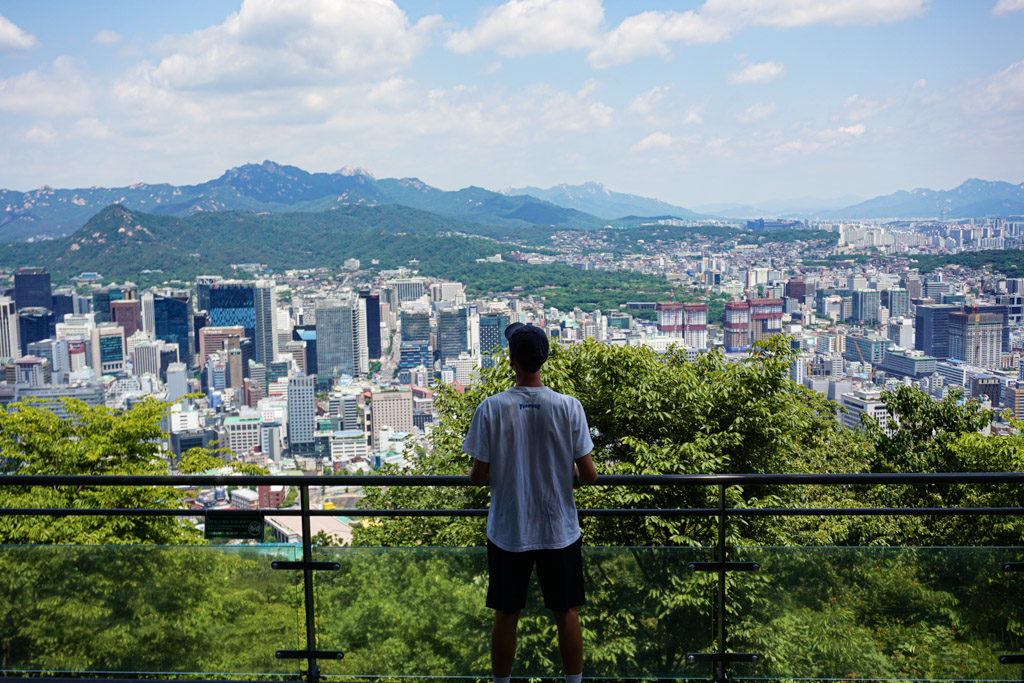
What to do in Seoul
There are many things to do in Seoul and you could honestly spend 2 weeks in South Korea just exploring the different areas of this capital city! We recommend 5 days or 5 nights in Seoul as this gives you the best amount of time to see what the city has to offer whilst not rushing around too much. Here’s a list of some of the activities to do in Seoul! (Also check out our 5 Day Seoul Itinerary travel guide here! )
Explore Insa-dong & Ikseon-dong
Insa-dong is one of our favourite neighbourhoods in Seoul. The area is filled with cosy restaurants, lovely teahouses and independent shops. The area is known for its historic art presence and you’ll also find galleries in between the alleys. If you’re hungry, enjoy a traditional Korean lunch or dinner at Osegye Hyang ( location ) in the beautiful streets of Insadong.
Nearby Insa-dong is Ikseon-dong – a hanok village full of trendy cafes, photo booths and cute shops! It’s a beautiful area to explore on your 2 weeks in South Korea itinerary.

Shop in Myeong Dong
Myeong Dong is the main shopping area in Seoul, there are luxury shopping malls, known fashion brands and so many cosmetic stores! The Myeong Dong Walking Street ( location ) is the main strip and you’ll find street vendors around this area too. It’s a great option for dinner or you can find one of the many restaurants in the area.
Check out some of Seoul’s Palaces:
- Changdeokgung
- Changgyeonggung
- Gyeongbokgung (highly recommend!)
- Gyeonghuigung
On your 2 week South Korea itinerary, we recommend visiting Changdeokgung & Changgyeonggung together as they are close together in the same park. The entry for Changdeokgung is 3000 won and Changgyeonggung is 1000 won. Changdeokgung served as the principal palace of multiple Joseon kings for over 250 years!
Another palace that’s definitely worth a visit is Gyeongbokgung – one of the most beautiful palaces in Seoul. It was the main royal palace of the Joseon dynasty and was built in 1395. The gardens are also beautiful to walk around.

Rent a Hanbok in South Korea
To make your visit to a palace even more special, you can rent and wear a hanbok for a few hours. There are many rental shops in Seoul around palaces and hanok villages. We recommend wearing your hanbok in Gyeongbokgung Palace as it’s the perfect size to explore and there’s a great rental shop nearby! Find the link on Klook here – Hanbok Rental Klook
Bukchon Village
Bukchon Hanok Village is a traditional Korean village with over 900 preserved homes. It’s the perfect area to visit at the beginning of your 2 weeks in South Korea to experience South Korean culture. Here’s the location for the area – Bukchon Village Location !
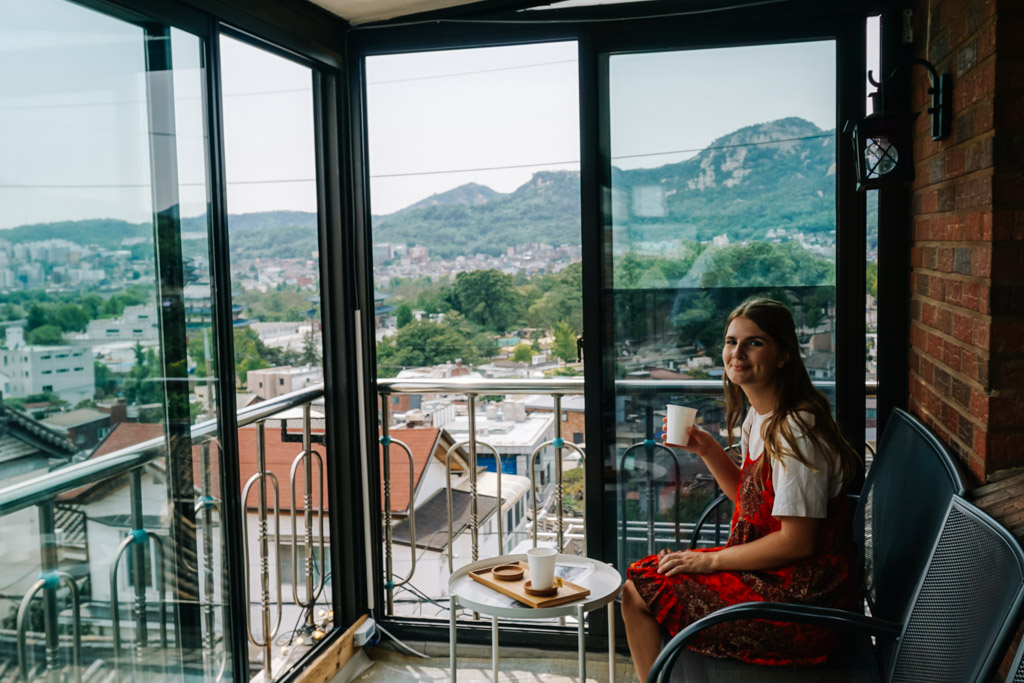
Namsan Park & Seoul Tower
Visiting Namsam Park is one of the best places to visit in South Korea! It should definitely be on your 2 week South Korea itinerary and it’s the perfect spot to view all of Seoul! It will take 30 minutes to 1 hour to reach the top of the park and it’s a relatively easy climb up to the top.
After admiring the views at the top of the park, you can go even higher and go to the top of Seoul Tower! Tickets are really affordable on Klook – so make sure you buy your ticket in advance! They don’t sell out and it’s an open ticket for whichever day you want to go on your South Korea route.
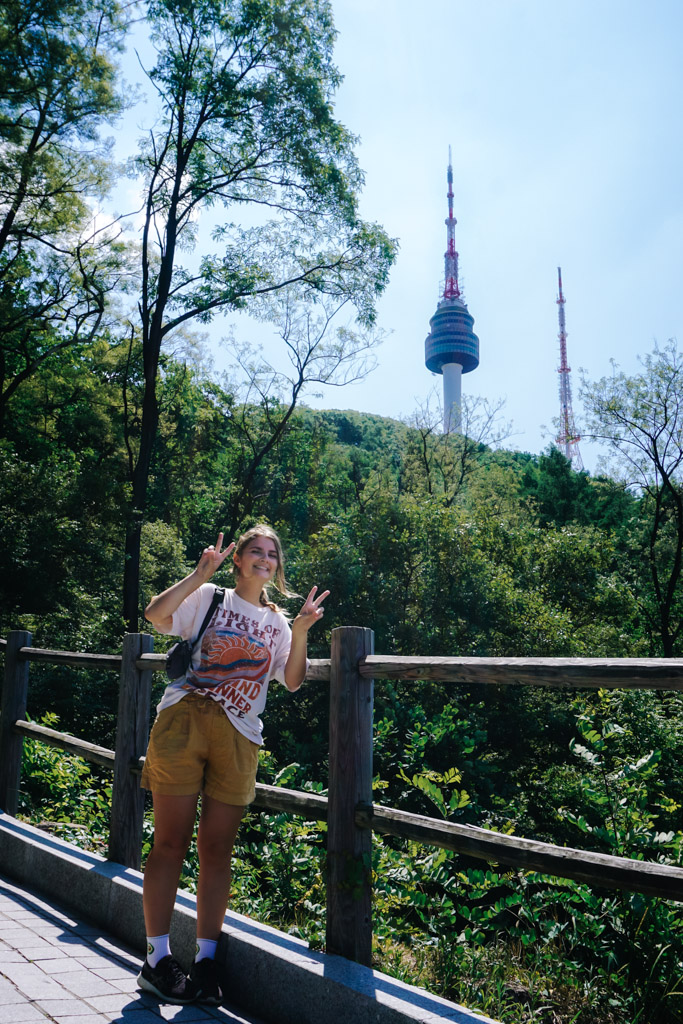
Visit Hongdae, Itaewon & Gangnam
All in different areas of Seoul, these three neighbourhoods along with Insadong and Myeongdong are some of the best places to visit in Seoul. Hongdae is one of the hip and trendy areas of Seoul, with many shops, restaurants and themed cafes. It’s also a great spot for nightlife alongside Itaewon.
Itaewon is right at the base of Namsan Park and it’s the place to go if you want to see the foreign area of Seoul – there are many international restaurants, shops and bookstores here! We recommend Plant Cafe Seoul ( location ) for lunch here!
You may have heard of the song ‘Gangnam Style’ and it’s actually a neighbourhood in Seoul – one of the wealthiest neighbourhoods in the country! The best spots to visit in Gangnam are Gangnam Shopping Street & Starfield Library Location .
Learn about the history of the Korean war and visit the Demilitarized Zone of Korea! It’s an important part of their country and you also get the chance to see a view of North Korea. You can only do this with a tour – book tickets with Klook here !
There’s also an Eland Hangang River Cruise to make your 2 week South Korea itinerary more unique! You can also day trip to Nami Island for a journey into nature.
5 Day Seoul Itinerary Breakdown : Day 1 – Insadong, Ikseon-dong & Myeong Dong / Day 2 – Changdeokgung, Changgyeonggung, Bukchon Village & Hongdae / Day 3 – N Seoul Tower & Itaewon / Day 4 – Gyeongbokgung, Hanbok, Naksan Park & Gwangjang Market / Day 5 – Seoul Forest & Gangnam
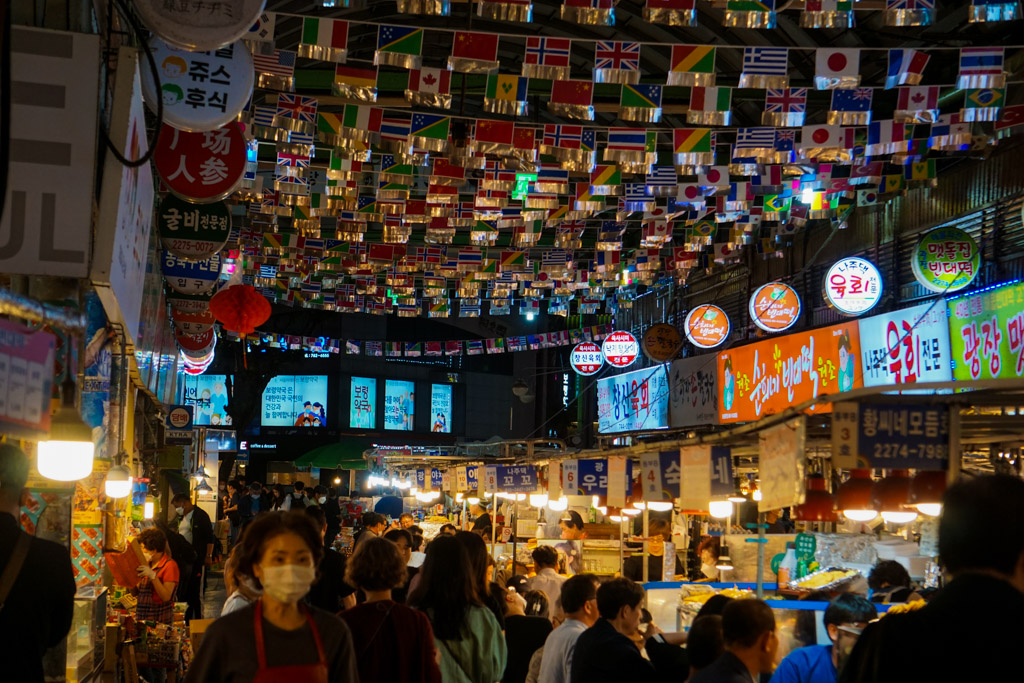
Where to stay in Seoul
Best area to stay in Seoul: Insadong, Myeongdong, Hongdae, Itaewon & Gangnam
Hostel Tommy $-$$ (Insadong) – This location is perfect for a first-time visit to Seoul. It’s close to the hanok villages, royal palaces, trendy cafes, restaurants and convenience stores. Located minutes away from a metro station to take you anywhere in the city. The hostel has dorms and private rooms to suit each traveller and there’s a common area with a kitchen! Find the link to Booking.com here – Hostel Tommy Booking.com
Where to eat in Seoul
Osegye Hyang $ (Insadong) – Traditional Korean vegan restaurant ( location ) Maru $ (Insadong) – Vegan street food ( location ) Gwangjang Market (Stall A11) $ (Jongno 5) – Vegan options at the famous market ( location ) Plant Cafe Seoul $$ (Itaewon) – International vegan cuisine in Seoul ( location ) ( website )
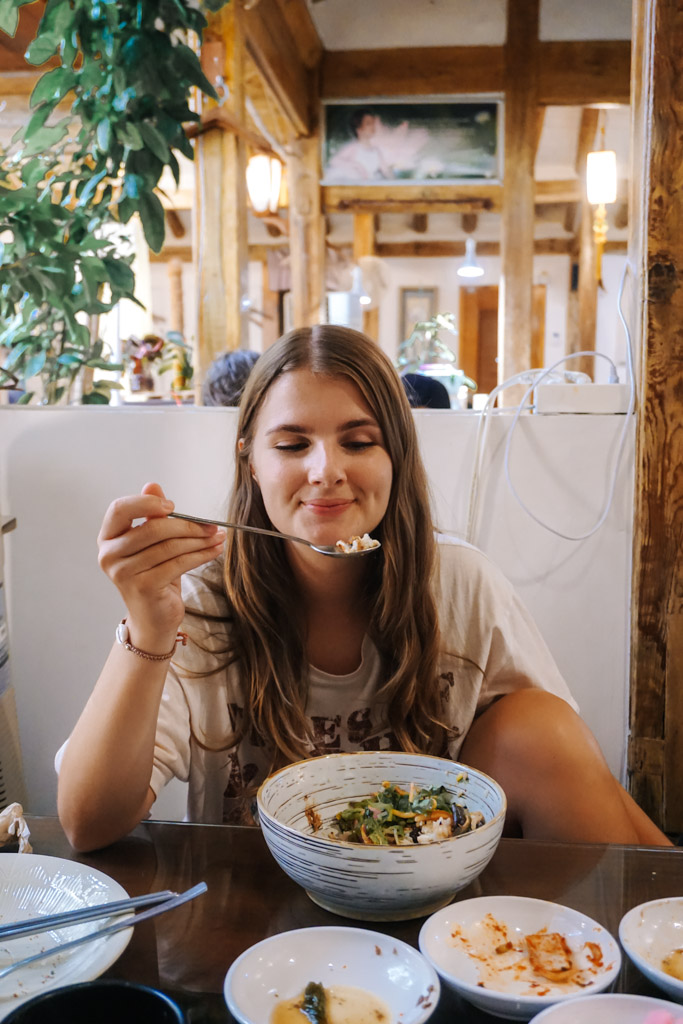
Day 5 – 6 | Golgulsa Templestay
‘ Templestay ‘ is a unique cultural programme in South Korea. There are many Buddhist temples in the country that allow guests to stay overnight and join in activities and meditation. It allows visitors to experience the life of Buddhist monks in Korea and they’re all so welcoming. Want to add this to your South Korea 14 day itinerary?
How to get to Golgulsa Temple from Seoul
KTX – You can book your train tickets online here – Korail Train Tickets and get a Korea Rail Pass if you’re planning to travel more of South Korea by train. Once you have your ticket head to Seoul Station and get on your train to Singyeongju Station (around 2 hours) The KTX will cost around 45,000KWR for a one-way ticket.
Once you’ve reached Gyeongju , you can catch a bus (150 / 100 / 100-1 around 50 minutes) to the Andong bus stop and then it’s a 15-minute walk to Golgulsa Temple. It’s also possible to get a taxi to the temple from Gyeongju which is faster.
Another option would be to take a bus or car ! Bus – Head to Express Bus Terminal and get a bus to Gyeongju Express Bus Terminal . It will take around 4 hours and is usually cheaper than the KTX. A car is also a great option to get to Golgulsa Temple as the temple has lots of parking spaces.
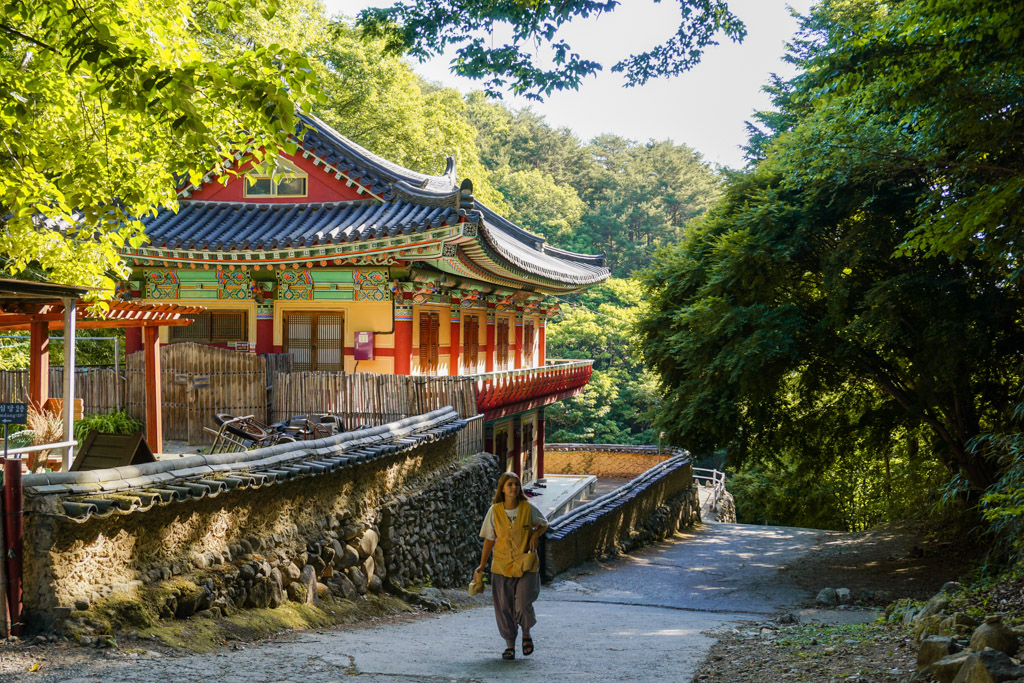
What to do at Golgulsa Templestay
As the Golgulsa Templestay is a programme – there will be certain schedules for weekdays and weekends. It’s completely optional to do any of these activities, but all of them are included in your Templestay experience.
Sunmudo Performance
One of the reasons why Golgulsa Temple is so unique is due to its teaching of Sunmudo. It’s a Korean Buddhist martial art involving strength and patience. The first activity you’ll do on arrival is to watch the Sunmudo Performance and it’s so beautiful.
You can also find out more here – Golgulsa Temple Sunmudo Website .
Sunmudo Training
Now it’s your turn to train like a Buddhist monk (it’s super hard!). If it’s summer, you’ll honestly break a sweat but these activities are so fun! One of the monks here at Golgulsa Temple showed us all the techniques they use to train on a daily basis and the strength he has because of this training.
108 Prostrations (Bows)
Buddhists bow 108 times to purify the body and free themself from the 108 defilements. During your Templestay in Korea, it’s possible to join in with these bows. It’s a beautiful experience to watch.
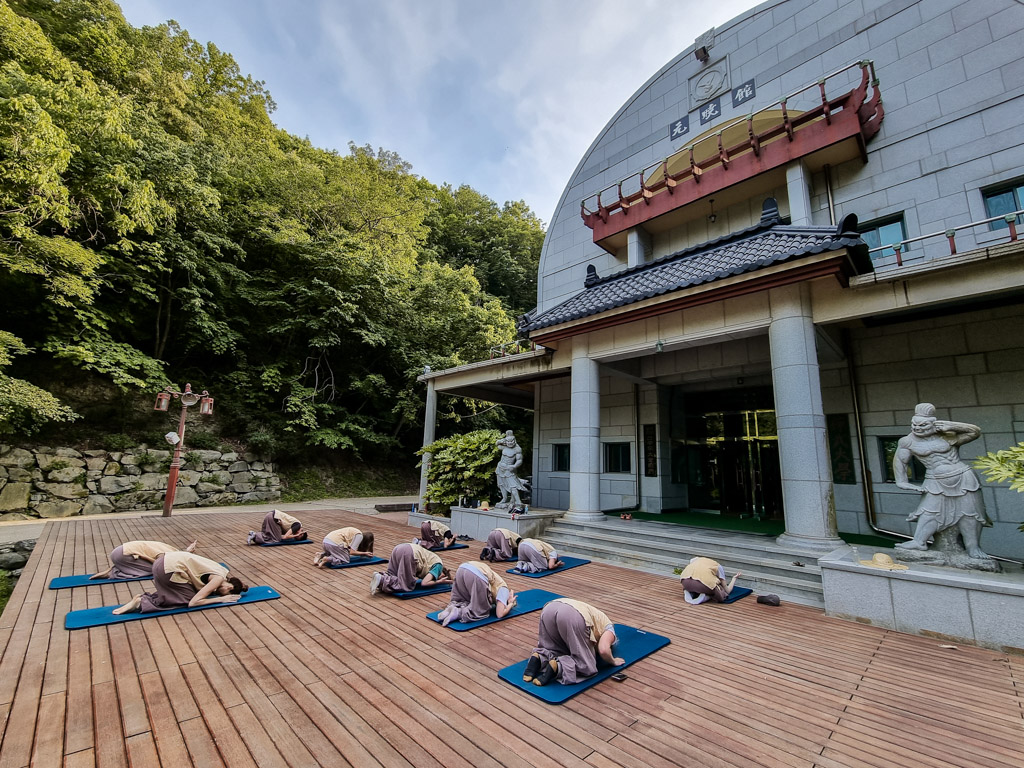
Morning Chanting Service & Meditation
After learning how to meditate with the monks, you’ll be waking up at 5 am to join in with the morning chanting service and meditation. It’s so peaceful at this time of day and a really great way to start your day. Don’t worry you’ll have time to sleep again after breakfast.
Trekking & Hiking at Gampo Beach
On weekends at Golgulsa Templestay, they take visitors on a hiking and meditation adventure. We visited Gampo Beach and meditated on the beach. It was also great to meet other visitors and locals who did the Templestay programme.
How to book a Templestay in South Korea?
The best way to book a stay at Golgulsa Templestay is through their website – Here’s the link for Golgulsa Templestay Reservations . The price is 60,000KRW per night, per person. (30krw for a pre-schooler)

We use a Joby GorillaPod 3K Pro Kit to take photos of us together on our camera, it’s so useful especially when there’s no one around! There’s also a version for a phone – Joby Phone Tripod to get the best photos on your 2 weeks in South Korea!
What is the food like at Golgulsa Templestay?
Included with the price are 3 meals – breakfast, lunch and dinner! This will be Buddhist Korean temple food which means strictly vegetarian (almost all vegan!) It’s likely you’ll have rice for all three meals with kimchi and other vegetables, it’s a really good choice of food and you can pick the food yourself.
We 100% recommend Golgulsa Templestay and if you have the time on your 2 weeks in South Korea itinerary, we would even spend 2 days. Although one night is enough to experience the lifestyle.
Day 6 – 8 | Gyeongju
Gyeongju is a museum with no walls . It was the residence of Silla rulers for over 1000 years ! It’s one of the best cities to visit in South Korea for its many archaeological sites. The remains sites and tombs from this time frame have been preserved, which makes Gyeongju a place to learn. It’s definitely a great spot to add to your 2 week South Korea itinerary!
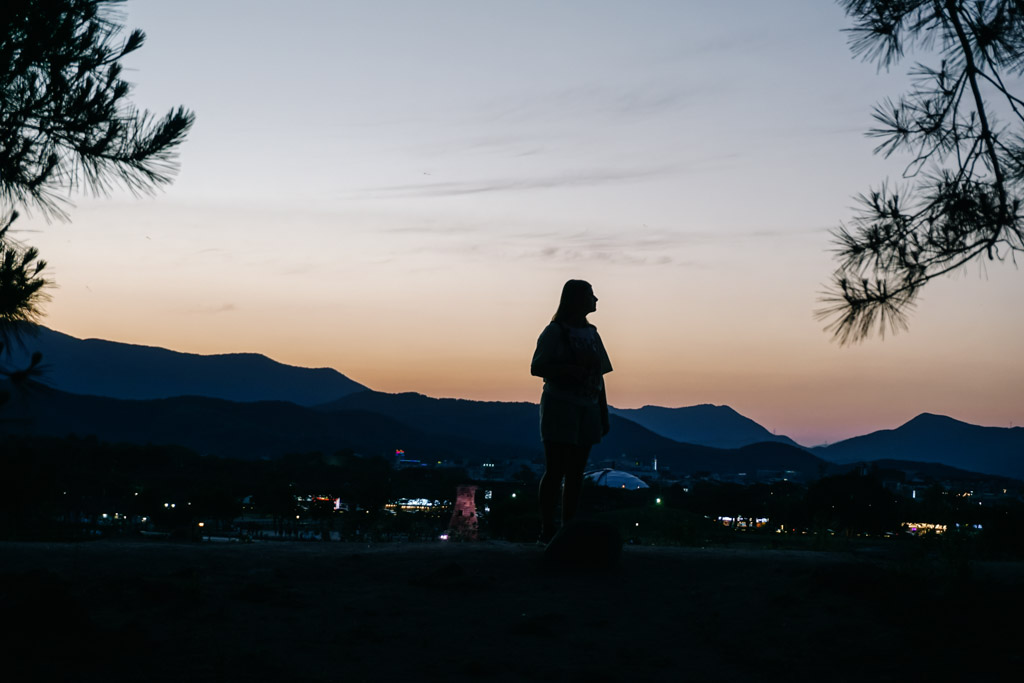
How to get to Gyeongju from Golgulsa Temple
There’s a high chance you passed through Gyeongju to reach Golgulsa Temple. If you arrived at Golgulsa Temple by bus, then you can simply follow the same way back to the city. Head to the Andong bus stop (a 15-minute walk) and then wait for a 1 50 / 100 / 100-1 , it should take around 50 minutes to get to Gyeongju city.
What to do in Gyeongju
There are many things to do in Gyeongju as part of your places to visit in South Korea itinerary – for a more in-depth guide check out of 11 Best Things to do in Gyeongju with lots of details about visiting the city.
Woljeonggyo Bridge
This beautiful bridge was built during the Unified Silla period (AD 676-935). It was burned down after this time frame and in April 2018 it was rebuilt. It’s now considered the biggest wooden bridge in South Korea. It’s also free to visit, like most things in Gyeongju.

Daereungwon Tomb Complex
An interesting way to spend your 2 weeks in South Korea is to visit Daereungwon Tomb Complex – an ancient burial site with 23 tombs. Cheonmachong Tomb is the most famous as you can see inside the tomb! There’s a lot of information and artefacts inside. The complex is 3000 won for entry.
Donggung Palace and Wolji Pond
In the Silla Kingdom times, Donggung Palace and Wolji Pond was an important palace and banquet hall for guests. It was abandoned in 1935 when the Silla Dynasty ended. However, in 1963, South Korea listed the palace as a historical site and it was beautifully renovated.
The best time to visit Donggung Palace and Wolji Pond is after sunset as the Palace glows up gold! It’s a magical place to see on your 2 week South Korea itinerary.

Cheomseongdae
Add Cheomseongdae to your South Korea itinerary if you want to see one of the oldest astronomical observatories in Asia ! It was built in the kingdom of Silla and used exactly as an observatory – to collect information on the galaxy. Check out Gyerim Forest if you’re in the area, it’s a great spot for sunsets.
Hwangnidan-Gil
This trendy street is filled with the coolest shops, the cutest cafes, teahouses and more! It’s one of the best places to find clothes and snacks in Gyeongju.
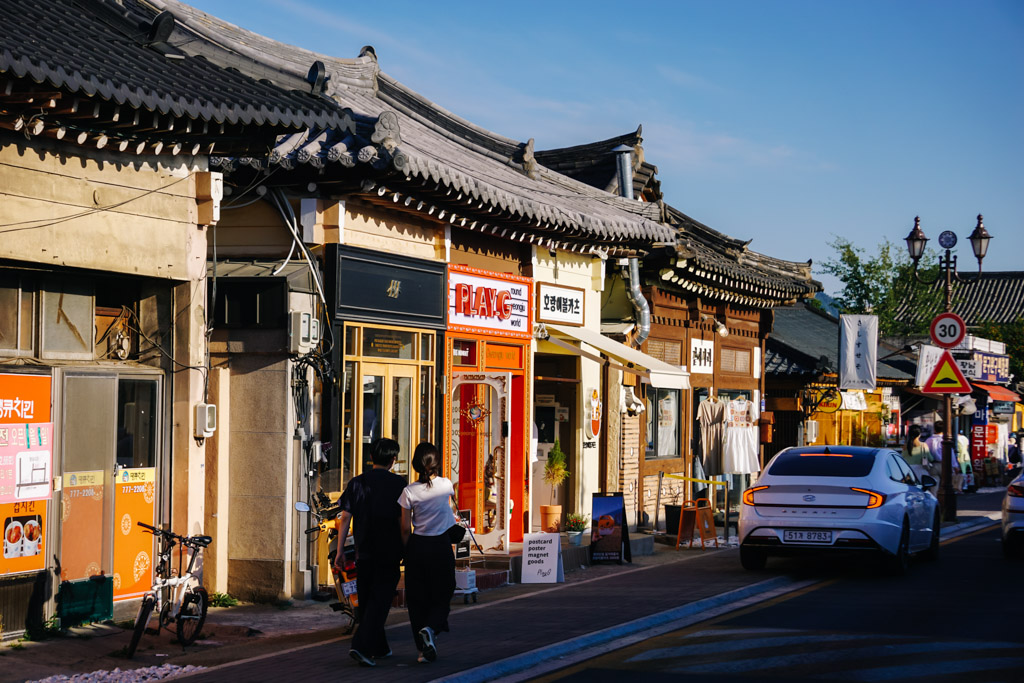
Where to stay in Gyeongju
We recommend staying in Hwangnam-dong and Noseo-dong . These areas are both close to many great sites in Gyeongju and there will be options for any budget. Bomun Tourist Complex area is also a good place to stay if you’re visiting Gyeongju World!
Doobaki Guesthouse $-$$ – Dorms & Private Rooms – We highly recommend Doobaki Guesthouse, it suits every traveller and there’s a big common area with a kitchen, games and the cutest cat! – Find here on Booking.com!
Dorandoran Guesthouse $-$$ – This guesthouse is also in a great location in Gyeongju and includes complimentary breakfast. – Find here on Booking.com !
Where to eat in Gyeongju
Top Market (Grocery Store) – Vegan instant ramens, bread, fruits & veggies! Baru $-$$ – A little out of the city centre, but a great spot for Vegan Korean food!
Day 8 – 11 | Busan
Busan is another must on your South Korea itinerary 14 days route! It’s the perfect spot to spend a few days and experience the city by the sea. There are many markets, skyscrapers and hikes to do here. Let’s explore more on your 2 weeks in South Korea itinerary!

How to get to Busan from Gyeongju
The best way to get from Gyeongju to Busan is by KTX or Bus – We recommend getting the bus because the Bus station is in the centre of Gyeongju, whilst the train station is a bus ride away. The bus will drop you off at one of Busan’s 4 bus terminals, and you can use public transport to make your way to your accommodation. It takes less than 1 hour by bus.
What to do in Busan
Here are a few of the best things you can do in Busan to fill 3 days! Some of the best places to visit in South Korea are located in this city, including amazing beaches! Check out the Visit Busan Pass if you plan to do a lot of activities in Busan.
Gamcheon Culture Village
Another must-visit on your 14 day South Korea itinerary is Gamcheon Culture Village! It’s also one of the best places to visit in South Korea and Busan.
Gamcheon Village has come a long way since the Korean war when it was populated with some of Busan’s poorest residents. After a time, the Tourism Board of South Korea chose to bring the village to life with art and soon after it became a beautiful attraction with cute cafes and trendy shops.
It’s free to enter – but you can buy a map for 2000 won which helps you find your way through the maze-like village.

Igidae Coastal Walk
If you’re looking for a long coastal walk for your 2 week South Korea itinerary, Busan is the place to be. The Igidae Coastal Walk will last between 1-3 hours and you don’t have to commit to the whole length as there’s many exit and entry points.
The walk itself is breathtaking with views of Busan, the ocean and wildlife along the way. A fun free activity on the north side of the walk is the Oryukdo Skywalk – a glass bridge with views of the rocks and ocean.
A short bus ride away from Gamcheon Culture Village is Nampo-dong – one of the coolest areas of Busan. There are many things to do in this area, including markets, bars, restaurants and shopping!
- Markets in Nampo – Jagalchi Fish Market & Gukje Market
- Gwangbokdong Food Street – The street food in Nampo comes alive at night!
- Biff Square – Another spot for street food and the annual film festival

Sunset at Lotte Department Building
The best spot for free views of Busan! Head to the Lotte Department Building and go up to the highest floor, from there you will find the garden and rooftop with views of all of Nampo and the iconic Busan Tower. It’s another great idea for your 2 week South Korea itinerary.
Also check out a visit to Lotte World in Seoul and Busan – one of South Korea’s best theme parks!
Busan Tower
Busan Tower is very famous for making up the Busan skyline. The views are very beautiful from the tower but similar to the department building. The entry price is 12,000 won to go up the tower.
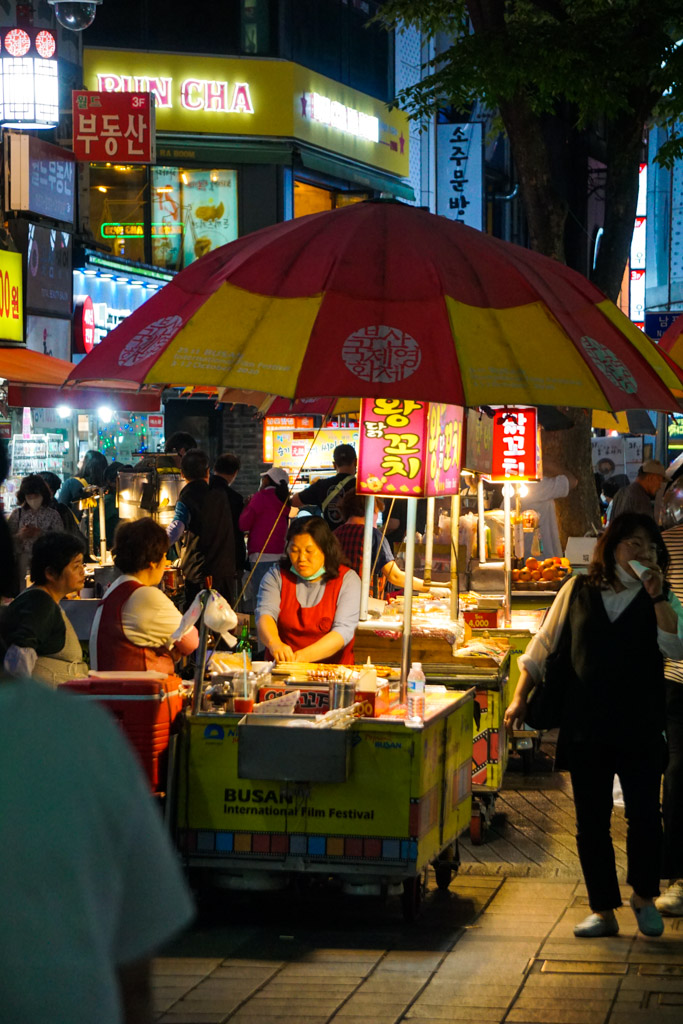
Evening in Seomyeon
Seomyeon is the central hub of Busan, it’s well-connected to all transport and you’ll definitely pass through here a few times on your trip. The area is filled with food, shops and even arcade games for you to spend a great evening on your South Korea route.
Another evening activity is the Busan Night Tour to see the magical Illumia Park.
Haedong Yonggung Temple
On your South Korea route, head to Haedong Yonggung Temple – a temple located on the amazing coast of Busan. It was built during Goryeo Dynasty in 1376 and it’s known to be one of the most beautiful temples in South Korea. It’s also free to enter!
It’s easy to reach Haedong Yonggung Temple by public transport such as metro and bus. It takes around 1 hour from Seomyeon. Use NaverMaps for the exact directions.
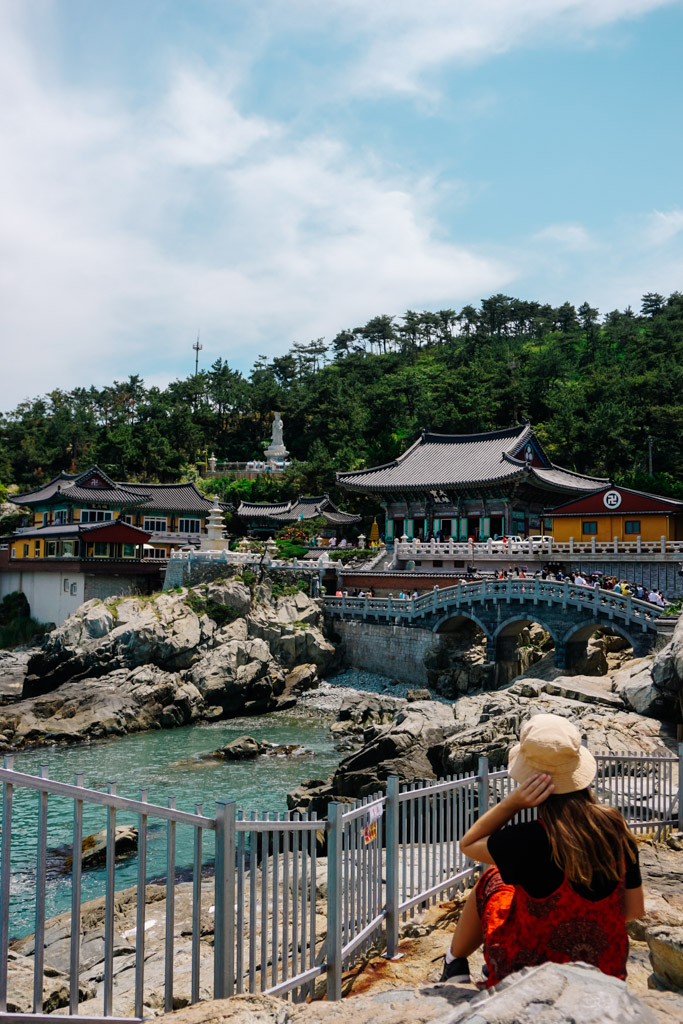
Relax at Haeundae Beach
Also on the east side of Busan is Haeundae Beach – one of the most popular beaches in Busan! Depending on the season, you’ll have different experiences at the beach. In the summer there’s many crowds but the opportunity to see festivals such as the sand festival !
There’s a long seafront to walk along with many restaurants and you can enjoy this in any season! Also check out the Haeundae Markets too! Check out BUSAN X the SKY for incredible views from the skyscrapers in Haeundae! Find tickets on Klook here .
3 Day Busan Itinerary Breakdown : Day 1 – Gamcheon Village & Nampo / Day 2 – Temples & Beaches / Day 3 – Coastal Walk & Seomyeon
Where to stay in Busan
We recommend staying in Seomyeon if you have a few days in Busan as it’s well-connected to all the great things to do in the city. There’s enough going on to enjoy your evenings after a day of exploring. Other areas to stay in are Nampo, Haeundae and Gwangan .
Dynamic Guesthouse $-$$ (Seomyeon) – Feel like a local and stay in an apartment block in Seomyeon! Located on the 36th floor are two penthouse apartments split into rooms – one of the coolest places we’ve stayed in! Find Dynamic Guesthouse on Booking.com here !
Plea De Blanc Hotel & Residence $-$$ (Haeundae) – A great place to stay during summer in South Korea. Find Plea Blanc Hotel & Residence on Booking.com here !
Where to eat in Busan
Dajeon $ (Seomyeon) – Some of the best bibimbaps! Soban Vegan Restaurant $ (near Gamcheon) – Go here for the vegan fried chicken! Doko – Dosi Nongga Cafe $-$$ (Seomyeon) – Bakery with vegan options !

Day 11 – 13 | Jeonju
On your last few days before heading back to Seoul, take the time to explore Jeonju – another great weekend trip away from Seoul! Back in 892 to 936, Jeonju was the capital of the Hubaekje Kingdom. We’ll show you why Jeonju is worth a visit and the best things to do in this lovely city.
How to get to Jeonju from Busan
Using public transport is the best way to get from Busan to Jeonju! We recommend taking the bus as it’s direct compared to the train. Head to Busan Central Bus Terminal and catch a bus heading to Jeonju, it should take around 3 hours.
Sometimes these buses can be busy and sell out, so if you want a certain bus make sure to book online (if you have a Korean number) or book ahead on your first day in Busan at the same station.
The bus is direct and drops you off at Jeonju Bus Terminal . From the bus terminal, you can take another bus to the traditional Hanok village. Use Naver Maps to double-check your directions!
Alternatively, you can take the train, however, you’ll need to change at Osong Station and it takes almost around the same time as a bus (which is usually cheaper!)

What to do in Jeonju
Jeonju is a very popular spot for locals so you’ll find a lot of souvenirs, cute cafes and you can even rent these tricycle-style vehicles to get around the city. Renting a hanbok is another popular activity here as every spot is so photographable! Jeonju is definitely worth a stop during your 2 weeks in South Korea, even if it’s for just one night.
Explore Jeonju Hanok Village
At this point, you would have seen many hanok villages on your 2 week South Korea itinerary. You don’t definitely won’t be bored of them at this point as the one in Jeonju has the largest hanok village in South Korea! It’s ultimately one of the main reasons Jeonju is a popular visit.
Explore the village in your own time and there are many cafes and teahouses around to spend some time.

Also look at 25+ Best South Korea Travel Tips: What to Know Before Visiting !
Jaman Mural Village
Another beautiful village to explore is the Mural Village just to the east of the hanok village. Since the Korean War when the buildings were rather dull, Jeonju decided to revamp them! Art such as colourful murals have made this place an attraction and even galleries have now opened in the area.
Gyeonggijeon Shrine
Gyeonggijeon Shrine is important in Jeonju and South Korea as it holds the portrait of King Tae-jo – the inventor of the Joseon dynasty. There are actually a few portraits of King Taejo that are preserved here. It’s an interesting spot to visit on your 2 week South Korea itinerary.
Nambu Market
This market is big! It’s possible to find almost anything here from food to household items and clothes to souvenirs. There’s a night market every Friday and Saturday, but it’s also open during the daytime all week.
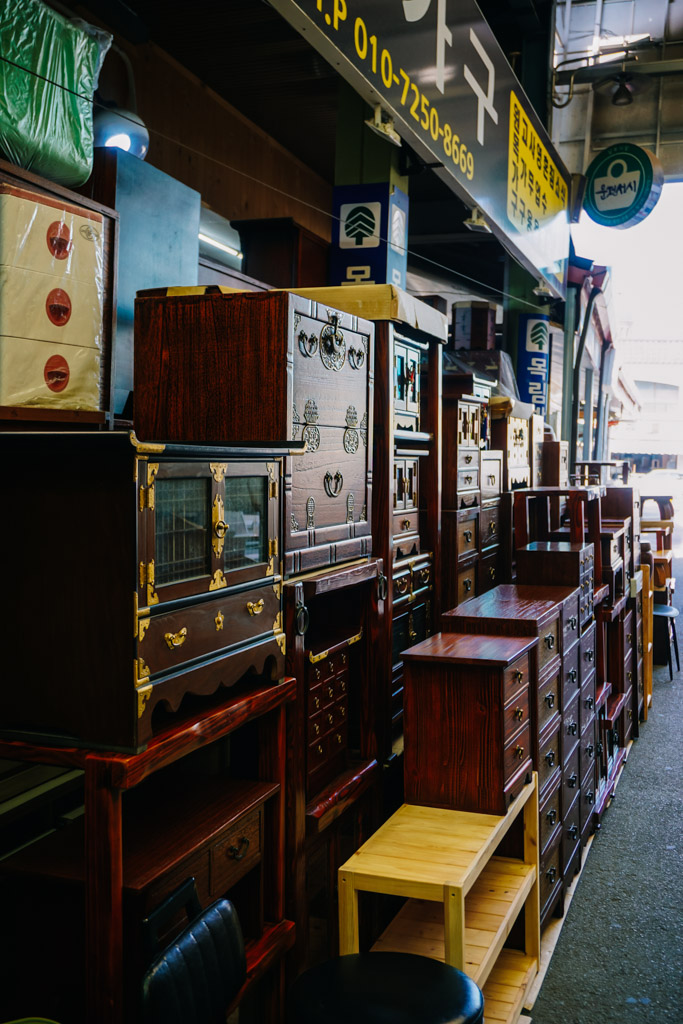
Jeondong Cathedral
Right next to the traditional Hanok village is the Old Cathedral of Jeondong – an important Catholic church in Jeonju! It was built in honour of Roman Catholics who lost their lives in the Joseon dynasty. The church was designed by Priest Poinel, who also designed Seoul’s Myeongdong Cathedral. They look quite similar too!
See the views from Omokdae
A short hike up this hill will reward you with views of the hanok village and part of Jeonju city in the background. It’s totally worth it at any time of day or season!
Where to stay in Jeonju
The best place to stay in Jeonju is around Jeonju Hanok Village. It’s very popular to stay in a traditional hanok when visiting Jeonju – and that’s exactly what we did! When browsing the internet we found many options for anyone’s budget and luckily found Jungdam that fit our budget.
Jungdam $-$$ – Right in the heart of the traditional Korean village. Jungdam is a hanok home split into many rooms for guests to come and enjoy the experience. They provide the best Korean breakfast in the morning – even suitable for vegans! Find here on Booking.com !

Where to eat in Jeonju
Jeonju is the birthplace of bibimbap! Try bibimbap from any restaurant in Jeonju to feel the authentic touch. If you’re after vegan options, here’s what we recommend!
Plantica $-$$ – The best Korean-inspired sandwiches with cakes & drinks! Pool $-$$ – Great spot for vegan Japanese food in Jeonju!
Day 14 | Seoul
Now you’re back in Seoul for the last night of your 2 week South Korea itinerary! After an incredible trip, you can tick off a few things you didn’t get a chance to do. Maybe revisit a favourite restaurant or neighbourhood? It’s completely up to you!
We spent our last day playing arcade games in Hongdae and eating at Osegye Hyang $ (Insadong) – Our favourite traditional Korean vegan restaurant in Seoul ( location )!
How to get to Seoul from Jeonju
The best way to get from Jeonju to Seoul is by bus or train! Again, we recommend the train as it’s a little less expensive and only takes 2 hours and 40 minutes. You can buy your bus tickets as soon as you arrive in Jeonju at Jeonju Bus Terminal . When you arrive in Seoul, there will be many public transport options for you to grab to get to your accommodation!
Interested in getting a Korea Rail Pass ? Check out tickets on Klook for a demonstration on how to book tickets and an easy way to receive your pass!
Where to stay in Seoul before leaving
For your last night in Seoul, you can choose anywhere that’s close to a metro line that gets to Seoul Station . If it’s available you can stay in the same place as your first time in Seoul or pick a new neighbourhood! Hongdae is another great place to stay as you can get the AREX Express from Hongik Univ Station .
Hostel Tommy $-$$ (Insadong) – We still recommend Hostel Tommy as his hospitality was amazing! It’s a great spot for 5 nights or 1 night in Seoul. It has easy connections to the airport via the metro and Seoul Station. Find the link to Booking.com here – Hostel Tommy Booking.com

2 Weeks in South Korea Itinerary Breakdown
Seoul – 5 nights, Golgulsa Templetsay – 1 night, Gyeongju – 2 nights, Busan – 3 nights, Jeonju – 2 nights & Seoul – 1 night!
Other Places To Visit in South Korea
Jeju Island – Jeju Island is the best vacation for those living in South Korea. It’s filled with nature, hikes and fresh air! You can reach Jeju island by flight from Seoul or Busan. It’s highly recommended to rent a car or motorbike whilst you’re here as the transport can take a while. However, if you have 4-5 days on the island it’s totally possible to have a great time with public transport. (We’d love to visit Jeju Island in the future on another South Korea trip!)
Seoraksan National Park – Another great escape from Seoul is Seoraksan National Park (Sokcho). It’s possible to visit here on a 2 week South Korea itinerary. If you’d like to fit it into this South Korea route, take off 1 night in Seoul and travel by bus early morning on one day and late afternoon the following day. The hikes here are pretty impressive, but possibly not for beginners.

How do I plan a 2 week trip to South Korea?
Now that you’ve read our 2 week South Korea itinerary, it’s time to truly start planning your trip! Start with focusing on what you really want to get out of your Korea trip.
As entry requirements are still around, please double-check if you’re eligible to enter the country! Also, check if you’re eligible for a visa in South Korea. Other than that, if you use this exact 2 weeks in South Korea itinerary, the first step:
- Check for any national holidays on your date of visit ( check here! )
- Quick check if places of interest are open ( sometimes things are closed on Mondays! )
- Book your flights ( check prices here! )
- Book your accommodation ( book here! )
- Book your templestay ( book here! )
- Book any trains you want to take ( book here and take a look at the Korea Rail Pass )

Is 2 weeks in South Korea enough?
Yes! 2 weeks in South Korea is the perfect amount of time to see the best places to visit in the country. We’ve created our 2 week South Korea itinerary at a good pace, so you don’t have to rush around every 2 days. We wanted to minimize our flights at the time, which is one of the reasons we didn’t visit Jeju Island, however, it’s totally possible on a 2-week trip!
Must-Try Foods in South Korea (Vegan edition!)
- Bibimbap (rice bowl with veggies!)
- Vegan Korean Fried Chicken (vegan chicken coated in a sweet bbq like sauce)
- Gimbap (similar to sushi)
- Tteok-bokki (rice cakes in a spicy tomato like sauce)
- Kimchi (there are many vegan-friendly versions around Korea)
- Baked Sweet Potato (the best street snack, sometimes covered in sugar)
We also have a Vegan in South Korea Guide – Best Restaurants & Snacks (2024) !

How much to budget for 2 weeks in South Korea?
We visited South Korea knowing it should be less expensive than the UK – and it is! It’s also slightly less expensive than in Japan. Here’s our average daily budget for 2 weeks in South Korea – South Korea Travel Costs (2024) .
How can you save extra money? Choose restaurants that aren’t so expensive, shop at convenience stores more often and stay in private rooms in hostels! Take buses over trains (although maybe treat yourself to one!)
Check out our 10 Best South Korea Budget Tips + Travel Costs (2024) !
What to pack for 2 weeks in South Korea?
This really depends on the season that you visit – if it’s winter, bring thermals, gloves and a hat. If it’s summer you may want to bring a raincoat or umbrella! Here are a few we can’t travel without:
- Stainless Steel Water Bottle – Our metal water bottles have been our side throughout it all! They are easy to clean and are better than plastic! Bring one along for your 2 week South Korea itinerary.
- Worldwide Travel Adaptor – The number one plug to have when travelling to different countries. It has one international plug and 4 USB slots to charge your gadgets at the same time.
- Amazon Basics Packing Cubes – We always travel with packing cubes and even use them at home!
- Anker Power Bank – A portable charger is always useful for those journeys around South Korea!
- Rain Mac in a Bag – A lightweight raincoat to help with tropical rain or light spring rain, we also have a backpack cover to stop our clothes from getting wet in our backpacks.
- Joby GorillaPod 3K Pro Kit – GorillaPods are a great little tripod to carry on a South Korea trip, they’re lightweight and can fit in a carry-on bag. They capture some of the best photos when there’s no one around to take a photo of you. We love our Joby GorillaPod and use it for our Sony A600 . There’s also a version for a phone – Joby Phone Tripod .
- Osprey Farpoint 40l Backpack – One of Dan’s favourite pieces of gear, perfect for long or short journeys. Better yet, it’s aeroplane carry-on compliant!
What to do after visiting South Korea
Japan – Whilst you’re in this area of the world, why not visit South Korea’s neighbour – Japan! You can find flights from Seoul or Busan that take you straight into many amazing areas of the country. Check out our Ultimate 2 week Japan Itinerary (2024) The Best Places !
South East Asia – This region of the world is filled with budget-friendly locations with beautiful beaches, mountains, culture and more! After South Korea, you may want to visit Thailand and have a relaxing vacation.
More South Korea guides:
- 5 Day Seoul Itinerary – Best Things To Do (2024)
- Staying in Golgulsa Temple: The Best Templestay in Korea (2024)
- 25+ Best South Korea Travel Tips: What to Know
- 3 day Busan Itinerary: What to do in Busan (2024)
- 11 Best Things to do in Gyeongju: Itinerary (2024)
- Ultimate South Korea Bucket List: 20 Best Things To Do
- Vegan in South Korea Guide – Best Restaurants & Snacks (2024)
- All our South Korea posts!
That’s the end of our Ultimate 2 week South Korea Itinerary: Best Places (2024)! Have the best trip to South Korea and if you need any more help planning – send us a message on Instagram (@thesunrisedreamers) or leave a comment below!
LIKE THIS POST? PIN IT FOR LATER & SHARE IT WITH OTHERS!

Don’t forget about Travel Insurance! – SafetyWing Nomad Insurance
SafetyWing is a totally flexible monthly-rolling travel insurance to help you stay safe on your trip anywhere in the world. Find out more here!
Amy & Dan are the founders of The Sunrise Dreamers. They are travellers from the UK who have been on the road since 2017 whilst living in places like England, Canada, Thailand and the Canary Islands. They share their knowledge of travelling the world with detailed travel guides and tips. They're experts in vegan travel and show their audience how to travel on a budget.
Similar Posts

Moalboal Itinerary: The Best Things To Do (2024)
Planning a Moalboal itinerary in 2024? You’re in the right place! Moalboal is the best place to base yourself to…

3 Day Koh Samui Itinerary: The Best Koh Samui Guide
Wondering how to spend 3 days in Koh Samui? We’ll show you the best things to do on this beautiful…

Ultimate 2 week Japan Itinerary (2024) The Best Places
Planning a 2 week Japan itinerary? Here’s our ultimate guide on how to spend the best 2 weeks in Japan…

3 Day Koh Lanta Itinerary: Best Things To Do (2024)
Planning the perfect Koh Lanta itinerary? Here’s our in-depth travel guide to help you plan your trip to this beautiful…

4 Day Penang Itinerary: Best Things To Do (2024)
Are you planning a 4 Day Penang itinerary in 2024? Here’s our detailed travel guide with all the best things…

Southeast Asia Budget Guide: 2024 Backpacking Costs
Southeast Asia is the perfect destination for backpackers on a budget. From affordable accommodation, cheap food, and low-priced transportation, it’s…
10 Comments
Such a great itinerary, food & travel. Love the Jeonju Hanok Village photo 🥰
Thank you!!! 😀
This is amazing! I guess my trip for Seoul is planned! Thank you 🙂
Thank you so much! Have an amazing trip! 🙂
Hello, just curious how did you lug your luggages around between cities. Esp like to areas like the overnight stay in the temple and Jeonju?
Hey! We had backpacks for this trip but if you want to travel with suitcases, the public transport is great in South Korea, you won’t have to lug it around too much. If you have a late train/bus, ask your accommodation in advance if you can leave your luggage there for the day.
Thank you so much for writing all this up. I am adapting your itinerary and have 5 weeks to book everything before flying to Seoul. This guide is invaluable and will save me so much time. Wonder how much Hangul you could speak. Anyway, so grateful and glad I found your blog. Kudos!
Hi! Thanks so much for sharing this with us 🙂 I’m so happy you found this guide useful and that it will help you plan your trip to South Korea! We could only say Hello and Thank you, but that’s better than nothing haha!
Thanks for this amazing itinerary! Me and my friends are using it right now as a basis for our trip. We are now at Hostel Tommy and Tommy himself asked us to thank you for mentioning him and give you his regards. You’re welcome to stay for free if you ever return 😉
With kind regards, Laurens (and Tommy)
Hi Lauren, thank you so much for your lovely comment! It’s made my day – and thank you for passing over Tommy’s message, that’s so kind! I hope you’re having a great stay in Seoul and enjoy the rest of South Korea! So excited to go back one day 🙂 – Amy
Leave a Reply Cancel reply
Your email address will not be published. Required fields are marked *
Save my name, email, and website in this browser for the next time I comment.

Planning a Trip to South Korea: a Step By Step Guide
By: Author Kris
Posted on Last updated: March 28, 2023
Planning a trip to South Korea can be a difficult and overwhelming process but with our extensive guide, you will be able to breeze through all the steps required.
Keep reading for our tips, advice, and information on the best way to plan a trip to South Korea.
There is a really good chance that this post contains affiliate links. If you click one of them, we may receive a small commission (for which we are deeply grateful) at no extra cost to you.
Table of Contents

Why Visit South Korea?
If you are just starting out the planning process you may still be deliberating on whether South Korea is even the best place for you to visit.
We can help you finalize that decision with some of the best reasons to visit South Korea and why it is such a wonderful travel destination.
South Korea has an amazingly rich culture and long history.
There are many cultural sites to visit and incredible experiences, such as temples and palaces. This includes a number of UNESCO World Heritage Sites such as the Bulguska Temple and the lava tubes in Jeju.
The cities are full of unique modern designs and high-tech displays and shopping malls while beautiful nature and scenery are also easily accessible.
Whether you like beach activities, hiking, shopping, cultural experiences, or a mix of everything, there is something for everyone to enjoy in South Korea.
Here is a list of amazing things to do in Korea.
Best Time Of The Year to Visit South Korea
South Korea is very seasonal and the climate is the only thing that changes.
There can be large differences in available activities, recommended places to visit, and things to do depending on the season.

Spring
Spring is one of the most popular times to visit Korea and for good reason. The weather is clear, the temperature is moderate and flowers are blooming.
If you enjoy outdoor pursuits, this is one of the best times to be in Korea.
It is also the time of cherry blossoms, and if you time your visit right you could be treated to a magnificent display of pink and white blossoms.
However, the flowers aren’t limited to cherry blossoms, with flower fields across the country of plum blossoms, azaleas, and roses.
Spring can be cool at night and might be difficult for those who have bad hay fever or pollen allergies.

Summer
Summer in Korea can be very changeable with the monsoon season hitting in August.
It is also very humid in summer, so while the temperature isn’t too hot, the humidity can be difficult to deal with.
However, it can be a great time to visit if you plan on visiting some of the coastal areas or islands.
It can also be good for enjoying balmy evenings with casual outdoor eating and a relaxed holiday atmosphere as schools and universities are on summer vacation.

Autumn
Autumn is a beautiful time in South Korea with vibrant autumn foliage to be seen in many places. This time of year is ideal for hiking and climbing mountains.
It is also a good time to visit the many palaces populated by autumnal maple and ginkgo trees.
Autumn is also the time of Chuseok, the Korean harvest festival celebration.
Many Chuseok events are held during this time and can be a great way to have a unique cultural experience while in South Korea.

Winter
Winter in Korea can be very cold, with temperatures reaching negative and snowstorms.
However, it is also a beautiful time of year if you enjoy the winter scenery. The snow-topped mountains can be very picturesque and it is great for skiing, snowboarding, and other winter activities.
Winter is also the time of the Lunar New Year celebrations, which can be easily enjoyed as a cultural experience.
It is also the time of Christmas and western New Year, which can be interesting to experience in a different country and culture than your own.

How Many Days In South Korea?
An essential part of planning a trip to South Korea is deciding how long to spend there.
Finding the balance between too short and too long can seem difficult, especially without already having experience in Korea.
Luckily, a visit to Korea can be quite versatile, depending on where you plan to visit.
Longer is generally better, as it will give you more time to visit different cities, take various day trips and see more of the country.
However, it is easily possible to have a short trip and just stick to one city.
An example of this is covered in our 4-day and 3-7-day Seoul itineraries.
If you have a bit longer in the country, you can visit cities such as Busan, and utilize our Busan itinerary .
A longer itinerary can also allow for taking more time in each location and having more downtime.
The range of places to visit and things to do means it is unlikely that you could run out of things to do, and the variation from traditional temples to modern shopping malls, palaces to theme parks, means it is unlikely to become repetitive.
In summary, the longer you can make your itinerary, the better, but if you only have a short amount of time available, it is still possible to have a great time on a shorter trip.
- 7 Days in South Korea
- 14 Days South Korea Itinerary

Dos And Don’ts In South Korea
When visiting another country and culture, it is always important to be aware of cultural etiquette and common dos and don’ts of the country.
This can be related to social manners or simply making your trip easier.
Learn Basic Korean Words
While traveling in Korea, it can be beneficial to learn a few basic Korean words and phrases.
Important phrases like “Excuse me,” “I’m sorry,” and “thank you” can come in very helpful and will be appreciated by those around you.
Some simple words like ‘this’ and ‘that’ as well as question words, including what, where, and how much, can be very useful in getting around and working things out on the go.
Using translation apps or tools like Google Translate is another useful option. Here is a list of more handy Korean apps.

Tipping In South Korea
Tipping at a bar or restaurant in South Korea is not necessary or expected.
Some high-end restaurants may have the opportunity to tip if you want to, but it’s never an expectation.
In some cases, tipping can be seen as rude as it can imply that the employee or the business doesn’t have enough money and needs pity.
Overall, it is safer to just not tip in South Korea unless there is an explicit prompt. In these cases, it is still completely your choice and you are free to not tip.

Bring Cash
When traveling in Korea, having cash on hand is extremely useful.
While credit cards have become more common in recent years and many businesses do accept credit cards, not all credit cards will be available to be used and there is always the possibility of a restaurant or shop not accepting cards at all.
For this reason, having a good amount of cash with you is essential.
ATMs can also be hit-or-miss as some will work with foreign cards while others won’t.
It is a good idea to remove a decent amount at a time in case you can’t find another ATM to withdraw from easily.

Photography
It is common to want to take photos and document all the amazing sights, foods, and places you’re experiencing while on vacation.
However, it is important to be careful when taking photos in public.
In some countries, including South Korea, the right to privacy extends into the public sphere, meaning photos, where someone is easily identifiable, can be illegal.
Of course, a photo taken in a crowded place will likely have people in it and it is unlikely that you will be challenged over this but taking a photo of a specific person or group of people may bring issues.

Priority Seating
Most buses and trains in Korea have a designated area for priority seating.
This seating is reserved for elderly, pregnant, or disabled people.
These seats should be left empty unless someone from one of those categories is using them.
While it may seem ok to sit down and just move if someone who needs them enters the train or bus, this can still be seen as rude and it is best to just stand if no other seats are available.

Korea Trip Budget
A trip to Korea can be quite reasonably priced as the number of expenses is fairly low.
Categories like food are often cheap day-to-day.
The more expensive categories include accommodation, which can range from cheaper hostel-style accommodation to more expensive hotels.
Accommodation in the main cities tends to be more expensive than in smaller cities or the countryside.
Transport costs can vary a lot depending on how much traveling around the country you wish to do and what transport methods you use.
For long-distance travel, there are some train passes that can offset the costs somewhat, or you can use a rental car.
While in the city, buses and trains are fairly easy to use and budget-friendly. Taking a taxi is more expensive but may be easier when visiting certain places.
Overall, Korea is a very accessible country on a range of budgets.
There are a number of areas where you can cut costs for a more budget-friendly trip or spend a bit more to suit your preferences.
Here is more information on the budget you should foresee.

Your Korea Trip Planning
Planning a trip can be done in stages with different steps being done at different times.
Here is our breakdown of what should be done when in order to best plan your trip to South Korea.
The Timeline For Your Korea Trip Planning
6 months in advance
Book international flights
Join our Facebook group
Get travel insurance Plan your itinerary Check if you need a Visa
About 3 months in advance
Do you need an International Driving Permit? Book domestic flights
1 month in advance
Internet in South Korea Book Tours and other Fun Experiences
1 week in advance
What to pack
6 Months In Advance
Join our korea facebook group.
Become a member of our Korea Travel Planning and Tips Facebook group.
The purpose of this group is to help you plan an amazing vacation to Korea. You can ask questions and exchange tips with fellow travelers.
Book Flights To South Korea
If you have decided on South Korea and narrowed down your travel dates, it’s best to start checking flight prices as soon as possible.
Prices will change over time usually in a U-curve shape, starting high, slowly becoming cheaper, and then moving back towards expensive as it gets closer to the travel date.
The absolute lowest point is unpredictable but usually falls around 4-6 months before the travel dates.
The earlier you start checking the prices, the easier it will be to have a good idea of when you’re seeing ‘good’ prices and whether it is likely to fall further or not.
This can easily be done through price tracking or price alerts on various flight comparison websites.

Tips To Find Cheap Flights
If you are looking to save on flights, there are a number of things you can do.
The first is to make the best use of flight comparison websites.
This can be Skyscanner, Momondo, or even Google Flights. You can set up price tracking or alerts as mentioned previously and see various options at different prices.
You can also use a number of different limitations, such as flight duration, departure time, arrival time, and stopovers to get the best flights for your situation.
Using low-cost carriers (LCC) airlines can also be an opportunity to save some money on flights.
Here is more information on finding cheap flights to South Korea.

Travel Insurance
As soon as you have flights booked, the next step should be travel insurance.
An international trip is a big expense and can become even more expensive if something should go wrong while you’re out of the country.
It is easy for accidents to happen and a travel insurance policy can be very helpful when dealing with a medical or personal issue while in a foreign country.
Korea is generally a safe country with a modern and trustworthy healthcare system. Many doctors are able to speak English and will be ok dealing with foreigners.
This may be more difficult to find in more rural areas.
However, while the quality of medical care is high, costs as a tourist can also be quite high. Having a travel insurance policy in place to cover these costs can help relieve stress in a high-pressure situation.
It is important to make sure you know what your policy covers and not always go for the cheapest option, as sometimes this can lead to expensive surprises when an accident does occur.
It is also best to get a policy that can cover costs as they happen, rather than paying upfront and receiving reimbursement later.
If you are looking for travel insurance, we recommend you to look at Safetywing . They offer very competitive prices for very decent coverage.

Passports And Visa
Many countries have a visa-waiver agreement with South Korea, meaning you do not need a visa to enter for tourism purposes.
This includes many parts of Europe, North America, much of South America, Oceania, and a number of Asian countries.
If you are unsure about your home country’s status, you can find more info here.
If you are from a country that is part of the visa-waiver agreement you will still need to apply for a Korea Electronic Travel Authorization or K-ETA.
This will require some personal details, your passport details, and a payment of 10,000KRW (approx. $10 USD).
This should be approved in a short period of time.
This application can be done on the official Korean website.
For more details, see our guide to travel in South Korea .

Covid Testing And Q Code
Korea has had constantly changing and often strict rules regarding entry during the last few years.
Covid-19 has led to pre-departure tests, on-arrival tests, and varying quarantines.
However, as of 1 October 2022, travelers no longer need to have testing either pre-departure or on-arrival and quarantine is no longer necessary.
You will need to apply for Q-code to enter South Korea.
This is a QR code that will be issued to you after applying and will contain your relevant health and contact information.
This application must be done no more than 3 days prior to entry.

Plan Your Travel Itinerary
Korea highlights , seoul .
With Seoul as the capital of South Korea, it makes sense to be one of the highlights of any Korea trip.
With its unique blend of old and new, Seoul is an amazing city to visit. Over the last few decades, Seoul has grown to be at the forefront of design, urban planning, technology, and more.
There is also a great celebration of traditional culture and historic sites.
Also setting Seoul apart from many modern cities is Bukhansan Park in the north of the city.
This national park borders the capital city and offers a welcome respite into beautiful nature and hiking trails.
Here is our comprehensive list of Seoul posts that will help you plan your trip:
Things To Do And Itineraries:
- Best things to do in Seoul
- Best things to do in Seoul at night
- What is Seoul known for
- Best day trips from Seoul
- Best Seoul itinerary
- Best 4-day Seoul itinerary
Accommodation:
- Where to stay in Seoul
- 15 cool hotels in Seoul
- Best Boutique hotels in Seoul
- Best Hanok Stays in Seoul
- Best vacation rentals in Seoul
Seoul Guide

For the price of a single cup of coffee, you can get this Seoul itinerary as a nicely formatted PDF document.
It contains all the information in this post.
You can print it or store it on your phone so you can access it anytime during your visit to Seoul.
Have a look here for more information and a preview.

Busan
Busan is a coastal city in the southeast of the country.
In recent years it has grown from a small and quaint fishing village to a bustling city with its own unique personality.
As a coastal city, Busan has a great predilection for seafood and is a great place to try out various Korean seafood dishes.
There are also some beautiful beaches to visit and waterfront activities to enjoy.
Here is our comprehensive list of Busan posts that will help you plan your trip:
Things to do and itineraries :
- What to do in Busan
- The perfect 2-day Busan itinerary
- Best Busan day trips
- Best Busan day tours
- Best things to do in Busan at night
Accommodation posts:
- Where to stay in Busan
- Best Airbnbs in Busan

The DMZ
Many people consider the DMZ a must-see while visiting South Korea.
The DMZ, or demilitarized zone, is the zone surrounding the border of South Korea and North Korea.
This is one of the few remainders of the Cold War that is still active, as the Korean War never officially ended and the two Koreas remain in an official state of conflict.
This border can only be visited on an organized tour due to the sensitivity of the area. Some tours also include the JSA or Joint Security Area, the actual borderline passing through the barracks on site.
Visiting this area is a unique look at how history and the present can intertwine.
Note that the JSA is currently closed. We don’t know if and when it will reopen.
However, a visit to the DMZ stills gives you a unique understanding of North and South Korea’s history.
Book your DMZ tickets here, or read our full guide on how to choose the best DMZ tour.
Check prices and availability: Half or Full Day DMZ Tour

Jeonju
Jeonju has a unique place in Korean history as the birthplace of the Joseon Dynasty, the rulers of Korea from 1392 until the early 20 th Century.
For this reason, the city is steeped in history and tradition, with many cultural sites.
This long historical period gave rise to many rich cultural pursuits and uniquely Korean innovations. These include traditional Korean wine, paper, and dolls.
Jeonju is well-known for its Hanok Village, an area of the city with predominantly Hanok buildings.
This is a style of building based on traditional Korean ways of thinking and architectural design.
It involves the ideal placement of a home, how to keep the building comfortable and temperate throughout the changing seasons, and catering to the social needs of the time.
Many of these traditional houses are still in existence and can be seen in the Jeonju Hanok Village. You can even spend the night in one of them.
There are also a number of historic sites in Jeonju as well as museums commemorating Korean history and tradition.
Jeonju is an ideal place to visit to truly soak in the long traditions and history of Korean culture. Here is a list of the best things to do in Jeonju.

Gyeongju
Gyeongju, one of the most beautiful places in South Korea, is another historic city in South Korea.
It was the main capital of the Silla Kingdom which ruled the Korean Peninsula from 57BC – 935AD.
This long history has led to a number of historic and culturally significant sites in Gyeongju, including a number of UNESCO World Heritage Sites.
In fact, the sheer number of historic sites is the reason behind the city’s nickname of “the museum without walls” or “the museum without a roof”.
There are many historical temples and palaces in Gyeongju, documenting the history of religion and the kingdom during this time.
It is also home to Cheomseongdae, one of the oldest astronomical observatories in Asia.
It dates to the 7 th Century and is amazing to visit for both historical reasons and the astronomical illuminations that are regularly displayed.
Gyeongju is also home to the UNESCO Gyeongju Historic Area, an entire area of historic ruins and relics. This area has museums, ruins to explore, serene temples, and more.
The city of Gyeongju is a must-see for anyone interested in history, Korean culture, or both.
From hotels, highlights, transportation, and other booking needs, this section of our Korea itinerary has got you covered.

Hotels In South Korea
There is a wide range of hotel accommodations available in South Korea.
The major cities, such as Seoul, are often more expensive, especially in the central areas.
Smaller cities can be cheaper, although it can depend on the time of year and location.
Accommodation prices in Korea can be quite seasonal generally, with spring being one of the most popular times of year to travel and prices reflecting this trend.
However, regardless of when you travel, with some research and careful booking, you will always be able to find something to suit your budget.
Choose a hotel from this list of well-rated hotels.
Check out our where to stay section in our Korea travel guide for all our hotel posts.

Best Booking sites For South Korea
There are a number of booking sites that can be used to look for hotel accommodations in South Korea. Some of the top booking sites include:
Booking.com
The behemoth of accommodation Booking, Booking.com is just as active in South Korea as in other countries.
The majority of hotels can be found on Booking.com and the popularity of the site means there are often plenty of reviews which can be helpful in deciding on accommodation.
Check prices and availability: Booking.com
Agoda
Agoda is another big name in the accommodation booking business, although slightly less well-known than booking.com.
It is also part of the Booking.com group and so contains many of the same hotels.
However, as it was started in Asia, there are sometimes hotels listed which haven’t made it to Booking.com and sometimes deals are listed on Agoda but not booking.com.
Check prices and availability: Agoda
VRBO
If you are traveling with a family or just want a bit more space, staying in a VRBO or accommodation rental may be the answer.
Many hotel rooms in Korea can be small or feel cramped, and a full apartment to yourself may be a better alternative.
This also gives you the freedom to cook for yourself and more space if you need some relaxing time.
Check prices and availability: VRBO

Special Accommodations In South Korea
If you’re looking for a more unique accommodation experience while in South Korea, a hanok stay may be ideal for you.
These traditional houses can be found in many places throughout the country and are a step back in time to traditional Korea and the architecture and design of the period.
Most hanok accommodations have futon-style bedding and traditional rooms, so they may not be your accommodation for the entire trip, but staying for a night or two is a great option and a unique way to experience Korean tradition.
If you’re looking for hanok accommodation in Seoul, check out our previous post here.
If you plan to stay in a hanok while visiting the historic city of Jeonju, you can see our top picks here .

Getting Around In South Korea
Once you have decided on your general travel plans and which cities you will be visiting, it’s time to look into how you will get around in South Korea.
This includes both between cities and inside the city.
We have three main means of transport.
Driving is a great way to travel between cities and visit the regions that aren’t serviced by the railway.
It also provides the opportunity to plan your own journey, meaning you can make stops that wouldn’t be possible when traveling by train or public transport.
There are many rental car companies operating in South Korea and it is easy to rent a car from the airport.
However, driving isn’t really necessary or even very convenient while inside the big cities so if you are staying in Seoul before moving on, you may want to wait before renting a car.
If you plan on renting a car in South Korea, click here.
To see more about our experience of driving in South Korea, see our post here.

Train
Korea has a rail network connecting many of the major metropolitan cities.
There are a number of trains available, including a high-speed bullet train, known as the KTX lines. The trains are reliable and easy to use.
This can be a great way to get between major cities quickly.
The six largest cities in Korea also have a subway or metropolitan system, which is useful for moving around the city or visiting different areas within the same city.
Korail also offers a number of tourism rail passes to foreign visitors, including 3- and 5-day passes.
However, it is important to check the prices of individual tickets before buying a pass, as sometimes the pass doesn’t work out cheaper.

Express Bus
Buses offer another alternative mode of transport.
If you don’t like driving or just want to avoid driving in a foreign country, buses can be another road option.
They are slower than the train but cover more area and so might end up more interesting.
They also serve more cities along the way. An express bus tends to go straight from one city to another while an intercity bus will make stops at different cities along the way.
There are also many local buses for getting around the cities after you have arrived.
For more information on public transport in South Korea, see our guide here.

Organized Tours
Planning a trip itinerary can be difficult and organized tours can simplify the process.
There are many different types of tours available and there is most likely one to suit you. Some tours are more guided while others plan the itinerary and provide minimal guidance to allow you more independence and options while on your trip.
Tours can have varying group sizes and be fast-paced or slow-moving.
There are also tours that are more focused on a certain type of traveler or interest, such as tours for young adults who want to experience a lot of nightlife, or tours more centered around the history and culture of an area.
There are many different tour options available in South Korea and we have curated some of the best options into our list here.

3 months In Advance
International drivers license .
If you are planning on driving while in Korea you will need an IDP or International Drivers Permit.
This will give you permission to drive in Korea while holding an international driver’s license. Without an IDP or Korean driver’s license, there is no way for you to drive in Korea.
An IDP provides an official translation of your original driver’s license and can be provided by the official authority in your home country. You will need to show this when renting a car.
Getting an IDP is a reasonably easy process and can help to provide a lot of freedom and flexibility in your travel planning and itinerary.
Domestic Flights
Domestic flights aren’t necessary if you only visit the beautiful mainland of South Korea. However, if you also wish to go to the subtropical Jeju island you will need to fly. There’re multiple daily flights from Seoul and you should find reasonably priced flights if you book them 3 months out. Don’t wait too long if you’re traveling during the peak season.
If flights have become too expensive you can also take a ferry from Busan or some other places in the south of the country.
Check for flights on Momondo: Flights to Jeju

1 Month In Advance
Staying online in south korea .
Staying online can be a key aspect of travel in general, especially so when traveling in South Korea.
Having a reliable internet connection will allow you to use helpful tools like Google translate and navigation and map apps.
It will also help you find on-the-go recommendations, last-minute additions, up-to-date currency conversions, and more.
On top of that, many of us like to stay connected to friends and family while traveling, and reliable internet can be very helpful.
Many places in Korea have free wi-fi available but it is always useful to have your own internet connection for the times when public wi-fi isn’t working or if you are in an area without public wi-fi.
There are a few main options available. One of the most convenient options is a pocket wi-fi or wi-fi egg as they are sometimes called.
This small device will provide a constant wi-fi connection Pocket wi-fi devices can be easily rented either in advance or at the airport.
These can then be returned by mail or to the same kiosk at the airport where it was rented.
There is a range of different plans available.
Pocket wi-fi is a convenient and easy-to-use option for the internet while in South Korea. To see more about pocket wi-fi in Korea, check out our post here.
Another option is a travel sim. Many companies offer travel sims that can simply be swapped with your phone’s current sim.
You may also need to change some settings, but many travel sims will also provide you with a local phone number which may come in handy when making reservations that require contact details.
Another advantage of a travel sim is that you don’t have to return it at the end of your stay. For our experience and recommendations when using a travel sim in Korea, see our previous post .

Transportation From The Airport
There are a number of airports in South Korea that you may end up using and so it is necessary to be aware of the available transport to get to and from the airport.
Seoul has two main airports – Gimpo and Incheon.
Gimpo is predominantly used for domestic flights and is located about 50 minutes from the city center.
Gimpo is connected via the subway and airport express.
Incheon is the much larger and more commonly-used airport and is where most international visitors will first land.
It is about 47km from Seoul station, in the center of Seoul, and is easily reached.
A’REX Airport Express
The A’REX airport express is the fastest and cheapest way to move from Incheon to Seoul station.
Limousine Bus
You can also take the limousine bus which will make various stops at different points in Seoul.
There are 4 lines that stop at various places in Seoul.
- 6701 Airport: Seoul City Hall
- 6702 Airport: Dongdaemun/Namsan
- 6703 Airport: Gangnam/COEX
- 6705 Airport: Jamsil/East Seoul Bus Terminal
The buses run from early in the morning until the evening.
Note that the schedule for all buses is different, so definitely check the bus hours before booking a ticket.
Private Transfer
However, it is also possible that you could be tired and overwhelmed and not keen on navigating public transport after a long international flight.
In this case, paying a bit more for a direct private transfer going straight from the airport to your hotel might be the answer.

Busan
If you are planning on flying to Busan, you will likely end up using Gimhae, Busan’s airport.
This airport is only about 11km from Busan station in the city center. If you take a taxi from the airport, it will only be about 15 minutes. However, the cheaper options are to take the subway or bus.
Unfortunately, these take a more roundabout route and take 53 minutes for the subway and 1hr for the bus.
The option you choose will really depend on your budget and how much time you are willing to spare.

Jeju
While in Korea you may be planning on visiting the beautiful island of Jeju.
This island is easily reached by plane with flights from Seoul and Busan only taking around 55 minutes.
A number of other regional airports also have flights available. In fact, Jeju airport is actually the second-largest airport in South Korea due to its popularity.
It is located around 3km from the city center and is very easy to reach by bus or taxi.
Both options take around 5 minutes, however, the taxi is more expensive.

Tours And Other Fun Activities In South Korea
Best booking sites .
If you are planning on booking activities, day tours, or other fun things to do in South Korea, there are a number of booking sites you can use to find the best activities and get the best deals.
Here are our top picks:
GetYourGuide
GetYourGuide is a great website with a wide range of activities and tours available.
They can be easily booked through the website and customer service is handled by GetYourGuide rather than directly with the operator.
The customer service is very professional and quick to respond to any issues.
Many of the activities on GetYourGuide can be canceled for free with 24 hours’ notice which leaves you with more flexibility while you’re actually on your trip.
Check prices and availability: GetYourGuide
Viator
Viator is another company that works to connect travelers with tour and activity operators in the country.
It is owned by TripAdvisor and is considered reliable and consistent.
It often has more tours than Getyourguide listed, so if you can’t find the right activity for you on GetYourGuide, Viator might be the better option for you.
Check prices and availability: Viator
Klook
Klook is a large Asian-based booking site with many activities and tours able to be booked in South Korea.
There are a number of activities that can’t be found on other sites and many of them come with great deals.
This makes Klook a great option when looking for a variety of activities, including some that aren’t obvious or as well-documented.
It can also be great for your budget.
It’s important to note that not all activities can be canceled for free on Klook so your itinerary needs to be fairly certain when booking through this site.
Check prices and availability: Klook

Fun Activities In South Korea
There are a number of fun activities available in Korea that you may consider booking in advance.
This is especially relevant for the more limited or very popular activities which can book out weeks in advance.
To avoid disappointment, consider booking these in advance of your travel dates.

The DMZ : Visit the border of South Korea and North Korea and see how the hangovers of the Cold War continue to affect Korea to this day.
Look across North Korea while learning about its history and current situation in Korea.
Nami Island : A river island located near Seoul that is considered beautiful in every season. This island is a popular romantic destination and is well-known for its beautiful tree-lined paths and scenery.

N Seoul Tower : Wander through the beautiful Namsan Park before climbing the hill to N Seoul Tower where you can quickly rise to 500m to see stunning panoramic views over Seoul.
This offers some of the best views in Seoul and is often considered a must-see when visiting Seoul.
Nanta Show : Nanta is a unique, long-running form of musical comedy blending culinary skills, martial arts, acrobatics, and comedy.
It is also completely non-verbal. Spectators are encouraged to participate and the show provides a captivating 90 minutes of fun and entertainment.

Huwon Secret Garden : The Secret Garden is a beautiful rear garden at Changdeokgung Palace. Extensive yet intimate, beautifully designed yet natural, the garden is picturesque and relaxing.
Visitors must join a tour and tour tickets book out fast so it is necessary to be fast when booking tickets to the Secret Garden (click on tour reservation at the top of the page).
Best Theme Parks In South Korea
There are many amazing theme parks in South Korea and visiting one or more of them may be a fun activity while you are traveling.
Theme parks in Korea are often very extensive with many different things to do and enjoy.
They are designed and built with the aim of being the best theme park possible and often achieve this aim. Some of the top theme parks in South Korea include:

Lotte World
Lotte World Adventure is the world’s largest indoor amusement park with amazing rides and beautiful seasonal parades and performances.
The Garden Stage has regular performances changing with the season or relevant celebration (such as Christmas) and is well-loved by domestic and international tourists alike.
The Magic Island is the outdoor component of Lotte World and rivals Disney with its fairytale atmosphere.
Since March 31, 2022, Lotte World also opened in Busan.

Everland
Everland is one of Korea’s largest amusement parks and consists of five unique zones. These include Global Fair, Magic Land, American Adventure, Zootopia, and European Adventure.
Each zone is beautifully decorated and themed and can be very fun to visit. There are many rides at Everland, including the famous T-Express, Korea’s first wooden rollercoaster.
This is also one of the fastest rollercoasters in the world. There are also many themed exhibits and festivals depending on the season.
Check prices and availability:
Everland 1 day ticket
Everland shuttle bus and ticket
Here is an overview of more great amusement parks in South Korea.

1 Week In Advance
What to pack for your korea trip .
Packing can be a difficult task, especially when there is always a niggling fear in the back of your mind that you’ve forgotten something.
Some of the most important categories to cover are your important documents and electronics.
Important Documents
This includes items like your passport, travel insurance policy, and various other travel documents.
It can also include hotel reservations, although these are likely electronic and you probably don’t need printouts of these.
Electronics
Electronics will include your phone, plans for how to stay online in Korea, and possibly a camera and chargers for everything.
Items like medication and a refillable water bottle are also necessary and should be at the top of your list.
Some medications are banned in South Korea so it may be necessary to check if any medication that you need is permitted.
The season in Korea will largely determine how you pack with winter requiring much warmer clothing and thick jackets while summer requires cool and breathable clothes.
It is important to remember that seasons like spring can get very cool at night so you will still need some warm clothing.

More South Korean Travel Tips
Money saving tips .
Taking an international trip can be an expensive venture and there are likely many places where you are willing to spend a bit more money for comfort and convenience.
There are also a number of ways you can save money and reduce your budget.
This can include things like transport.
While traveling within the city sticking to public transport such as subways and buses will help save a lot of money that might otherwise have been spent on taxis.
Free Entry To Attractions And Museums
Another good idea is to research which attractions, museums, and locations have free entry.
While you probably won’t want to limit yourself to these, including some can be a good way to save money.
You can also save money by eating and shopping where the locals do, rather than at more touristy places.
Sometimes places catered directly to tourists can have inflated prices while local restaurants and shops will have much cheaper options.
Discover Seoul Pass
One of the best ways to save money while traveling in Seoul is with the Discover Seoul Pass.
This 1-3 day pass provides a range of benefits for a very reasonable price. The pass provides free entry to 35 different attractions and discounted entry at another 30.
This can add a lot to your list of places to visit for free or for a lower price. It also provides a free one-way Airport Express (A’REX) ride.
This can be very useful when coming from or returning to the airport after arrival or before departure.
Another useful function is the T-Money function. This will keep working after your pass expires and means you don’t have to spend extra money to buy a separate T-Money card.
This will work as a rechargeable public transport card and allow you to utilize the public transport system easily.
The Discover Seoul Pass can be bought online and picked up at the airport or at the Myeongdong Tourist Information Center.
Note that the Discover Seoul Pass is not always available. If it isn’t, you can see if they have the BTS edition. It’s a 24hr edition of the Discover Seoul Pass without the T-money option. Instead, you get a Korea Tour T-money Card as a bonus. The BTS edition covers the same attractions as the regular Discover Seoul Pass.
Discover Seoul Pass BTS (24hour+Korea Tour Card)
For more tips on how to get around Seoul, click here.

Google Maps
One unusual and sometimes confusing aspect of travel in South Korea is the lack of Google Maps information.
Many of us rely on Google Maps as our go-to when navigating an unfamiliar area, but in South Korea, Google Maps is rarely used.
It does exist and has some information but is rarely updated and can be very spotty, especially at a close-up level. It also isn’t very useful for driving or walking directions.
However, Korea has a number of local navigation apps that you can easily make use of.
These include Naver Maps, Korea Seoul Metro Navi, and Kakao Taxi.
Available on: Google Play – Apple (This app is not getting much love for its Apple version. We used the Android version which worked like a charm)
Korea Seoul Metro Navi
Korea Seoul Metro Navi will guide you quickly and efficiently through Seoul’s extended subway system. The app calculates the fastest route to your destination.
Available on: Google Play – Apple
If you plan on taking taxis, we recommend that you use the Kakao Taxi app.
Available on: Google Play , – Apple

Travel Adapter
Another important aspect to consider is travel adapters and plug types.
South Korea uses plug type F. This is used in a number of other countries, including Indonesia, Thailand, Vietnam, and some European countries.
If you live in a country that uses a different plug type, you will need a plug adapter for travel in South Korea.
However, even if you live in a country that does use plug type F, it is important to also check the voltage to make sure it won’t affect your devices. South Korea has 220V and 60hz.
If your country operates on a different voltage, you may need a travel adapter that can also convert the voltage.
These are easily available from travel goods stores, as well as many electronics stores and department stores.
H ere is a list of more Korea travel tips that will help you plan an unforgettable holiday.

Conclusion
South Korea can be an amazing travel destination with a rich culture, delicious cuisine, and an array of fun activities and tours to participate in.
This guide has curated some of the most important information needed to plan an ideal trip to South Korea.
By using this information, your next trip to South Korea should be well-organized without being strict, fun without being chaotic, and enjoyable without any problems along the way.

IMAGES
VIDEO
COMMENTS
Triptile™ helps you plan your trip to South Korea with pre-made packages or custom itineraries. Explore Seoul, Busan, Jeju and more with hotels, tours, transfers and travel advice.
A comprehensive guide to planning a 10-day trip to South Korea, covering Seoul, Jeju Island, and more. Find tips on where to go, what to see, and how to customize your itinerary to suit your preferences.
Remember to multiply this Korea travel budget by the number of days you'll be visiting us for! ESTIMATED COSTS: Visa Fee: ₩30000 ... Hi Max, I am planning a trip to Korea in 30 Sept to 10 Oct, tentively as below: 30/9-2/10-Seoul 2/10-4/10-Gyeongu 4-7-Busan 7-8-Boseng green tea plantation
Dinner at one of the quaint restaurants at Insadong. After dinner, walk back to Anguk Station (line 3). Take the subway back to Myeongdong Station (line 4, 1 line transfer, 10 mins). Alternatively, at any point along Insadong, you can take a taxi back to Myeongdong (11 mins, ₩5,600). Day 3: Day Trip from Seoul.
Learn from expert guides Anne and Tony how to discover the vibrant landscapes and rich culture of South Korea. Find comprehensive guides to Seoul, Busan, Jeju, Gyeongju, and more, as well as travel tips and resources.
Days 12-14: Tokyo. Week 1 in South Korea: Seoul-Busan. Start your wonderful trip in South Korea. Experience traditional activities in Seoul, such as trying on a hanbok to meander around Bukchon Hanok Village, and relax on a sandy beach and feed some seagulls in Busan. Week 2 in Japan: Osaka-Kyoto-Hakone-Tokyo.
Plan on the go with our free. With Wanderlog's mobile travel planner on Android and iOS, access and edit your trips wherever you go — even while offline. Keep your places to visit, flight/hotel reservations, and day-by-day itineraries for your trip to South Korea in our web and mobile app vacation planner.
With 10 days in South Korea, you can enjoy a well-rounded introduction to the country's bustling cities and historical sites on a highlights tour or take a deeper dive into Seoul, Andong, Gyeongju, and Busan's intriguing past on a history and culture-focused trip. Adventure seekers can enjoy the endless activities in Odaesan and Seoraksan National Parks, while K-drama fans should take ...
Planning a first trip to the country can feel a little daunting! When we were planning our first trip to South Korea we were completely overwhelmed by the massive stretched-out capital, the unfamiliar, yet delicious food, and the seemingly endless number of sights that made it hard to choose, even for a full-month trip.
Trip Planner - South Korea. Easily plan your trip based on your preferences, budget, and style. Plan your trip with RoutePerfect's AI and optimize it by using RoutePerfect's crowdsourced database, based on proven and enjoyable, well-crafted itineraries of thousands of travelers. South Korea is characterized by its lush countryside sprinkled ...
Itinerary 1: Classic South Korea. This 10-day itinerary is excellent for a first visit to South Korea. It covers the must-see attractions in Seoul, Busan, Gyeongju, and Jeju Island, as well as a variety of authentic activities to enrich your trip. 3 nights in Seoul.
Although one could easily spend a week in Seoul alone, a seven-day itinerary encompassing the entire country is entirely doable, and will give you a thorough overview of Korea's natural beauty and cultural treasures. South Korea is well known for its vast and easy-to-use public transportation system; a seamless network of subways, trains ...
Plan your trip to South Korea Chat with a local specialist who can help organize your trip. Get Started. Itinerary #3: Art & Culture of South Korea: Seoul, Andong & Gyeongju. Dive into the rich art and culture of South Korea on this seven-day tour, taking you from the bustling city of Seoul to the historic towns of Andong and Gyeongju. Ideal ...
Korean Seasons Guide. The best time to visit South Korea is during the warm spring or fall seasons. The weather is mild and clear, there's a range of festivals and seasonal activities to enjoy, and you can travel to Korea comfortably. The best months to visit are April, May, September, and October.
Explore South Korea's cultural highlights and natural wonders on this 10-day itinerary. The adventure begins in Seoul, where you'll explore the urban culture and street food scene. Visit the Korean Demilitarized Zone (DMZ) next before continuing to historic temples in Andong. Discover the beautiful coastline of Busan, then fly to Jeju Island to marvel at the spectacular scenery and take in ...
Transportation: South Korea has a great public transit system, including buses and subways. For ten days, plan to spend around $100 to $150 on transportation within cities and for traveling to different locations. The KTX train from Seoul to Busan costs $60 to $80 one way, or $120 to $160 for a round trip.
In this travel guide, we'll help you map out an unforgettable trip to South Korea in just 7 days. We'll provide you with a detailed itinerary, so you can explore the best of South Korea while staying within your budget and schedule. From exploring vibrant markets to enjoying delicious Korean cuisine, we've got your travel plans covered.
For more in-depth planning: Read these 50 South Korea travel tips as well as this trip planner guide for the random logistics! A Very Efficient Korea Itinerary for 7 Days Fly Into: Incheon International Airport. Your best bet is to get into Seoul early in the morning so you don't lose a day just for travel. It's probably going to be a ...
Here we share our South Korea itinerary overview. If you don't have time to read through the full 7-day Korea itinerary, use this overview to get an idea of the things to do each day and save it for later. Day 1-2 Seoul: Palaces, Insadong, traditional Hanok houses, Gwangjang market, Myeongdong, DMZ.
Namsan Park & Seoul Tower. Visiting Namsam Park is one of the best places to visit in South Korea! It should definitely be on your 2 week South Korea itinerary and it's the perfect spot to view all of Seoul! It will take 30 minutes to 1 hour to reach the top of the park and it's a relatively easy climb up to the top.
Plan your trip to South Korea Chat with a local specialist who can help organize your trip. Get Started. Itinerary #3: Eat Like a Local in South Korea: Seoul & Busan Food Tour. Eat like a South Korean local on this Seoul and Busan foodie tour. Touch down in the pulsing capital, Seoul, where you'll visit royal palaces and learn to make classic ...
South Korea Destinations. To help you plan your visit we have put together detailed guides for each of our recommended destinations for tourists - click on the options below to check them out further. Don't miss out on the opportunity to make your trip planning easy, hassle-free and organized. Click here to download your FREE printable ...
Learn why and when to visit South Korea, how long to spend, and what to do and see in this comprehensive guide. Find tips, advice, and information on culture, climate, transportation, and more.